Black Truffle Records
Currently Black Truffle is not accepting demo submissions, thank you.
Releases
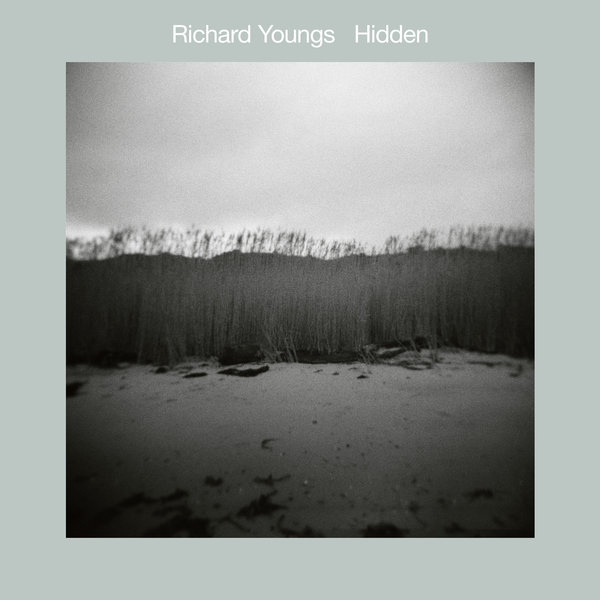
Richard Youngs
Hidden
Label: Black Truffle
Format: LP + Digital
Catalogue Number: BT138
Official web site: blacktruffle.bandcamp.com/album/hidden
Description
The inimitable Richard Youngs returns to Black Truffle with this third full-length for the label, Hidden. Like CXXI and Modern Sorrow, Hidden unfolds across two side-long pieces at once eminently listenable and possessed of the ‘bloody-minded’ dedication to ‘having an idea and sticking with it’ that Youngs himself has identified as one of the key qualities of his work.
At the core of both pieces are rapid, randomised arpeggios generated with a Moog Grandmother, hypnotic patterns that wouldn’t be out of place on a Berlin School classic. Alongside these arpeggios, across the seventeen minutes of the first side-long piece Youngs builds an airy structure of shakers, synthetic handclaps and a brief, repeated sample, impossible to identify but sounding like a glitched foghorn. Over the top we hear his unmistakable voice, repeating single syllables—Ha, Ho—with a slow delay, something like a lonely one-man-band take on Anthony Moore’s Pieces from the Cloudland Ballroom or a more musical elaboration of the hypnotically overlapping delayed phonemes of Anton Bruhin’s Rotomotor. Like much of Youngs’ work, the arrangement of sounds is sparse, each layer punctuated by spaces that allow others to shine through, in a way that seems to have more to do with dub or early hip-hop than high-brow models of musical reductionism.
On the flipside, the arpeggios return, now accompanied by ringing, filtered guitar chords and long flute tones. The use of a similar ground layer across the two pieces with strikingly different overdubs calls up Youngs’ first solo record, the classic Advent, reminding us of how consistent ‘theme and variations’ is as an approach in his enormous body of work. Joined by handclaps and a chiming sound, the piece almost feels like it is about to achieve dance-floor lift-off at times, only for the percussion to disappear and leave the listener once again floating among the guitar and flute, now joined by occasional cut-off vocal snippets, like a radio turned quickly on and off. The suspension of these disparate elements over the steady foundation of the Moog arpeggios might remind some listeners of the free-form studio explorations of Moebius & Plank and Holger Czukay or even give a nod to Youngs’ formative encounter with Cabaret Voltaire.
Like some of Youngs’ much-loved work with Simon Wickham-Smith, Hidden approaches relatively familiar sounds and instruments from skewed angles, delighting in loose structures of interaction that border on gleeful incoherence while remaining outwardly beautiful. Coming up to almost four decades of persistent activity, like little else in contemporary music Youngs’ work beams with the simple joys of exploration and experiment.
The inimitable Richard Youngs returns to Black Truffle with this third full-length for the label, Hidden. Like CXXI and Modern Sorrow, Hidden unfolds across two side-long pieces at once eminently listenable and possessed of the ‘bloody-minded’ dedication to ‘having an idea and sticking with it’ that Youngs himself has identified as one of the key qualities of his work. At the ...
read more…
Tracklisting
- Hidden I
- Hidden II
Available from these fine distributors:
- USA – Forced Exposure www.forcedexposure.com
- Europe – Kompakt www.kompakt.fm/labels/black_truffle
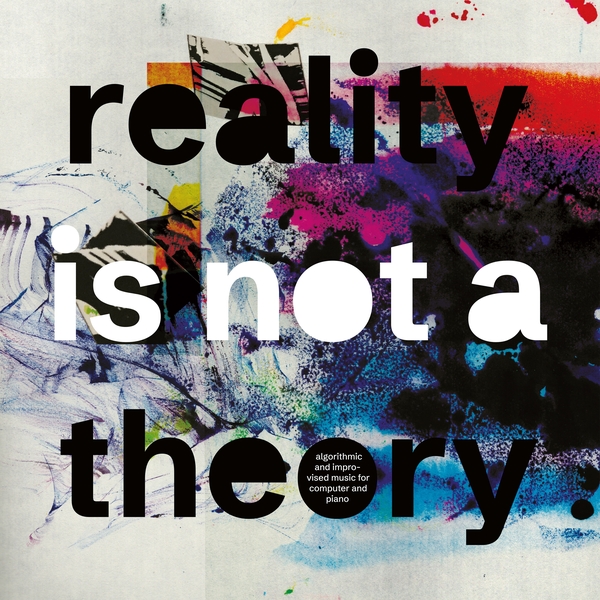
Mark Fell & Pat Thomas
Reality Is Not A Theory
Label: Black Truffle
Format: LP + Digital
Catalogue Number: BT137
Official web site: blacktruffle.bandcamp.com/album/reality-is-not-a-theory
Description
Recorded in concert at the University of Sheffield in March 2025, Reality Is Not A Theory is the first collaboration between Mark Fell and Pat Thomas. Major figures in British experimental music since the 1990s, Fell and Thomas have developed their rigorous practices from radically different backgrounds and perspectives: where Fell’s singular take on synthetic abstraction emerged from Sheffield’s electronic underground, Thomas is a virtuoso improvising pianist steeped in jazz and modernist art music who has simultaneously worked with sampler-based electronics for decades. As the record’s wonderfully academic subtitle explains, we are presented here with two sides of ‘algorithmic and improvised music for computer and piano’, exemplifying both players’ insatiable search for new (and sometimes uncomfortable) playing situations.
The performance begins with Fell’s electronics close to the timbres of acoustic percussion, attacks that suggest wood, metal or glass threaded along a rapid pulse while Thomas focuses on the lowest registers of the piano, deadening the strings. As Fell’s electronics start to ring out and occupy more harmonic space, Thomas turns to wide, repeated clusters, which slowly expand into patterns of chords. Like in his recent solo recordings and his trio work with Joel Grip and Anton Gerbal, Thomas’ playing combines extreme dissonance with a deep lyrical sense. Fell’s work gradually shifts its focus toward drum sounds, drawing on the microtemporal processes that have characterized his practice in recent decades. Heard together with Thomas’ probing piano, the computer sounds call up unexpected associations with the klangfarben antics of improv drummers like Paul Lovens or Tony Oxley. Throughout its second half, the music grows increasingly frenetic, as Thomas sounds out rapid, irregularly repeated figures and beautifully sour chords in the upper register, while Fell’s percussion develops into angular pan-pipe-like feedback and waves of glissandi.
With great confidence and patience, Fell and Thomas often let their individual contributions remain rhythmically distinct and unsynchronised, allowing unexpected correspondence and coincidence to guide the music’s development. Recorded in a hall named after Sheffield steel manufacturer and Master Cutler Mark Firth, the location might suggest a model for understanding how Fell and Thomas interact here: two workers in the same workshop, each immersed in their own part of the production process. Arriving in a striking sleeve designed by Mark Fell, with liner notes by Francis Plagne, Reality Is Not A Theory is an invigorating document of the meeting of two mavericks of contemporary music.
Recorded in concert at the University of Sheffield in March 2025, Reality Is Not A Theory is the first collaboration between Mark Fell and Pat Thomas. Major figures in British experimental music since the 1990s, Fell and Thomas have developed their rigorous practices from radically different backgrounds and perspectives: where Fell’s singular take on synthetic ...
read more…
Tracklisting
- set two, part one
- set two, part two
Available from these fine distributors:
- USA – Forced Exposure www.forcedexposure.com
- Europe – Kompakt www.kompakt.fm/labels/black_truffle

Léo Dupleix with Asterales
Round Sky
Label: Black Truffle
Format: LP + Digital
Catalogue Number: BT136
Official web site: leodupleix.bandcamp.com/album/round-sky
Description
Léo Dupleix return to Black Truffle with Round Sky, following the enchanting Resonant Trees (BT119). The composer here performs on analogue synthesizer, harpsichord and spinet as one member of Asterales, a group that brings together four important figures in the international community of musicians working with just intonation: Dupleix, Jon Heilbron (double bass), Rebecca Lane (quarter-tone flute) and Fredrik Rasten (guitars). The quartet perform three recent pieces by Dupleix, each of which is like a different view on the same landscape of unruffled calm, where the unique harmonic events made possible by just intonation flicker across melodies and harmonies like light on the surface of water.
The first side is dedicated to ‘Poème d’air’, composed while Dupleix was immersed in the music of 14thcentury ars nova composer-poet Guillaume de Machaut. A sustained study of the ‘sonic possibilities of low-pitched sounds in just intonation’, it begins with a long, rumbling pitch from Heilbron’s bass, soon joined by the organ-like tones of the composer on synthesizer. The piece is made up of cycling sequences of chords, each of which is repeated for several minutes before the music either freezes on a single harmony or silently pauses before the next episode begins. These structures are initially dominated by the bass and synthesizer, with Lane’s pure vibrato-less flute tone and Rasten picked harmonics adding flashes of colour. As the piece develops, flute and guitar become more prominent and the bass climbs to higher registers. The development culminates in a stunning episode around fifteen minutes in where the texture thins out, casting a spotlight on a melodic figure exploiting the uncanny sound of Lane’s quarter-tone flute.
On the second side we are treated to two briefer pieces, closer to the sound of Resonant Trees as they return harpsichord and spinet to the foreground. ‘Ghosts’ centres on a harpsichord melody that slowly expands as it repeats, growing from a haunting six-note cell to a flowing succession of notes whose shape become increasingly difficult to perceive. Alongside this melodic development, an increasingly lush accompaniment grows, with long tones from bass, flute, e-bowed guitar and synthesizer holding notes picked out the harpsichord melody in a swaying harmonic cloud. Dupleix notes that the concluding ‘Round Sky’ was written in the countryside in spring, a circumstance that seems far from irrelevant to the impression the piece makes when its euphonous spinet arpeggios emerge from a gentle synthesizer drone like a flower from a bud. Performed as a duo with Rasten, with both instrumentalists also singing, this title piece exemplifies what makes Dupleix’s music so unique: grounded in a rigorous application of just intonation principles yet as open as Harold Budd or Andrew Chalk to an uncomplicated, intuitive experience of beauty.
Léo Dupleix return to Black Truffle with Round Sky, following the enchanting Resonant Trees (BT119). The composer here performs on analogue synthesizer, harpsichord and spinet as one member of Asterales, a group that brings together four important figures in the international community of musicians working with just intonation: Dupleix, Jon Heilbron (double bass), Rebecca Lane (quarter-tone flute) ...
read more…
Tracklisting
- Poème d’Air
- Ghosts
- Round Sky
Available from these fine distributors:
- USA – Forced Exposure www.forcedexposure.com
- Europe – Kompakt www.kompakt.fm/labels/black_truffle
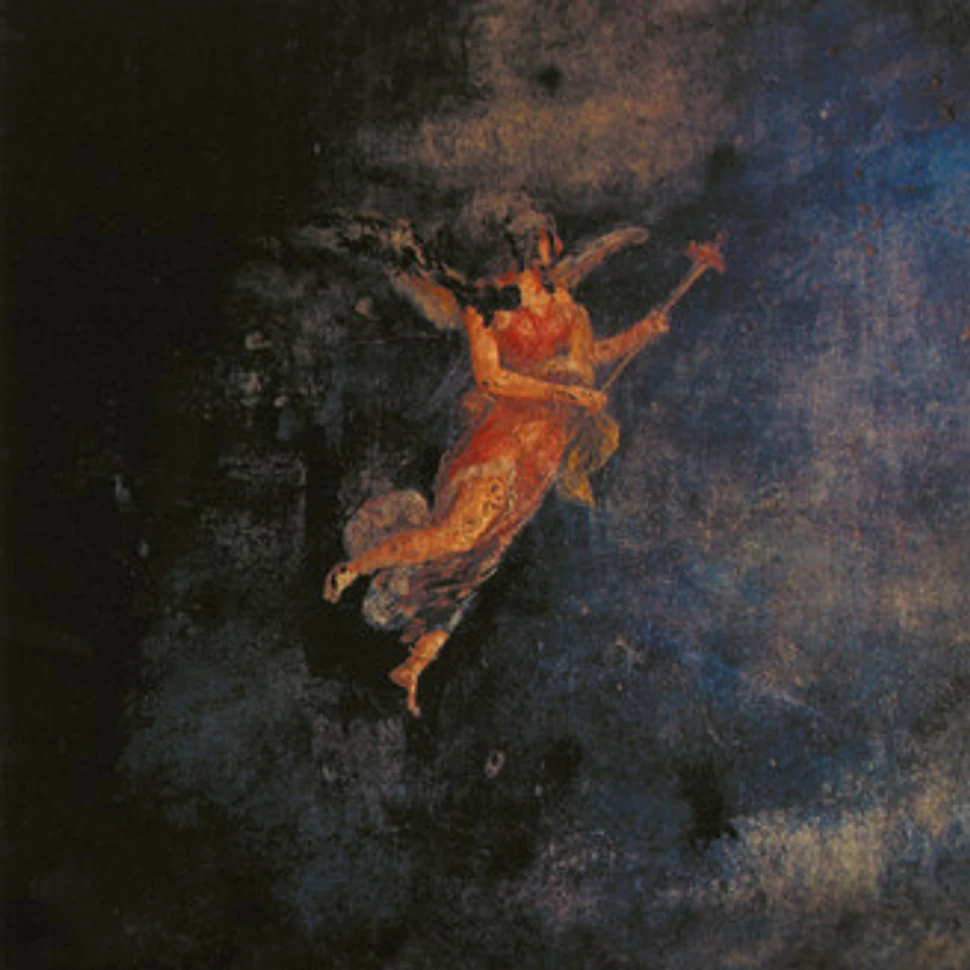
Nijiumu
When I sing, I slip into the microphone. Into that void, I bring comrade “prayers”, then, turning to face the outside, together we explode
Label: Black Truffle
Format: 2LP + Digital
Catalogue Number: BT135
Official web site: shorturl.at/bnIFI
Description
Among the true Keiji Haino devotees, Nijiumu’s Era of Sad Wings (released on P.S.F. in 1993) has always held a special place in the pantheon. Operating for only a few years in the early 90s and apparently only performing a handful of shows, Nijiumu operated at the opposite end of the dynamic spectrum to Haino’s famed power trio Fushitsusha, dwelling in a hushed, meditative realm of mysterious droning sonorities and free-floating melodies that occasionally erupts into violence. Black Truffle is pleased to announce a new double-LP edition of a lesser-known 1994 Nijiumu recording, When I sing, I slip into the microphone. Into that void, I bring comrade “prayers”, then, turning to face the outside, together we explode. Here, Nijiumu is the trio of Haino, Tetuzi Akiyama and the obscure Takashi Matsuoka, the three performing on a wide variety of string, wind and percussion instruments, as well as electric guitar and bass, and Haino’s unmistakeable voice.
Like on the early solo Haino album that shares the group’s name (released on P.S.F. in 1990), the instrumentation swims in reverb (the use of which Akiyama recalls as ‘a kind of point of the band’), often obscuring the instrumental sources. On the short opening piece, a distant reed instrument arcs long buzzing melodies over a bed of cymbals and gongs, like a psychedelic take on Tibetan music. The epic second part, occupying almost 50 minutes, begins as a splayed, near-formless cloud of electric guitar and bass, shadowed by bowed and plucked strings, the three elements working through twisting atonal shapes. At various points in the recording, we hear what seems to be the sounds of musicians moving between instruments, their shuffling and bumps fitting seamlessly into this radically open music. Eventually, what sounds like electric guitar moves closer to the foreground, fixing on a repeated melodic cell around which hover mysterious clouds of long tones and a sporadic shaker. At the half-hour mark, the music begins to build to a violently emotive climax, Haino’s impassioned vocal cries punctuating a lumbering, bass-heavy murk, contrasted at points by what sounds like a tin whistle. Suddenly, the volume drops to a near-whisper, opening the way for the stunning final moments, which touch on the slow-motion balladry of Haino’s classic Affection, here given an eccentric twist by an occasional woodblock hit.
The third piece opens with a hazy trio of rumbling bass, bowed strings and abstracted slide guitar, the latter calling to mind some of Akiyama’s later solo work. Eventually joined by Haino’s voice, its fragile, haunted tone might remind the listener of the man in black’s documented love of the madrigals of the murderous Count Gesualdo, before the recording abruptly breaks off mid-note. In this new edition, the Nijiumu trio recording is supplemented by a piece recorded solo by Haino in 1973, a bracing electronic blowout stretching almost half an hour. Using a homemade electronics setup to unleash a barrage of crunching distortion and shuddering harmonic fuzz, it takes its place in the canon of extreme live electronics next to Robert Ashley’s Wolfman and Walter Marchetti’s Osmanthus fragrans, looking forward to extreme noise years before Merzbow. Taken as a whole, these four sides of music are a stunning document of some of the lesser-known waystations of Haino’s singular creative path.
Among the true Keiji Haino devotees, Nijiumu’s Era of Sad Wings (released on P.S.F. in 1993) has always held a special place in the pantheon. Operating for only a few years in the early 90s and apparently only performing a handful of shows, Nijiumu operated at the opposite end of the dynamic spectrum to Haino’s ...
read more…
Tracklisting
- When I sing, I slip into the microphone. Into that void, I bring comrade "prayers", then, turning to face the outside, together we explode. Part I
- When I sing, I slip into the microphone. Into that void, I bring comrade "prayers", then, turning to face the outside, together we explode. Part II
- When I sing, I slip into the microphone. Into that void, I bring comrade "prayers", then, turning to face the outside, together we explode. Part II (continued)
- When I sing, I slip into the microphone. Into that void, I bring comrade "prayers", then, turning to face the outside, together we explode. Part II (conclusion)
- When I sing, I slip into the microphone. Into that void, I bring comrade "prayers", then, turning to face the outside, together we explode. Part III
- 4th Movement: The kotodama that attempts to take back all energy into itself
Available from these fine distributors:
- USA – Forced Exposure www.forcedexposure.com
- Europe – Kompakt www.kompakt.fm/labels/black_truffle

Amelia Cuni
Melopea
Label: Black Truffle
Format: LP + Digital
Catalogue Number: BT134
Official web site: cunidurand.bandcamp.com/album/melopea
Description
Black Truffle is pleased to announce Melopea, presenting two new pieces highlighting the incredible voice of Amelia Cuni (1958-2024), the great Italian singer, based in Berlin in later life, whose mastery of the classical Indian dhrupad developed in parallel with a commitment to contemporary experimental approaches. After two stunning archival releases documenting traditional dhrupad performances in India in the 1990s (BT079 and BT092), the two side-long pieces here embody the freedom with which Cuni explored new contexts and settings for her singing.
Both make use of a long recording of Cuni singing the pentatonic Raag Bhoop (or Bhopali) made in 2012 by her partner Werner Durand in Berlin. ‘Melopea’ began from Cuni and Durand’s superimposition of this recording with violinist Silvia Tarozzi and cellist Deborah Walker’s performance of Éliane Radigue’s ‘Occam River II’. Inspired by the beauty of this chance encounter (and other experiments with non-synchronous collaboration during the pandemic years), Tarozzi and Walker recorded independently, without hearing Cuni’s voice but ‘having her present in memory’. Tarozzi and Walker’s bowed strings places Cuni’s magisterial performance in a new context, emphasising, as Radigue commented upon hearing the initial layering of her piece with Cuni’s voice, a shared ‘searching toward the partials, overtones, these natural constituents of acoustical sounds in their richness’. Beginning with whispered bowed harmonics, the violin and cello swap the stability of dhrupad’s traditional tanpura drone for a slowly evolving, uneasy web of harmonic interactions recalling some of Harley Gaber’s work, sometimes sitting on dissonances for long periods or allowing changing interference patterns to come to the fore. Primarily focusing on her lower register, Cuni’s performance demonstrates her mastery of microtonal pitch subtleties, elegant sweeping glissandi and meditatively unhurried pacing.
The continuation of the same recording by Cuni forms the foundation of ‘Bhoop-Murchana’, with Anthea Caddy on cello and Werner Durand on soprano saxophone. In contrast to the randomised layering of the first piece, here Durand and Caddy have carefully selected pitches based on the raag Cuni sings, using the ‘Murchana’ form, which uses the constituent notes of the raag as tonics of new raags, retaining the same interval structure. Both players who have developed tones of striking depth and harmonic purity on their instruments, Caddy and Durand’s patient long tones are simultaneously rigorously grounded in the physical properties of sound and possessed of an immaterial, floating quality. Combined with Cuni’s voice and, near the piece’s end, her contributions on hammered and plucked tanpura, the effect borders on miraculous. To surrender to this music is like slipping into an onsen pool, feeling the instantaneous release of every tension. Accompanied by liner notes from Durand, Tarozzi and Walker, Melopea is both a moving tribute to the profound art of Amelia Cuni and, for the uninitiated, a perfect introduction to it.
Black Truffle is pleased to announce Melopea, presenting two new pieces highlighting the incredible voice of Amelia Cuni (1958-2024), the great Italian singer, based in Berlin in later life, whose mastery of the classical Indian dhrupad developed in parallel with a commitment to contemporary experimental approaches. After two stunning archival releases documenting traditional dhrupad performances ...
read more…
Tracklisting
- Melopea
- Bhoop - Murchana
Available from these fine distributors:
- USA – Forced Exposure www.forcedexposure.com
- Europe – Kompakt www.kompakt.fm/labels/black_truffle

Christer Bothén
Christer Bothén Donso n’goni
Label: Black Truffle
Format: LP + Digital
Catalogue Number: BT133
Official web site: blacktruffle.bandcamp.com/album/christer-both-n-donso-n-goni
Description
Black Truffle is thrilled to present the first ever solo Donso n’goni recording from octogenarian Swedish multi-instrumentalist Christer Bothén. Active in the Swedish jazz and improvisation scene since the 1970s, often heard on bass clarinet, Bothén travelled to Mali in 1971, eventually making his way to the Wassoulou region in the country’s south where he encountered the Donso n’goni, the sacred harp of the hunter caste of Wassoulou society. Though playing the instrument has traditionally been restricted to those who belong to the hunters’ brotherhood, Bothén found an enthusiastic teacher in Brouema Dobia, who, after many months of intensive one-on-one lessons, gave Bothén his blessing to play the instrument both traditionally and in his own style. Returning to Sweden, he would go on to pass on what he had learned to Don Cherry and play the Donso n’goni in a wide variety of inventive settings, including the driving Afro-jazz-fusion of his Trancedance (reissued as BT118).
The seven pieces of Christer Bothén Donso n’goni offer up a stunning showcase of Bothén’s work on this remarkable instrument, heard entirely unaccompanied, except for the final piece where he is joined on a second Donso n’goni by his student and collaborator, the virtuoso bassist Kansan/Torbjorn Zetterberg, and Marianne N’Lemvo Linden on the metal Karanjang scraper. Produced by Johan Berthling (of Fire! & Ghosted) and recorded in three sessions in Stockholm between 2019 and 2023 in richly detailed high fidelity, the instrument’s buzzing, sonorous bass strings make an immediate, overwhelming sonic impression. Hyper-focused on hypnotically repeating pentatonic patterns, the seven pieces are at once relentlessly single-minded and endlessly rich in subtle variations. The concentrated listening environment turns small details, such as the deployment of the instrument’s segesege rattle on two of the pieces, into major events. Six of the seven pieces are traditional, with Bothén contributing the remaining ‘La Baraka’, but the line between tradition and the individual talent is imaginary here: as Bothén explained in a recent interview with The Wire’s Clive Bell, ‘I play traditional and untraditional, and I play the music forward and backward’. While the traditional Wassoulou pieces provide the rhythmic and harmonic elements, Bothén’s individuality as a performer is alive in every moment, felt acutely in boundless variations of attack, improvisational flourishes, and unexpected accelerations and decelerations. Captured entirely live and bristling with spontaneity, this music is undeniably the product of almost half a decade of Bothén’s devotion to the Donso n’goni and its traditional music.
Accompanied by detailed new liner notes by Bothén and stunning colour photos from his time in Mali, Christer Bothén Donso n’goni is a stunning document of a remarkable instrument, played with an almost spiritual intensity by one of contemporary music’s great explorers.
Black Truffle is thrilled to present the first ever solo Donso n’goni recording from octogenarian Swedish multi-instrumentalist Christer Bothén. Active in the Swedish jazz and improvisation scene since the 1970s, often heard on bass clarinet, Bothén travelled to Mali in 1971, eventually making his way to the Wassoulou region in the country’s south where he ...
read more…
Tracklisting
- Zindi Windi
- Kakani Kakani
- Reh Chergi
- Fantasma
- Yalla
- La Baraka
- Waso Manjé
Available from these fine distributors:
- USA – Forced Exposure www.forcedexposure.com
- Europe – Kompakt www.kompakt.fm/labels/black_truffle

Giuseppe Ielasi / Jack Sheen
The Vestige
Label: Black Truffle
Format: LP + Digital
Catalogue Number: BT132
Official web site: blacktruffle.bandcamp.com/album/the-vestige
Description
The Vestige is the first fruit of a new intergenerational collaboration between Giuseppe Ielasi, a quietly prolific key contributor to the European experimental music scene for over twenty years, and Jack Sheen, a young composer-conductor-sound artist from Manchester whose recent projects have seen him moving seamlessly from enigmatic chamber music composition and installations to conducting the London Symphony Orchestra. Their materials and working methods differ significantly, with Ielasi having focussed for many years on electro-acoustic techniques alongside his ongoing commitment to the guitar, and Sheen primarily composing for traditional instruments. More important, though, is what they share: a fascination with what Sheen calls “mysterious, liminal musical material,” using irregular repetition and cyclical forms to create structures at once alive with activity and almost static, as well as a rigorous exploration of spatial diffusion and the interaction of sound event and environment.
Working individually with a library of acoustic instrument sounds from Sheen’s recent projects and Ielasi’s guitar, the pair eventually met for several days at Ielasi’s home studio in Monza, sculpting the fourteen pieces that make up The Vestige. Like Ielasi and Sheen’s solo works, the record shows an exquisite attention to details of sequencing and pacing, the sound palette and compositional approach consistent throughout while each piece asserts its own identity. The twenty-five seconds of the opening piece serve as an entrée into the record’s distinctive world of sound: repeated chirps fluctuate in volume as they move across the stereo spectrum, woven between strangled snatches of string glissando against a backdrop of percussive ticks, long tones, and white noise. Across the remaining thirteen pieces, Ielasi and Sheen sketch further dimensions of the ambiguous space, where distinctions between pitch and noise, repetition and irregularity, electronic and acoustic remain pointedly unclear.
As the record’s title suggests, the origins of the sounds we hear have become remote: while at moments we get flashes of timbres and attacks that could come from wind instruments, bowed strings, or prepared guitar, these remain vestigial traces, glimpsed through a veil of shifting white noise textures. These textures are themselves difficult to trace, suggesting artefacts of the recording process, electronic synthesis, amplified room sound, rubbed instruments or objects. The Vestige shows an unusual degree of attention to frequency range as a compositional tool, something it shares with the hyper-subtle variations of Ielasi’s electroacoustic works and the deliberately ‘unbalanced’ midrange-heavy ensemble of Sheen’s Sub. Here, movement between episodes is as much about adding or removing a frequency band as it is about changes in density, harmonic content, or instrumental texture. Tracks are marked by the sudden appearance of subbass or exaggeration of high frequencies in otherwise similar material, contributing to our sense that these fourteen pieces are like different views on a scene that we can never quite see clearly. While calling up a range of past music, from the early works of Rolf Julius to Simha Arom’s recordings of layered polyrhythms embedded in the background sounds of central African villages to the temporal distortions and layered hiss of DJ Screw, the alluring and disconcerting world of The Vestige is entirely its own.
Photographs by Anton Lukoszevieze.
The Vestige is the first fruit of a new intergenerational collaboration between Giuseppe Ielasi, a quietly prolific key contributor to the European experimental music scene for over twenty years, and Jack Sheen, a young composer-conductor-sound artist from Manchester whose recent projects have seen him moving seamlessly from enigmatic chamber music composition and installations to conducting ...
read more…
Tracklisting
- V1
- V2
- V3
- V4
- V5
- V6
- V7
- V8
- V9
- V10
- V11
- V12
- V13
- The Vestige
Available from these fine distributors:
- USA – Forced Exposure www.forcedexposure.com
- Europe – Kompakt www.kompakt.fm/labels/black_truffle

Kassel Jaeger
Fernweh
Label: Black Truffle
Format: LP + Digital
Catalogue Number: BT131
Official web site: blacktruffle.bandcamp.com/music
Description
Black Truffle is pleased to announce a new edition of Kassel Jaeger’s Fernweh, returning François J. Bonnet’s electroacoustic project to the label five years after the acclaimed Meith (BT069). Originally released on Giuseppe Ielasi and Jennifer Veillerobe’s impeccably curated Senufo Editions in 2012, Fernweh stands near the beginning of the gradual expansion of Bonnet’s approach after the austere acoustic textures of Aerae and Algae (both released on Senufo), leading to the lush, layered environments of recent solo works on Shelter Press and the epic electronic expeditions undertaken in duo projects with Stephen O’Malley and Jim O’Rourke.
A major work in the Kassel Jaeger oeuvre, stretching over two LP sides, Fernweh draws together synthesized and musique concrète materials into a drifting assemblage. Its title’s meaning is close to the concept of ‘Wanderlust’, fitting for this music that moves freely and unexpectedly between what Bonnet calls ‘climates’. Beginning with fizzing electronics whose rhythm of gradual approach suggests breaking waves, the clinical atmosphere is soon haunted by intangible traces of lived reality. Textures call up wind, water, insects, the crunch of feet on sand or the clinking of glasses, yet they can never be identified with any certainty. At times these concrete elements possess a vivid ‘closeness’; at others, the sounds shade into a formless distance. Though the listener forms no clear picture from the concrete sounds, these elements aerate the music, lending it their space.
Drawing from the rigorous formal language and conceptual apparatus of the French musique concrète tradition—with which Bonnet, as director of the GRM and researcher into its deepest archival recesses, is intimately familiar—the music of Kassel Jaeger is equally informed by how underground experimental music has rethought electroacoustic techniques, with Fernweh at times calling up the grit and grime of para-industrial eccentrics like Maurizio Bianchi or the Toniutti brothers, and at other moments suggesting the slow-moving grandeur of early Olivia Block. Subtle features of dynamics and rhythm act as connective tissue between the numerous ‘scenes’, with wave-like envelopes, rapid pulsations, and short, tape-loop patterns all recurring throughout the piece, shared ambiguously between electronic and concrete sounds. Amid these shifting, often inharmonic textures, the electronic elements sometimes cohere into melodic shapes and chordal patterns, cutting through the fog in distorted arcs or underpinning the layered surface with slow-moving harmonies. Like his friend and collaborator Jim O’Rourke, Bonnet displays a radical openness at odds with academic tradition, allowing unabashed emotion to coexist with rigorous experimentation. As Fernweh dies away with mysterious shudders, listeners are left at once moved and unsure of exactly what they just heard.
Black Truffle is pleased to announce a new edition of Kassel Jaeger’s Fernweh, returning François J. Bonnet’s electroacoustic project to the label five years after the acclaimed Meith (BT069). Originally released on Giuseppe Ielasi and Jennifer Veillerobe’s impeccably curated Senufo Editions in 2012, Fernweh stands near the beginning of the gradual expansion of Bonnet’s approach after the austere acoustic textures ...
read more…
Tracklisting
- Fernweh I
- Fernweh II
Available from these fine distributors:
- USA – Forced Exposure www.forcedexposure.com
- Europe – Kompakt www.kompakt.fm/labels/black_truffle

Ensemble Nist-Nah
Spilla
Label: Black Truffle
Format: LP + CD + Digital
Catalogue Number: BT130
Official web site: blacktruffle.bandcamp.com/album/spilla
Description
Black Truffle is thrilled to announce Spilla, the second album from Nantes-based Ensemble Nist-Nah, 48 minutes of music for Gamelan, drum kits, wood and metal percussion instruments, and plucked strings that will surely count as one of the most electrifying records you hear this year. Founded by the Australian drummer/percussionist Will Guthrie in 2019, continuing the explorations begun in solo form on Nist-Nah (Black Truffle, 2020), the ensemble (eight or nine core members with occasional guests) has been consistently active in the half-decade since: composing, rehearsing, recording and touring Europe (with a mass of equipment in tow) to great acclaim. Spilla tracks the continuing evolution of the project since the recording of their first album, Elders (Black Truffle, 2022). The two sides of this record document two different iterations of the group, and the members’ compositional input has increased: each side contains one piece by a member other than Guthrie. It has become clearer than ever that Ensemble Nist-Nah is not an attempt at a European Gamelan ensemble but rather a hybrid percussion ensemble that uses instruments from a Javanese Gamelan alongside other percussion to perform original music informed by a variety of South East Asian music but also by everything from free jazz to contemporary hip-hop: while Nist-Nah and Elders both featured traditional Javanese pieces, on Spilla the only tune not generated by a member of the group is by Guthrie’s long-time musical hero and occasional collaborator Roscoe Mitchell.
The two short pieces that open the record could almost be the two sides of a wild 7” selected to show off what the Ensemble can do. On opener ‘Gerak Maju’, intricately skittering open-snare patterns bounce over clanging metal, chiming bell-like tones and deep gong hits, adapting the rhythm-register connections heard in traditional Gamelan musics—where the lowest pitched sounds are heard least frequently—to a cut-up breakbeat straight off Feed Me Weird Things. ‘Strollabout’ then moves into an entirely different realm of meditative repeating patterns, performed entirely on Chinese, Javanese and Vietnamese gongs. The remaining seven pieces, ranging from three to twelve minutes, offer up a wealth of different percussive, compositional and arrangement possibilities. On ‘Ghostly Klang’, two drumkits mirror each other’s moves, bouncing hats and snares across the stereo field in a way that recalls On the Corner and the jittering hi hat patterns of trap, while slow moving melodies on the tuned instruments add a sense of majesty contrasted by scurrying details in resonant wood. The epic closing track presents a take on Roscoe Mitchell’s ‘Uncle’, performed by the Art Ensemble of Chicago on their classic Urban Bushmen live album. Where the Art Ensemble used Mitchell’s dirge-like melody as a jumping off point for virtuosic improvisational flights, Ensemble Nist-Nah rethink the piece as a near-static dialogue between the monumental, slow-moving sequence of unison tuned percussion notes and a textural cloud that grows in richness and intensity from whispering cymbal rolls into a mass of gong overtones and bowed metal.
Beautifully recorded and mixed, Spilla arrives in a sleeve decorated with core member Charles Dubois’ drawings of cymbals and gongs. Against the backdrop of a wider musical landscape dominated by over-produced electronic slop and bland harmonic wallpaper, Ensemble Nist-Nah stands out as a reminder, vital and unpretentious, of the joys and possibilities of human beings playing instruments together.
Black Truffle is thrilled to announce Spilla, the second album from Nantes-based Ensemble Nist-Nah, 48 minutes of music for Gamelan, drum kits, wood and metal percussion instruments, and plucked strings that will surely count as one of the most electrifying records you hear this year. Founded by the Australian drummer/percussionist Will Guthrie in 2019, continuing the ...
read more…
Tracklisting
- Gerak Maju
- Strollabout
- Bleed
- Pasang
- Spilla
- Snakelike
- Ghosty Klang
- Frogzit
- Uncle
Available from these fine distributors:
- USA – Forced Exposure www.forcedexposure.com
- Europe – Kompakt www.kompakt.fm/labels/black_truffle

Salamat Ali Khan
Metamusik Festival Berlin ‘74
Label: Black Truffle
Format: LP + Digital
Catalogue Number: BT129
Official web site: blacktruffle.bandcamp.com/album/metamusik-festival-berlin-74
Description
Carrying on from recent archival releases from masters of Indian classical tradition such as Kamalesh Maitra and the Dagar Brothers, Black Truffle is pleased to present a previously unheard recording of a concert by Pakistani vocalist Salamat Ali Khan. Born to a musician family in Hoshiarpur in the northwestern state of Punjab, Khan moved with his family to Lahore in Pakistan after the 1947 partition of India, becoming a child musical prodigy. Khan was a master of the kyhal form of Hindustani classical vocal music, a style integrating influences from Middle Eastern musical traditions that gives the singer a great deal of improvisational freedom. Travelling widely across the globe from the 1960s until his death in 2001, Khan approached ragas performed in the kyhal style as expressive forums for risk-taking improvisation, enlivened by ceaseless ornamental invention.
This remarkable recording was captured by Michael Hönig (of krautrock legends Agitation Free) in concert at Berlin’s Neue Nationalgalerie as part of the MetaMusik festival in 1974 (which also featured Nico, Tangerine Dream, and Roberto Laneri’s Prima Materia, among many others). Khan, who is also heard accompanying himself on a specially tuned alpine zither (in place of the traditional swarmandal, an Indian style of zither), is joined by Shaukat Hussein Khan on tabla and Hussein Bux Khan on harmonium. The lack of a familiar underlying tanpura drone gives this performance a weightless, floating quality, with all three of the musicians playing masterfully with the interaction between silence and the pulse propelling each section of the raag.
As Khan explains in his opening remarks, this performance of the rainy season Raag Megh is divided into three parts, each with its own tempo and rhythmic scheme (tala). The opening vilambit, in a twelve-beat tala, stretches out for over twenty minutes, lingering for a long time in a space of meditative calm, Khan lightly strumming the zither while exploring the lower end of his range in languorously extended notes. Virtuoso tabla interjections at first barely state the tempo, and the interplay between musicians is so spacious that we hear scraps of audience noise and the squeak of the harmonium’s mechanism in between the notes. Gradually picking up rhythmic definition and melodic complexity, after around fifteen minutes the music builds dramatically, with Khan letting out emotive yelps and swooping scalar shapes ranging across his full vocal range. This flows seamlessly into the following jhaptal, at a faster tempo in ten beats, which then makes way for the concluding teental, very fast in sixteen beats, which becomes a frantic improvisational exchange of daring rhythmic disruptions from the tabla, flowing harmonium melodies, and a stunning variety of vocal approaches from Khan, ranging from rapid-fire staccato consonants to guttural growls.
Accompanied by stunning black and white concert photographs, the LP also contains a moving and entertaining recollection from acclaimed German musicologist Peter Pannke, looking back on his experience assisting Khan and his musicians in Berlin at the Metamusik festival (including a mouth-watering description of a feast cooked by the maestro himself). As Pannke describes in his account of attending the concert, the beauty and spiritual intensity of this music leaves the listener speechless.
Carrying on from recent archival releases from masters of Indian classical tradition such as Kamalesh Maitra and the Dagar Brothers, Black Truffle is pleased to present a previously unheard recording of a concert by Pakistani vocalist Salamat Ali Khan. Born to a musician family in Hoshiarpur in the northwestern state of Punjab, Khan moved with ...
read more…
Tracklisting
- Announcement by Salamat Ali Khan
- Raag Megh - Vilambit Khayal in Ektal
- Raag Megh - Madhya Khayal in Jhaptal
- Raag Megh - Tarana in Teental
Available from these fine distributors:
- USA – Forced Exposure www.forcedexposure.com
- Europe – Kompakt www.kompakt.fm/labels/black_truffle

Annea Lockwood
On Fractured Ground / Skin Resonance
Label: Black Truffle
Format: LP + Digital
Catalogue Number: BT028
Official web site: blacktruffle.bandcamp.com/album/on-fractured-ground-skin-resonance
Description
Legendary New Zealand-born experimental composer and sound art pioneer Annea Lockwood returns to Black Truffle with On Fractured Ground / Skin Resonance, her third release for the label. Having recently celebrated her 85th birthday, Lockwood shows no sign of slowing down in her exploration of new sound sources and collaborations with an ever-growing intergenerational pool of performers – here with Vanessa Tomlinson. Her creative vibrancy is alive as ever on the two recent works presented here, which demonstrate both her engagement with the social dimensions of sound and the deeply reflective, meditative aspect of her art.
On Fractured Ground derives from material recorded with Pedro Rebelo and Georgios Varoutsos for the soundtrack of Maria Fusco and Margaret Salmon’s opera-film, History of the Present (2023). Working together in Belfast, Lockwood, Rebelo and Varoutsos made extensive recordings of the city’s ‘peace lines’, the dozens of walls erected since the beginning of the Troubles in the late 1960s to separate Catholic and Protestant areas of the city. Struck by the immensity of these barriers, ‘the brutal way they sever neighbourhoods’, Lockwood and her collaborators focused not on the sound environment of the city, but on the walls themselves, playing them as gigantic resonant instruments, using their hands and objects such as stones and leaves. Continuing to work in her studio with the material collected for the soundtrack after its completion, Lockwood composed the work presented here, occupying a space somewhere between her own extended-technique percussion music and the Cagean tradition of hyper-amplified small sounds. From deep, gong-like metallic tolling to dry scrapes and uneasy groans, the piece’s sustained attention to single sounds derived from unorthodox sources draws a line all the way back to Lockwood’s classic Glass World (1967-1970). Its spaciousness and delicacy are at odds with the dark historical background of the Troubles, creating a moving listening experience somehow haunted by the shadow of violence and conflict.
Skin Resonance is a collaboration with Australian composer and percussionist Vanessa Tomlinson. Developed through conversations in which the two discussed the idea of ‘sonic attraction’, the piece focuses on Tomlinson’s relationship to the bass drum, reflecting on the complex web of connections embodied in this seemingly simple instrument, which is at once ‘animal, wood, and metal’. Approaching the instrument in a suitably elemental fashion, Tomlinson’s performance strips away conventional technique to explore the resonance and timbral properties of skin, drum, and metal hardware, producing overlapping waves of texture that at times seem closer to wind swishing through leaves or the ocean than anything usually associated with a drum. Emphasising the symbiotic relationship between performer and instrument, Tomlinson’s voice is heard at times, exploring the field of associations and connections the bass drum suggests to her: ‘Maybe the bass drum skin is an ear as well?’
Accompanied by insightful liner notes on both pieces and photographs documenting the recording of On Fractured Ground and a performance of Skin Resonance, this LP is a moving testament to the engagement, generosity, and openness that sustain Annea Lockwood’s work, still finding new directions after more than fifty years of activity.
Legendary New Zealand-born experimental composer and sound art pioneer Annea Lockwood returns to Black Truffle with On Fractured Ground / Skin Resonance, her third release for the label. Having recently celebrated her 85th birthday, Lockwood shows no sign of slowing down in her exploration of new sound sources and collaborations with an ever-growing intergenerational pool of performers ...
read more…
Tracklisting
- On Fractured Ground
- Skin Resonance
Available from these fine distributors:
- USA – Forced Exposure www.forcedexposure.com
- Europe – Kompakt www.kompakt.fm/labels/black_truffle

Konrad Sprenger
Set
Label: Black Truffle
Format: LP + Digital
Catalogue Number: BT127
Official web site: blacktruffle.bandcamp.com/album/set
Description
Black Truffle is thrilled to begin 2025 with a rare solo release from Konrad Sprenger, alias of elusive Berlin composer-producer-instrument builder Jörg Hiller. A prolific collaborator, Sprenger has worked extensively with icons of American minimalism such as Ellen Fullman (with whom her recorded the gloriously eccentric song album Ort) and Arnold Dreyblatt (as a core member of the Orchestra of Excited Strings since 2009), as well as releasing their music on his impeccably curated label, Choose. As an instrument builder and installation artist, he has overseen the creation of a computer-controlled multi-channel electric guitar and, with Phillip Sollmann, a modular pipe organ system designed to be reconfigured from space to space.
In much of Hiller’s work, a scientific approach to acoustic phenomena co-exists with a pop sensibility and a sly sense of humour. Nowhere is this unique combination more in evidence than in his slim body of solo work, beginning with the startling diversity of instrumentation and compositional approaches heard on the short pieces of Miniaturen (2006) and Versprochen (2009), followed by the more single-minded exploration of the computer-controlled electric guitar on Stack Music (2017). Set brings together these various strands of Sprenger’s work into a wildly infectious, playful epic, performed by the composer and the mysterious Ensemble Risonanze Moderne. On the LP’s second side, we are also treated to a guest appearance from longtime collaborator Oren Ambarchi, on whose recent solo releases Simian Angel and Shebang Sprenger has made key production contributions. Ambarchi’s signature stuttering, swirling harmonics weave through a sparkling assemblage of electric guitars, acoustic instruments, percussion and electronics—though, given the deft use that much of Sprenger’s recent production work makes of midi-controlled sampled instrumentation, it’s anyone’s guess where the acoustic ends and the digital begins here.
As soon as the needle drops on the first side, we are inside a musical world that Set will inhabit for its 33 minutes: sparkling guitar harmonics and palm-muted notes, tuned percussion, crisp electronic drum hits, flashes of horns, and untraceable bursts of synthetic sound are arranged into a skittering polyrhythmic framework calling up the detail-rich percussive constructions of contemporary techno filtered through the pointillism of the post-serialist European avant-garde. Behind this shifting mist of particulate sound, winds and strings sound out held chords, reminiscent of Arthur Russell’s Tower of Meaning in their epic yet seemingly aimless drift. The relationship between elements is mysterious, appearing both carefully considered and almost random. Though never straying too far from where it begins, as the piece moves along, it spotlights increasingly bizarre instrument choices (shakuhachi and steel drums, anyone?) as well as momentary liftoffs into motorik propulsion. Set i
Black Truffle is thrilled to begin 2025 with a rare solo release from Konrad Sprenger, alias of elusive Berlin composer-producer-instrument builder Jörg Hiller. A prolific collaborator, Sprenger has worked extensively with icons of American minimalism such as Ellen Fullman (with whom her recorded the gloriously eccentric song album Ort) and Arnold Dreyblatt (as a core member ...
read more…
Tracklisting
- I
- II
Available from these fine distributors:
- USA – Forced Exposure www.forcedexposure.com
- Europe – Kompakt www.kompakt.fm/labels/black_truffle

Kamalesh Maitra
Raag Kirwani on Tabla Tarang
Label: Black Truffle
Format: LP + Digital
Catalogue Number: BT126
Official web site: blacktruffle.bandcamp.com/album/raag-kirwani-on-tabla-tarang
Description
Carrying on a string of stunning archival releases from major figures of Indian classical tradition (including releases from members of the Dagar family and Amelia Cuni), Black Truffle is pleased to announce an unheard recording from tabla master Kamalesh Maitra (1924-2005). For over fifty years, Maitra devoted himself to the rare tabla tarang, a set of between ten and sixteen hand drums tuned to the notes of the raga to be performed. While the tabla tarang has its origins in the late 19th century, Maitra was the first to recognise its potential as a solo concert instrument, using the set of tuned drums to perform full-length raags. Seated behind a semi-circular array of drums, Maitra produced stunning waves of melodic improvisation enlivened with the rhythmic invention of a master percussionist.
Across his career, Maitra performed in ensembles led by Ravi Shankar, collaborated with George Harrison, and led his own East-West fusion group, the Ragatala Ensemble. However, it is in the solo setting that his remarkable artistry and the otherworldly timbral qualities of the tabla tarang are most strikingly on display. Recorded during the same 1985 Berlin sessions that produced Maitra’s self-released solo LP Tabla Tarang: Ragas on Drums, on Raag Kirwani on Tabla Tarang we are treated to Maitra stretching out for over forty minutes on the late night Raag Kirwani, accompanied by Laura Patchen on tabla and Mila Morgenstern and Marina Kitsos on tanpura. The performance begins with the traditional free-floating exposition section, where Maitra’s spacious melodic improvisation at times almost resembles a plucked string instrument (like the sarod, which Maitra also played). For the listener unaccustomed to the tabla tarang, the sound of these microtonally inflected melodic patterns played on drums has a magic quality. As Maitra begins to imply the rhythmic cycles more strongly, Patchen joins on tabla, beginning half an hour of rhythmic-melodic exploration, where virtuosity sits side by side with delicacy and meditative attention. Accompanied by beautiful archival images and extensive liner notes from Laura Patchen, for many listeners Raag Kirwani on Tabla Tarang will be the perfect introduction to the magical world of Kamalesh Maitra, released to coincide with the hundredth anniversary of the master musician’s birth.
Carrying on a string of stunning archival releases from major figures of Indian classical tradition (including releases from members of the Dagar family and Amelia Cuni), Black Truffle is pleased to announce an unheard recording from tabla master Kamalesh Maitra (1924-2005). For over fifty years, Maitra devoted himself to the rare tabla tarang, a set ...
read more…
Tracklisting
- Raag Kirwani Part I
- Raag Kirwani Part II
Available from these fine distributors:
- USA – Forced Exposure www.forcedexposure.com
- Europe – Kompakt www.kompakt.fm/labels/black_truffle

Limpe Fuchs / Mark Fell
Dessogia / Queetch / Fauch
Label: Black Truffle
Format: 3xLP + Digital
Catalogue Number: BT125
Official web site: blacktruffle.bandcamp.com/album/dessogia-queetch-fauch
Description
The 2015 edition of Winnipeg’s send + receive festival, focussed on rhythm, turned out to be a generative meeting of minds. There, Mark Fell encountered the music of Will Guthrie, a meeting that was eventually to result in the frenetic acoustic drumkit and digital synthesis pairing heard on Infoldings and Diffractions (2020). At the same festival, Limpe Fuchs first heard and appreciated the music of Mark Fell, planting the seed of a collaboration that came to fruition when Fell (along with his son Rian Treanor) visited Fuchs at her home in Peterskirchen, Germany in September 2022. Black Truffle is pleased to announce the release of the results of this extensive session in the audacious form of a triple LP, housing over two hours of music across its six sides.
The collaboration might appear unlikely: what common ground could exist between Fuchs, classically trained pianist, legend of improvised music, instrument builder and sound sculptor active since the 1960s, whose group Anima Sound connected the dots between free jazz, krautrock and ritual, and Fell, proponent of radical computer music, known for his bracingly austere productions that twist remnants of club music into algorithmic stutters? For all their seeming disparity in technology, approach and background, the music on Dessogia/Queetch/Fauch makes it immediately evident the pair share a great deal in their essentially percussive approach and ability to, in Fuch’s phrase, ‘establish silence’.
Recording at her home studio, Fuchs had the use of her entire array of instruments, found, invented, and traditional, and treats the listener to some that don’t often make their way to concerts, including extensive passages performed (with Gundis Stalleicher) on pieces of wooden parquetry. Alongside metallic, wooden and skin percussion of all kinds, sounded and struck in every conceivable way, we also hear bamboo flute, viola, and Fuchs’ distinctive free-form vocalisations. Fell also stretched himself, with his contributions ranging from characteristically fizzing pitched percussive pops to swarms of sliding tones and abstract digital noise. Showing both remarkable restraint and improvisational freedom, much of the music consists of duets between a single percussion instrument and a distinctive mode of digital sound, often lingering in one timbral-rhythmic space for minutes at a time. Improvisational forward momentum coexists with a free-floating, wandering quality. On opener ‘Dessogia I’, the shimmering almost-gilssandi tones of Fuchs’ enormous set of microtonally tuned metal tubes ripples across Fell’s rubbery pulse, which moves up the frequency spectrum as Fuchs becomes more animated and switches to horn. At some points, as on the metallic chiming tones that open ‘Fauch I’, only the unexpected dynamic behaviour of Fell’s sounds distinguish them from Fuchs’ acoustic instruments. At others, like on ‘Queetch III’, the waves of sliding tones and noise textures are bracingly synthetic, joined by piercing squeaks and scrapes from Fuchs’ metal objects.
Epic in scope, immersing the listener in an entirely distinctive world of sounds, and thrillingly bold in its melding of the most ancient musical procedures with cutting edge technologies, Dessogia/Queetch/Fauch is an unexpected major statement from two of the great mavericks of contemporary music.
The 2015 edition of Winnipeg’s send + receive festival, focussed on rhythm, turned out to be a generative meeting of minds. There, Mark Fell encountered the music of Will Guthrie, a meeting that was eventually to result in the frenetic acoustic drumkit and digital synthesis pairing heard on Infoldings and Diffractions (2020). At the same ...
read more…
Tracklisting
- Dessogia I
- Dessogia II
- Dessogia III
- Dessogia IV
- Dessogia V
- Queetch I
- Queetch II
- Queetch III
- Fauch I
- Fauch II
Available from these fine distributors:
- USA – Forced Exposure www.forcedexposure.com
- Europe – Kompakt www.kompakt.fm/labels/black_truffle

Oren Ambarchi
Quixotism (10th Anniversary Remaster)
Label: Black Truffle
Format: LP, CD + Digital
Catalogue Number: BT124
Official web site: shorturl.at/b9OQg
Description
Black Truffle is pleased to announce a tenth anniversary reissue of Oren Ambarchi’s Quixotism, originally released on Editions Mego in 2014. Recorded with a multitude of collaborators in Europe, Japan, Australia and the USA, Quixotism presents the fruit of two years of work in the form of a single, LP-length piece in five parts. Quixotism takes the driving rhythmic aspect of works such as Sagittarian Domain to new levels, with the entirety of this long-form work built on a foundation of pulsing double-time electronic percussion provided by Thomas Brinkmann. Beginning as almost subliminal propulsion behind cavernous orchestral textures and John Tilbury’s delicate piano interjections, the percussive elements (elaborated on by Ambarchi and Matt Chamberlain) slowly inch into the foreground of the piece before suddenly breaking out into a polyrhythmic shuffle around the halfway mark, and joined by master Japanese tabla player U-zhaan for the piece’s final, beautiful passages.
The pulse acts as thread leading the listener through a heterogeneous variety of acoustic spaces, from the concert hall in which the Icelandic Symphony Orchestra were recorded to the intimacy of crys cole’s contact-mic textures. Ambarchi’s guitar itself ranges over this wide variety of acoustic spaces, from airless, clipped tones to swirling, reverberated fog. Within the complex web Ambarchi spins over the piece’s steadily pulsing foundation, elements approach and recede in a non-linear fashion, even as the piece plots an overall course from the grey, almost Nono-esque reverberated space of its opening section to the crisp foreground presence of Jim O’Rourke’s synth and Evyind Kang’s strings in its final moments. Formally indebted to the side-long workouts of classic Cologne techno, the long-form works of composers such as Éliane Radigue and the organic push and pull of improvised performance, Quixotism is constantly in motion, yet its transitions happen slowly and steadily, often nearly imperceptible, the diverse elements which make up the piece succeeding one another with the logic of a dream.
At the time of its first release, Quixotism was clearly a summation of Ambarchi’s work in the years leading up to it. Now, listening back a decade later, it also seems like an arrow pointing to the future, suggesting paths that would be explored further in works to come: the pulsating guitar layers of Hubris, the album-length collaboration with Jim O’Rourke and U-zhaan on Hence, Shebang’s joyous layering and percussive drive. Now sounding better than ever in a new remaster by Joe Talia, the time is ripe to rediscover its quixotic charms.
Black Truffle is pleased to announce a tenth anniversary reissue of Oren Ambarchi’s Quixotism, originally released on Editions Mego in 2014. Recorded with a multitude of collaborators in Europe, Japan, Australia and the USA, Quixotism presents the fruit of two years of work in the form of a single, LP-length piece in five parts. Quixotism takes the ...
read more…
Tracklisting
- Quixotism Part 1
- Quixotism Part 2
- Quixotism Part 3
- Quixotism Part 4
- Quixotism Part 5
Available from these fine distributors:
- USA – Forced Exposure www.forcedexposure.com
- Europe – Kompakt www.kompakt.fm/labels/black_truffle

crys cole
Making Conversation
Label: Black Truffle
Format: LP + Digital
Catalogue Number: BT123
Official web site: cryscole.bandcamp.com/album/making-conversation
Description
crys cole returns to Black Truffle with Making Conversation, her third solo release for the label. After the intimate song-like constructions of Other Meetings (BT096), Making Conversation documents a different facet of cole’s work, presenting three rigorously conceptualised commissioned pieces, each of which extend her signature approach to highly amplified small sounds into new directions.
The side-long title piece is a stereo version of an 8-channel sound installation exhibited in 2023 at the Tabakalera Art Center in Donostia / San Sabastian, Spain. The piece uses a multitude of instrumental, vocal, concrete and electronic sounds to evoke the soundscapes cole encountered during nocturnal listening session in Bali, Indonesia in 2018 and 2019. In this world of night sounds, she explains, she ‘observed the complex interplay between amphibian, lizard, bird and insect communication, domestic animals (roosters, dogs), man-made sounds (airplanes, vehicles, conversations and evening activities) and sounds that were difficult to place’. Drawing on field recordings as memory aids (but including none in the finished piece), cole’s piece uncannily reproduces the spatiality and pacing of environmental sound without attempting strictly to replicate it. We hear insect-like twittering and birdsong fragments, resonant thuds and distant roars, furtive crunches and taps, muffled breath and metallic scrapes. While at times it can be difficult to imagine the source of these sounds, at other points they are clearly instrumental or electronic in origin; in its placement and layering, though, the whole assemblage suggests the glorious, unthinking richness of a non-musical sound environment. Suggesting at once the electronic gardens of Rolf Julius and the little instrument expanses of classic AACM, the piece is a brilliant enactment of the Cagean drive to ‘imitate nature in her manner of operation’.
‘Valid ForeverrRrrRRrrr… (pt. 1)’ began as cole’s contribution to an Issue Project Room commission to realise a score from Alison Knowles and Annea Lockwood’s Womens Work, a 1975 collection of text and conceptual scores by women artists and composers. cole’s piece begins from Beth Anderson’s Valid for Life, a complex arrangement of the letter R in various typefaces. Where the composer suggests a realisation on a trio of acoustic instruments (playing rolls with velvet beaters), cole translates the piece into her characteristic sound and object language as a trio of rolling sounds on ‘two large similar paper things and one 5-pin bowling ball’. Rolling from one side of the stereo field to the other, the bowling ball’s uneven movement is the heart of this immersive textural array, created with the simplest materials, which generates phantom sensations of pitch and phasing effects solely through amplified friction.
On ‘Valid ForeverrRrrRRrrr… (pt. 2)’, cole makes a first foray in translating her signature approach into conventional instrumental sounds, here in the form of a transcription for MIDI percussion ensemble. The result is refreshingly puzzling, comparable perhaps only to the sparsest moments of Keiji Haino’s classic “C’est parfait…” Accompanied with extensive liner notes, photographic documentation and a download code, Making Conversation is an exciting next step in cole’s work, extending her signature concerns in new sonic and conceptual directions.
crys cole returns to Black Truffle with Making Conversation, her third solo release for the label. After the intimate song-like constructions of Other Meetings (BT096), Making Conversation documents a different facet of cole’s work, presenting three rigorously conceptualised commissioned pieces, each of which extend her signature approach to highly amplified small sounds into new directions. ...
read more…
Tracklisting
- Making Conversation
- Valid ForeverrRrrRRrrr… (pt.1)
- Valid ForeverrRrrRRrrr… (pt.2)
Available from these fine distributors:
- USA – Forced Exposure www.forcedexposure.com
- Europe – Kompakt www.kompakt.fm/labels/black_truffle

Laetitia Sonami / Éliane Radigue
a Song for two Mothers / Occam IX
Label: Black Truffle
Format: LP + Digital
Catalogue Number: BT122
Official web site: blacktruffle.bandcamp.com/album/a-song-for-two-mothers-occam-ix
Description
Black Truffle is thrilled to present a Song for two Mothers / Occam IX the first ever solo release from Laetitia Sonami. Born in France in 1957, Sonami studied with Éliane Radigue in Paris before moving to California in 1978 to study electronic music at Mills College, going on to make important innovations in the field of live electronics interfaces and multi-media performance. Sonami is perhaps most closely associated with one of her inventions, the Lady’s Glove, an arm-length tailored glove fitted with movement sensors allowing the performer fluidly to control digital sound parameters and processing, as well as motors, lights and video playback. Having performed with the Lady’s Glove for 25 years, Sonami retired it in 2016, turning her attention to the interface/instrument heard and pictured here, the Spring Sprye.
In Sonami’s own description, “The Spring Spyre is composed of three thin springs that are attached to reverb tank pickups, mounted on a metal ring. The audio generated when the springs are touched, rubbed or struck is analyzed in Max/MSP. The extracted features are then used to train machine learning models in Wekinator and Rapidmax and control the audio synthesis in real time. We never actually hear the springs.” After decades of aversion to documenting her work on recordings, a Song for two Mothers / Occam IX treats listeners to two side-long performances with the Spring Spyre: the very first piece developed for the instrument and the most recent, the two contrasting remarkably in sound palette, energy and form. A Song for two Mothers (2023) spins an intricate web of rippling synthetic burbles, rapid sweeps and fizzing textures. Performed in real time with the sensitive and partly uncontrollable Spring Sprye (“a bit tyrannical,” Sonami calls it), the music is delicate yet chaotic. Abrupt gestures hover against a backdrop of silence, “devoid of spatial or temporal direction”. After several minutes, the sound-world becomes metallic and percussive, tapping and ticking in pointillistic flurries before a wavering harmonic cloud emerges, sprinkled with resonant drips and pops.
Occam IX is a radically different proposition. At the outset of Sonami’s exploration of the Spring Sprye, she asked her former teacher Éliane Radigue to compose a piece for it—and her: like all of Radigue’s work since she ceased working with analogue electronics at the beginning of the 21st century, Occam IX is written not only for an instrument but also for a particular performer. These scores are developed verbally, through meetings and conversations between performer and composer; each is grounded in an image (usually kept from listeners, to avoid influencing their experience); all magnify the subtlest acoustic phenomena and require great commitment and patience from the performer. Sonami’s is one of the few Occam pieces to make use of electronics, bringing it closer to Radigue’s famous longform pieces for ARP 2500. Beginning from a rumbling low tone, the listener is gradually immersed in slowly lapping waves of synthetic tones, eventually thinning out into delicate bell-like pings against a background of white noise, reminiscent of one of the most beautiful sections of Kyema from the Trilogie de la Mort.
Accompanied by notes from Sonami, her longtime collaborator Paul DeMarinis, and Radigue, and illustrated with scores, photographs and images of the Spring Spyre, a Song for two Mothers / Occam IX is an essential document celebrating an under-recognised pioneer of electronic music and performance.
Black Truffle is thrilled to present a Song for two Mothers / Occam IX the first ever solo release from Laetitia Sonami. Born in France in 1957, Sonami studied with Éliane Radigue in Paris before moving to California in 1978 to study electronic music at Mills College, going on to make important innovations in the ...
read more…
Tracklisting
- a Song for two Mothers
- Occam IX
Available from these fine distributors:
- USA – Forced Exposure www.forcedexposure.com
- Europe – Kompakt www.kompakt.fm/labels/black_truffle

Chico Mello / Helinho Brandão
Chico Mello / Helinho Brandão
Label: Black Truffle
Format: LP + Digital
Catalogue Number: BT121
Official web site: blacktruffle.bandcamp.com/album/chico-mello-helinho-brand-o
Description
Black Truffle is thrilled to announce a reissue of Chico Mello and Helinho Brandão’s self-titled release from 1984, the first return to vinyl of this classic of Brazilian experimental music with its original cover art and complete track listing. An under-recognised figure whose work inhabits a singular terrain where radical new music techniques and music theatre meet musica popular brasileira, Mello has lived and worked in Berlin since the late 1980s. A student of Dieter Schnebel, Mello played in the 90s iteration of Arnold Dreyblatt’s Orchestra of Excited Strings alongside compatriot Silvia Ocougne, with whom he produced a radical and hilarious deconstruction of MPB classics on Musica Brasileira De(s)composta (an early and rather atypical release on Edition Wandelweiser).
On this release, his only recording predating his move to Europe, Mello works with the alto saxophonist Helinho Brandão, who appears to be otherwise unknown outside Brazil. The record’s six tracks range from solo saxophone improvisation to densely layered ensemble works bridging minimalism, acoustic sound art and a plaintive melodic sensibility that calls up Edu Lobo or Milton Nascimento. Beginning with a dramatic, dissonant wind and string surge from which emerge ominously pounding piano chords, opener ‘Água’ slowly builds in intensity, a halo of clustered vocal harmonies gradually closing in on Brandão’s squealing sax until the piece opens up to reveal a gorgeous passage of melodic singing. The piano accompaniment reduces to tolling bass notes as the voice begins a repeated incantation, suggesting a ritualistic atmosphere reminiscent of parts of Xenakis’ setting of Oresteia. Dissonant, sawing tremolos on the strings climb to a crescendo before disappearing into the sounds of water being poured and splashed into metal vessels, presented not as a field recording but as a percussive element performed by the ensemble. A child’s voice then appears, singing to piano accompaniment the same melody heard earlier in the piece. After a brief solo alto improvisation from Brandão, working with the guttural pops and fleeting melodic gestures of Braxton or Roscoe Mitchell, the remainder of the first side is dedicated to the leisurely unfolding of ‘Baiando’ over the course of twelve minutes. A trio for Brandão on soprano saxophone, Mello on a very period-appropriate phased nylon string guitar and Edu Dequech on bongos, the performance eases its way hypnotically through subtle variations on a set of rhythmic and melodic patterns, almost derailed at points by Brandão’s wild forays into extended technique but held together by Mello’s droning guitar notes.
The second side opens with another multi-part epic for a larger ensemble, ‘Matraca’, which makes use of strings, electric guitars and a wide range of South American percussion instruments. Rasping violin harmonics hover as drum hits, repeated guitar notes and triangle accompany a slowly descending bass glissando. A sudden change in direction introduces a thrumming, incessantly repeated bowed bass tone, beginning a series of episodes of minimalist phasing and pattern variation, the combinations of electric guitars and orchestral instruments giving the ensemble an ad hoc charm like the early Penguin Café Orchestra but with more percussive drive. Eventually the piece is overrun by a cacophony of the titular matracas (a kind of ratchet/cog rattle). Following a lyrical trio improvisation by Mello, Brandão and Gerson Kornin on bass, the final ‘Danca’ focuses entirely on Mello’s layered acoustic guitars and vocals, using this restricted palette to build up a haunting piece of almost orchestral density, reminiscent of the 70s work of Egberto Gismonti in how it thickens a folkish ambience with harmonic sophistication.
Arriving in a starkly beautiful gatefold sleeve and sounding better than ever in its new remaster, one might call the stunning music contained on Chico Mello/Helinho Brandão ahead of its time. But what (other than some of Mello’s own work) produced in the years since its initial release has really touched the organic fusion of minimalism, free improvisation, radical instrumental technique and popular song achieved here? Forty years after its first release, Chico Mello/Helinho Brandão remains music of the future.
Black Truffle is thrilled to announce a reissue of Chico Mello and Helinho Brandão’s self-titled release from 1984, the first return to vinyl of this classic of Brazilian experimental music with its original cover art and complete track listing. An under-recognised figure whose work inhabits a singular terrain where radical new music techniques and music ...
read more…
Tracklisting
- Água
- Improviso I
- Baiando
- Matraca
- Improviso II
- Dança
Available from these fine distributors:
- USA – Forced Exposure www.forcedexposure.com
- Europe – Kompakt www.kompakt.fm/labels/black_truffle

David Rosenboom
Future Travel
Label: Black Truffle
Format: 2LP + Digital
Catalogue Number: BT120
Official web site: blacktruffle.bandcamp.com/album/future-travel
Description
Black Truffle is thrilled to present the first vinyl reissue of David Rosenboom’s unique Future Travel, originally released on the short-lived Detroit label Street Records in 1981 and here presented in an expanded edition with an additional LP of wild, previously unheard live and studio material from the same period.
Future Travel emerged from the confluence of two important streams in Rosenboom’s work at this time. First, his exploration of ‘propositional music’, defined as ‘complete cognitive models of music’ that start from the radical question, ‘What is music?’ In this case, the music belongs to the universe of Rosenboom’s In the Beginning (1978-1981), in which proportional relationships determine the material available to the composer in all musical parameters (harmonic relationships, melodic shapes, rhythmic subdivisions, dynamics, and so on). Second, the work documents a key moment in Rosenboom’s long collaboration with synthesizer pioneer Don Buchla. Having played a role in developing concepts for some of the modules of the Buchla 300 Series Electric Music Box (an innovative analogue modular system controlled by micro-processors), Rosenboom went on to write the software for Buchla’s hybrid analogue-digital keyboard synthesiser, the Touché, the instrument heard most prominently here.
In a way that no purely analogue synthesizer could, the 300 Series and Touché allowed Rosenboom to work with the In the Beginning algorithms in real time, the synthesizers becoming ‘intelligent instruments’ that actively collaborate with the performer. Developing the open structures of the electronic pieces from In the Beginning, Future Travel explored the possibilities of simply ‘playing the system’, recording live at Francis Ford Coppola’s Zoetrope studio in San Francisco. Working from loose sketches, Rosenboom added acoustic instruments to the electronic sounds and, on some pieces, the processed voice of Jacqueline Humbert. Like Rosenboom’s collaboration with Humbert on the abstracted synth-chanson of Daytime Viewing, this music set out deliberately to challenge the ‘stratified and illusorily coagulated identities in the musical culture of the time,’ refusing distinctions between ‘serious’ and popular music. But where Daytime Viewing achieves this in part through genre references, Future Travel is bracingly sui generis, existing in a unique universe where radical formalisation à la Xenakis spontaneously gives rise to expressive jazz harmonies and old-timey folk melodies.
The crystalline quality of many of the Touché sounds gives Future Travel a sparkling, immediately enticing surface, its layers of shifting ostinato patterns pulsating outside conventional meter, rippling like waves on the surface of water. On opener ‘Station Oaxaca’, ping-ponging synth arpeggios and hand percussion accompany a sentimental violin melody, abruptly overtaken by layered keyboard runs, before the entry of tinkling marimba-like sounds reframe the scene as sci-fi Martin Denny exotica. ‘Time Arroyo’ begins as an austere study in staccato synth sounds in multiple overlapping tempi, reminiscent of Ligeti’s famous ‘clock’ rhythmic effects. Before long, it opens up into a melodic passage with the gentle heroism of classic Roedelius, which proves to be only a brief interlude before the layers of rhythmically distinct synthesiser patterns begin to build and accelerate into an increasingly dense cacophony. The wildest twists and turns are saved for the epic closer ‘Nova Wind’, where the arrangement focuses on Rosenboom’s virtuoso piano playing, perfectly embodying the project’s radical disregard of stylistic orthodoxies as he moves from hyperactive pointillistic flurries to a kind of space-age gospel.
At several points throughout the record, the distinctive voice of Jacqueline Humbert is heard reading passages from the text component of In the Beginning, a dialogue between The Double (an embodiment of humanity’s timeless desire to replicate itself in spiritual and technological copies) and two Spirit Characters. Fittingly, as all are conceived as embodiments of a future form of techno-human collective consciousness, distinctions between the three characters are not immediately evident in Humbert’s delivery, just as the music blurs the boundaries between intelligent computing and human spontaneity. Adorned with a striking retro-futurist cover (and here accompanied by extensive new liner notes and archival images), Future Travel is a time capsule of radical imaginings at the birth of our digital age, reminding us of utopian possibilities of which our own present seems so often to fall short.
Black Truffle is thrilled to present the first vinyl reissue of David Rosenboom’s unique Future Travel, originally released on the short-lived Detroit label Street Records in 1981 and here presented in an expanded edition with an additional LP of wild, previously unheard live and studio material from the same period. Future Travel emerged from the confluence of two important ...
read more…
Tracklisting
- Station Oaxaca
- Time Arroyo
- Corona Dance
- Nazca Liftoff
- Desert Night Touch Down
- Palazzo
- Nova Wind
- Future Travel Patterns
- Future Travel M.U.S.I.C.
Available from these fine distributors:
- USA – Forced Exposure www.forcedexposure.com
- Europe – Kompakt www.kompakt.fm/labels/black_truffle

Léo Dupleix
Resonant Trees
Label: Black Truffle
Format: LP + Digital
Catalogue Number: BT119
Official web site: blacktruffle.bandcamp.com/album/resonant-trees
Description
Black Truffle is pleased to announce Resonant Trees, the first vinyl release from French composer-performer Léo Dupleix. An active member of the international community of younger musicians working with just intonation, Dupleix has composed works for solo instrumentalists and ensembles in Europe and Japan, as well as performing extensively on harpsichord, piano and electronics. His music is distinguished by a formal clarity and elegance of surface, gently shaping pure intervals into delicate melodic patterns and shimmering harmonic planes.
Resonant Trees presents two side-long pieces for harpsichord and ensemble, both setting slowly repeating patterns played on harpsichord and guitar within an environment of sustained tones. Dupleix performs on a French double manual harpsichord (tuned to a just intonation scheme of his own devising) and Prophet synthesizer, joined by Juliette Adam (bass clarinet), Johanna Bartz (traverso flute), Cyprien Busolini (viola), Fredrik Rasten (6- and 12-string guitars), and Mara Winter (traverso flute). The harpsichord begins Resonant Tree I alone, slowly sounding out a series of arpeggiated chords that emphasise the unique (and for unaccustomed listeners, sometimes unsettling) harmonic and timbral qualities of justly tuned intervals. Long tones from synthesiser, bass clarinet, viola and Baroque traverso flutes slowly creep into the spaces between the arpeggiated chords, joined after several minutes by delicate patterns of harmonics played by Rasten on acoustic guitars.
On Resonant Tree II, a similar structure and ensemble (without the flutes) are used with quite different results. We again hear only the harpsichord at first, but this time playing a series of flowing melodic lines, each of which is repeated several times. Joined again by long tones from the ensemble, here the viola is particularly prominent and its interplay with the harpsichord creates fascinating acoustic effects. In both pieces, repetition gives the music a static, stable quality while, at the same time, the exact shape of the repeating patterns remains difficult to grasp. As Dupleix writes, these pieces dream of music as ‘space and a sound that one could grasp in one’s hand.’ As the near-static quality of the repetitions and long tones with little incident make these two stretches of musical time feel like spaces for the listener to inhabit, the small variations on a narrow range of related material act like a three-dimensional object whose each facet is examined in turn. At once austere and seductive, Resonant Trees takes its place beside the work of contemporaries like Catherine Lamb, while also calling up the languorous melodic world of Mamoru Fujieda, the dignified melancholy of Satoshi Ashikawa’s classic Still Way and the espaliered chamber atmospherics of the Obscure catalogue.
Black Truffle is pleased to announce Resonant Trees, the first vinyl release from French composer-performer Léo Dupleix. An active member of the international community of younger musicians working with just intonation, Dupleix has composed works for solo instrumentalists and ensembles in Europe and Japan, as well as performing extensively on harpsichord, piano and electronics. His music ...
read more…
Tracklisting
- Resonant Tree I
- Resonant Tree II
Available from these fine distributors:
- USA – Forced Exposure www.forcedexposure.com
- Europe – Kompakt www.kompakt.fm/labels/black_truffle

Christer Bothén Featuring Bolon Bata
Trancedance (40th anniversary edition)
Label: Black Truffle
Format: LP + Digital
Catalogue Number: BT118
Official web site: blacktruffle.bandcamp.com/album/trancedance-40th-anniversary-edition
Description
Black Truffle is pleased to announce the first vinyl reissue of Trancedance, a wild slice of Swedish Afro-fusion from Christer Bothén, originally released in 1984. A major figure in Swedish jazz and improvised music since the 1970s, often heard on bass clarinet and tenor sax, Bothen studied doso n’koni (the large six-stringed ‘hunter’s harp’ of the Wasulu) in Mali in 1971-2 before turning to the guinbri (the three-stringed lute of the Gnawa/Gnauoua) in Marakesh later in the decade. In between, he performed extensively with Don Cherry during his Organic Music Society period and taught Cherry the doso n’koni. In the later 70s and 80s he worked with the most important figures in the distinctive Swedish jazz-rock-world fusion scene, joining Archimedes Badkar for their African-influenced Tre and participating in Bengt Berger’s legendary Bitter Funeral Beer Band.
Many of the musicians who played on the Bitter Funeral Beer Band’s ECM LP (including Berger on drums, Anita Livstrand on voice and percussion and Tord Bengstsson on piano, violin and guitar) joined Bothén for one of the sessions that produced Trancedance, the first release under his own name, dedicated to his compositions. The other session introduced his seven-piece group Bolon Bata, heard on the second track of each side. The title track opens the album with the rubbery buzzing strings of the doso n’goni playing a hypnotic ten beat pattern, soon joined by bass and piano before the entire nine-piece group kicks in with a rollicking Afro-jazz workout, Berger’s drums driving an intricate, winding melodic line played by the horns with Mattias Helden’s cello throwing in pizzicato slides and smears. Bothén then takes centre stage on tenor sax, soloing with a wide, vibrating tone and moving seamlessly from soaring melodies to guttural stutters. After a return to the composed horn lines and a solo from Elsie Petrén on alto sax, the piece builds to an ecstatic conclusion of yelping voices and handclaps, gradually simmering down to return to the solo doso n’koni where it began.
The hypnotic sounds of the hunter’s harp carries over to ‘Mimouna’, where it is joined by Bothen’s overdubbed guinbri. The piece develops into a haunting whispered and sung invocation, gradually building momentum until the organic textures of strings, voices, and hand percussion are ruptured by Lennart Söderlund’s distorted guitar, which brings an unmistakable touch of 1984 to the otherwise timeless sound. Joined by chicken scratch guitar and increasingly dominated by the insistent clang of three of Bolon Bata’s members on karqab (a kind of cast-iron castanet), the grove develops frenetically.
The B side opens with the multi-part epic ‘9+10 Moving Pictures for the Ear’, at over 16 minutes the record’s longest piece. Though Bothen is heard only on horns on this piece, the hypnotic repeating bass line carries on the first side’s link to African musical traditions. Using an expanded 16-piece ensemble, the music balances untethered improvisation with carefully arranged passages of knotty ensemble playing that at points suggest Mingus, Moacir Santos or some of the ambitious post-free work being done in the same years by figures like David Murray or Henry Threadgill. The piece ends with a triumphant passage of looping unison melody reminiscent of the Scandinavian folk explorations of Arbete och Fritid (whose Kjell Westling is heard on bass clarinet and soprano sax here). The sound of Bjorn Lundqvist’s fretless bass introduces the odd left turn made by the record’s final track, a spaced-out expedition into bluesy horn lines and distant guitar atmospherics set to a semi-reggae beat, perfumed by the core Bolon Bata group and bearing the appropriate title of ‘The Horizon Stroller’. A must for fans of the Swedish scene around groups like Arbete och Fritid and Archimedes Badkar, as well as any listener who has been seduced by Louis Moholo’s Spirits Rejoice!, The Brotherhood of Breath, or, more recently, the guinbri grooves of Natural Information Society, Trancedance is a lost classic ripe for rediscovery.
Black Truffle is pleased to announce the first vinyl reissue of Trancedance, a wild slice of Swedish Afro-fusion from Christer Bothén, originally released in 1984. A major figure in Swedish jazz and improvised music since the 1970s, often heard on bass clarinet and tenor sax, Bothen studied doso n’koni (the large six-stringed ‘hunter’s harp’ of ...
read more…
Tracklisting
- Trance Dance
- Mimouna
- 9 + 10 Moving Pictures For The Ear
- The Horizon Stroller
Available from these fine distributors:
- USA – Forced Exposure www.forcedexposure.com
- Europe – Kompakt www.kompakt.fm/labels/black_truffle
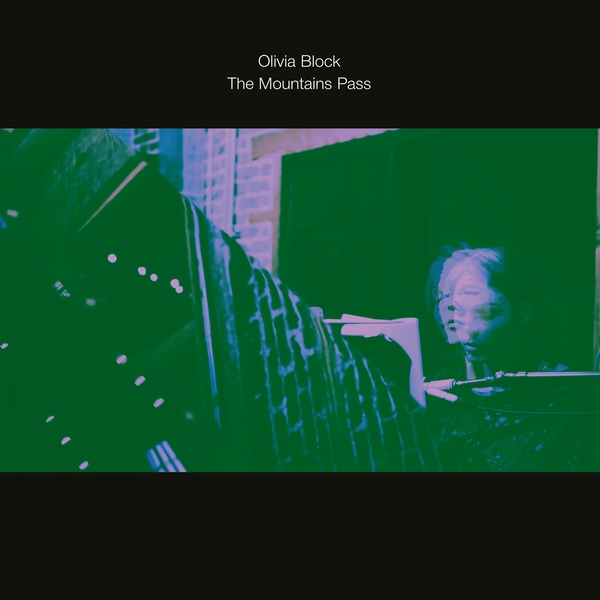
Olivia Block
The Mountains Pass
Label: Black Truffle
Format: LP + Digital
Catalogue Number: BT117
Official web site: oliviablock.bandcamp.com/album/the-mountains-pass
Description
Black Truffle is pleased to announce The Mountains Pass, a major new work from Olivia Block. A key player in Chicago’s vibrant experimental music scene since the late 1990s, Block has developed an extensive body of work grounded in a personalised, at times emotive approach to the studio-based practices of the musique concrète tradition, while also encompassing improvisation, orchestral pieces, sound installations, and a sustained engagement with the piano. On The Mountains Pass, recorded by Greg Norman at Steve Albini’s Electrical Audio and meticulously edited and constructed over the course of three years, Block pushes into new terrain, introducing her singing voice and drums played by Jon Mueller into flowing assemblages that move seamlessly from ruminative organ tones and fragmented piano airs to explosions of sizzling synths and thundering percussion.
Like many of Block’s past works, which include, for example, a sculptural installation using the sound of oyster beds, The Mountains Pass draws inspiration from nature and the animal world. Time spent in a particular mountain range in Northern New Mexico informs this suite of pieces, whose lyrics and titles refer particularly to animal life in the area. Beginning with bursts of white noise and delicate synthetic pops and squeaks, opener ‘Northward’ very soon reveals the special direction the album will take, as lyrical piano lines are joined by Block’s fragile voice, singing words written from the perspective of f2754, an endangered Mexican gray wolf who wandered more than five hundred miles from Arizona to New Mexico in 2022. The fragment of song quickly breaks off, leaving us with a ghostly electronic hum. ‘The Hermit’s Peak’ follows, one of two epic pieces at the album’s core. Beginning with chiming, almost harpsichord-like tones, it moves through episodes of spacious, ruminative piano, Jon Mueller’s sparkling cymbals, stuttering cut-up piano sounds, and a climax of keening organ and trumpet tones (performed by Thomas Madeja). Continuing the exploration of vintage keyboard and synth tones heard on Block’s Innocent Passage in the Territorial Sea (Room 40, 2021), the music sometimes suggests the great outer-limits works of 70s Italian prog figures like Franco Battiato or Arturo Stalteri in the languorous drift of synthesizer, organ, and piano tones and the meticulous yet organic flow of its construction.
‘Violet-Green’ opens the second side with another epic journey, its lyrical content concerning ‘a mysterious bird die-off and a forest fire’. Block’s crystalline voice and rich piano chords at times call up the restrained chamber songs of Janet Sherbourne, but fragmented and threaded through passages of woozy pitch-bent keyboards, hypnotic distant thuds, tinkling bells, and searing distorted synth tones. On ‘f2754’, the freedom of the roaming wolf surges through dense layers of rapid keyboard attacks and long organ tones over a propulsive drum performance straight out of Animal Magnetism-era Arnold Dreyblatt. This distinctive sound world is then reencountered in a darkened mirror image in the uneasy, metallic shimmer of the closing ‘Ungulates’, named in reference to a heard of elk roaming through the mountains. Like Battiato’s Clic or Gastr del Sol’s Upgrade & Afterlife, The Mountains Pass inhabits the underexplored terrain where the beauty of song coexists with a radical formal openness, illuminating the deep musicality and warmth that have been present in Block’s work all along.
Black Truffle is pleased to announce The Mountains Pass, a major new work from Olivia Block. A key player in Chicago’s vibrant experimental music scene since the late 1990s, Block has developed an extensive body of work grounded in a personalised, at times emotive approach to the studio-based practices of the musique concrète tradition, while ...
read more…
Tracklisting
- Northward
- The Hermit's Peak
- Violet-Green
- f2754
- Ungulates
Available from these fine distributors:
- USA – Forced Exposure www.forcedexposure.com
- Europe – Kompakt www.kompakt.fm/labels/black_truffle
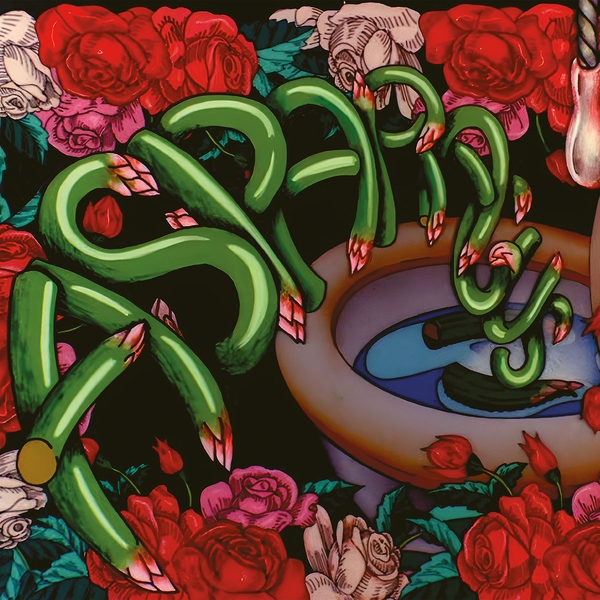
Richard Teitelbaum
Asparagus
Label: Black Truffle
Format: 2LP + Digital
Catalogue Number: BT116
Official web site: blacktruffle.bandcamp.com/album/asparagus
Description
Black Truffle is thrilled to announce a major archival release from legendary American composer and live electronics innovator Richard Teitelbaum, centred around his soundtrack for Suzan Pitt’s cult 1978 animation Asparagus. Best known to some listeners for introducing Europe to the Moog synthesizer as a founding member of Musica Elettronica Viva in Rome, Teitelbaum’s extensive and radically experimental body of work includes collaborative recordings with master improvisers like Anthony Braxton, Andrew Cyrille and George Lewis, intercultural experiments combining electronics with non-Western instruments such as the shakuhachi, works for computer controlled piano, and large-scale multi-media operas.
Recorded at York University, Toronto in 1975–1976, ‘Asparagus (European Version)’ sprawls across both sides of the first LP. Discovered by composer Matt Sargent in Teitelbaum’s tape archive, this is a previously unheard major work for Moog modular and Polymoog synthesizers, unique in Teitelbaum’s oeuvre for its lushness and gently melodic quality. The music unfolds slowly, submerging lyrical melodies and burbling arpeggios into uneasy, glacially shifting harmonic swells, the luscious texture thickened with subtle changes of modulation and phase, calling up the shifting layers of Costin Miereanu’s classic Derives or the kosmische Musik tradition more than any academic synthesizer exercise.
Teitelbaum incorporated much of this material into his soundtrack for Suzan Pitt’s Asparagus, which receives its first official release here. Asparagus, famously paired with David Lynch’s Eraserhead for a two-year run of midnight screenings at New York’s Waverly Theatre, uses hand-drawn and stop animation to unfurl an oneiric succession of images, beginning with a sequence in which the female protagonist defecates two stalks of asparagus, which multiply and float out of the toilet bowl to form the letters of the title. Teitelbaum’s soundtrack interweaves delicate drifting tones from the ‘European Version’ with contributions from Steve Lacy and Steve Potts on saxophones, George Lewis on trombone and Takehisa Kosugi on violin. Edited closely to the film, even without images the soundtrack proposes a surreal journey through floating synth tones, squealing horns, propulsive arpeggios, distant chatter, and an old-timey waltz.
The final side of the set presents a new realisation of Teitelbaum’s text score ‘Threshold Music’, performed at a memorial concert at Roulette, New York in 2022 by Leila Bourreuil (cello), Alvin Curran (sampler and objects), Daniel Fishkin (daxophone), Miguel Frasconi (glass objects) and Matt Sargent (lap steel). The piece asks musicians to match their instrumental volume to that of the sounds of the environment in which they play, sometimes with the addition of recorded environmental sounds, reinforcing frequencies they encounter in listening deeply to their surroundings. Here the players use a field recording taken at Teitelbaum’s home in Bearsville, New York, their long tones and shimmering, glassy textures delicately emerging from the white noise of the location recording.
Released with the full approval of both Richard Teitelbaum and Suzan Pitt’s estates, Asparagus is illustrated with striking images from Pitt’s film and accompanied by detailed liner notes by Francis Plagne. These previously unheard pieces shed new light on the work of a key composer in the American experimental tradition, offering up some of Teitelbaum’s most beautiful and engaging music.
Black Truffle is thrilled to announce a major archival release from legendary American composer and live electronics innovator Richard Teitelbaum, centred around his soundtrack for Suzan Pitt’s cult 1978 animation Asparagus. Best known to some listeners for introducing Europe to the Moog synthesizer as a founding member of Musica Elettronica Viva in Rome, Teitelbaum’s extensive ...
read more…
Tracklisting
- Asparagus (European Version) Part 1
- Asparagus (European Version) Part 2
- Asparagus (Original Soundtrack)
- Threshold Music
Available from these fine distributors:
- USA – Forced Exposure www.forcedexposure.com
- Europe – Kompakt www.kompakt.fm/labels/black_truffle

Dagar Brothers
Berlin 1964 – Live
Label: Black Truffle
Format: CD + Digital
Catalogue Number: BT115
Official web site: blacktruffle.bandcamp.com/album/berlin-1964
Description
Following on from last year’s acclaimed Vrindavan 1982 by rudra veena master Z.M. Dagar, Black Truffle is thrilled to present a pair of archival releases from the Dagar Brothers, among the most revered 20th century exponents of the ancient North Indian dhrupad tradition. The vocal duo of Moinuddin and Aminuddin Dagar (sometimes referred to as the ‘senior’ Dagar Brothers to distinguish them from their younger siblings, Zahiruddin and Faiyazuddin Dagar), belonged to the nineteenth generation of a family of musicians in which dhrupad tradition has been kept alive through patrilinear transmission, each generation undergoing a rigorous education of many years’ duration that can include singing up to twelve hours each day.
Famed for the meditative purity of their approach to dhrupad, the Dagar Brothers helped to keep the tradition alive in the years after Indian independence in 1947, when the royal courts that had traditionally patronised dhrupad musicians were abolished. Many Western listeners were first introduced to dhrupad by the Dagar Brothers’ tour of Europe in 1964-65 and their LP in UNESCO’s ‘Musical Anthology of the Orient’ collection, both organised by pioneering musicologist and scholar of Indian culture Alain Daniélou. Documents from this tour are especially precious, as Moinuddin Dagar passed away in 1966. Unheard until now, Berlin 1964 – Live (released alongside BT114, a newly discovered studio session from the same trip) documents a concert held at the Charlottenburg Palace in September 1964.
Accompanied only by Moinuddin’s wife Saiyur on tanpura and Raja Chatrapati Singh on pakhawaj (a large double-headed drum), the brothers present stunning performances of two ragas stretching out over 65 minutes, exemplifying what a journalist at the time called the ‘pristine severity’ of their style. Much of each piece is taken up by the alap, the highly improvised exposition section where the notes of the raga are gradually introduced as the singing builds in intensity. As Francesca Cassio points out in her extensive liner notes, both performances are somewhat unorthodox in beginning with the raga scale being sung in its entirety, ascending and descending; this is probably, as she suggests, a strategy to introduce the European audience to the language of the music they are about to hear. From there, both ragas settle into alaps of breathtaking beauty, with the two brothers trading long solo passages that move gradually from extended held notes at the bottom of the scale to animated melodic variations as it ascends in pitch. Within the atmosphere of meditative attention, the range of melodic, rhythmic, and timbral invention is remarkable. Especially on the opening ‘Rāga Miyān kī Todī’, the final moments of the alap find the voices at a peak of intensity, their microtonal ornamentation taking on an ecstatic, warbling quality. Only once the wordless, free-floating alap is over and the composition proper begins to the brothers sing in unison, joined by the pakhawaj for a rhythmic section that in both ragas develops gradually into a propulsive display of melodic invention and metrical nuance. Accompanied by detailed liner notes and striking archival images, Berlin 1964 – Live is a rare document of these masterful exponents of one of the world’s most profound musical traditions.
Following on from last year’s acclaimed Vrindavan 1982 by rudra veena master Z.M. Dagar, Black Truffle is thrilled to present a pair of archival releases from the Dagar Brothers, among the most revered 20th century exponents of the ancient North Indian dhrupad tradition. The vocal duo of Moinuddin and Aminuddin Dagar (sometimes referred to as ...
read more…
Tracklisting
- Rāga Miyān kī Todī (Dhamār)
- Rāga Gaud Sārang (Chartāl)
Available from these fine distributors:
- USA – Forced Exposure www.forcedexposure.com
- Europe – Kompakt www.kompakt.fm/labels/black_truffle

Dagar Brothers
Berlin 1964 – The Lost Studio Recording
Label: Black Truffle
Format: LP + Digital
Catalogue Number: BT114
Official web site: blacktruffle.bandcamp.com/album/berlin-1964-the-lost-studio-recording-2
Description
Following on from last year’s acclaimed Vrindavan 1982 by rudra veena master Z.M. Dagar, Black Truffle is thrilled to present a pair of archival releases from the Dagar Brothers, among the most revered 20th century exponents of the ancient North Indian dhrupad tradition. The vocal duo of Moinuddin and Aminuddin Dagar (sometimes referred to as the ‘senior’ Dagar Brothers to distinguish them from their younger siblings, Zahiruddin and Faiyazuddin Dagar), belonged to the nineteenth generation of a family of musicians in which dhrupad tradition has been kept alive through patrilinear transmission, each generation undergoing a rigorous education of many years’ duration that can include singing up to twelve hours each day.
Famed for the meditative purity of their approach to dhrupad, the Dagar Brothers helped to keep the tradition alive in the years after Indian independence in 1947, when the royal courts that had traditionally patronised dhrupad musicians were abolished. Many Western listeners were first introduced to dhrupad by the Dagar Brothers’ tour of Europe in 1964-65 and their LP in UNESCO’s ‘Musical Anthology of the Orient’ collection, both organised by pioneering musicologist and scholar of Indian culture Alain Daniélou. Documents from this tour are especially precious, as Moinuddin Dagar passed away in 1966. Berlin 1964 – The Lost Studio Recording (released alongside BT115, a newly discovered concert recording from the same trip) presents two unheard side-long performances in crystalline fidelity, recorded at the International Institute for Comparative Studies and Documentation in Berlin headed by Alain Daniélou. These stunning recordings were consigned to the archive because, as Peter Pannke explains in his liner notes, which recount his meeting with Danielou many years after these recordings were made, the tape ran out during ‘Raga Jaijaivanti’, which terminates abruptly soon after the entry of the pakhawaj.
Accompanied only by Moinuddin’s wife Saiyur on tanpura and Raja Chatrapati Singh on pakhawaj (a large double-headed drum), the brothers present stunning performances of the severe, serious midnight ‘Raga Malkauns’, set to a ten beat cycle once the pakhawaj enters, and the complex early evening ‘Raga Jaijaivanti’, set to a fourteen beat cycle in its rhythmic section. True to the traditional dhrupad structure, both performances are dominated by the long free-floating alap section, where the notes of the raga are gradually introduced, slowly climbing in pitch and intensity as the two singers trade improvisations that display a stunning range of vocal tones and remarkable subtlety in mictrotonal nuance. The performance of ‘Raga Malkauns’ is divided roughly in half, with the pakhawaj and unison singing entering around thirteen minutes through; Raja Chatrapati Singh’s performance is particularly striking in its endlessly inventive metrical nuance within the overall crescendo and acceleration. On ‘Raga Jaijaivanti’, the alap lasts almost twenty minutes, with Singh joining only for a few minutes of sparse pakhawaj hits before the tape cuts off, the absence of the more active concluding section serving only to magnify the mystical calm the Dagar Brothers establish in this setting of a 16th century love poem.
Illustrated with a striking full colour concert photograph, Berlin 1964 – The Lost Studio Recording is accompanied by extensive liner notes by Peter Pannke celebrating musicologist Alain Daniélou, whose study, documentation and promotion of dhrupad was so important for spreading awareness of this great musical tradition, ready to be discovered anew in this stunning recording from two of its master exponents.
Following on from last year’s acclaimed Vrindavan 1982 by rudra veena master Z.M. Dagar, Black Truffle is thrilled to present a pair of archival releases from the Dagar Brothers, among the most revered 20th century exponents of the ancient North Indian dhrupad tradition. The vocal duo of Moinuddin and Aminuddin Dagar (sometimes referred to as ...
read more…
Tracklisting
- Raga Malkauns
- Raga Jaijaivanti
Available from these fine distributors:
- USA – Forced Exposure www.forcedexposure.com
- Europe – Kompakt www.kompakt.fm/labels/black_truffle
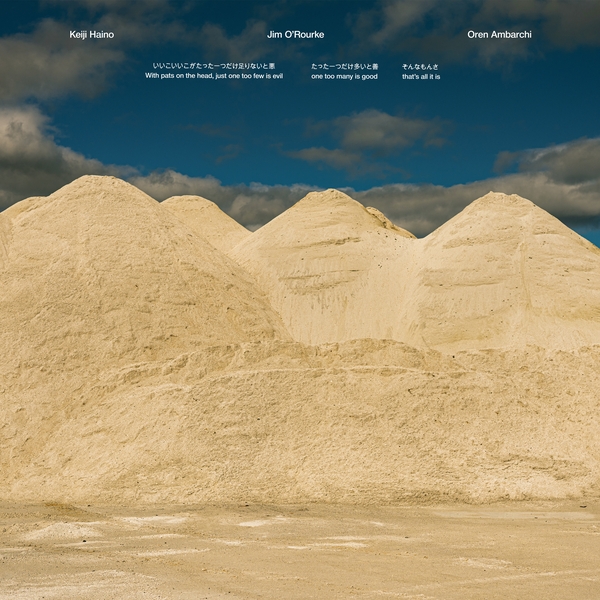
Keiji Haino / Jim O’Rourke / Oren Ambarchi
With pats on the head, just one too few is evil one too many is good that’s all it is
Label: Black Truffle
Format: 3LP + Digital
Catalogue Number: BT113
Official web site: orenambarchi.bandcamp.com/album/with-pats-on-the-head-just-one-too-few-is-evil-one-too-many-is-good-thats-all-it-is
Description
The heavyweight trio of Keiji Haino, Jim O’Rourke and Oren Ambarchi return with their 12th and most epic release to date, the triple LP With pats on the head, just one too few is evil one too many is good that’s all it is. Documenting the entirety of their final performance at the dearly departed Roppongi home of Tokyo underground institution SuperDeluxe in November 2018, the music spread across these six sides splits the difference between the guitar-bass-drums power trio moves and experiments with novel instrumentation that have defined the trio’s decade of working together. Containing some of the most delicate music the three have committed to wax since the gorgeous 12-string acoustic guitar and dulcimer tones of Only wanting to melt beautifully away is it a lack of contentment that stirs affection for those things said to be as of yet unseen (BT011), this wide-ranging release also offers up some of their most blistering free rock performances yet.
The side-long opening piece finds Haino on a single snare drum in duet with O’Rourke on unamplified electric guitar, playing in the lovely post-Bailey vein heard on his classic 90s recordings with Henry Kaiser and Mats Gustafsson. Spiky dissonance and ringing harmonics interweave with flowing melodic fragments as Haino single-mindedly explores the resonance of the snare like an untutored Han Bennink. On ‘Right brain, left brain; right, left; right wing, left wing. Just how many combinations can be made from these?’, O’Rourke moves to synth and electronics, joined by Ambarchi on drums, who at first focuses on sizzle cymbals before hypnotic cycles of gentle tom rhythms combine with electronic burbles and flutters to suggest a dream collaboration between Masahiko Togashi and Jean Schwarz. Ambarchi’s percussion is then joined by Haino on wandering, overblown flute, before the man in black switches back to the snare for a bizarre, stuttering drum duet.
For the first trio performance, Haino makes another new addition to his seemingly infinite catalogue of instruments, this time a homemade contraption he refers to as ‘Strings of Dubious Reputation’. Joined by O’Rourke on increasingly spaced-out electric guitar and Ambarchi on skittering percussion, Haino’s wonky, slack strings adds a definite ‘musique brut’ edge to this side-long performance, certainly one of the most enchantingly odd in the trio’s discography. When the group reconvene for the second set, spread out across the final three sides, they seem ready to breathe fire from the first instant. O’Rourke slashes distorted chords on the six-string bass, Ambarchi breaks into his signature irregular caveman thump, and Haino squeals and squawks on heavily delayed oboe before unleashing an overpowering electrical storm when he first picks up the guitar. For over half an hour, the trio pound out one of their most relentless performances, a constantly rearranging kaleidoscope of tortured fuzz guitar, insanely busy bass riffing and propulsive, tumbling drums. A hushed atmosphere initially reigns on the final long piece, given the mournful title ‘There are always things I wish to say but I can only convey them in this language August 6 August 9’. Haino’s clean guitar strumming calls up the shimmering tones of his PSF classic Affection, gradually building to a surging wall of sound, bass and drums lumbering through a roar of jet-engine guitar.
Arriving in a deluxe trifold package with photos by Lasse Marhaug alongside inner sleeves with extensive live images, this epic release is perhaps the most remarkable document yet of this unique trio’s stamina and continuing inventiveness.
The heavyweight trio of Keiji Haino, Jim O’Rourke and Oren Ambarchi return with their 12th and most epic release to date, the triple LP With pats on the head, just one too few is evil one too many is good that’s all it is. Documenting the entirety of their final performance at the dearly departed ...
read more…
Tracklisting
- My “Watashi Dake?” is definitely not included in this unequal treaty, is it?
- Right brain, left brain; right, left; right wing, left wing. Just how many combinations can be made from these?
- “Critical consciousness?” That’s been abandoned in corner of a shower room in a 53-storey apartment building inhabited by extra-terrestrial lifeforms…..
- I thought I had pulverized it summarily but there are just too many who lack reality or who are cowards so I cannot change a thing
- Still divided into pieces? Let’s reconnect them Recognise that you are a point And the longest line Let it become light
- I can no longer sense that sacred feeling of expression Just the loitering of vulgar vibrations that can only be described as a half-hearted class reunion Will you consent to this?
- There are always things I wish to say but I can only convey them in this language August 6 August 9
Available from these fine distributors:
- USA – Forced Exposure www.forcedexposure.com
- Europe – Kompakt www.kompakt.fm/labels/black_truffle
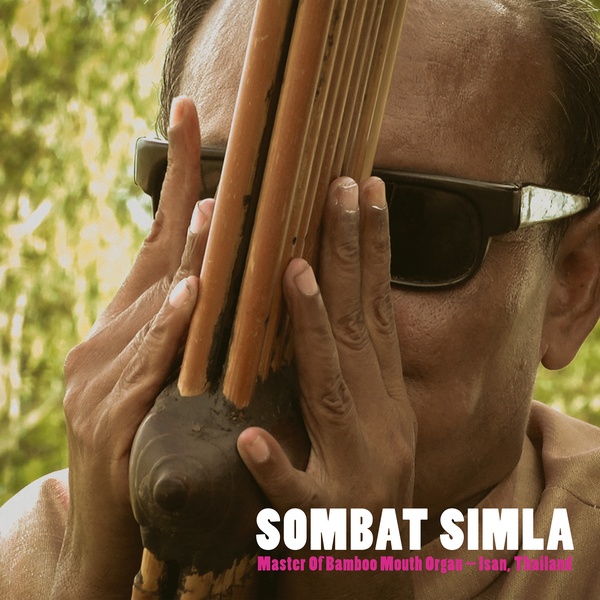
Sombat Simla
Master Of Bamboo Mouth Organ – Isan, Thailand
Label: Black Truffle
Format: LP + Digital
Catalogue Number: BT112
Official web site: blacktruffle.bandcamp.com/album/master-of-bamboo-mouth-organ-isan-thailand
Description
Black Truffle is pleased to announce the first LP documenting master khene player Sombat Simla, the label’s first collaboration with Japanese sound artist, field recordist, and researcher Yasuhiro Morinaga. Simla is known in Thailand as one of the greatest living players of the khene, the ancient bamboo mouth organ particularly associated with Laos but found throughout East and Southeast Asia. His virtuosic and endlessly inventive renditions of traditional and popular songs have earned him the title ‘the god of khene’, and he is known for his innovative techniques and ability to mimic other instruments and non-musical sound, including, as a writer for the Bangkok Post describes, ‘the sound of a train journey, complete with traffic crossings and the call of barbecue chicken vendors’.
Aided by a group of Thai friends, in 2018 Morinaga travelled to the Maha Sarakham province in the Isan region, arranging to meet Simla in a remote spot surrounded by rice fields. Then and there, Morinaga recorded the solo performances heard on the LP’s first side. At Morinaga’s request, Simla began with a rendition of the train song ‘Lot Fay Tay Lang’. Beginning with long tones that seem to mimic a train horn, the performance soon moves into a rapid chugging rhythm, interrupted at points by vocal exclamations and the remarkable timbre Simla produces by singing through the khene. To listeners unfamiliar with Thai music, the pentatonic scales and rhythmic chug of many of the pieces can have surprising echoes of the rawest American blues. The range of Simla’s performance is astonishing, moving from compulsive rhythmic workouts on single chords and rapid-fire runs of single notes to gentle sing-song melodies, and using a fascinating array of techniques, including a rapid tremolo that sometimes sounds almost electronic.
Later the same day, Morinaga followed Simla to a cattle shed where he met percussionist Mali Moodsansee to play some molam (folk songs found in Isan and neighbouring Laos), with Pattardon Ekchatree joining in on cymbal. At times, these molam songs have a wistful, romantic character quite different from the solo pieces. Backed up by the propulsive hand drums, Simla again dazzles with his melodic fluidity, rhythmic drive, and wild displays of unorthodox technique. As Morinaga writes, ‘It felt like they had been playing together so long that their breathing was perfectly in sync, and it was like listening to the precision of James Brown’s funk’. Accompanied by extensive liner notes by Morinaga detailing the day of recording, this is a stunning document of a master musician, seamlessly integrating tradition and innovation.
Black Truffle is pleased to announce the first LP documenting master khene player Sombat Simla, the label’s first collaboration with Japanese sound artist, field recordist, and researcher Yasuhiro Morinaga. Simla is known in Thailand as one of the greatest living players of the khene, the ancient bamboo mouth organ particularly associated with Laos but found ...
read more…
Tracklisting
- Line Rod Fai – Train
- Tuey Non Tarn
- Lom Phat Prow
- Tang Waii - Wicker Stool
- Lai Soy Puen Baan
- Line Khene Racing
- Hak Sao Siang Khene
- Seung Swing
- Siang Khene Hoy Hooun
- Khene Lam Sing
Available from these fine distributors:
- USA – Forced Exposure www.forcedexposure.com
- Europe – Kompakt www.kompakt.fm/labels/black_truffle
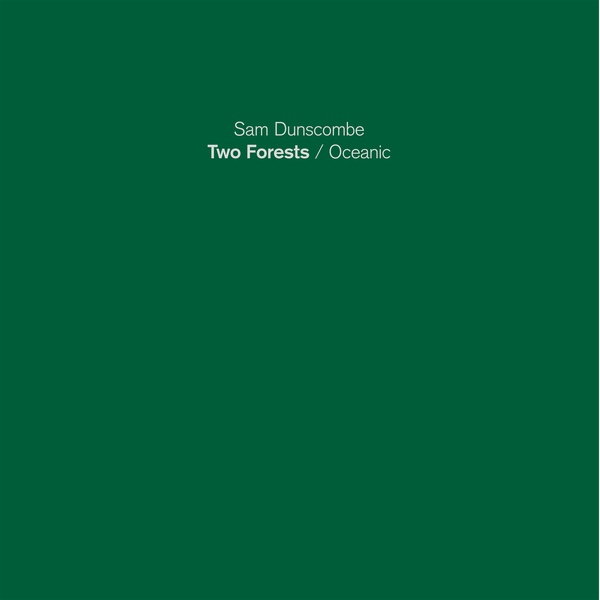
Sam Dunscombe
Two Forests / Oceanic
Label: Black Truffle
Format: LP + Digital
Catalogue Number: BT111
Official web site: blacktruffle.bandcamp.com/album/two-forests
Description
Following on from the psychoacoustic concrète of Outside Ludlow / Desert Disco LP (BT075), Sam Dunscombe returns to Black Truffle with Two Forests / Oceanic. Dunscombe has been active in recent years on multiple fronts, including as a key member of the Berlin community of Just Intonation researchers and practitioners; working with composers like Taku Sugimoto, Mary Jane Leach, and Anthony Pateras; and the release of Horatiu Radulescu – Plasmatic Music vol. 1 (the result of many years performance research into the thought and music of this seminal Romanian spectralist). In parallel with these activities, Dunscombe has been deeply involved in research on the role of music in psychedelic-assisted psychotherapy, prompting these two side long pieces, composed using field recordings and digital synthesis.
As Dunscombe explains in the accompanying liner notes, music plays a key role in psychedelic-assisted therapy, yet it is often restricted to stock forms of New Age, ambient and electronica. Taking seriously the potential for spatio-environmental sonic experiences to add to the therapeutic process, these two pieces are intended to suggest how ‘a music-as-environment approach may help to add options to the therapist’s toolbox’.
‘Two Forests’ begins in a central Californian sequoia grove. Bird songs and buzzing insect life are treated with a variety of time-based processing methods (slicing and recombination, primitive granular synthesis, delay, and so on), which strip the field recordings of their linear, documentary character, reframing them in an enchanted web of traces and echoes. Analysing the pitches found in the original recordings, Dunscombe used them to generate a large Just Intonation pitch set. These tones are woven slowly into the field recordings, gradually building in density and complexity until the forest has been transformed into an unreal space of infinite proportions. Emerging from this cosmic expanse in the final minutes of the piece, we find ourselves in the Amazon rainforest outside Manaus, Brazil. As Dunscombe writes, the piece creates ‘a sense of place-gone-strange, of space and time simultaneously expanding and contracting across octaves, miles, and minutes’.
On ‘Oceanic’, several recordings of different beaches fade in and out to create a texture both homogenous and constantly shifting in both the rhythm of the waves and each recording’s sense of depth and distance. Tones relating in simple ratios to the average rhythm of each beach float over each other, colouring the white noise texture of the field recordings with shifting hues. In both pieces, Dunscombe forgoes the easy consonance that bogs down much contemporary ambient music for a richer harmonic array informed by extended tuning practices and spectralism. The end results suggest a hitherto undreamt-of meeting of Radulescu’s undulating sonic masses and the discreetly processed location recordings of Irv Teibel’s ‘psychologically ultimate’ Environments. Looking beyond the insularity that can afflict experimental music culture, Dunscombe’s work is a moving argument for the healing power of expanded approaches to sound and music. Even outside of a psychedelics-assisted therapy, frequent immersion in Two Forests / Oceanic is almost guaranteed to produce beneficial psychological results.
Following on from the psychoacoustic concrète of Outside Ludlow / Desert Disco LP (BT075), Sam Dunscombe returns to Black Truffle with Two Forests / Oceanic. Dunscombe has been active in recent years on multiple fronts, including as a key member of the Berlin community of Just Intonation researchers and practitioners; working with composers like Taku Sugimoto, Mary Jane ...
read more…
Tracklisting
- 2F
- O
Available from these fine distributors:
- USA – Forced Exposure www.forcedexposure.com
- Europe – Kompakt www.kompakt.fm/labels/black_truffle

Ustad Zia Mohiuddin Dagar
Vrindavan 1982
Label: Black Truffle
Format: 2LP + Digital
Catalogue Number: BT110
Official web site: blacktruffle.bandcamp.com/album/vrindavan-1982
Description
Black Truffle is thrilled to present a previously unheard performance by rudra veena master Ustad Zia Mohiuddin Dagar, recorded in the North Indian city of Vrindavan at the Druhpad Samaroh festival in 1982. Z.M. Dagar was a nineteenth-generation descendant of the Dagar family of musicians, famed for their profoundly meditative approach to the tradition of Hindustani court music. Perhaps the most revered members of the family were the brothers Mohinuddin and Aminuddin Dagar, who played a key role in reawakening interest in dhrupad in the mid-20th century. The great exponents of the tradition from whom Z.M. Dagar descended were all singers, and dhrupad is essentially vocal music. However, as Z.M. Dagar explained, the veena family of instruments plays an important role in the education and practice of dhrupad singers, especially as an aid to mastering the fine microtonal nuances of pitch essential to the genre. Introduced as a child by his father to the rudra veena, a large and low-pitched veena amplified by two enormous gourds, Z.M. Dagar became the first modern dhrupad musician to perform with it as an instrumental soloist, giving his first recital at the age of 16.
Devoted to the instrument throughout his life, he made innovations to its design and materials, as well as introducing novel techniques (such as playing without the use of the traditional wire plectrum, resulting in the remarkable warmth of his tone). In the great Dagar family tradition, his approach to the various ragas that make up the dhrupad repertoire was stately, slow, and considered, with a great emphasis on the alap, the heavily improvised exposition section. True to form, in this recording of Dagar performing the night raga Yaman Kalyan, the alap section stretches out to more than forty minutes of slow-motion bliss, a frozen tanpura drone hovering above Dagar’s gracefully bent notes and elegantly twisting phrases. In the alap’s first half, Dagar’s figures are so intently focused on the lower reaches of the rudra veena’s range that they register more as shudders and moans than melodic patterns. As the performance continues, he slowly climbs in pitch, though continuing with the same intent focus on the articulation of single notes and subtle microtonal variations. This leads to the jod section of the performance, which, though still accompanied only by the tanpura, gradually takes on a more rhythmic character. Developing almost imperceptibly over the course of nearly thirty minutes, the jod moves from the stillness of the opening alap to a rapid pulse that announces the closing section of the piece, where Dagar is joined by Shrikant Mishra on the pakhawaj (a double headed hand drum). Where many performers use the final section of the raga as an exercise in unrestrained virtuosity, Dagar and Mishra subtly weave a web of finely shifting accents and hypnotic melodic variations, bringing the recording to a fitting conclusion while remaining within the meditative space occupied by the performance as a whole.
Adorned with beautiful archival photographs of Dagar taken by Swedish percussion legend Bengt Berger and accompanied by detailed notes from Bradford Bailey, Vrindavan 1982 is a stunning document of music unmatched in its patient focus and mysterious emotional depth.
Black Truffle is thrilled to present a previously unheard performance by rudra veena master Ustad Zia Mohiuddin Dagar, recorded in the North Indian city of Vrindavan at the Druhpad Samaroh festival in 1982. Z.M. Dagar was a nineteenth-generation descendant of the Dagar family of musicians, famed for their profoundly meditative approach to the tradition of ...
read more…
Tracklisting
- Raga Yaman Kalyan - Alap Part 1
- Raga Yaman Kalyan - Alap Part 2
- Raga Yaman Kalyan – Jod
- Raga Yaman Kalyan - Jhala & Chautala (12 Beats)
Available from these fine distributors:
- USA – Forced Exposure www.forcedexposure.com
- Europe – Kompakt www.kompakt.fm/labels/black_truffle
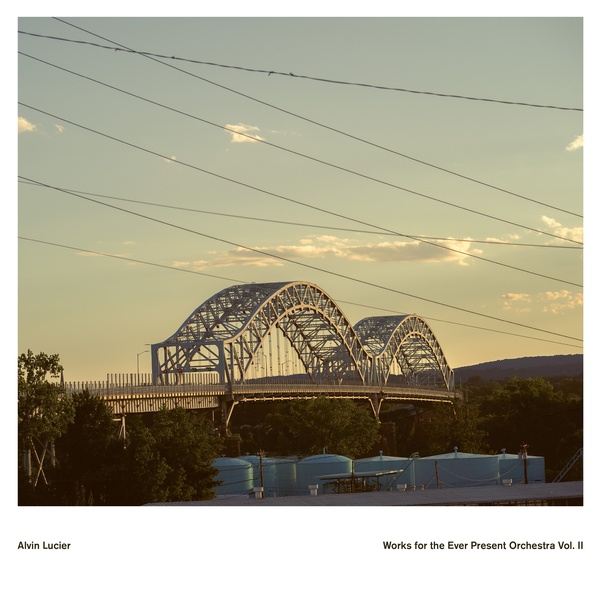
Alvin Lucier
Works for the Ever Present Orchestra Vol.II
Label: Black Truffle
Format: LP + Digital
Catalogue Number: BT109
Official web site: blacktruffle.bandcamp.com/album/works-for-the-ever-present-orchestra-vol-ii
Description
Works for the Ever Present Orchestra Vol. II continues Black Truffle’s documentation of the late work of legendary American experimental composer Alvin Lucier, who sadly passed away in 2021 at the age of 90. Like the first volume of the series, the two works recorded here were written for The Ever Present Orchestra, an ensemble founded in Zürich in 2016 to perform Lucier’s work exclusively. At the core of the music Lucier wrote for the ensemble is the electric guitar, an instrument he began to explore in 2013. Played with e-bows, in these works electric lap steel guitars take on roles akin to the slow sweep pure wave oscillators heard in many of Lucier’s works since the early 1980s. This strikingly elegant pair of compositions would serve as an ideal introduction to Lucier’s late music for a listener as yet unfamiliar with its graceful exploration of beating patterns and other acoustic phenomenon.
The two pieces have quite different characters, exemplifying Lucier’s ability to harvest a remarkable range of musical results from closely related compositional procedures and concerns. In Arrigoni Bridge (2019), Lucier uses a technique familiar from earlier works such as Still Lives (1995), where sine waves traced the shapes of household objects. Here, three lap steel electric guitars (played by Oren Ambarchi, Bernhard Rietbrock, and Jan Thoben) follow the form of the Arrigoni Bridge that connects Middletown and Portland, Connecticut. The bridge’s two enormous steel arcs become slowly sweeping pitches, alongside which alto saxophone (Joan Jordi Oliver Arcos), violin (Rebecca Thies) and cello (Lucy Railton) sustain long tones, creating a variety of audible beating patterns depending on their distance from or proximity to the guitars. With its stately pacing, warm middle register tones, and rich timbral variety in the sustaining instruments, Arrigoni Bridge is a beautiful example of compositional reduction producing immersive results.
Flips (2020), on the other hand, is more austere. Scored for two lap steel electric guitars (Rietbock and Thoben), double bass (Ross Wightman) and glockenspiel (Trevor Saint), the two acoustic instruments played with bows, the piece zooms in on the range of a major second (two semitones). The two guitars sweep in opposite directions within the range, crossing every four minutes; the double bass and glockenspiel sustain long tones, producing beats of different speeds determined by their distance from the guitar tones. This limitation of the tonal range means the music is often dissonant and forces the phenomenon of audible beating to the surface, resulting in a paradoxical music composed entirely of long tones yet alive with pulsating rhythm. Exemplifying Lucier’s ability to uncover near-infinite complexity within seemingly simple materials, Works for the Ever Present Orchestra Vol. II is a fitting tribute to one of the major figures of the experimental music tradition and a testament to the continuing power of his work.
Works for the Ever Present Orchestra Vol. II continues Black Truffle’s documentation of the late work of legendary American experimental composer Alvin Lucier, who sadly passed away in 2021 at the age of 90. Like the first volume of the series, the two works recorded here were written for The Ever Present Orchestra, an ensemble ...
read more…
Tracklisting
- Arrigoni Bridge
- Flips
Available from these fine distributors:
- USA – Forced Exposure www.forcedexposure.com
- Europe – Kompakt www.kompakt.fm/labels/black_truffle
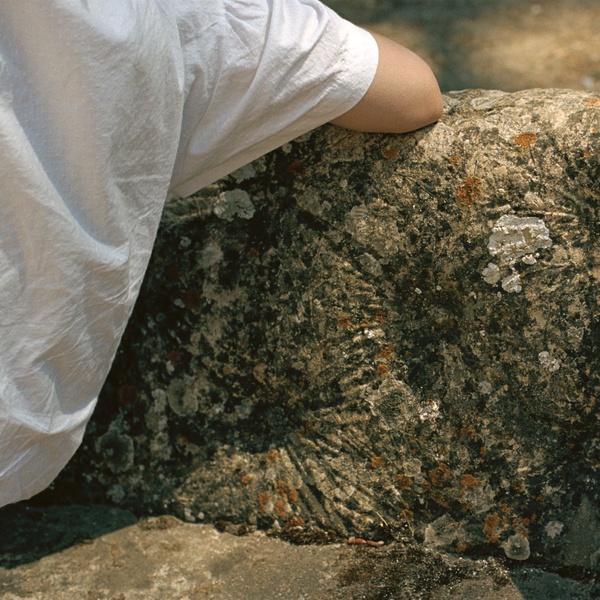
Marja Ahti
Tender Membranes
Label: Black Truffle
Format: LP + Digital
Catalogue Number: BT108
Official web site: blacktruffle.bandcamp.com/album/tender-membranes
Description
Black Truffle is pleased to announce Tender Membranes, the label’s first release from Swedish-Finnish sound artist and electro-acoustic composer Marja Ahti. Active for a decade in the Finnish underground music scene, in recent years Ahti has developed a distinctive approach to patiently unfolding electro-acoustic constructions, documented on a string of solo releases and collaborative projects with Judith Hamann and her husband Niko-Matti Ahti. Working with concrete and instrumental sounds, field recordings, and electronics, Ahti favours neither disjunctive collage nor monolithic consistency; rather, her work is composed of organically unfolding sequences of details and textures, which, as she says, ‘can stretch out or cut fast as long as they have a sense of inner stillness’, a sense that she connects to moments of heightened attention in everyday life.
Tender Membranes consists of four lengthy pieces, partly inspired by the image of the senses and mind as membranes allowing for the passage between inner and outer spaces, sensation and its causes, creating a world. Ahti’s unhurried pacing encourages this sense of listening as an opening or surrender to sound, which can often create the impression that the listener is moving through a space zooming in on details. The opening Shrine (Aether) exemplifies this aspect of Ahti’s approach: a bell clears the air with a single long tone, followed by the ambience of outdoor spaces, crackling electronics, an archival recording of a horsefly on a windowpane. Dozens of these moments, varying in length, density, and intensity, move past the listener’s attention, momentarily brought into focus then slipping away. Like those of the masters of the French musique concrète tradition, Ahti’s sounds are not often recognisable, though they might suggest proximity or distance, open environments or closed spaces, the urban or rural, day or night. In Ahti’s work, we do not encounter spectacular metamorphoses à la Parmegiani but rather a state of ambiguity where the listener is often unsure what is organic and what is inorganic, where the careful productions of the synthesizer might end and sounds discovered in the environment begin.
What Ahti calls her ‘poetic way of experiencing and organising the familiar and the unfamiliar’ is sustained throughout Tender Membranes, but each piece has its own character. On Dust / Light, human presence is more overt, as what appear to be whispers, singing, and distant speech thread between high frequencies, untraceable drips and pops, and metallic shimmers. In all this there is a melody that you can sing and to which you may dance makes more prominent use of musical instruments, gaining a sombre beauty from half-buried piano chords and organ tones. On the closing Oh Fragrant Witness, a delicate cloud of subtly bending pitches is repeatedly disrupted by a resounding, almost ominous mass of low tones, at once a strange detour from much of what has gone before and an almost classical finale. Arriving in a sleeve reproducing contemporary Finnish photographer Sini Pelkki’s fragmented visions of the everyday, Tender Membranes is a balm to reawaken tired ears.
Black Truffle is pleased to announce Tender Membranes, the label’s first release from Swedish-Finnish sound artist and electro-acoustic composer Marja Ahti. Active for a decade in the Finnish underground music scene, in recent years Ahti has developed a distinctive approach to patiently unfolding electro-acoustic constructions, documented on a string of solo releases and collaborative projects with ...
read more…
Tracklisting
- Shrine (Aether)
- Dust / Light
- In all this, there is a melody that you can sing and to which you may dance
- Oh Fragrant Witness
Available from these fine distributors:
- USA – Forced Exposure www.forcedexposure.com
- Europe – Kompakt www.kompakt.fm/labels/black_truffle
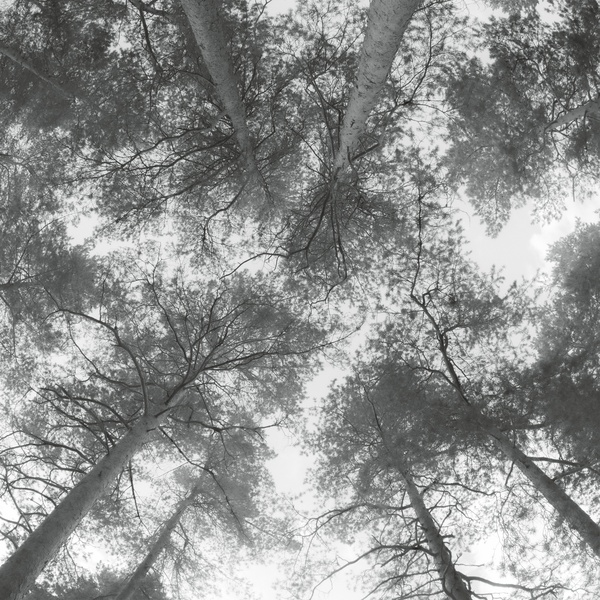
Cassandra Miller
Traveller Song / Thanksong
Label: Black Truffle
Format: LP + Digital
Catalogue Number: BT107
Official web site: blacktruffle.bandcamp.com/album/traveller-song-thanksong
Description
Black Truffle is pleased to announce its first release from celebrated London-based Canadian composer Cassandra Miller. Though her body of mature work stretches back almost twenty years, many listeners were introduced to Miller through the success of her astonishing 2015 Duet for Cello and Orchestra, which sets an imperturbable two-note cello part against a series of increasingly dense orchestrations of an Italian folk melody; in 2019, it was selected by The Guardian as one of the ‘best classical music works of the 21st century’. Traveller Song / Thanksong, the first release of her music on vinyl, presents a pair of compositions for voice and ensemble that exemplify Miller’s gently absurd, strikingly beautiful, and utterly unique work.
Like many of Miller’s compositions, these pieces originate in existing music. Traveller Song (2016/2018) begins from a 1950s song of an anonymous Sicilian cart driver recorded by Alan Lomax and Diego Carpitella, which Miller recorded herself singing along to, going on to then record herself singing to her own layered voices. Miller’s untutored voice is an unsteady, wavering wail that has, in her words, ‘more in common with a quasi-shamanistic keening than anything Sicilian’. Heard sometimes alone, sometimes layered, her pre-recorded voice is accompanied by a chamber sextet drawn from London’s Plus-Minus Ensemble. In the first section, Miller’s exposed warble is set to a spare piano accompaniment, somehow both faintly preposterous and magisterial. Following the voice note for note, the piano part often makes use of almost mechanical sequences of parallel chords, reminiscent both of Satie’s Rosicrucian period and the abrupt harmonic movements of a chord organ. The orchestration then opens up to guitar, clarinet, and sliding strings, a delicate environment for Miller’s voice, which, especially when it begins to be layered, generates a powerful sense of intimacy. In its concluding minutes, the folk roots of the original melody return in the form of a glorious full ensemble setting dominated by accordion, clarinet, and strummed guitar.
Thanksong begins from recordings of Miller singing along to the third movement of Beethoven’s late quartet in A minor (Op. 132), the ‘holy song of thanks’ the composer wrote to express his gratitude for (temporarily) recovering from illness. Recording herself singing along repeatedly to each of the individual parts of the quartet, Miller created an aural score where each member of the string quartet listens to their own part on headphones, playing by ear. Performed on this recording by Montreal’s Quatuor Bozzini, with whom Miller has a decades-long relationship, they are joined by the British soprano Juliet Fraser, who sings material from the Beethoven quartet ‘as slowly and quietly as possible’. The atmosphere of the opening of Beethoven’s Dankgesang, of hushed reawakening and thoughtful reflection, is sustained throughout the fourteen minutes of Miller’s piece, building at points almost to sentimentality before the five individual parts again fall back into a gentle burble of unsynchronised melodic gestures. Like Traveller Song, here the use of the voice is a long way from the mannered performance of much contemporary music, reaching for a human and bodily presence more connected to the reality of the everyday, albeit suffused with wonder. Presented in a stylish sleeve adorned with photography by Lasse Marhaug and liner notes by Cassandra Miller, this is a key release from a major contemporary composer whose work challenges and dazzles in equal measure.
Black Truffle is pleased to announce its first release from celebrated London-based Canadian composer Cassandra Miller. Though her body of mature work stretches back almost twenty years, many listeners were introduced to Miller through the success of her astonishing 2015 Duet for Cello and Orchestra, which sets an imperturbable two-note cello part against a series of ...
read more…
Tracklisting
- Traveller Song
- Thanksong
Available from these fine distributors:
- USA – Forced Exposure www.forcedexposure.com
- Europe – Kompakt www.kompakt.fm/labels/black_truffle
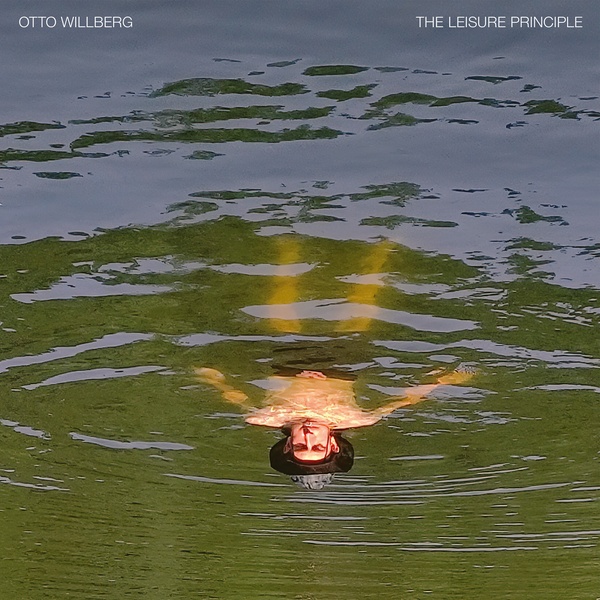
Otto Willberg
The Leisure Principle
Label: Black Truffle
Format: LP + Digital
Catalogue Number: BT106
Official web site: blacktruffle.bandcamp.com/album/the-leisure-principle
Description
Black Truffle is pleased to announce The Leisure Principle, a new solo LP from London-based bassist and sound artist Otto Willberg. A key player in the London underground, Willberg is often heard on acoustic and electric bass in free improv settings and bands with Laurie Tompkins (Yes Indeed) and Charles Hayward (Abstract Concrete), as well as the fractured No Wave unit Historically Fucked. His previous solo releases have ranged from extended technique double bass to explorations of the acoustics of a 19th century artillery fort. But nothing Willberg has committed to wax so far prepares a listener for The Leisure Principle, six unashamedly melodic improvisational workouts created almost entirely with heavily filtered bass harmonica and electric bass.
On the opening ‘Reap What Thou Sow’, a single-note bass harmonica loop pulses along underneath a roaming bass solo, the side-chained envelope filtering (where the dynamic behaviour of the bass determines the filter for both bass and harmonica) fusing the two instruments into a single stream of burbling shifts in resonance. After several minutes of patient exploration of this low-end landscape, the music suddenly opens up in widescreen with the entrance of Sam Andreae’s graceful melodica chords, spreading out across the stereo field. From this epic opener, each of the remaining pieces goes on to explore a slightly different aspect of the terrain. On ‘Shadow Came into the Eyes as Earth Turned on its Axis’, a similarly buoyant harmonica bass line provides the foundation, but this time playing a soulful descending riff, its almost R&B feel abstracted and half-obscured by the filtering. On ‘Mollusk’, echoed bass arpeggios skitter between elegiac chords somewhat reminiscent of the opening of John Abercrombie’s ‘Timeless’, before settling into a hypnotic groove.
On the record’s second half, Willberg pushes further into the possibilities of his idiosyncratic instrumentation. On ‘Wetter’, bass and harmonica come together into a monstrous, growling jaw harp; on ‘Had we but world enough and more time’, the subtly shifting pulsating patterns start to feel almost like a kind of evaporated, drum-less dub techno until an eruption of wheezing bass harmonica gives the piece a comically folkish turn. Willberg’s melodically inventive and virtuosic bass performance calls to mind any number of fusion touchstones, from Jaco Pastorius to Mark Egan’s singing tone in the early Pat Metheny Group—even Anthony Jackson’s work with Steve Kahn. But with its radically reduced instrumentation, The Leisure Principle is also an exercise in minimalism, and the absence of percussion gives even its funkiest moments a strangely abstracted quality. At times, its uncanny blend of the abstruse and the immediate suggests the fried pop experiments of David Rosenboom or the skewed but deeply musical DIY of 80s underground groups like De Fabriek. Both easy on the ear and profoundly strange, The Leisure Principle proudly takes its place among the most eccentric offerings on the Black Truffle menu.
Black Truffle is pleased to announce The Leisure Principle, a new solo LP from London-based bassist and sound artist Otto Willberg. A key player in the London underground, Willberg is often heard on acoustic and electric bass in free improv settings and bands with Laurie Tompkins (Yes Indeed) and Charles Hayward (Abstract Concrete), as well as ...
read more…
Tracklisting
- Reap What Thou Sow
- Shadow Came Into The Eyes as Earth Turned on its Axis
- Mollusk
- Wetter
- Had we but world enough and more time
- Licker
Available from these fine distributors:
- USA – Forced Exposure www.forcedexposure.com
- Europe – Kompakt www.kompakt.fm/labels/black_truffle
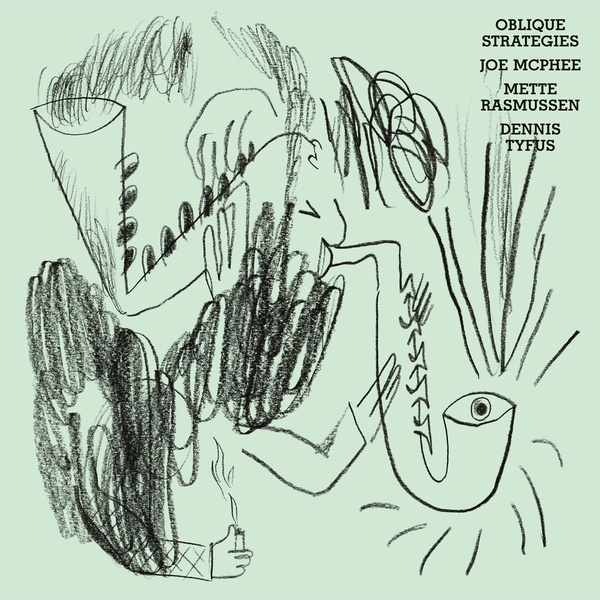
Joe McPhee / Mette Rasmussen / Dennis Tyfus
Oblique Strategies
Label: Black Truffle
Format: LP + Digital
Catalogue Number: BT105
Official web site: blacktruffle.bandcamp.com/album/oblique-strategies
Description
Black Truffle is pleased to welcome free jazz legend Joe McPhee back to the fold with Oblique Strategies, a wild trio recorded in Antwerp in 2018 in the company of Mette Rasmussen’s fire-breathing alto saxophone and Dennis Tyfus’s post-Fluxus antics on tape, voice, and percussion. Rasmussen and Tyfus have previously recorded together as Bazuinschal, and some similar strategies are on display here: mysterious metallic scrapes, extended tones in which voice and sax become indistinguishable, comic explosions of varispeed tape. With McPhee on board, however, proceedings are more sumptuous, with the two horns moving fluidly from expeditions into the extremes of their instruments’ registers to pointillistic note-splatter and Ayler-esque folk melodies; we even get to bask in some of the slow-motion free blues that McPhee has now been playing for half a century.
McPhee is heard primarily on tenor, Rasmussen mainly on alto, but with Rasmussen doubling on sundry objects, and the whole trio contributing vocals, certainty about who is doing what becomes nigh impossible. The recording and production add to this hazy unclarity. Where much contemporary improvised music aims at dryly clinical hi-fi, the lively reverberant space of Oblique Strategies calls to mind the less-than-pristine sonics of classic free jazz artefacts like John Tchicai’s Afrodisiaca or McPhee’s own Underground Railroad. A further dimension of oblique unpredictability is added by subtle changes in the sense of space: at times merely a reverb tail glimpsed between phrases, at other points the whole mix seems to be momentarily swallowed up in slap-back, blurring the lines between acoustic instruments and the decayed fidelity of Tyfus’ tape playback.
Spread across four pieces ranging from four to nineteen minutes in length, Oblique Strategies moves with anarchic swagger from explosions of clattering cymbals and bellowing horns to near-silent episodes of mysterious rumble and clunk. ‘Death or Dinner?’ opens the record with a lovely duet of climbing melodic patterns shared between the two saxophones, played with a buzzing oboe-like tone. A long, wavering note sung by Tyfus cues the first of countless changes of direction, eventually leading to a crescendo of watery splutters and duelling saxes. At points Tyfus’ keening resemble the signature moves of his friend and collaborator, Ghédelia Tazartès; at others, his tape-sped huffs and puffs possess a rawness reminiscent of Henri Chopin or Gil Wolman. The dialogue between wailing saxophones and vocal cries, punctuated by percussive thuds and crashes, can at times feel less like a musical performance and more like the calls of some mysterious forest creatures, possessing a primordial energy that might remind some listeners of the outdoor antics of Brötzmann and Bennink’s Schwartzwaldfahrt.
Oblique Strategies can also be delicate at times, as on the beautiful third piece, ‘Destilled Edible’, dominated by a slow, microtonal melody played with a breathy tone resembling a shakuhachi. The closing side-long ‘Light My Fire’ ranges across classic improv call and response, skittering trumpet blurts, inept cymbal clatter, mock-operatic vocals, and crude tape manoeuvres. Momentarily pausing at the ten-minute mark for an interlude of ghostly room sound and crackling texture, its closing moments unfurl a glorious dual saxophone finale, the almost epic tone subtly undermined by Tyfus quietly tapping out swing rhythms. Arriving in a striking sleeve adorned with Tyfus’ drawings, Oblique Strategies is an invigoratingly free-spirited blast of improvisation.
Black Truffle is pleased to welcome free jazz legend Joe McPhee back to the fold with Oblique Strategies, a wild trio recorded in Antwerp in 2018 in the company of Mette Rasmussen’s fire-breathing alto saxophone and Dennis Tyfus’s post-Fluxus antics on tape, voice, and percussion. Rasmussen and Tyfus have previously recorded together as Bazuinschal, and ...
read more…
Tracklisting
- Death or Dinner?
- Sun Gore
- Destilled Edible
- Light My Fire
Available from these fine distributors:
- USA – Forced Exposure www.forcedexposure.com
- Europe – Kompakt www.kompakt.fm/labels/black_truffle
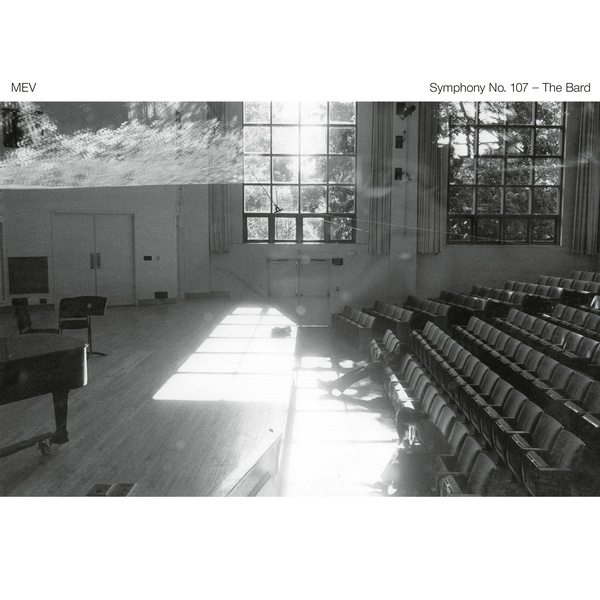
MEV
MEV – Symphony No. 107 – The Bard
Label: Black Truffle
Format: LP + Digital
Catalogue Number: BT104
Official web site: blacktruffle.bandcamp.com/album/symphony-no-107-the-bard
Description
Black Truffle is pleased to announce Symphony No. 107 –The Bard, a previously unheard archival recording of the legendary improvising ensemble MEV (Musica Elettronica Viva), captured in concert at Bard College, New York in 2012. Formed by a group of American expat composers in Rome in 1966, the MEV ensemble played an important role in the development of free improvisation, bridging the live electronics tradition begun by Cage and Tudor and the high-energy squall of free jazz. Early recordings like Spacecraft or The Sound Pool unleash volleys of metal and glass amplified with contact microphones, howling winds, primitive synthesizer bleep and raucous audience participation, the intensity of which puts much later ‘noise’ to shame. In later decades, the ensemble would go through many iterations, often including legendary free players like Steve Lacy and George Lewis. In its final years, MEV settled into the core trio of founding members heard here: Alvin Curran, Frederic Rzewski, and Richard Teitelbaum, using piano, electronics, and small instruments.
Curran, Rzewski, and Teitelbaum were life-long friends blessed, as Curran says, with ‘incompatible personalities’: major figures in the post-Cagean experimental tradition, they explored countless divergent and even contradictory paths as composers and performers, from agitprop songs to brainwave-controlled synthesis. MEV is the sound of these three personalities coming together, their contributions radically individual yet attaining a state of ‘fundamental unity’ that Rzewski, in a text written in the collective’s earliest years, defined as the ‘final goal of improvisation’. Of course, listeners familiar with aspect of the trio’s individual works might hazard some guesses about who is doing what: the crisp piano figures are probably Rzewski’s, the cut-up hip-hop samples most likely Curran’s, the sliding, squelching synth possibly Teitelbaum’s. But often these identities are dissolved in a constantly shifting hall of mirrors, the listener unable to tell which of these pianos is live and which is a sample of a past virtuoso, or whether a horn blast derives from ethnographic documentation or Curran cutting loose on Shofar.
The two side-long sets here occupy a similar terrain of constantly shifting texture and instrumentation, unexpected interruptions, and moments of sudden beauty. The first set is sparser, at times almost ominous, as a bell repeatedly sounds across wheezing harmonica, seasick orchestral textures, and creaking wood, making room for episodes of yodelling and delicate prepared piano before exploding into a storm of buzzing synth and piano fragments. The second set is more frenetic, moving rapidly across centuries and continents: cars crash into post-serial piano pointillism, wailing voices collide with chopped and screwed hip-hop samples, Hollywood strings are buried under layers of electronic gurgles. The performance slows in its final moments, making way for a sampled voice repeating the phrase ‘protest and the good of the world’, reminding us that MEV’s idea of freedom was always more than musical.
Symphony No. 107 –The Bard is a beautifully recorded example of the endlessly multi-layered later MEV sound, accompanied by new liner notes by Alvin Curran (now the only surviving member of the group) and a selection of previously unseen photographs from across the many decades of the group’s activity. Arriving in an elegant sleeve bearing a beautiful photograph by Francis Zhou of the Olin Hall at Bard College where the concert was recorded, this is an essential document from a major group in the history of experimental music. As Rzewski wrote, this music is ‘like life, unpredictable, sometimes making sense, mostly not’.
Black Truffle is pleased to announce Symphony No. 107 –The Bard, a previously unheard archival recording of the legendary improvising ensemble MEV (Musica Elettronica Viva), captured in concert at Bard College, New York in 2012. Formed by a group of American expat composers in Rome in 1966, the MEV ensemble played an important role in ...
read more…
Tracklisting
- I
- II
Available from these fine distributors:
- USA – Forced Exposure www.forcedexposure.com
- Europe – Kompakt www.kompakt.fm/labels/black_truffle
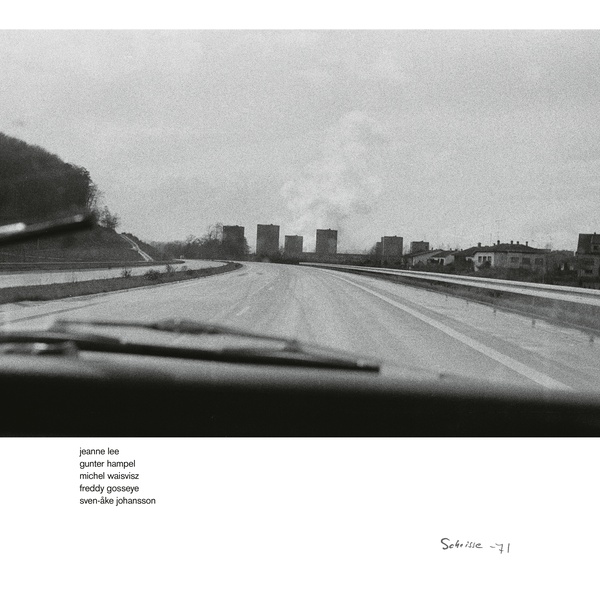
Jeanne Lee, Gunter Hampel, Michel Waisvisz, Freddy Gosseye, Sven-Åke Johansson
Scheiße ’71
Label: Black Truffle
Format: LP + Digital
Catalogue Number: BT103
Official web site: blacktruffle.bandcamp.com/album/schei-e-71
Description
Following on from the Bergisch-Brandenburgisches Quartett’s anarchic Live ’82 (BT095), Black Truffle continues its deep dive into the archives of legendary drummer/accordionist/photographer/composer/conceptual prankster Sven-Åke Johansson with Scheisse ’71. Recorded in November 1971 during the Berliner Jazztage at a heavy-hitting concert that also included the Spontaneous Music Ensemble and groups led by Peter Brötzmann, Manfred Schoof, and Masahiko Sato, Scheisse ’71 is the only document of a wild, otherwise unrecorded quintet featuring Johansson on drums, accordion and oboe d’amore, legendary free jazz vocalist Jeanne Lee, her husband Gunter Hampel on vibes, flute and bass clarinet, live electronics pioneer Michael Waisvisz on modified Putney (VCS 3) synthesizer, and the unknown Freddy Gosseye on electric bass. Part of a festival centred on giants of jazz like Duke Ellignton and Dizzy Gillespie, the radical performance shocked its audience, who can be heard heckling and yelling abuse at points, including the titular exclamation of ‘Scheiße!’
Clocking at just over half an hour and recorded in raw but detailed stereo by Johansson himself, the music burns with intensity while also making room for spacious passages and frequent dynamic movement. Beginning with Lee’s voice, Hampel on flute and Johansson on oboe d’amore in a bird-like game of call and response, the unexpected entry of Waisvisz’s tortured, squelching synth bursts prompts the first of many changes in energy and instrumentation, as Gosseye’s busy, roving bass enters and Johansson moves to the kit, his swinging cymbal work and juddering toms extending the approach of Sunny Murray or early Milford Graves.
The presence of synthesizer, electric bass, and Lee’s highly amplified voice moves the quintet away from conventional free jazz textures, at times pushing into zones of abstract free sound reminiscent of what groups like MEV, AMM or Johansson’s MND were exploring in the same years. But the energy and joyful melodicism of the music keep it rooted in the tradition of American fire music and its European inheritors. Capable of changing gears in an instant from ferocious blow outs to fragile tapestries of chiming vibes and fizzing synth, the music finds space for Lee’s post-bop free scat (which integrates shrieks and howls just as a post-Ayler saxophonist might), Gosseye’s virtuosic bass runs (a rare attempt to apply the classic free jazz style of players like Alan Silva or Henry Grimes to the electric instrument), Johansson’s folkish accordion interjections, and even a sustained passage of unison bass clarinet and electric bass riffing in its second half.
Special mention should be made of Waisvisz’s Putney performance, one of the earliest documents of this under-recorded instrument inventor and player, here playing a major role in giving the music its wildly exploratory, primordial air, his buzzing glissandi and bubbling filter sweeps at times howling like a distressed monkey. Arriving in an austerely stylish sleeve with beautiful black and white photographs by Johansson, Scheisse ’71 is an essential recording that adds yet another layer to our appreciation of this golden era of radical free music.
Following on from the Bergisch-Brandenburgisches Quartett’s anarchic Live ’82 (BT095), Black Truffle continues its deep dive into the archives of legendary drummer/accordionist/photographer/composer/conceptual prankster Sven-Åke Johansson with Scheisse ’71. Recorded in November 1971 during the Berliner Jazztage at a heavy-hitting concert that also included the Spontaneous Music Ensemble and groups led by Peter Brötzmann, Manfred Schoof, ...
read more…
Tracklisting
- I
- II
Available from these fine distributors:
- USA – Forced Exposure www.forcedexposure.com
- Europe – Kompakt www.kompakt.fm/labels/black_truffle
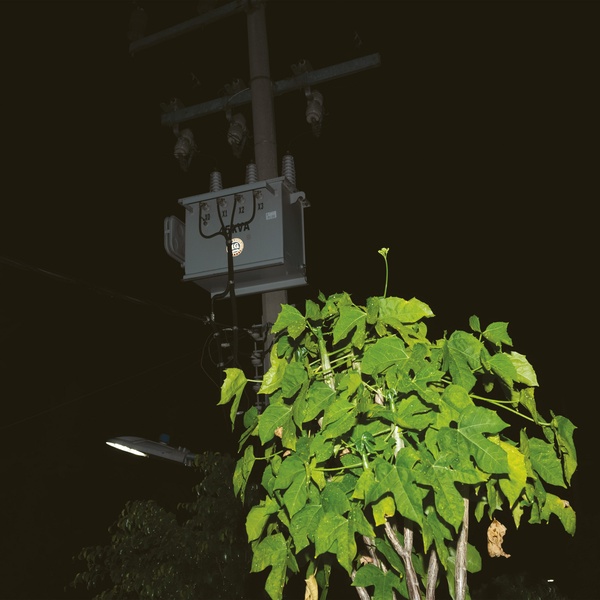
Giuseppe Ielasi
Down On Darkened Meetings
Label: Black Truffle
Format: LP + Digital
Catalogue Number: BT102
Official web site: blacktruffle.bandcamp.com/album/down-on-darkened-meetings
Description
Black Truffle is pleased to announce Down On Darkened Meetings, the first solo release on the label from the quietly prolific Giuseppe Ielasi. Recorded at Ielasi’s studio in Monza outside of Milan over two days in February 2022, the seven pieces presented here continue the renewed exploration of the guitar that marks much of his solo work over the last few years. Emerging in the late 1990s as an improviser working primarily with prepared acoustic and electric guitars, the instrument became less prominent in his work over the next decade, ceding to loop-based constructs that would eventually split into abstracted takes on club music and hip-hop (including his work as Inventing Masks), on the one hand, and spectral electroacoustic explorations (such as the stunning triple disc 3 pauses), on the other. Returning to the guitar in recent years, he has approached the instrument as a source of shimmering metallic glissandi (Five Wooden Frames) or as the vehicle of elegiac double-tracked lines that feel almost like Frisell playing Feldman (The Prospect). Here the focus is on electric guitar filtered, looped, and splayed out into fields of irregular echoes through a bank of pedals.
Like many of Ielasi’s releases, Down On Darkened Meetings is structured as a set of short untitled pieces (here ranging between two and six minutes in length) that single-mindedly explore a single instrument or source throughout. The opening track immediately introduced the distinctive timbral world of fizzing, heavily filtered tones, chiming harmonics, and woozy looping bass figures inhabited throughout. At points it becomes near impossible to trace these sounds to the strings of an electric guitar; at others, as on the final two pieces, the instrument is unmistakable, as Ielasi builds up his shifting loops from snatches of almost unintentional sounding half-playing that give these closing tracks a hushed, private atmosphere reminiscent of Tolerance’s Anonym. While the repeating chords and hanging melodic figures present on many tracks call to mind earlier Ielasi classics like Gesine and Untitled, here the music feels less meticulously constructed than played: Ielasi’s lyrical guitar lines obscured by a battery of effects at times come across like a dilated take on the outer-fringe fretwork of improvisers like Henry Kaiser and Raymond Boni, and the muddy, asynchronous fields of pops and hiss at times wander into areas reminiscent of the hand-played dub techno of Vladislav Delay’s Multila.
Like much of Ielasi’s work in recent years, these seven pieces perform a delicate balancing act: between abstraction and immediacy, austerity and abundance. Imbued with Ielasi’s distinctive lightness of touch, considered approach to pacing, and subtly psychedelic approach to the stereo field, Down on Darkened Meetings is a major new work from a quiet master of contemporary experimental music.
Black Truffle is pleased to announce Down On Darkened Meetings, the first solo release on the label from the quietly prolific Giuseppe Ielasi. Recorded at Ielasi’s studio in Monza outside of Milan over two days in February 2022, the seven pieces presented here continue the renewed exploration of the guitar that marks much of his ...
read more…
Tracklisting
- 01
- 02
- 03
- 04
- 05
- 06
- 07
Available from these fine distributors:
- USA – Forced Exposure www.forcedexposure.com
- Europe – Kompakt www.kompakt.fm/labels/black_truffle

Richard Youngs
Modern Sorrow
Label: Black Truffle
Format: LP + Digital
Catalogue Number: BT101
Official web site: blacktruffle.bandcamp.com/album/modern-sorrow
Description
The endlessly prolific and unpredictable Richard Youngs returns to Black Truffle with Modern Sorrow. As any Youngs fan knows, one of the great pleasures of following his career comes from not being able to predict what the next entry in his inexhaustible string of releases will bring: Unaccompanied voice? Country songs? Shakuhachi? Guitar pieces played with his feet? Shredding fuzz bass over the top of hyper-speed distorted drum machine beats? Continuing in the grand Youngs tradition of exploring new techniques, instrumentation and approaches while bringing to all of them his idiosyncratic touch, Modern Sorrow serves up two sides of twistedly elegiac, radically stark takes on contemporary pop production.
The side-long title track is built from a piano sample, synthetic bass notes and organ swells, and an iterative blurt that seems to have wandered out of a 90s jungle track. Eventually joined by a shuffling drum machine, the track moves very slowly through a series of chords, each delayed long enough that its arrival comes as a major event. Over the top, Youngs’ heavily pitch-corrected voice is heard. The processing paints his signature wandering melodic improvisations with shades of contemporary R&B; at the same time, it cuts the natural swoops and glides of Youngs’ melodies into rapid microtonal trills, giving his voice a quavering, middle eastern feel. Unfolding languorously over more than 17 minutes, the piece’s final minutes make room for an extended drumless coda, returning to the stark palette of its opening moments.
On the second side, the two parts of ‘Benevolence’ push this minimalism ever further, its first half consisting of nothing more than a remarkably slow drum machine hit, bass-heavy chords and pitch-corrected voice, here so heavily processed that it starts to resemble a shawn solo. In its second part, the harmonic foundation drops out from under the piece while two more voices join; at some moments the voices pause, leaving nothing more than isolated, metronomic drum hits. Though Youngs has explored the sound worlds associated with dance music and contemporary pop in previous work, here these elements are radically reduced, foregrounding a meditative bed of silence with a boldness equal to any more academically inclined contemporary composer. Embracing the accessible digital tools of contemporary music production just as at another moment he would pick up a kazoo, like much of Youngs’ work Modern Sorrow uses simple DIY tools to generous ends, producing formally radical music that remains both free from pretension and deeply moving.
The endlessly prolific and unpredictable Richard Youngs returns to Black Truffle with Modern Sorrow. As any Youngs fan knows, one of the great pleasures of following his career comes from not being able to predict what the next entry in his inexhaustible string of releases will bring: Unaccompanied voice? Country songs? Shakuhachi? Guitar pieces played with ...
read more…
Tracklisting
- Modern Sorrow
- Benevolence I + II
Available from these fine distributors:
- USA – Forced Exposure www.forcedexposure.com
- Europe – Kompakt www.kompakt.fm/labels/black_truffle
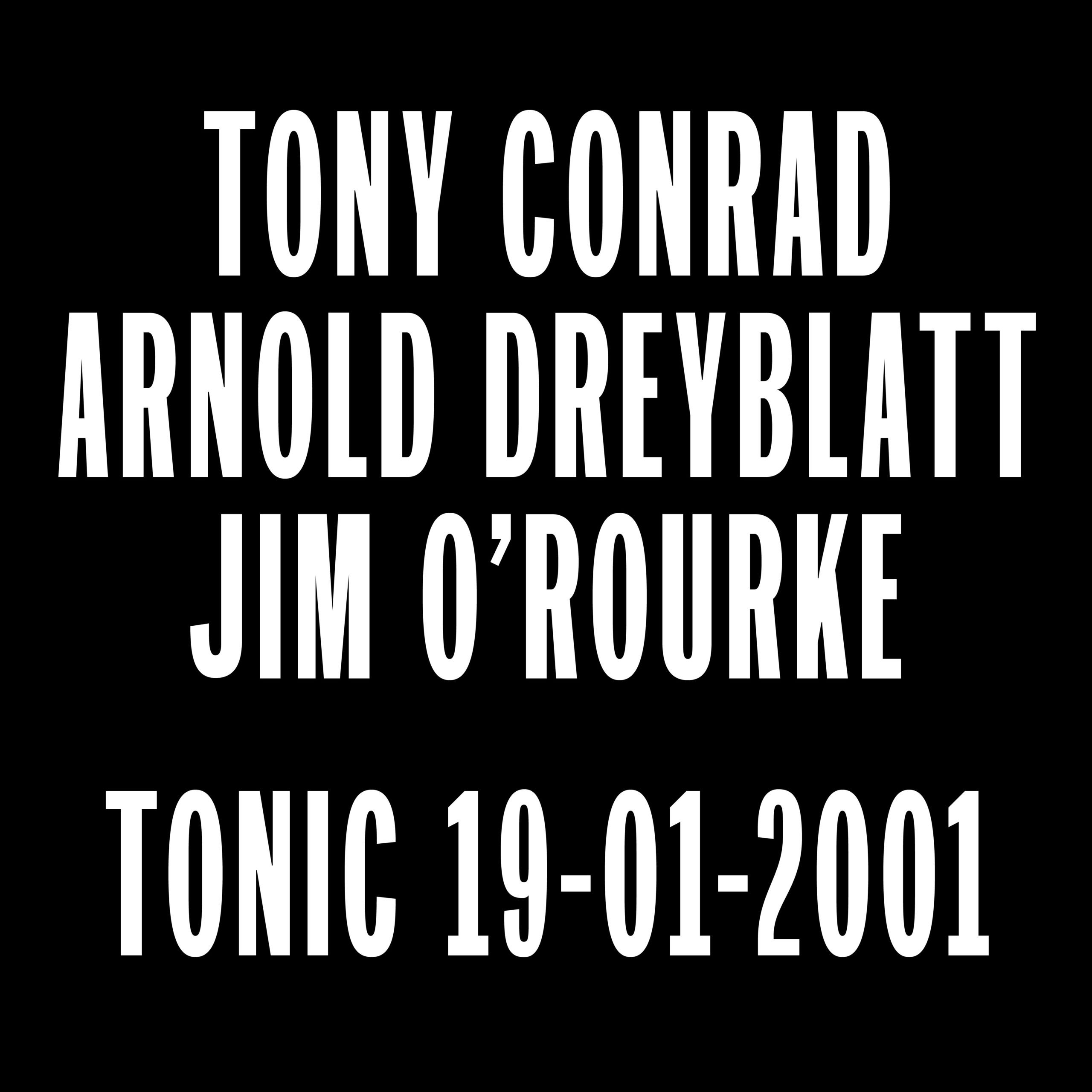
Tony Conrad / Arnold Dreyblatt / Jim O'Rourke
Tonic 19-01-2001
Label: Black Truffle
Format: LP + Digital
Catalogue Number: BT100
Official web site: blacktruffle.bandcamp.com/album/tonic-19-01-2001
Description
Celebrating its one hundredth release, Black Truffle is honoured to present a major archival discovery: a stunning document of the only performance by the trio of Tony Conrad, Arnold Dreyblatt and Jim O’Rourke. Across a two-night programme organised by David Weinstein at legendary New York experimental venue Tonic in January 2001, Conrad, Dreyblatt and O’Rourke presented individual projects before performing a collaborative set each night, the first with members of Dreyblatt’s ensemble and the second the trio heard here. As Dreyblatt points out in the wonderfully informative and reflective liner notes written for this release, this was a collaboration across generations, reflecting the profound impact of Conrad’s pioneering minimalism on Dreyblatt and O’Rourke. Both Dreyblatt and O’Rourke came to this collaboration armed with a deep appreciation of Conrad’s music and the just intonation principles at its core, Dreyblatt having first encountered the incredible power of Conrad’s precisely tuned violin chords during his tenure as an archivist for La Monte Young in 1975, while O’Rourke had performed with Conrad in various settings since the mid-1990s (as well as admiring, reissuing, and performing Dreyblatt’s music).
The flyer for the concert promised ‘massive, ecstatic, pulsating overtones’, and the trio certainly delivered. From the moment this keening stream of bowed strings begins, it is clear, as Dreyblatt writes, that we are in ‘Tony’s sonic universe’, as massively amplified, slowly shifting combinations of precisely chosen pitches fill the room with complex beating patterns and ghostly difference tones. For more than twenty-five minutes, the music operates at a level of intensity comparable to classic recordings such as Conrad’s Four Violins, until the texture thins out slightly in the performance’s final quarter, allowing for the listener’s first recognition of the individual voices that make up this enormous, overwhelming harmonic edifice. The constant stream of bowed tones is broken by a beautifully rich pizzicato from Conrad on monochord, the sliding low tones and metallic shimmer of the other strings taking the set’s final moments on an unexpected detour into spacious pastoral psychedelia.
Though produced by three individuals known for their own distinctive bodies of the work, this is egoless music, the perfect expression of Conrad’s desire ‘to move away from composing to listening’, to ‘working “on” the sound from “inside” the sound’. Historically important and overwhelming in sonic impact, this release also serves as a moving tribute to Tony Conrad from two musicians profoundly marked by the example set by his art and life.
Celebrating its one hundredth release, Black Truffle is honoured to present a major archival discovery: a stunning document of the only performance by the trio of Tony Conrad, Arnold Dreyblatt and Jim O’Rourke. Across a two-night programme organised by David Weinstein at legendary New York experimental venue Tonic in January 2001, Conrad, Dreyblatt and O’Rourke ...
read more…
Tracklisting
- I
- II
Available from these fine distributors:
- USA – Forced Exposure www.forcedexposure.com
- Europe – Kompakt www.kompakt.fm/labels/black_truffle
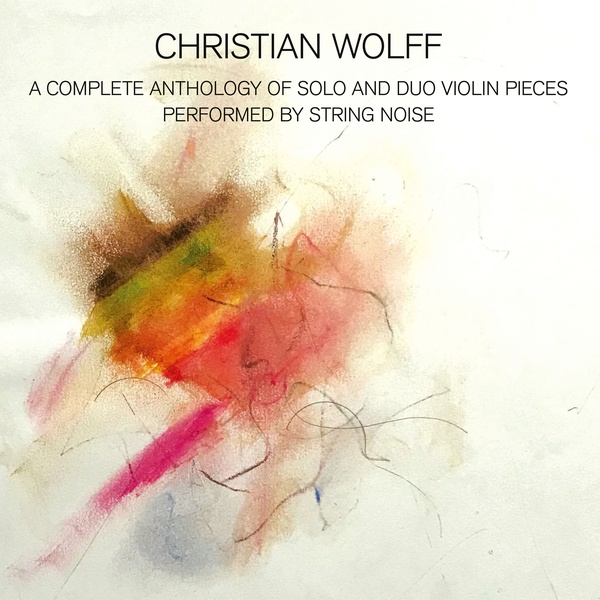
Christian Wolff
A Complete Anthology Of Solo and Duo Violin Pieces
Label: Black Truffle
Format: CD + Digital
Catalogue Number: BT099
Official web site: blacktruffle.bandcamp.com/album/a-complete-anthology-of-solo-and-duo-violin-pieces
Description
Black Truffle is pleased to announce its second release from New York violin duo String Noise (Conrad Harris and Pauline Kim Harris), following on from their self-titled double-disc collection of compositions by Alvin Lucier (BT061). Here they present A Complete Anthology of Solo and Duo Violin Pieces by legendary American experimental composer Christian Wolff, (previously published by Astres d’Or in a limited art edition of 25). The youngest and in some ways most radical of the composers of the New York School (alongside Brown, Cage, and Feldman), Wolff has ceaselessly rethought his approach throughout the seven decades of his composing career, moving from early experiments in radical reduction through indeterminacy, improvisation, and leftist political engagement to reach the limpid lyrical fragments of his most recent music.
Beautifully recorded across two days by Ryan Streber with Wolff in attendance, String Duo’s complete anthology of Wolff’s work for violin solo and duo covers the entirety of the composer’s career, from his earliest published work to a major new work written for this recording (presented in a tasteful non-chronological sequence). Written by the teenaged Wolff in 1950 during his brief period studying with Cage, Duo for Violins is a beautifully austere experiment in extreme reduction, using only three chromatically adjacent pitches without octave transpositions. Exploring the possible permutations of the limited material passing slowly between the two violins, the work prefigures the incessant worrying at small intervals of late Feldman works such as For Philip Guston or—fittingly—For Christian Wolff. This recording also presents premiere recordings of two other short duo pieces from the same year, recently rediscovered by Wolff in his papers, which use similarly reduced materials in a livelier, more dynamic manner.
Moving forward to the 1970s, the solo pieces Bread and Roses and The Death of Mother Jones belong to the period in which Wolff was drawing on political music, in this case two early 20th century songs that celebrate women labour activists. In both, arrangements of the traditional melodies are followed by a series of technically demanding free variations in a modernist style. The lyricism of these pieces is carried into the more fragmented, elusive works of the 90s onward. In the beautiful Six Melodies Variation (1993), written in tribute to Cage, fragments of Cage’s Six Melodies dissolve into anthemic snatches of the music of 18th century American composer William Billings (whose music Cage used in Apartment House 1776 and other works). The sixteen Small Duos for Violinists (2021) explore the radically disjunctive style of recent major Wolff works such as Long Piano (Peace March 11), where short ‘patches’ varying in style, density, and notation system are places next to each other without clear concern for conventional compositional principles. Here the individual duos range in length from a few seconds to just under two minutes, in energy from near stillness to churning rhythm, and in harmonic content from crystalline consonance to thorny dissonance. Including pieces inspired by the work of Rameau and Satie, like much of Wolff’s later music, the Small Duos manage to be at once lyrically immediate and subtly challenging: as Philip Thomas has written, ‘Our ears are not used to such a sustained rate of change’.
Published in a stylish digipak including extensive liner notes and wonderful reproductions of a series of Wolff’s delicate abstract works in pencil, crayon, and water colour, A Complete Anthology of Solo and Duo Violin Pieces is both an important addition to the documentation of Wolff’s oeuvre and an accessible survey of the many facets of his innovative music.
Black Truffle is pleased to announce its second release from New York violin duo String Noise (Conrad Harris and Pauline Kim Harris), following on from their self-titled double-disc collection of compositions by Alvin Lucier (BT061). Here they present A Complete Anthology of Solo and Duo Violin Pieces by legendary American experimental composer Christian Wolff, (previously ...
read more…
Tracklisting
- Bread And Roses
- Six Melodies
- Death Of Mother Jones
- Duo For Violins
- Short Suite
- Four Small Duos
- For Petr
- Small Duos For Violinists 1
- Small Duos For Violinists 2
- Small Duos For Violinists 3
- Small Duos For Violinists 4
- Small Duos For Violinists 5
- Small Duos For Violinists 6
- Small Duos For Violinists 7
- Small Duos For Violinists 8
- Small Duos For Violinists 9
- Small Duos For Violinists 10
- Small Duos For Violinists 11
- Small Duos For Violinists 12
- Small Duos For Violinists 13
- Small Duos For Violinists 14
- Small Duos For Violinists 15
- Small Duos For Violinists 16
Available from these fine distributors:
- USA – Forced Exposure www.forcedexposure.com
- Europe – Kompakt www.kompakt.fm/labels/black_truffle
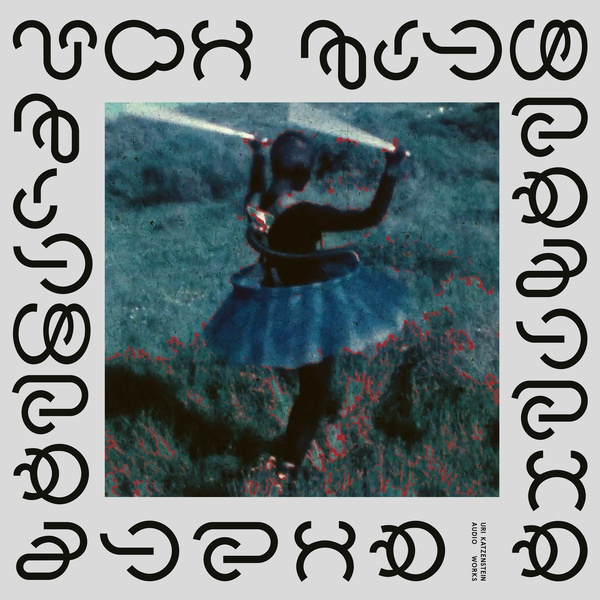
Uri Katzenstein
Audio Works
Label: Black Truffle
Format: 2LP + Digital
Catalogue Number: BT098
Official web site: blacktruffle.bandcamp.com/album/audio-works
Description
Black Truffle is pleased to announce Uri Katzenstein’s Audio Works, produced in collaboration with Holon’s Centre for Digital Art. Spanning sculptural installation, performance, video art, and many other media, Katzenstein’s absurdist, poetic, and often hilarious work made extensive use of sound and music. This, however, is the first release dedicated to the artist’s audio work, collecting 28 tracks produced between the early 1980s and 2017. Compiled from dozens of hours of recordings left uncatalogued (and in some instances unheard) at the artist’s death in 2018, these four sides are a treasure trove, offering a captivating glimpse into a uniquely uninhibited creative practice.
Predominantly recorded alone, with some contributions from regular collaborators such as Ohad Fishof on the later pieces, many of these tracks stem from Katzenstein’s time living in New York in the 1980s. Feeding on the cross-pollination of post-punk energy, radical art practice, and new media possibilities that characterised the New York scene at this time, many of Katzenstein’s recordings squeeze multilayered vocal experimentation into synth-based miniatures with a distinctively pop twist, their forms ruptured with anarchic bursts of free-form electronics, sounds from self-built instruments, and field-recorded snatches of the outside world.
Katzenstein’s electronic production calls up touchstones of skewed 80s art pop like Laurie Anderson, Ambitious Lovers, and Scritti Politti, but imbued with DIY directness and economy of means. The arrangements of synths, percussion, and noise elements are invigoratingly raw and, at times, almost austerely minimal. On ‘Intermission’, thick distorted chords accompany a wandering portamento melody, inhabiting the wayward carnival space of Roedelius’ most unhinged efforts. Many of the tracks centre on Katzenstein’s multi-tracked vocal performances, often moving between multiple languages, (most commonly English, German, French, and Hebrew). A bewildering range of vocal approaches are present on these pieces, from sweet wordless harmonies to hammed-up growls and monastic recitations. On ‘Skin O. Daayba – Complex Habits no. 3’, improvised resonance singing against a backdrop of echoing electronics and radio snatches. ‘Half Monk Half Herring’ layers multi-lingual syllabic fragments, crossing sound poetry techniques with melodic invention in a way rarely heard outside of Caetano Veloso’s Araçá Azul. On ‘Attempt to Raise Hell’, Katzenstein’s distorted voice spits out streams of alliterative nonsense (‘the hemlock of Henry, he was a hermit…purple pumpkin pulsates to pops’), while on the hilarious ‘Eric’, Katzenstein appears to instruct a small boy simultaneously in basic French and German conversation. On ‘Chicken’, vocal harmonies accompany the pecking and clucking of the titular fowl.
Moving from bent, outsider synth pop to snatches of Jo Jones-esque automated instrumental clang and absurdist linguistic experiments, these are far more than footnotes to an artist’s gallery works. Accompanied by extensive, beautifully written liner notes by Roee Rosen and the little information that exists on the individual tracks, Katzenstein’s Audio Works inhabits an outer fringe of DIY pop and sonic experiment reminiscent of Pascal Comelade or Die Welttraumforscher, where accessible forms convey radical interrogations of song, word, and sound.
Deluxe 2LP set presented in a gatefold sleeve with extensive liner notes and an insert with track info.
Black Truffle is pleased to announce Uri Katzenstein’s Audio Works, produced in collaboration with Holon’s Centre for Digital Art. Spanning sculptural installation, performance, video art, and many other media, Katzenstein’s absurdist, poetic, and often hilarious work made extensive use of sound and music. This, however, is the first release dedicated to the artist’s audio work, ...
read more…
Tracklisting
- Love Song
- Young Bastards
- Stop It
- Blind Man
- Skin O. Daayba - Complex Habits No.3
- We Are Waiting
- Mantra
- Skin O. Daayba - Feedbackless World
- Cupping Glass
- Half Monk Half Herring
- UKOIDM – Fishing (edit)
- Eric
- In The Garden
- Sequencer
- Who Are We
- Hit
- Yozti 2
- Voices Cricket
- Attempt To Raise Hell
- Anna's Assignment
- In Our Culture (Surname Version)
- Lesson 4 Voices
- Intermission
- Chicken
- Untitled
- Against Soap
- Bereshit
- Caretakers
Available from these fine distributors:
- USA – Forced Exposure www.forcedexposure.com
- Europe – Kompakt www.kompakt.fm/labels/black_truffle
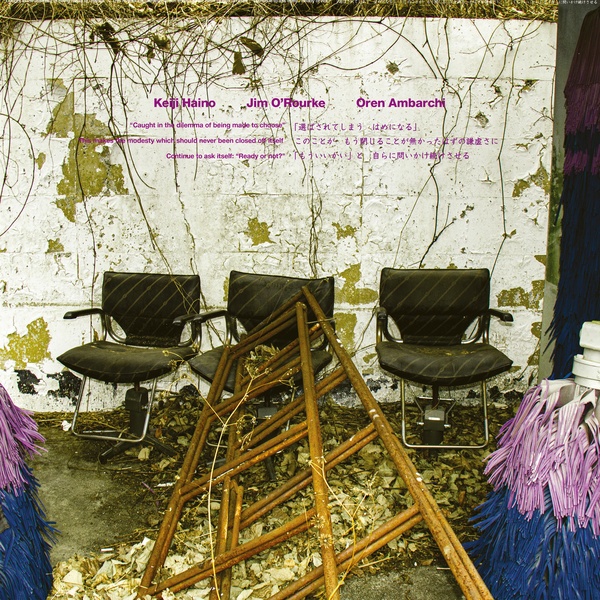
Keiji Haino / Jim O’Rourke / Oren Ambarchi
“Caught in the dilemma of being made to choose” This makes the modesty which should never been closed off itself Continue to ask itself: “Ready or not?”
Label: Black Truffle
Format: 2LP + Digital
Catalogue Number: BT097
Description
The renowned trio of Keiji Haino, Jim O’Rourke and Oren Ambarchi return to Black Truffle with their 11th release, “Caught in the dilemma of being made to choose” This makes the modesty which should never been closed off itself Continue to ask itself: “Ready or not?” Demonstrating once again their commitment to continual experimentation in instrumentation and approach, the record begins with a long-distance collaboration made in response to a commission from New York’s Issue Project Room in 2021 during widespread lockdowns and travel limitations. A unique piece in the trio’s extensive body of work, this side-long epic finds Haino performing on metal percussion, O’Rourke on electronics and Ambarchi on gongs and bells. Initially dominated by rapid patterns on resonant, high-pitched tuned percussion, the piece sets Haino’s dynamic and dramatic performance against a calm backdrop of cycling electronics, thrumming gong strikes and hanging bell tones. The performance develops a heightened, intensely concentrated atmosphere reminiscent of Haino’s classic Tenshi No Ginjinka or his Nijiumu project; when Haino moves to clashing hand cymbals in its second half, the piece’s ritualistic energy suggests aspects of the music of Tibetan Buddhism.
The remainder of the double LP documents the trio live at Tokyo’s SuperDeluxe (the location of all but their very first recording) in a wide-ranging set recorded in December 2017. The concert opens, in another first for the trio, with Haino on drums, O’Rourke on Hammond organ and Ambarchi on his signature Leslie cabinet guitar tones. Haino’s explosively untutored approach to the drumkit will be familiar to some listeners from the radical duo iteration of Fushitsusha heard on Origin’s Hesitation. Setting flurries of rapid activity against moments of silence, his drumming here at times suggests Milford Graves in its tumbling toms and thudding kick-drum propulsion. Accompanied by O’Rourke’s organ and Ambarchi’s guitar, which in their shared use of long tones and shifting modulation speeds almost blend into a single voice, the opening sections of this performance are some of the most magical music the trio has committed to tape thus far.
After an interlude of spoken vocals in both Japanese and English, Haino makes a dramatic entrance on guitar. Against O’Rourke and Ambarchi’s increasingly intense electronic backdrop, Haino unleashes a stunning passage of slowly moving chromatic melodies and sudden shrieking explosions bathed in distortion and reverb. By the time we reach the third side, the guitar/bass/drums power trio is established and lurches into a passage of massive, lumbering rock that threatens to fall apart at every beat, O’Rourke’s strummed chordal work on six string bass creating a harmonic density equivalent to a second guitar. An abrupt edit throws the listener in media res into a frantic locked groove grounded by fuzzed out bass patterns and caveman drums. As Haino moves through a variety of approaches, from massive edifices of stuttering fuzz to ominous swarms of feedback, the trio eventually stumble into a kind of Harmolodic military tattoo, Haino’s guitar weaving and slashing across the rhythm section’s irregular accents. Moving through an epic opening duet for O’Rourke on Hammond and Haino’s wailing guitar, the fourth side eventually ramps up into a frenetic finale of mad bass riffing, crackling snare hits and guitar squall.“Caught in the dilemma of being made to choose” This makes the modesty which should never been closed off itself Continue to ask itself: “Ready or not?” is a testament to the continuing power and invention of this trio, who continue to seek out new terrain after over a decade working together.
2LP set presented in a lavish gatefold sleeve on heavy stock along with inner sleeves containing live pics by Tsuyoshi Kamaike. Photography by Jim O’Rourke, design by Lasse Marhaug and translation by Alan Cummings.
The renowned trio of Keiji Haino, Jim O’Rourke and Oren Ambarchi return to Black Truffle with their 11th release, “Caught in the dilemma of being made to choose” This makes the modesty which should never been closed off itself Continue to ask itself: “Ready or not?” Demonstrating once again their commitment to continual experimentation in instrumentation and approach, ...
read more…
Tracklisting
- A contradiction has started to devour the numerical sequenceWe may be made aware that normal??? exists finally
- Thinking too deeply I skipped over _ three by three
- "Caught in the dilemma of being made to choose” This makes the modesty which should never been closed off itself Continue to ask itself: “Ready or not?” Part 1
- "Caught in the dilemma of being made to choose” This makes the modesty which should never been closed off itself Continue to ask itself: “Ready or not?” Part 2
- Overtightened the screw of the password to mystery drowns in an infinite number
Available from these fine distributors:
- USA – Forced Exposure www.forcedexposure.com
- Europe – Kompakt www.kompakt.fm/labels/black_truffle
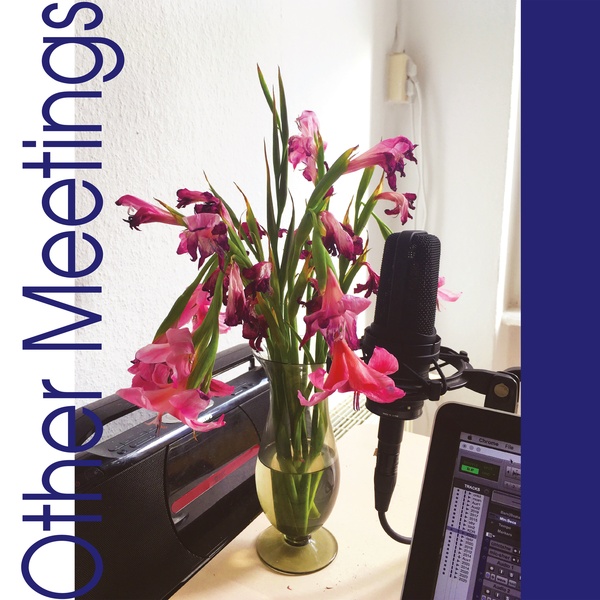
crys cole
Other Meetings
Label: Black Truffle
Format: LP + Digital
Catalogue Number: BT096
Official web site: cryscole.bandcamp.com/album/other-meetings
Description
Following on from last year’s acclaimed Sylva Sylvarum, the epic double LP from Ora Clementi (her collaborative project with James Rushford), crys cole returns to Black Truffle with Other Meetings. Originally commissioned and released on cassette by Boomkat Editions in 2021, Other Meetings is a major addition to the body of carefully hewn solo work cole has released over the last decade, offering up two side-long suites of her radically intimate approach to sound. After many years dominated by touring and travel, cole found herself in lockdown in her Berlin apartment, working in a limited space with minimal equipment. Digging through archives of recordings taken overseas and exploring the sonic potential hidden in the objects surrounding her (including a coffee pot and a vase of dying flowers), she crafted what in her liner notes she calls ‘an internal dérive, a journey that drifted through many places without a defining compass’.
Totalling over 50 minutes, the two pieces unfold at an unhurried pace, each containing four individually titled subsections. Beginning with a sequence of the highly amplified small sounds characteristic of much of cole’s work, the opening moments of ‘The time between two durations of sleep’ are underpinned by a gentle rocking motion, weaving together contact mic crunch, metallic resonance, glimpses of bird song, and isolated drum machine hits, the sonic space expanding and contracting as focus moves between elements. Briefly side-lined by a tactile but unplaceable sizzling, this complex weave of voices then returns in a kind of dubbed-out ‘version’, the percussive accents echoing around the stereo space. In one of the record’s most beautiful and unexpected moments, these sounds are joined by a sparse melodic line performed on a broken 1980s digital synth, the vaguely New Age timbres being taken on a long, tonally ambiguous wander.
Cole’s immersion in memories of travel comes to the fore in the final section of the first side, titled ‘Wat Paknam’ after a royal temple in Bangkok, where snatches of voices, ringing bells and distant waves of chanting blur together with synth tones into an increasingly abstracted wave of sound. The second side, ‘Slices of cake’, opens in a similarly hallucinatory outdoor space of echoing bird song and liquified traffic before abruptly zooming in on a microscopic world of subtly processed and highly amplified objects, explored with a starkness and quiet insistence that calls to mind the fringe not-quite-concrète of outsiders like Paul A.R. Timmermans or Knud Viktor, whose obsessive interrogation of dripping water might also serve as a point of reference for the following sub-section, the aptly titled ‘magischer Abfluss’ (magic drain).
While Other Meetings develops many aspects of cole’s previous work – the hyper-magnification of small gestures, the unsettling edits and fades partly inspired by hypnagogic states, the location recordings smeared into oneiric haze – it is almost as if these pieces are somehow songs, the remnants of an evaporated music of which nothing remains except isolated hits from a synthetic drum, a handful of notes, or simply a duration of emptied atmosphere. Radically reductive yet deeply musical, Other Meetings is a major work from an artist driven by an uncompromising and idiosyncratic vision.
Presented with an inner sleeve with photos and liner notes from the composer and remastered audio.
Following on from last year’s acclaimed Sylva Sylvarum, the epic double LP from Ora Clementi (her collaborative project with James Rushford), crys cole returns to Black Truffle with Other Meetings. Originally commissioned and released on cassette by Boomkat Editions in 2021, Other Meetings is a major addition to the body of carefully hewn solo work cole has released over ...
read more…
Tracklisting
- The time between two durations of sleep
- Slices of cake
Available from these fine distributors:
- USA – Forced Exposure www.forcedexposure.com
- Europe – Kompakt www.kompakt.fm/labels/black_truffle

Bergisch-Brandenburgisches Quartett
Live ’82
Label: Black Truffle
Format: LP + Digital
Catalogue Number: BT095
Official web site: blacktruffle.bandcamp.com/album/live-82
Description
Black Truffle is pleased to announce a major archival discovery from the wildest outer fringes of the FMP universe, the Bergisch-Brandenburgisches Quartett’s Live ’82. The Bergisch-Brandenburgisches Quartett (BBQ) was formed in 1980 in Rostock, East Germany, when three of the most radical and riotous members of the West German free music scene—reedist/accordionist Rüdiger Carl, percussionist Sven-Åke Johansson and Hans Reichel on violin and his modified ‘strange guitars’ — first played as a quartet with East German saxophonist Ernst-Ludwig Petrowsky. A rare example of a working band with members from both sides of the wall, during its lifetime the BBQ left only one recorded document, a studio LP on Amiga, the pop and jazz sublabel of the GDR state-run Deutsche Schallplatten Berlin. Neither pure fire music nor orthodox free improvisation, the four members of the BBQ shared an all-embracing aesthetic where quotes and jokes sat comfortably alongside radical extended techniques and sonic experiments.
Beautifully recorded at the 1982 Moers festival, the music presented here is a kaleidoscopic demonstration of what Johansson has called the BBQ’s ‘free postmodernism’. Beginning with a fractured landscape of clarinet flourishes from Petrowsky, Johansson’s spacious drums accents, banjo-esque plucks from Reichel’s handmade guitar and the groans and squawks of Carl on cuica, the music lurches between flowing melodicism and stunted locked grooves, settling after a few minutes into a lyrical clarinet and bass clarinet duet accompanied by shimmering guitar chords and some inexplicable percussive rotations. When Petrowksy starts to unfurl long, flowing flute lines accompanied by hand percussion, the music suddenly recalls Don Cherry’s global fusions, but this turn to the folkish quickly takes on a more European character when Carl and Johansson pick up accordions for the first of several comical but oddly moving duets. The more frantic second half of the set takes in a raucous digression into honking R&B, an Ayler-meets-Schlager romp with almost rockish chordal accompaniment from Reichel and an outrageous free jazz blowout with Carl on accordion, not to mention episodes of Johansson’s signature improvised Sprachgesang and antics with his expanded percussion set up, including items such as shoe stretchers and the Berlin yellow pages, which more than once cause the audience to burst into laughter.
Arriving in a beautifully designed sleeve with copious archival photographs and flyers from Johansson’s collection and extensive new liner notes from Francis Plagne, Live ’82 is a major historical document that remains both musically challenging and immensely entertaining forty years on.
Black Truffle is pleased to announce a major archival discovery from the wildest outer fringes of the FMP universe, the Bergisch-Brandenburgisches Quartett’s Live ’82. The Bergisch-Brandenburgisches Quartett (BBQ) was formed in 1980 in Rostock, East Germany, when three of the most radical and riotous members of the West German free music scene—reedist/accordionist Rüdiger Carl, percussionist ...
read more…
Tracklisting
- Part 1
- Part 2
Available from these fine distributors:
- USA – Forced Exposure www.forcedexposure.com
- Europe – Kompakt www.kompakt.fm/labels/black_truffle

Alvin Curran
Drumming Up Trouble
Label: Black Truffle
Format: LP + Digital
Catalogue Number: BT094
Official web site: blacktruffle.bandcamp.com/album/drumming-up-trouble
Description
Black Truffle is thrilled to announce Drumming Up Trouble, the first release of previously unissued music by Alvin Curran on the label. Collecting works recorded between 2018-2021 and a side-long epic dating back to the early 80s, as the title suggests, Drumming Up Trouble focuses on a hitherto almost unknown aspect of Curran’s encyclopaedic and omnivorous musical world: his experiments with sampled and synthesised percussion. As Curran’s wonderful, wildly sweeping liner notes make clear, his fascination with drumming belongs to the radical investigation of music’s fundamental elements that has marked his output since the beginnings of MEV, who aimed (as he says in a recent interview) to return ‘in some collective way to a non-existent start time in the history of human music’. Whatever kind of music our proto-human ancestors played, he writes, ‘drums were front and centre in the mix. Drums rule!’
In a paradox typical of Curran’s approach, Drumming Up Trouble interrogates this most ancient dimension of music with contemporary technology. On the first side, we hear recent pieces performed using the sampling software and full-size MIDI keyboard setup Curran has refined since the 1980s. Two of them are wild real-time improvisations, primarily utilising an enormous bank of hip-hop samples. Building from polyrhythmic layers of drum machine fragments to wild cacophonies of clashing vocal samples, scratching, and frantic pitch shifting, these energetic and at times hilarious pieces occupy a space somewhere between John Oswald’s Plunderphonics, Pat Thomas and Matt Wand in the Tony Oxley Quartet, and the propulsive Kudoro/Grime fusion of Lisbon’s Príncipe label. They are improvisations are accompanied by two austere, minimal compositions realised in collaboration with Angelo Maria Farro: ‘End Zone’ for orchestral bass drum and high oscillator, and ‘Rollings’, where a snare roll is gradually stretched and filtered by digital means into ‘floating electronic gossamer’.
The incredible breadth of Curran’s output makes it pretty unlikely that a listener familiar with his work would be surprised to find it branching out in a new direction. But no degree of familiarity with his work can really prepare for side B’s epic and bizarre ‘Field it More’. It’s perhaps best to let the maestro describe this unhinged and infectious offering in his own words: ‘It features an 8 bar funky minimal riff à la James Brown, played on synth and an-out-of-tune piano, synced to a pre-paid patch on the Roland drum machine. Over this is laid a heavily processed track of the voices of dancer Yoshiko Chuma and movie-maker Jacob Burckhardt discussing an upcoming performance of theirs at the Venice film festival, capped by a track of my playing an increasingly out of control blues over the top of all of the above’. Only Pekka Airaksinen’s Buddhas of the Golden Light comes to mind as a reference point that might even vaguely compare to this wild home-brew of drum-machine funk, mad improvisation and squelching electronics, which eventually dissolved into a massive, layered cluster. Ancient and modern, synthetic and human, hysterical and rigorous, Drumming up Trouble is 100% Curran.
Black Truffle is thrilled to announce Drumming Up Trouble, the first release of previously unissued music by Alvin Curran on the label. Collecting works recorded between 2018-2021 and a side-long epic dating back to the early 80s, as the title suggests, Drumming Up Trouble focuses on a hitherto almost unknown aspect of Curran’s encyclopaedic and ...
read more…
Tracklisting
- Bay Area 1
- Rollings
- Bay Area 2
- End Zone
- Field It More
Available from these fine distributors:
- USA – Forced Exposure www.forcedexposure.com
- Europe – Kompakt www.kompakt.fm/labels/black_truffle
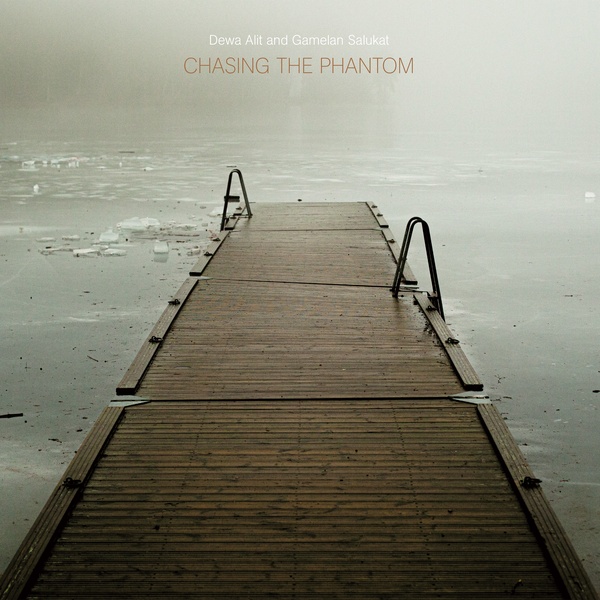
Dewa Alit & Gamelan Salukat
Chasing the Phantom
Label: Black Truffle
Format: LP + Digital
Catalogue Number: BT093
Official web site: blacktruffle.bandcamp.com/album/chasing-the-phantom
Description
Dewa Alit, Bali’s master of contemporary Gamelan composition, returns to Black Truffle with Chasing the Phantom, presenting two recent works played by the composer’s Gamelan Salukat, a large ensemble that performs on instruments specially built to his designs, using a unique tuning system that combines notes from two traditional Balinese Gamelan scales. Alit explains that the ensemble’s name suggests “a place to fuse creative ideas to generate new, innovative works” and both compositions demonstrate the composer’s ability to wring stunning new possibilities from variations on the traditional Gamelan ensemble. While using familiar elements of Balinese Gamelan music, such as unison scalar melodies and stop-start dynamics, Alit’s music is overflowing with harmonic, rhythmic, and timbral inventions, the latter often facilitated by unorthodox playing techniques.
“Ngejuk Memedi”, an English translation of which gives the LP its title, results from Alit’s reflection on the complex relationship between tradition and modernity in Balinese culture, particularly in the way that belief in the phantoms or spirits known as ‘memedi’ are shared through social media using digital technologies. Embodying this uncanny co-existence, the opening passages of the piece are at once immediately recognisable in their use of the metallophones of the Gamelan ensemble and strikingly reminiscent of electronics in their timbre and movement. At points, what we hear seems to have been fragmented with digital tools, or even to originate in some incessantly glitching DX7. Short melodic figures loop irregularly, with the ensemble splintering into polyrhythmic shards before unexpectedly recombining for intricate unison passages. After several minutes of this manically tinkling metallic sound world, the metallophones are joined by drums for a meditative passage of lower dynamics, as the uniformly high pitch range explored in the opening sections gradually opens up to include resonant low gong hits. Recovering some of the manic energy of the opening, but now enhanced with the full range of percussion, the piece weaves through a series of tempo changes to a stunning passage of rapid-fire melodies and ringing chords that sweep across the metallophones, their unorthodox tuning creating complex clouds of wavering harmonies.
“Likad”, written during Covid-19 lockdowns, channels anxiety and uncertainty into musical form, resulting in a piece that, even by Alit’s standards, is stunning in its complexity and the virtuosity it demands of Gamelan Salukat. Its opening section is perhaps most remarkable for its mastery of texture, with rapid transitions between dry, muted strikes and metallic shimmers calling to mind the use of filters in electronic music. At points, the complex irregular repetitions of short melodic patterns, where the music seems to get stuck or be suddenly interrupted by a skip, recall the mad sampler works of Alvin Curran or the skittering surface of prime period Oval more than anything familiar from acoustic percussion music. Moving through a dizzying series of twists and turns, the piece ends with a majestic sequence of chords possessing an almost hieratic power. A major statement from a radical contemporary composer, one cannot help but agree with Alit when he sees Chasing the Phantom as an answer to the “question of the future of Gamelan music”.
Dewa Alit, Bali’s master of contemporary Gamelan composition, returns to Black Truffle with Chasing the Phantom, presenting two recent works played by the composer’s Gamelan Salukat, a large ensemble that performs on instruments specially built to his designs, using a unique tuning system that combines notes from two traditional Balinese Gamelan scales. Alit explains that ...
read more…
Tracklisting
- Ngejuk Memedi
- Likad
Available from these fine distributors:
- USA – Forced Exposure www.forcedexposure.com
- Europe – Kompakt www.kompakt.fm/labels/black_truffle
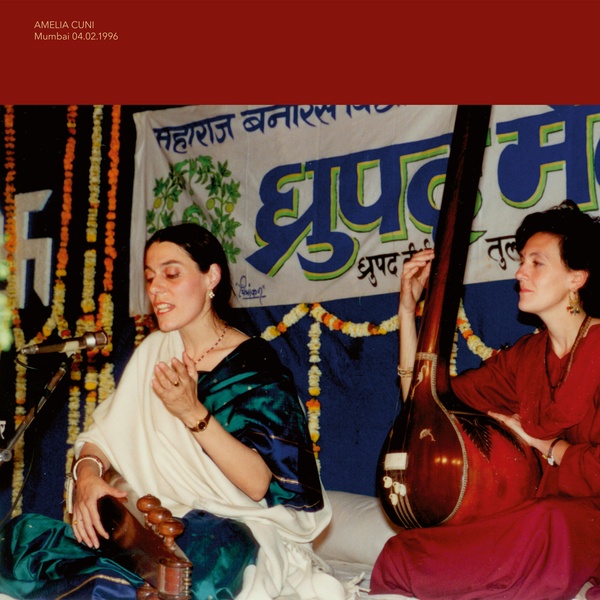
Amelia Cuni
Mumbai 04.02.1996
Label: Black Truffle
Format: 2LP + Digital
Catalogue Number: BT092
Official web site: cunidurand.bandcamp.com/album/mumbai-04021996
Description
Following on from the stunning recording of her 1992 performance at the Berlin Parampara Festival (BT079), Black Truffle is pleased to continue its documentation of the work of Berlin-based Italian singer Amelia Cuni, one of the great contemporary exponents of dhrupad, the oldest surviving style of North Indian classical vocal music. Beautifully recorded in concert at Vishweshwarayya Hall, Mumbai. 04.02.1996 presents expansive performances of three ragas stretching across four sides and almost one and a half hours of music. Beginning with the serene Raga Lalit, Cuni dwells for over twenty-five minutes on its opening alap movement, accompanied only by tanpura, her limpid yet full-bodied voice moving from graceful exposition in free tempo to increasingly rhythmically active variations, gradually spiralling upward in register. She is then joined by master pakwahaj player Manik Munde for the raga’s dhrupad and dhamar sections, the resonant tone of the drum and his constant invention with the complex 14-beat cycle serving as the perfect accompaniment for Cuni’s ecstatic melodic developments.
On the more solemn Raga Bhairav, Cuni’s alap, again stretching out over a whole side, is particularly notable for its powerful held notes and mastery of microtonal movement of pitch. After Munde returns for another rhythmically intricate dhamar movement, the record ends with the buoyancy of the Raga Alhaiya Bilaval, whose mode has, for the Western listener, an unmistakably ‘major’ quality. The rapturous applause that greets the performance is reflected in a remarkable selection of press clippings contemporary with the recording, which demonstrate Cuni’s success with Indian critics. Arriving in a gorgeous gatefold featuring stunning colour photographs of Cuni taken by legendary Australian fashion photographer Robyn Beeche (who resided in India from the early 90s), Mumbai. 04.02.1996 is a document of indescribable beauty and a moving testament to music’s ability to cross national and cultural borders.
Following on from the stunning recording of her 1992 performance at the Berlin Parampara Festival (BT079), Black Truffle is pleased to continue its documentation of the work of Berlin-based Italian singer Amelia Cuni, one of the great contemporary exponents of dhrupad, the oldest surviving style of North Indian classical vocal music. Beautifully recorded in concert ...
read more…
Tracklisting
- Raga Lalit - Alap
- Raga Lalit - Dhrupad
- Raga Lalit - Dhamar
- Raga Bhairav - Alap
- Raga Bhairav - Dhamar
- Raga Alhaiya Bilaval
Available from these fine distributors:
- USA – Forced Exposure www.forcedexposure.com
- Europe – Kompakt www.kompakt.fm/labels/black_truffle
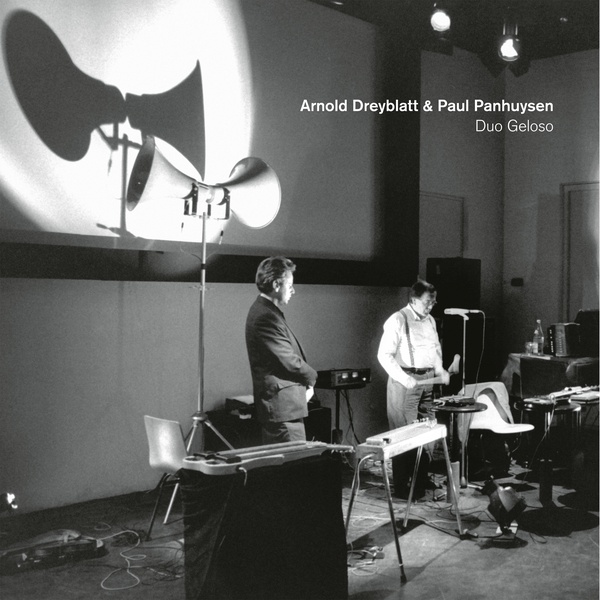
Arnold Dreyblatt & Paul Panhuysen
Duo Geloso
Label: Black Truffle
Format: LP + Digital
Catalogue Number: BT091
Official web site: blacktruffle.bandcamp.com/album/duo-geloso
Description
Black Truffle is thrilled to continue its program of archival releases from Arnold Dreyblatt with a recently unearthed concert recording from Dreyblatt and Paul Panhuysen’s “Duo Geloso”. While isolated examples of Dreyblatt’s collaboration with the legendary Dutch multi-media artist appeared on the CD reissue of Propellers in Love and Black Truffle’s wide-ranging archival Second Selection, this is the first release to document the variety and playfulness of the concerts that Duo Geloso performed throughout Europe in 1987-88. Both working across sonic and visual forms, fascinated by numerical relationship and the infinite complexity of string harmonics, Dreyblatt and Panhuysen had a natural affinity for each other’s work, strengthened through Dreyblatt’s many visits to Het Apollohuis, the important experimental art space Panhuysen helped to found in Eindhoven. However, as René van Peer suggests in the liner notes enclosed within this release, Dreyblatt and Panhuysen took very different approaches to these shared interests; the wonderful energy of these Duo Geloso performances results from the meeting of Dreyblatt’s more austere, compositional process with Panhuysen’s spontaneity.
Recorded at a concert at Het Apollohuis in December 1987 (a series of beautiful photographs of which adorn the LP’s packaging), each of the six pieces presented here is distinctive in terms of instrumentation and performance approach. Using electric guitar and bass tuned by Dreyblatt and played using E-Bow and Panhuysen’s motorised plectrums, the opening ‘Razorburg’ moves slowly through a long series of held notes with a madly insistent tremolo that crosses Dick Dale with a mechanised take on the layered guitars of Günter Schickert. The same pair of instruments returns on ‘Duo for Guitars’, where the mechanised attacks dissolve into a harmonic wash, reminiscent of the machine guitar work of fellow Het Apollohuis alumni Remko Scha. On ‘Love Call’, the guitars and bass are accompanied by Panhuysen’s distant warbled vocals, familiar to Maciunas Ensemble listeners. On the remarkable ‘Synsonic Batterie’, Panhuysen begins proceedings with a solo barrage of electronic percussion on the Synsonics Drum Machine (a simple drum synthesiser produced by the toy manufacturer Mattell), joined eventually by Dreyblatt performing his signature percussive natural harmonics on pedal steel guitar. When Panhuysen adds his bird whistle to the mix, the performance becomes the perfect exemplar of the Duo Geloso’s unique mix of studious close listening and subtle absurdity.
Presented in a gatefold sleeve with archival photos and illuminating liner notes from René van Peer.
Black Truffle is thrilled to continue its program of archival releases from Arnold Dreyblatt with a recently unearthed concert recording from Dreyblatt and Paul Panhuysen’s “Duo Geloso”. While isolated examples of Dreyblatt’s collaboration with the legendary Dutch multi-media artist appeared on the CD reissue of Propellers in Love and Black Truffle’s wide-ranging archival Second Selection, this is the first ...
read more…
Tracklisting
- Razorburg
- High Life
- The Louisiana Purchase
- Synsonic Batterie
- Duo for Guitars
- Love Call
Available from these fine distributors:
- USA – Forced Exposure www.forcedexposure.com
- Europe – Kompakt www.kompakt.fm/labels/black_truffle
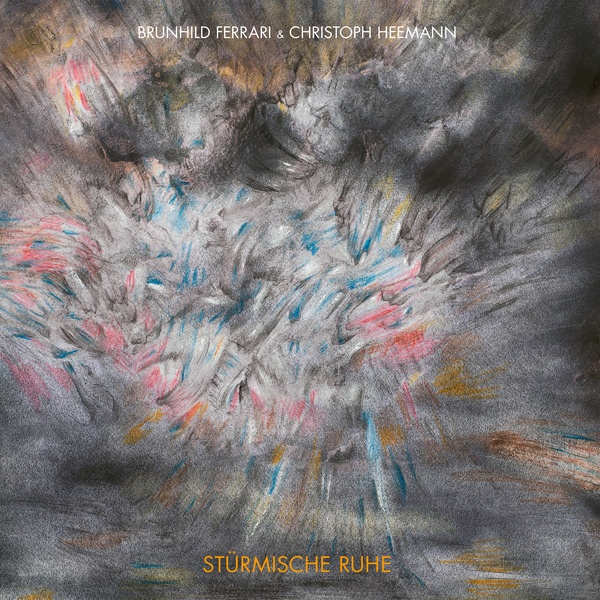
Brunhild Ferrari & Christoph Heemann
Stürmische Ruhe
Label: Black Truffle
Format: LP + Digital
Catalogue Number: BT090
Official web site: blacktruffle.bandcamp.com/album/st-rmische-ruhe
Description
After her stunning collaboration with Jim O’Rourke (Le Piano Englouti, BT055), Brunhild Ferrari returns to Black Truffle with Stürmische Ruhe, her first duo with Christoph Heemann. A legendary figure in underground music, Heemann has quietly produced a unique body of work since his beginnings with the absurdist cutups of H.N.A.S. in the mid-1980, including collaborations with Merzbow, Organum and Nurse With Wound, the eerie psychedelia of Mirror (with Andrew Chalk), In Camera (with Timo van Lujik) and Plastic Palace People (with Jim O’Rourke), and the precise cinema pour l’oreille constructions of his solo works. Created together in Ferrari’s Parisian studio (once shared with Luc) between 2011 and 2014, Stürmische Ruhe is a single half-hour piece that folds rain and storm recordings into a intricately woven fabric of haunted electronics, unexpected edits and disorienting processing.
Banging with the jarring thump of a slamming door (an element that will reappear periodically throughout the piece as a kind of punctuation mark), it is immediately obvious that concrete sound is used here in a free, poetic way outside of the strict confines of documentary field recording. The wind captured by Ferrari’s microphone roars and whistles, accompanied by thick clusters of wavering tones whose unpredictable rises and falls in volumes are synchronised with the bumping and thudding of windows and doors. At some points the microphone sound melts into a wavering low-bit digital smear before fanning out into broad, atmospheric depths. The cinema for the ear constructed here suggests not linear narrative or documentary, but an organic flow of cross-fades, double-exposures and abrupt cuts, a free-associative dream in which wind and water take on mythical characteristics.
Throughout the piece’s second half, layers of synthetic floating tones and pinging upward glissandi negotiate a constantly shifting balance with wind-borne whispers and rustles, at times dropping to silence, at others rising up with elemental force. As Ferrari explains in her liner notes, Stürmische Ruhe is a meeting of ‘completely opposite sound worlds’ in which ‘almost-violence’ is joined with a ‘reconciling harmony’. Reaffirming the infinite possibilities of the musique concrète tradition while avoiding its academic tropes, Stürmische Ruhe is accompanied by tri-lingual liner notes from Brunhild Ferrari and arrives in a sleeve graced with the beautiful art informel paintings of her father, Wolfgang Meyer Tomin. Cut at 45rpm for maximum fidelity.
After her stunning collaboration with Jim O’Rourke (Le Piano Englouti, BT055), Brunhild Ferrari returns to Black Truffle with Stürmische Ruhe, her first duo with Christoph Heemann. A legendary figure in underground music, Heemann has quietly produced a unique body of work since his beginnings with the absurdist cutups of H.N.A.S. in the mid-1980, including collaborations ...
read more…
Tracklisting
- Stürmische Ruhe Part 1
- Stürmische Ruhe Part 2
Available from these fine distributors:
- USA – Forced Exposure www.forcedexposure.com
- Europe – Kompakt www.kompakt.fm/labels/black_truffle
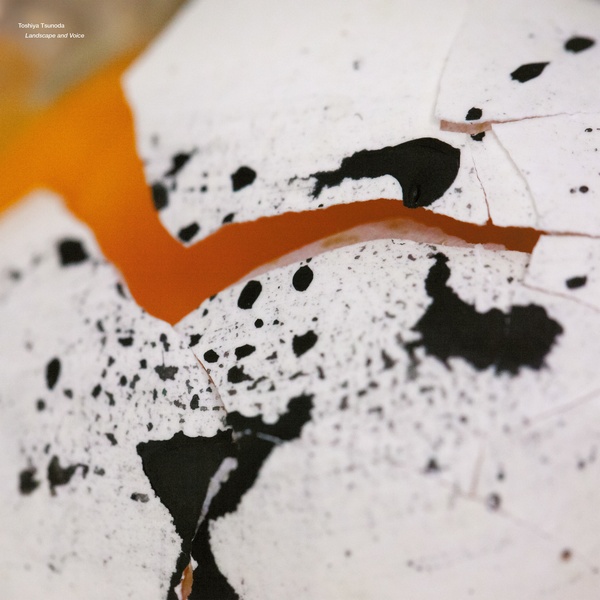
Toshiya Tsunoda
Landscape and Voice
Label: Black Truffle
Format: LP + Digital
Catalogue Number: BT089
Official web site: blacktruffle.bandcamp.com/album/landscape-and-voice
Description
Black Truffle is pleased to present Landscape and Voice, a radical new work (and rare vinyl release) from major Japanese sound artist Toshiya Tsunoda. Undoubtedly one of the most influential artists working with location recordings since the 1990s, Tsunoda’s work possesses a rigorously searching quality that sets him apart from his contemporaries. Tsunoda is known to many listeners for the subtle atmospheric poetry of his early Extract from Field Recording Archive series, which focussed on vibrations recorded in various indoor and outdoor environments in his native Miura Peninsula, often inside pipes, bottles and other vessels. In more recent years, his work has explored the implications of his claim that field recording should be seen as ‘depiction’ rather than ‘documentation’. He has explored disorienting editing and processing in his works with Taku Unami, and, perhaps most radically, represented Maguchi Bay as a kind of kinetic sculpture for shaking speakers by removing all but the inaudible low frequencies from a field recording (Low Frequency Observed at Maguchi Bay).
One of the recurrent concerns of Tsunoda’s recent work, as he explains in the crystalline liner notes accompanying this release, is ‘exploring how I can establish a subjective relationship with an environment, rather than seeing it merely as an object to be recorded’. This has taken various forms, from documenting simultaneously an outdoor environment and the blood flowing through the listener/recorder’s body (captured with a stethoscope) on The Temple Recordings, to representing his own experience of the landscape as made up of ‘grains of space and time’ by inserting looped fragments into field recordings in Grains of Spring.
On Landscape and Voice, this meeting between subject and object becomes an almost mystical union between the natural and the human. As with all of Tsunoda’s work, a relatively simple concept leads to compelling, thought-provoking results. Landscape and Voice combines vowel sounds spoken by six voices with short, looped fragments of field recordings, their noise character suggesting consonants: voice and landscape thus join together in something like words. The record consists of three pieces, each using a different, richly evocative field recording, which periodically freezes, catching on a looped fragment to which is synchronised an abruptly looped spoken vowel sound. The lengths between these interruptions vary, as do the tempi of the loops. The interruption of these lushly immersive recordings of the world – bristling with bird song, rushing water, distant traffic, and clinking metal – only serves to intensify them, as if the depicted environment itself had been returned to the listener each time it abruptly reappears. At the same time, the constant interruption creates an uncannily frozen effect, as if the recorded environment were an object rather than a stretch of recorded time. When combined with the bare human presence of the vowel sounds, the result is both austere and magical. Pressed on 45RPM for maximum fidelity, in a gorgeous sleeve designed by Lasse Marhaug with liner notes from the composer, Landscape and Voice is a radical proposition from one of the deepest thinkers in contemporary sound.
Black Truffle is pleased to present Landscape and Voice, a radical new work (and rare vinyl release) from major Japanese sound artist Toshiya Tsunoda. Undoubtedly one of the most influential artists working with location recordings since the 1990s, Tsunoda’s work possesses a rigorously searching quality that sets him apart from his contemporaries. Tsunoda is known to ...
read more…
Tracklisting
- At the port
- Studies
- In the grass field
Available from these fine distributors:
- USA – Forced Exposure www.forcedexposure.com
- Europe – Kompakt www.kompakt.fm/labels/black_truffle
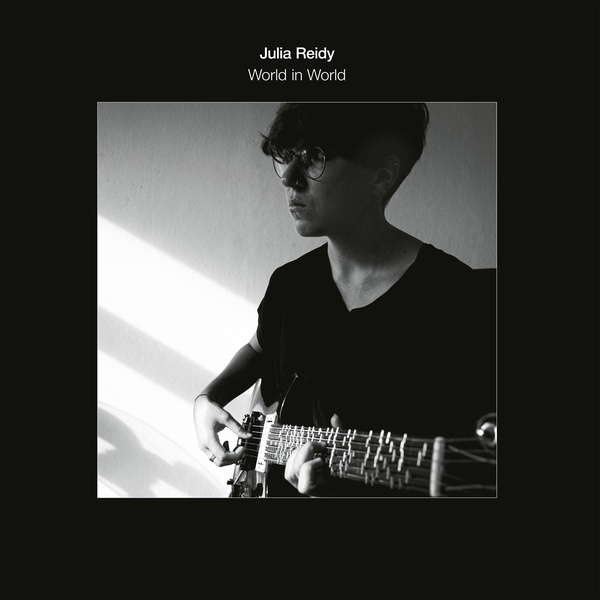
Julia Reidy
World in World
Label: Black Truffle
Format: LP + Digital
Catalogue Number: BT088
Official web site: blacktruffle.bandcamp.com/album/world-in-world
Description
Black Truffle is pleased to announce World in World, the latest solo offering from prolific Berlin-based guitarist-composer Julia Reidy. Where the recent trilogy of LP releases – brace, brace (Slip, 2019), In Real Life (Black Truffle, 2019), and Vanish (Editions Mego, 2020) – focussed on increasingly lush electronic settings for Reidy’s propulsive fingerpicking and auto-tuned vocals, arranged into wide-ranging side-long epics, World in World finds Reidy refocusing on the core elements of their approach while simultaneously pushing into challenging new areas. Comprising nine pieces ranging between two and seven minutes in length, the album’s opening title track promptly introduces the distinctive palette of just-intoned electric guitars, subtle electronic processing, and voice that is rigorously explored throughout.
Where much of Reidy’s guitar work on previous recordings explored rapidly pulsed cycling figures, here notes often hang in the air in a more spacious, lyrical fashion. The elasticity of rhythm and non-linear repetition of pitches initially suggests improvisation until the listener becomes aware of the precise arrangements of spatialised lines. At times, World in World suggests classic bedroom electric guitar works of the 1990s such as Loren Connors’ Airs or Roy Montgomery’s Scenes from the South Island; like those works, Reidy’s possesses a wonderfully live ambience, with frequent pedal clicks adding to the music’s powerful sense of intimacy. In Reidy’s case, however, the yearning, melancholic mood of Connors or Montgomery is tempered by the unorthodox guitar tuning, which at points produces a unique and uncomfortable effect somewhere between the hyper-precision of Harry Partch or Lou Harrison and Jandek’s slack-stringed descent into the void.
While World in World plots out its terrain with a bold single-mindedness that allows some pieces to appear almost as variations on a common theme, subtle changes in emphasis distinguish each track. Tactile percussive interjections skitter across the tremolo tones of ‘Paradise in Unrecognisable Colours’, while ‘Ajar’ ramps up the role played by the electronics, with glitching pitch-shifted and back-masked textures threaded through the guitars and thickly harmonised vocal layers. Ranging from autotuned melodic lines to buried murmurs, Reidy’s voice is a frequent presence throughout these nine pieces, at times creating the impression that a more conventional series of songs lurks underneath the chiming microtonal guitars. On the stunning ‘Poised’, whispers and distant, ghostly wails surround the layers of guitars, at times suggesting the foggiest outer reaches of Liz Harris’ Grouper. Both rigorously experimental and emotive, World in World is undoubtedly Julia Reidy’s finest work yet.
Black Truffle is pleased to announce World in World, the latest solo offering from prolific Berlin-based guitarist-composer Julia Reidy. Where the recent trilogy of LP releases – brace, brace (Slip, 2019), In Real Life (Black Truffle, 2019), and Vanish (Editions Mego, 2020) – focussed on increasingly lush electronic settings for Reidy’s propulsive fingerpicking and auto-tuned vocals, arranged into wide-ranging side-long epics, World in ...
read more…
Tracklisting
- World in World
- Poised
- Holding Onto
- Loom
- Ajar
- Walls and Clearings
- Slipstream
- Paradise in Unrecognisable Colours
- Hollowed
Available from these fine distributors:
- USA – Forced Exposure www.forcedexposure.com
- Europe – Kompakt www.kompakt.fm/labels/black_truffle
- UK – Boomkat www.boomkat.com
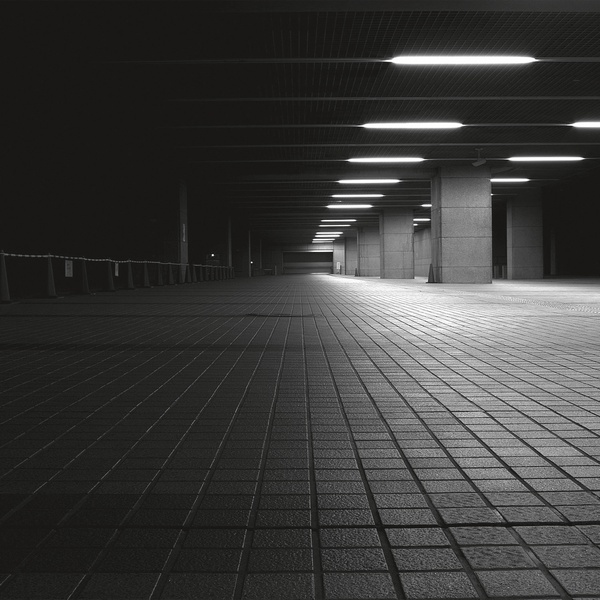
Oren Ambarchi
Sagittarian Domain
Label: Black Truffle
Format: LP, CD + Digital
Catalogue Number: BT087
Official web site: orenambarchi.bandcamp.com/album/sagittarian-domain-10-year-anniversary-edition
Description
10th anniversary reissue of this rhythmically churning one-man-band monster of an album, recorded in a single inspired studio session & originally released in 2012 on Editions Mego.
From the original Editions Mego press release:
“For anyone who still associates Oren Ambarchi exclusively with the clipped, bass-heavy tones of solo electric guitar works such as Suspension, this rhythmically churning one-man-band monster of an album-length piece might seem to come out of nowhere. However, listeners who have followed the breadth of his work for the last few years (solo and in projects with collaborators from Jim O’Rourke to Stephen O’Malley and Keith Rowe to Keiji Haino) will have noted how Ambarchi has allowed increasingly clear traces of his enthusiasms as a music listener (for classic rock, minimal techno and 70’s fusion, among other areas) to surface in his performances and recordings, all the time filtering them through his signature long-form structures and psychoacoustic sonics.
Recorded in a single inspired studio session, Sagittarian Domain displaces Ambarchi’s trademark guitar sound from the centre of the mix, its presence felt only as an occasional ghostly reverberated shimmer. Endlessly pulsating guitar and bass lines sit alongside electronic percussion and thundering motorik drumming (familiar from his work with Keiji Haino) at the core of the piece, locking into a voodoo groove like Faust covering a 70’s cop show theme. The work is founded on hypnotic almost-repetition, the accents of the drum hits and interlocking bass and guitar lines shifting almost imperceptibly back and forwards over the beat as they undergo gradual transformations of timbre. Cut-up and phase-shifted strings enter around the half-way mark like an abstracted memory of the eastern-tinged fusion of the Mahavishnu Orchestra’s classic Visions of the Emerald Beyond, before returning for an extended, stark yet affecting come-down coda, equal parts Gavin Bryars and Purple Rain.
While Sagittarian Domain contains traces of a diversity of influences, it mines all of them to uncover something that is clearly an extension of Ambarchi’s own investigations up to this point, exhibiting the same care for micro-detail and surrender to the physicality of sound that are present in all of his work, extending them in new ways to repetition, pulse and rhythm”.
10th anniversary reissue of this rhythmically churning one-man-band monster of an album, recorded in a single inspired studio session & originally released in 2012 on Editions Mego. From the original Editions Mego press release: “For anyone who still associates Oren Ambarchi exclusively with the clipped, bass-heavy tones of solo electric guitar works such as Suspension, ...
read more…
Tracklisting
- Sagittarian Domain
Available from these fine distributors:
- USA – Forced Exposure www.forcedexposure.com
- Europe – Kompakt www.kompakt.fm/labels/black_truffle

ENSEMBLE NIST-NAH
ELDERS
Label: Black Truffle
Format: LP, CD + Digital
Catalogue Number: BT086
Official web site: willguthrie.bandcamp.com/album/elders
Description
Elders is the debut release from Ensemble Nist-Nah, a nine-piece percussion group led by Nantes-based Australian drummer and percussionist Will Guthrie. The diverse group of French musicians that make up Ensemble Nist-Nah – whose collective experience encompasses traditional Gamelan performance, contemporary composition, noise, jazz, and everything in between – perform on drum kits, traditional and junk percussion, and a complete set of Javanese Gamelan instruments. Though building on the foundations of Guthrie’s solo work with Gamelan instruments (Nist-Nah, BT057) and primarily performing his compositions, Ensemble Nist-Nah is a collective endeavour, propelled by a breathtaking enthusiasm that has seen the ensemble manage to rehearse, perform, and even tour Europe during the Covid-19 pandemic.
From the first seconds of opening track ‘Geni / Tirta’, it becomes immediately obvious that this is no dry academic exercise or exotic indulgence. Rapid arpeggiated figures are propelled by manically busy kit drumming while slow-motion melodic lines float above. After a series of abrupt tempo changes and fragmented unison passages that crossbreed the rhythmic intensity of the Balinese Kecak with the joyride of an Ornette Coleman head, the music slows to a monumental groove, equal parts Javanese court music and Dark Magus. Another sequence of thrilling divagations leads us to the unexpected guest appearance of acclaimed vocalist Jessica Kenney, who elaborates a haunting Javanese Bedhaya across a spacious backdrop of massive gong hits, shimmering cymbals, rustling bells, and gritty textures.
The remaining pieces that make up Elders explore a dizzying variety of approaches, from the shifting rapid-fire muted textures of ‘Overtime’ to the ghostly bowed tones and ominous swells of the title piece (developed from a track on Guthrie’s solo Nist-Nah release), which gradually builds into waves of shuddering low resonance and asynchronous percussive clicks like a haunted clock mechanism. On the aptly titled ‘Rollin’, virtuosic twin drum kits criss-cross errant metallophone patterns in propulsive polyrhythms, while ‘Planeker’ manages to achieve a bizarrely effective fusion of Harry Partch and Autechre. Arriving bedecked in beautiful monochrome images of gongs drawn by ensemble member Charles Dubois, Elders is a feast for the ears: music that burrows deep into timbral and rhythmic possibility while possessing an intoxicating physicality and revelling in the joy of collective performance.
Elders is the debut release from Ensemble Nist-Nah, a nine-piece percussion group led by Nantes-based Australian drummer and percussionist Will Guthrie. The diverse group of French musicians that make up Ensemble Nist-Nah – whose collective experience encompasses traditional Gamelan performance, contemporary composition, noise, jazz, and everything in between – perform on drum kits, traditional and junk ...
read more…
Tracklisting
- GENI / TIRTA
- OVERTIME
- PLANEKER
- ELDERS
- ROLLIN
- SWAYER
Available from these fine distributors:
- USA – Forced Exposure www.forcedexposure.com
- Europe – Kompakt www.kompakt.fm/labels/black_truffle
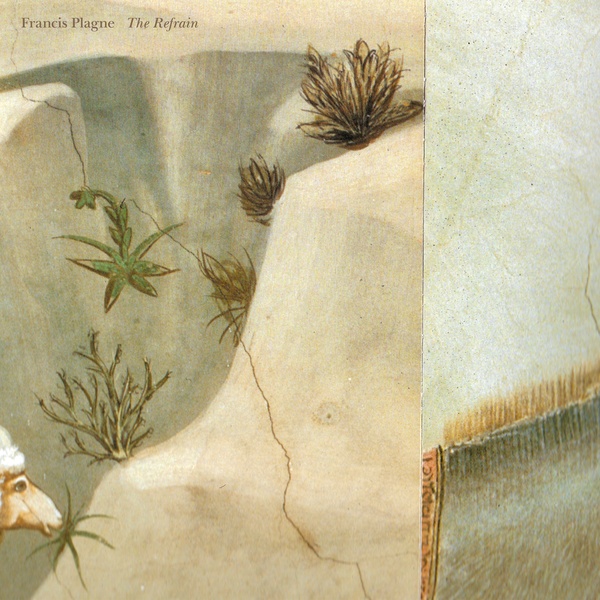
Francis Plagne
The Refrain
Label: Black Truffle
Format: LP + Digital
Catalogue Number: BT085
Official web site: francisplagne.bandcamp.com/album/the-refrain
Description
“Black Truffle proudly present The Refrain from Melbourne-based artist Francis Plagne, whose growing catalogue of collaborative and solo releases range from song-based work to abstract audio collages.
Closely aligned with Plagne’s Moss Trumpet LP (released by Penultimate Press in 2018), The Refrain’s two side-long tracks mix sounds of the mundane with the otherworldly; rising, receding and overlapping. The result feels like being led through a series of scenes devoid of context or direction. Furthermore, it’s hard to define the scenes as either inviting or disconcerting, as they’re often both at the same time. As the record progresses sounds reappear and are juxtaposed so as to only hint at the familiar. A hall of mirrors, perhaps?
Completed in 2020 using material recorded from 2012-2020, the record uses tapes of shelved, unfinished, and forgotten projects that featured field recordings from various locations, domestic sounds of plastic bottles, bubble wrap, creaking chairs, voice, and instrumental recordings, including an appearance from crys cole on Casio. These pieces were re-amped, processed and edited, then additional instrumental pieces featuring synths, guitars, plastic saxophone, melodica, and percussion were added, the results shaped into drifting, episodic assemblages.
Although essentially a tape piece, The Refrain presents as a crude, non-idiomatic composition that feels both timeless and transitory. It’s a million miles from the polish and rigour of GRM, perhaps more in line with Jacques Bekaert’s eponymous Igloo LP, or Costin Miereanu’s Luna Cinese. The Refrain could be read as a psychedelic Krapp’s Last Tape; one man’s response to listening through forgotten and discarded tapes, reflecting, reconciling, and forging a new path. A potent tonic for these absurd times.”
— Nick Hamilton, August 2021
“Black Truffle proudly present The Refrain from Melbourne-based artist Francis Plagne, whose growing catalogue of collaborative and solo releases range from song-based work to abstract audio collages. Closely aligned with Plagne’s Moss Trumpet LP (released by Penultimate Press in 2018), The Refrain’s two side-long tracks mix sounds of the mundane with the otherworldly; rising, receding ...
read more…
Tracklisting
- Part 1
- Part 2
Available from these fine distributors:
- USA – Forced Exposure www.forcedexposure.com
- Europe – Kompakt www.kompakt.fm/labels/black_truffle

Eiko Ishibashi
For McCoy
Label: Black Truffle
Format: LP + Digital
Catalogue Number: BT084
Official web site: blacktruffle.bandcamp.com/album/for-mccoy
Description
Black Truffle is pleased to announce For McCoy, a new work by Eiko Ishibashi dedicated to the widely loved character of Jack McCoy, portrayed by Sam Waterston in Law & Order. Following on from Hyakki Yagyō (BT064), For McCoy finds Ishibashi further exploring the unique space she has carved out in recent years, bringing together musique concrète techniques, ECM-inspired jazz, lush layers of synths and hints of pop into immersive and affecting structures crafted in her home studio, aided by a group of close collaborators.
Beginning with overlapping layers of descending flute lines, the expansive ‘I Can Feel Guilty About Anything’ (whose two parts stretch out over more than thirty minutes) unfolds with a free-associative logic, embracing dreamlike transitions and unexpected cinematic cuts. As a hovering cloud of synthetic tones and multi-tracked voices fans out from the spare opening moments, Joe Talia’s skittering cymbals settle into a gently propulsive groove, soon joined by melodic fragments performed by Daisuke Fujiwara on multi-tracked saxophone. As the drums cede to field recordings and ominous synth figures, the uncommon meeting of saxophone and electroacoustic techniques call to mind the more spacious moments of Michel Redolfi and André Jaume’s Synclavier-propelled oddity Hardscore or the early work of Gilbert Artman’s Urban Sax. As the piece continues on the LP’s second side, distant dialogue rumbles beneath a surface of processed flutes, blurring into a cavernously reverberant backdrop for stark ascending lines performed by MIO.O on violin. Eventually, the piece settles into a gorgeous passage of abstracted dream pop, where Ishibashi’s multitracked vocal harmonies glide atop synth chords, errant pings and snatches of outdoor sound.
Fragments of melodic material reappear throughout the spacious opening piece, finally stepping to the forefront on the closing track, ‘Ask Me How I Sleep at Night’. Here, over a shuffling groove supplied by Jim O’Rourke on double bass and Tatsuhisa Yamamoto on drums, layers of flutes, saxophones and guitars sound out melodies whose combination of twisting irregularity and soulful immediacy calls up prime Keith Jarrett, while their closely voiced harmonies suggest Kenny Wheeler or even Wayne Shorter’s Atlantis. In a classical gesture of closure, the web of melodic lines eventually leads back to the descending flute figures with which the record began. Presented in an immersive, impeccably detailed mix by Jim O’Rourke and arriving in a sleeve featuring Ishibashi’s beautiful drawings of Jack McCoy, For McCoy is an essential release for anyone following the enchanted and unique path being forged by Eiko Ishibashi.
Black Truffle is pleased to announce For McCoy, a new work by Eiko Ishibashi dedicated to the widely loved character of Jack McCoy, portrayed by Sam Waterston in Law & Order. Following on from Hyakki Yagyō (BT064), For McCoy finds Ishibashi further exploring the unique space she has carved out in recent years, bringing together musique concrète techniques, ECM-inspired jazz, ...
read more…
Tracklisting
- I can feel guilty about anything (Part 1)
- I can feel guilty about anything (Part 2)
- Ask me how I sleep at night
Available from these fine distributors:
- USA – Forced Exposure www.forcedexposure.com
- Europe – Kompakt www.kompakt.fm/labels/black_truffle
- UK – Boomkat www.boomkat.com
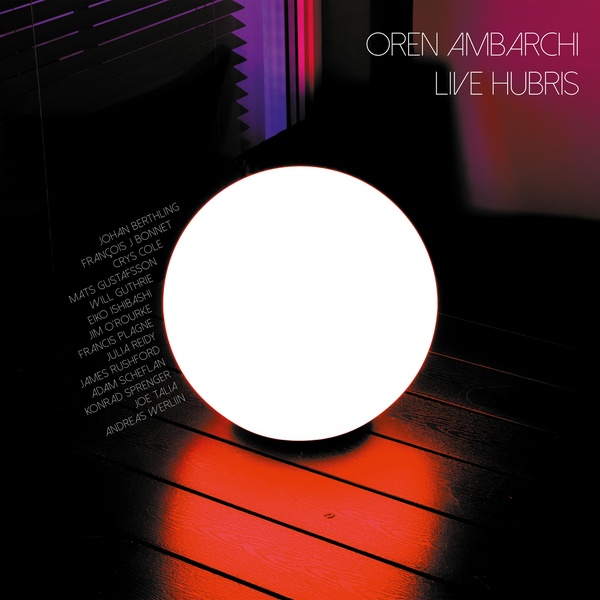
Oren Ambarchi
Live Hubris
Label: Black Truffle
Format: LP + Digital
Catalogue Number: BT083
Official web site: orenambarchi.bandcamp.com/album/live-hubris
Description
Black Truffle is pleased to announce Live Hubris, documenting the hypnotic and electrifying live performance of Oren Ambarchi’s 2016 LP Hubris by a fifteen-strong band at London’s Café Oto. Over three days in May 2019, Oto toasted Oren Ambarchi at 50/Black Truffle at 10 with Ambarchi and a large group of close friends and collaborators in a series of performances that interspersed existing projects with new collective endeavours, culminating with this: fourteen members of the extended Black Truffle family together on stage, joined by one special virtual guest, to translate the intricately studio-constructed layers of Hubris into a muscular live band workout.
Operating with only the bare minimum of pre-gig preparation after the planned afternoon rehearsal had to be wrapped up prematurely due to noise complaints, the gargantuan group lurches into motion with a 21-minute rendition of ‘Hubris Part 1’, powered by the pulsating electronics of Konrad Sprenger (the ‘ringmaster’ at the ensemble’s core) and no less than seven electric guitars spinning a web of intricately interlocking palm-muted polyrhythms. The layers of closely related but metrically distinct lines create ripples of shifting accents, flickering changes in emphasis that ricochet along the endless central pulse. Gradually building in density, this motorik continuum becomes the backdrop for the haunting tones of Eiko Ishibashi’s processed flute and an extended feature from long-distance guest Jim O’Rourke on guitar synth.
After the brief interlude of the second part, where Albert Marcoeur-esque guitar arpeggios accompany a halting attempt at phone conversation, the full ensemble gears up for the epic side-long rendition of ‘Hubris Part 3’. Now joined by the astonishing triple drum line-up of Joe Talia, Will Guthrie and Andreas Werliin, the layered pulse of the opening piece becomes a burning funk-fusion groove. Beginning on a medium simmer, the ensemble initially stick to its pulsating one-note mantra, over which Ambarchi unfurls a beautiful example of his signature shimmering Leslie-toned guitar harmonics, eventually joined by Ishibashi’s flute and some brooding, distorted dissonance from Julia Reidy’s guitar. Building steadily for the first nine minutes, the heat then rises dramatically with a first, gloriously loose chord change: with the all drummers now rolling and tumbling like a twice-cloned Jack DeJohnette circa 1970, Mats Gustafsson enters on baritone, his tortured roars and shrieks driving the band to peaks of insane intensity. Finally, the exhausted ensemble drops out, leaving only the jagged, skittering fuzz of Ambarchi’s guitar, brought to an abrupt conclusion at the command of crys cole.
Arriving on hot pink vinyl with artwork by Lasse Marhaug and an extensive selection of live photos by Ivan Weiss and Fabio Lugaro, Live Hubris brings this ambitious and outrageous evening of music to the safety of the home stereo.
Black Truffle is pleased to announce Live Hubris, documenting the hypnotic and electrifying live performance of Oren Ambarchi’s 2016 LP Hubris by a fifteen-strong band at London’s Café Oto. Over three days in May 2019, Oto toasted Oren Ambarchi at 50/Black Truffle at 10 with Ambarchi and a large group of close friends and collaborators in a series of performances ...
read more…
Tracklisting
- Live Hubris Part 1
- Live Hubris Part 2
- Live Hubris Part 3
Available from these fine distributors:
- USA – Forced Exposure www.forcedexposure.com
- Europe – Kompakt www.kompakt.fm/labels/black_truffle
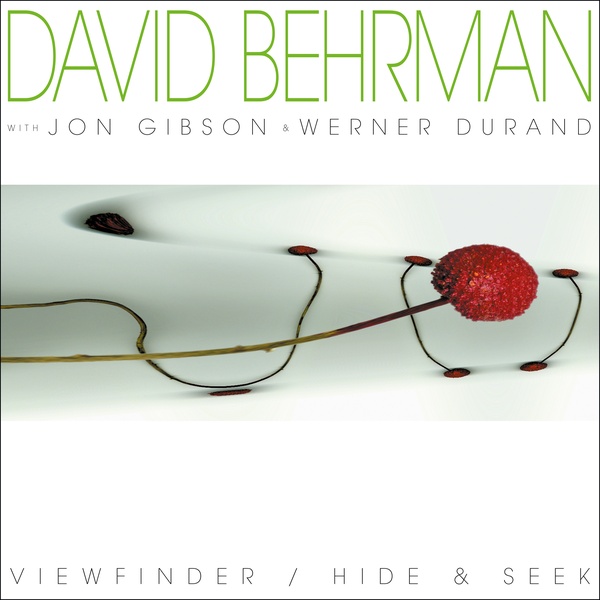
David Behrman
ViewFinder / Hide & Seek
Label: Black Truffle
Format: LP + Digital
Catalogue Number: BT082
Official web site: blacktruffle.bandcamp.com/album/viewfinder-hide-seek
Description
Black Truffle is thrilled to announce ViewFinder / Hide & Seek, a new release from acclaimed American experimental composer David Behrman, presenting recordings made in collaboration with Jon Gibson and Werner Durand between 1989 and 2020. Last heard from on Black Truffle as part of the collaborative art song/live electronics madness of She’s More Wild, these recordings find Behrman continuing the pioneering work in interactive electronics that have established him as one of the major living experimental composers.
Side A presents excerpts from two live realisations of Unforeseen Events (1989), the fourth in a series of pieces focussing on the interactions between instrumental performers and responsive software. Like the classic earlier works in the series, On the Other Ocean (1977), Interspecies Smalltalk (1984) and Leapday Night (1986), Unforeseen Events is an “unfinished composition” in which a computer system listens for and responds to specific pitch cues from an instrumentalist. Performed by the composer on electronics and Werner Durand on soprano saxophone in Berlin in 1989, the first realisation immediately ushers the listener into an environment of long soprano notes, lush, sustained synth harmonies, randomised percussive interjections and distantly burbling arpeggiated patterns.
The 1999 realisation recorded in New York with Jon Gibson on soprano shows how much room for the instrumentalist to affect the course of the music exists in Behrman’s interactive pieces, in which, as he notes, ‘performers have options rather than instructions’. Beginning in a roughly similar area to the version with Durand, this later recording eventually becomes substantially more active, as polyrhythmically layered arpeggios and percussive patterns respond to fast chromatic lines and dynamic phrases from the saxophone, moving Gibson in turn to respond with cycling figures and moments of extended technique that touch on the soprano languages pioneered by players like Steve Lacy and Evan Parker. Yet even at its most active, the lack of conventional forward movement in the music allows it to retain what Behrman’s friend Jacques Bekaert called its ‘fragile tranquillity’, as episodes of activity appear only as momentary disruptions of an underlying calm.
On the B side, we are treated to a new collaborative work from Behrman and Werner Durand, building on the 2002 installation work ViewFinder, in which a camera detecting physical motion triggered changes to electronic sound. The piece presented here is a long-distance studio construction, recorded by Behrman in the Hudson Valley and Durand in Berlin, offering up an expansive duet between Behrman’s lush, gliding synth tones and the alien, untempered tones of Durand’s invented and adapted wind instruments. Presented in a stunning gatefold sleeve with art from Terri Hanlon, archival photographs and new liner notes from Behrman and Durand,ViewFinder / Hide & Seek is an essential release showcasing the continuing vitality of a legendary figure in experimental music.
Black Truffle is thrilled to announce ViewFinder / Hide & Seek, a new release from acclaimed American experimental composer David Behrman, presenting recordings made in collaboration with Jon Gibson and Werner Durand between 1989 and 2020. Last heard from on Black Truffle as part of the collaborative art song/live electronics madness of She’s More Wild, these recordings ...
read more…
Tracklisting
- Unforeseen Events (Berlin)
- Unforseen Events (New York Part 1)
- Unforseen Events (New York Part 2)
- ViewFinder / Hide & Seek
Available from these fine distributors:
- USA – Forced Exposure www.forcedexposure.com
- Europe – Kompakt www.kompakt.fm/labels/black_truffle

Richard Youngs
CXXI
Label: Black Truffle
Format: LP + Digital
Catalogue Number: BT081
Official web site: blacktruffle.bandcamp.com/album/cxxi
Description
Black Truffle is pleased to announce the latest offering from underground legend Richard Youngs. Hyperactive since the late 1980s, Youngs is widely celebrated for his remarkably extensive and varied body of recordings. His works range freely over a vast terrain, wandering from tender acoustic balladry to raging psychedelic noise and orchestral D-beat, always imbued with his distinctive, often mournful, melodic sensibility and irrepressible sense of joyous experimentation.
Comprised of two side-long pieces, CXXI carried on the experiments with chance operations used to generate material on many of Youngs’ recent releases. On ‘Tokyo Photograph’, a slowly changing, randomly generated sequence of 121 minor chords played by sine waves and accented with a brushed snare hit on every change provides the harmonic foundation for Youngs’ fragile yet impassioned vocal performance, shards of field recordings and electronics and Sophie Cooper’s long, tape-echoed trombone notes. While the melancholic drift of the chords calls up prime Robert Wyatt sides like Old Rottenhat or Dondestan, only the most vestigial sense of song remains here, as Youngs arranges his minimal ingredients over a spacious fifteen-minute expanse that often drops to nothing more than the rich hum of sine waves.
‘The Unlearning’ carries on directly from the first side, presenting another, more harmonically varied, sequence of randomly generated chords played by sine waves, distressed with tape echo flourishes and sparsely sprinkled with electronic touches. Like some of Youngs’ most single-minded instrumental works in recent years, such as his recordings of foot-played guitar or his shakuhachi pieces, ‘The Unlearning’ is deeply meditative but entirely remote from ambient or minimalist cliches.
Named after the number of chord changes on the opening piece and (Chicago-style) the number of records Youngs has released, CXXI arrives in a striking monochrome sleeve featuring play-along chord charts for both pieces. Both rigorously conceptual and endearingly off-the-cuff, CXXI is classic Richard Youngs.
Black Truffle is pleased to announce the latest offering from underground legend Richard Youngs. Hyperactive since the late 1980s, Youngs is widely celebrated for his remarkably extensive and varied body of recordings. His works range freely over a vast terrain, wandering from tender acoustic balladry to raging psychedelic noise and orchestral D-beat, always imbued with ...
read more…
Tracklisting
- Tokyo Photograph
- The Unlearning
Available from these fine distributors:
- USA – Forced Exposure www.forcedexposure.com
- Europe – Kompakt www.kompakt.fm/labels/black_truffle
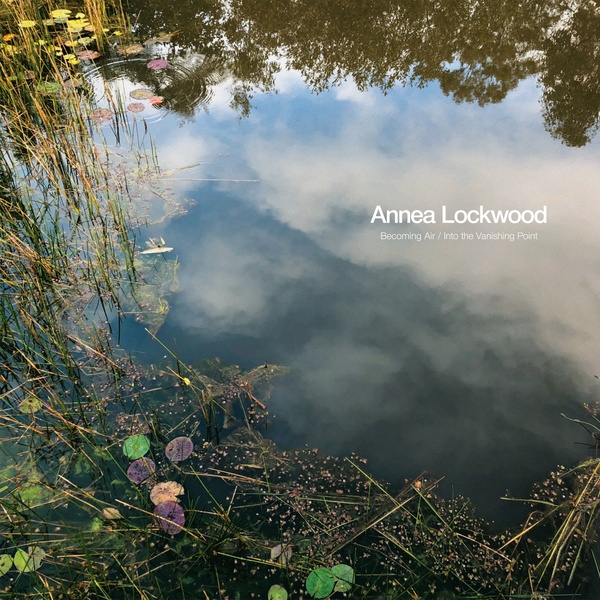
Annea Lockwood
Becoming Air / Into the Vanishing Point
Label: Black Truffle
Format: LP + Digital
Catalogue Number: BT080
Official web site: blacktruffle.bandcamp.com/album/becoming-air-into-the-vanishing-point
Description
Following on from the acclaimed Tiger Balm / Amazonia Dreaming / Immersion LP (BT028), Black Truffle is thrilled to present two major new instrumental works from legendary sound artist and experimental composer Annea Lockwood. Demonstrating the ever evolving and radically open nature of Lockwood’s practice, these two recent works were developed in close collaboration with their performers.
‘Becoming Air’ (2018), developed with and performed by trumpeter Nate Wooley, uses extended technique and electronics to interfere with Wooley’s virtuosic control over his instrument, pushing him into areas of fluctuating pitch and timbral instability. Motivated by a desire for ‘the letting go of sound to be itself’, ‘Becoming Air’ unfolds as a series of texturally distinct moments separated by pauses, each fixing on a particular approach to the instrument (long tones, upper-register whistles, breathy wooshes) and maintaining it in an essentially static fashion, focussing our attention on subtle changes and variations. Dipping into near-inaudibility in the fragile high tones of its opening section, the piece dramatically increases in volume and intensity in its final third, climaxing with a passage of roaring distortion, where the interaction between feedback and trumpet pitches calls up the shuddering interference effects of Robert Ashley’s Wolfman.
‘Into the Vanishing Point’ (2019) is a collaborative work developed with New York piano and percussion quartet Yarn/Wire, who have performed work by major contemporary composers such as Olivia Block, Catherine Lamb and Klaus Lang. Carrying on the ecological and environmental concerns of some of Lockwood’s previous works, ‘Into the Vanishing Point’ was inspired by a devastating news article on the global collapse of insect populations. Discovering that the four members of Yarn/Wire had also read this text, Lockwood mapped out a loose structure for the piece that would allow the composer and four performers to explore their ‘feelings about what is happening ecologically’. Working with a huge variety of instruments, objects and techniques of sound production, the resulting work is an alluringly lush, organically unfolding tissue of unorthodox textures and haunting tones. Though not intended to sonically represent ecological issues in any direct way, its unique sound world of rubbed piano strings, gently handled objects and chiming pitches often calls up natural images: of insects and frogs, wind rushing through trees, a bird’s wings in flight.
Presented in a stunning gatefold cover with liner notes by Lockwood, Wooley and Yarn/Wire, Becoming Air/Into the Vanishing Point is a testament to the generosity and experimentation that continue to characterise the work of this extraordinary artist, active for over fifty years.
Following on from the acclaimed Tiger Balm / Amazonia Dreaming / Immersion LP (BT028), Black Truffle is thrilled to present two major new instrumental works from legendary sound artist and experimental composer Annea Lockwood. Demonstrating the ever evolving and radically open nature of Lockwood’s practice, these two recent works were developed in close collaboration with their performers. ...
read more…
Tracklisting
- Becoming Air
- Into the Vanishing Point
Available from these fine distributors:
- USA – Forced Exposure www.forcedexposure.com
- Europe – Kompakt www.kompakt.fm/labels/black_truffle

Amelia Cuni
Parampara Festival 13.3.1992
Label: Black Truffle
Format: LP + Digital
Catalogue Number: BT079
Official web site: blacktruffle.bandcamp.com/album/parampara-festival-1331992
Description
Black Truffle is pleased to announce Parampara Festival 13.3.1992, a stunning performance by Amelia Cuni captured live in Berlin almost thirty years ago. Milanese by birth and resident in Berlin for many years, Cuni lived in India for over a decade, studying the classical vocal style of dhrupad under masters of the form. Though perhaps known to many listeners primarily through her performances of the vocal music of John Cage and collaborations with Werner Durand and Terry Riley, she is recognised internationally as one of the great contemporary proponents of traditional dhrupad singing. These recordings document her performance at the 1992 Parampara Festival at the Haus der Kulturen der Welt, a landmark event celebrating the global spread of Indian classical music, bringing together Indian teachers with their international students.
Accompanied by Gianni Ricchizzi on vichitra vina (a plucked zither played with a glass ball slide) and her own tanpura, Cuni stretches out for a languorous side-long performance of the late night Raag Bageshri, the limpid tones of her vocal improvisations illuminating the droning strings like flashes of the moon revealed by rushing clouds. Initially working patiently through a series of subtle dialogues between Cuni’s melodic extemporisations and phrases in response from Richizzi’s vichitra vina, the performance builds to a series of strikingly beautiful, virtuosic held notes from Cuni at the beginning of its second half, before picking up some brisker rhythmic articulation on the way to its conclusion.
On Devino Amor, Cuni presents her own composition, a setting of mystical texts by the 13th century Franciscan friar Jacopone da Todi, elaborated through various traditional raags. Like the words used for most dhrupad compositions, the text Cuni has selected from da Todi praises divine love, thus linking her otherwise unorthodox use of Italian text to the dhrupad tradition. The result is a performance of a yearning intensity that communicates across any language barrier. On the final performance, Cuni and Ricchizzi are joined by Helmut Waibl on the two-headed pakhawaj drum for a piece using a 14 beat rhythmic pattern that sets in motion a cycle of tension and release, metrical dissolution and resolution, possessing a subtle grandeur.
Illustrated with archival images of the performance and accompanied by new liner notes from Peter Pannke and Lars-Christian Koch, Parampara Festival 13.3.1992 invites listeners to lose themselves in Amelia Cuni’s unique approach to ancient tradition.
Black Truffle is pleased to announce Parampara Festival 13.3.1992, a stunning performance by Amelia Cuni captured live in Berlin almost thirty years ago. Milanese by birth and resident in Berlin for many years, Cuni lived in India for over a decade, studying the classical vocal style of dhrupad under masters of the form. Though perhaps ...
read more…
Tracklisting
- Raag Bageshri – Alaap
- Devino Amor
- Raag Shahana Kanada - Dhamar
Available from these fine distributors:
- USA – Forced Exposure www.forcedexposure.com
- Europe – Kompakt www.kompakt.fm/labels/black_truffle

Alvin Curran
Fiori Chiari, Fiori Oscuri
Label: Black Truffle
Format: LP + Digital
Catalogue Number: BT078
Official web site: blacktruffle.bandcamp.com/album/fiori-chiari-fiori-oscuri
Description
Black Truffle is pleased to announce the first-ever vinyl reissue of Alvin Curran’s classic Fiori Chiari, Fiori Oscuri, originally issued in 1978 on Ananda, the cooperative label run by Curran, Roberto Laneri, and Giacinto Scelsi. Fiori Chiari, Fiori Oscuri (Light Flowers Dark Flowers) – its title inspired by an intersection in Milan – is the second in the series of four solo recordings Alvin Curran issued in the 1970s and early 1980s, preceded by Songs and Views from the Magnetic Garden (1975), followed by The Works (1980) and Canti Illuminati (1982).
Each of these solo works combines field recordings with performances on synthesiser, various acoustic instruments, and voice, arranged in languorously paced, dreamy sequences. Far from the bracing pointillism of much musique concrete, the elements encountered on the meandering course followed by Fiori Chiari, Fiori Oscuri – whether a frenetic piano improvisation, dense layers of Serge synthesiser and ocarina, or a monologue from Frederic Rzewski’s five-year old son, Alexis – often occupy the foreground of our attention for minutes at a time. As Curran explains, his approach is like that of a filmmaker in the editing process, working with “whole blocks of recorded time”.
The purring of a cat, toy piano, a child counting, plaintive synthesiser tones, the cacophony of exotic birds at the London Zoo – each disappears into the next, until, on the LP’s second side, a solo piano performance takes centre stage, moving unexpectedly from percussive minimalist permutations to a halting rendition of Georgia on My Mind. A subtle yet stunning work that more than forty years on still seems charged with possibility, Fiori Chiari, Fiori Oscuri arrives in a loving reproduction of the original sleeve, featuring Edith Schloss’ beautiful cover painting, remastered audio and with new liner notes by Alvin Curran and Francis Plagne.
Black Truffle is pleased to announce the first-ever vinyl reissue of Alvin Curran’s classic Fiori Chiari, Fiori Oscuri, originally issued in 1978 on Ananda, the cooperative label run by Curran, Roberto Laneri, and Giacinto Scelsi. Fiori Chiari, Fiori Oscuri (Light Flowers Dark Flowers) – its title inspired by an intersection in Milan – is the ...
read more…
Tracklisting
- Fiori Chiari, Fiori Oscuri
Available from these fine distributors:
- USA – Forced Exposure www.forcedexposure.com
- Europe – Kompakt www.kompakt.fm/labels/black_truffle
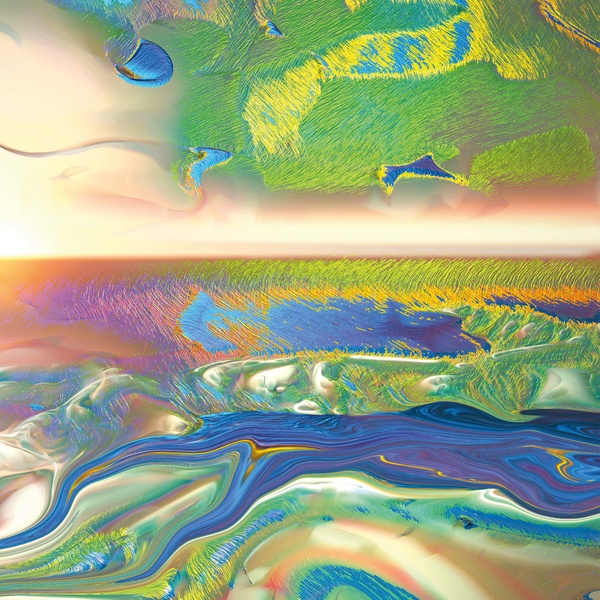
Ora Clementi
Sylva Sylvarum
Label: Black Truffle
Format: 2LP + Digital
Catalogue Number: BT077
Official web site: blacktruffle.bandcamp.com/album/sylva-sylvarum-2
Description
Black Truffle is pleased to present Sylva Sylvarum, an epic new work from Ora Clementi, the collaborative project of crys cole and James Rushford. Primarily conceived and recorded over several months together in Melbourne, Sylva Sylvarum is a stunning step forward from the mumbled, creaking sound world of the duo’s debut, Cover You Will Softer Me (Penultimate Press, 2014). From the opening ‘Peach of Immortality’, which takes an unpredictable journey from layers of chiming bells, vocal harmonies and lush synth pads to a desolate landscape of half-animal, half-digital wooshes and cries, it is immediately clear that cole and Rushford are working here with an entirely unique sound palette. Throughout the record’s four sides, we hear a large array of carefully detailed synthesizer sounds (many of them recorded at the remarkable Melbourne Electronic Sound Studio), sparse drum machine hits, wind instruments and field recordings of animals, often with a twistedly late 80s/early 90s flavour that at various points calls up New Age references, Robert Ashley’s later operas or the thinned-out textures of early digital GRM.
Threaded through this distinctive array of sounds are the two musicians’ voices, sometimes singing, sometimes speaking through varying degrees of manipulation. A guiding thread through the pair’s collaboration, beginning with their initial experiments with lip-readings, the presence of these two voices – cole’s crisp and sibilant, Rushford’s rich and low – reinforces the sense that the music is immersed in itself, less performed by two people than occurring between them. On Sylva Sylvarum, these voices first come to the forefront on the third piece, ‘Dialogue Between a Grandmaster of the Knights Hospitaller and a Genoese Sea Captain’, where in unison they intone fragments of a description of an imaginary space taken from a 17th century utopian text. The two voices resurface periodically thereafter, most stunningly in the unexpected turn into cushiony dream pop on ‘Magic Mountain’. At other points, the subtle manipulation of pitch and intonation in the close-miked vocal performances filters the recitations through a fog of abstraction that climaxes with the almost incomprehensible alternating syllables of the side-long closer ‘Forest of Materials’.
Like the album’s title, these textual elements are drawn from various literary descriptions of utopias, a theme that also informed the pair’s musical approach. Far from anything dryly illustrative, utopia figures into Sylva Sylvarum as an invitation to inhabit otherworldly spaces that, like the empirical details that proliferate in these literary utopias, are grounded in mundane reality but shot through with the eldritch. Admirably framed by the abstracted digital topographies of Sabrina Ratté’s artwork, the uncanny sweep of the album’s fifteen pieces is expansive enough to take in stretches of crackling austerity, warped microtonal keyboard etudes and moments of stunning beauty, the latter most strikingly when cole and Rushford are joined by Callum G’Froerer on trumpet and Joe O’Connor on trombone for a series of dream-like moments moving from growling overtones to poignant lyricism.
Presented in a deluxe gatefold sleeve with stunning artwork by Sabrina Ratté and pressed on mint green vinyl. Mixed and mastered by Joe Talia at Good Mixture, Berlin.
Black Truffle is pleased to present Sylva Sylvarum, an epic new work from Ora Clementi, the collaborative project of crys cole and James Rushford. Primarily conceived and recorded over several months together in Melbourne, Sylva Sylvarum is a stunning step forward from the mumbled, creaking sound world of the duo’s debut, Cover You Will Softer ...
read more…
Tracklisting
- Peach of Immortality
- Umbrella Spinner
- Dialogue Between a Grandmaster of the Knights Hospitaller and a Genoese Sea-Captain
- Vulning
- Lathe Of Heaven
- Sirin
- Nowhere Much Narrower
- Charioteers
- Milk Street
- Magic Mountain
- Ophir
- Paradigm and Places
- Threadneedle
- Ferae
- Forest of Materials
Available from these fine distributors:
- USA – Forced Exposure www.forcedexposure.com
- Europe – Kompakt www.kompakt.fm/labels/black_truffle
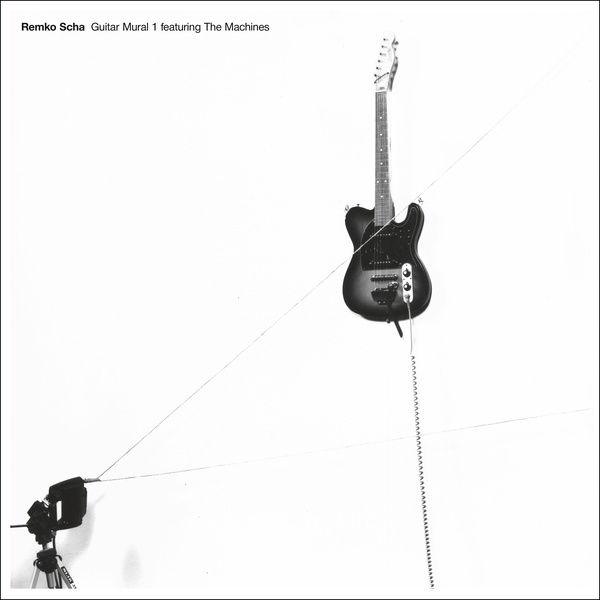
Remko Scha
Guitar Mural 1 featuring The Machines
Label: Black Truffle
Format: 2LP + Digital
Catalogue Number: BT076
Official web site: blacktruffle.bandcamp.com/album/guitar-mural-1-feat-the-machines
Description
Black Truffle is pleased to announce the first-ever vinyl reissue of Remko Scha’s Guitar Mural 1 featuring The Machines, originally published as a rare cassette edition by Taal Beeld Geluid in 1982. A computational linguist by profession, Scha played an important role in the development of sound, installation, and digital art in the Netherlands from the late 1970s onward, co-founding the performance and exhibition space Het Appolohuis in Eindhoven in 1980. Alongside Paul Panhuysen and Jan Van Riet, Scha was a founding member of the radical improvisation group The Maciunas Ensemble, though he is best known for his work with mechanised electric guitars, documented on the legendary 1982 LP Machine Guitars.
Guitar Mural 1 documents an installation of Scha’s mechanical guitar ensemble The Machines held at a Groningen gallery space in 1982. Five electric guitars hang from the wall, their strings sounded by rotating rubber strings and a sabre saw controlled by a mechanical apparatus, as well as four ropes criss-crossing the five instruments on the wall. Once the mechanism was set up, Scha’s only intervention was to vary the speed at which it operated. Where Machine Guitars presents short excerpts clearly distinguished by rhythmic and timbral variation, here we are confronted with four enormous side-long slabs of percussive string attack and the resulting clouds of harmonics. Variation is minimal across the duration of each side, making for a sculptural listening experience, as if we are patiently examining each facet of a static object. But significant variety exists between the four sides, each of which shows off a different facet of what The Machines were capable of. The first two excerpts feature open strings sounded at rapid tempos, dissolving the percussive attack into a continuous stream of sound reminiscent of Charlemagne Palestine’s ‘strumming’ technique. On the third side, the strings are partly muted and the tempo slightly lowered, resulting in layers of relentlessly chugging rhythm somewhere between an ensemble of hand drums and an early Velvet Underground bootleg. On the fourth side, havoc breaks loose in percussive waves of asynchronous repetition that bring Scha’s sound world close to that of another pioneer experiment in musical mechanisation, the Solar Music of Joe Jones.
Presented as a limited edition 2LP set in a deluxe gatefold sleeve accompanied by stunning visual documentation of the original installation, remastered audio and new liner notes from Alan Licht and Van Lagestein, Guitar Mural 1 is an exhilarating document occupying a unique space between kinetic sculpture, hardcore minimalism and rock & roll.
Black Truffle is pleased to announce the first-ever vinyl reissue of Remko Scha’s Guitar Mural 1 featuring The Machines, originally published as a rare cassette edition by Taal Beeld Geluid in 1982. A computational linguist by profession, Scha played an important role in the development of sound, installation, and digital art in the Netherlands from ...
read more…
Tracklisting
- Track 1
- Track 2
- Track 3
- Track 4
Available from these fine distributors:
- USA – Forced Exposure www.forcedexposure.com
- Europe – Kompakt www.kompakt.fm/labels/black_truffle

Sam Dunscombe
Outside Ludlow / Desert Disco
Label: Black Truffle
Format: LP + Digital
Catalogue Number: BT075
Official web site: samdunscombe.bandcamp.com/album/outside-ludlow-desert-disco
Description
Outside Ludlow / Desert Disco is the first major solo release from Australian performer-composer Sam Dunscombe, now based in Berlin after residing for the past decade in San Diego and Tokyo. A virtuoso clarinettist who has performed in composed and improvised settings with artists such as Klaus Lang and Taku Sugimoto, their practice also embraces computer music, lo-fi electronics and field recordings, in addition to their long-term commitment to archiving, studying and performing the work of Romanian spectralist composer Horatiu Radulescu.
The two side-long pieces presented on this LP began from a chance encounter in a specific geographic location (documented in the photographs that grace the record’s sleeve). Exploring California’s Mojave desert with a friend, Dunscombe made the unlikely discovery of a tangle of quarter-inch tape snared on a cactus. The digitised version of this tape, variously edited and processed, as well as Dunscombe’s own transcription and embellished performance of some of its material on Hammond organ, makes up one of the main ingredients of the LP’s first side. The other is a field recording of the area outside the ghost town of Ludlow, where the tape was found, where haunted silence is punctuated by freight trains and clusters of explosions from gold mines and the local marine corps. Far from any kind of documentary approach, the resulting composition reaches back to the smeared atmospherics and overdriven tape crunch of Hands To, Small Cruel Party or Joe Colley, before the Hammond organ rises up to cast a spectral shimmer reminiscent of 1960s tape music classics like Arne Nordheim’s ‘Warszawa’.
On ‘Desert Disco’ (its title perhaps a clue to the content of the mysterious tape), Dunscombe zeroes in on a single fragment of the tape, accompanying it with analogue synthesis to craft an immersive work based on a single chord. Throughout the course of this work, the monolithic opening sonority gradually splits apart, revealing an infinity of rhythmically phasing lines that swarm like a cloud of insects and patter like falling rain, placing Dunscombe’s piece in a lineage of patient electronic exploration that includes landmarks like Costin Miereanu’s Derives and the contemporary work of Jim O’Rourke.
Limited edition vinyl with images by Sam Dunscombe and design by Lasse Marhaug. Mastered by Joe Talia at Good Mixture, Berlin.
Outside Ludlow / Desert Disco is the first major solo release from Australian performer-composer Sam Dunscombe, now based in Berlin after residing for the past decade in San Diego and Tokyo. A virtuoso clarinettist who has performed in composed and improvised settings with artists such as Klaus Lang and Taku Sugimoto, their practice also embraces ...
read more…
Tracklisting
- Outside Ludlow
- Desert Disco
Available from these fine distributors:
- USA – Forced Exposure www.forcedexposure.com
- Europe – Kompakt www.kompakt.fm/labels/black_truffle
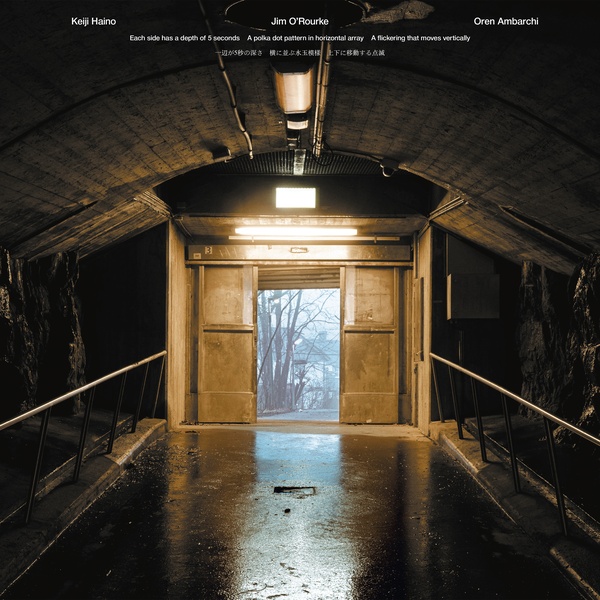
Keiji Haino / Jim O'Rourke / Oren Ambarchi
Each side has a depth of 5 seconds A polka dot pattern in horizontal array A flickering that moves vertically
Label: Black Truffle
Format: LP + Digital
Catalogue Number: BT074
Official web site: blacktruffle.bandcamp.com/album/each-side-has-a-depth-of-5-seconds-a-polka-dot-pattern-in-horizontal-array-a-flickering-that-moves-vertically
Description
The trio of Keiji Haino, Jim O’Rourke, and Oren Ambarchi return to Black Truffle with their 10th release, recorded live in Tokyo in February, 2017. While many of the trio’s recent works have seen them focussing primarily on their core guitar/bass/drums power trio format, on Each side has a depth of 5 seconds A polka dot pattern in horizontal array A flickering that moves vertically these three multi-instrumentalists strike into new territory, utilising an almost entirely electronic set-up, with Haino on electronics, drum machine and suona (a Chinese double-reed horn), O’Rourke on synth, and Ambarchi on pedal steel and electronics.
Dedicated to the memory of legendary Tokyo underground figure Hideo Ikeezumi, founder of PSF Records and the Modern Music shop and a long-term collaborator with Haino, the LP, (recorded the night Ikeezumi passed away), begins in a sombre, meditative space of rippling, burbling electronics and distant jets of white noise. Though much of the ‘Introduction’ that occupies the record’s first side is spacious and at times almost hushed, the performance is full of unexpected twists and turns, momentary events, and fleeting impressions. The trio conjures up a free-flowing surge of sound in which individual contributions are often difficult to distinguish, calling up echoes of vintage live-electronic sizzle like It’s Viaje or the cavernous expanse of David Behrman’s Wave Train.
The LP’s second side opens in a similarly reflective realm, before Haino’s suona enters, taking the music in a more austere, hieratic direction, as the reed’s piercing tones are accompanied by O’Rourke’s uneasy, sliding synth figures and Ambarchi’s shimmering Leslie cabinet tones. On the side’s second piece, Haino’s signature hand-played drum machine takes centre-stage, at first sounding out massive, isolated strikes, before eventually building to a tumbling, Milford Graves-esque wall of thunder. As O’Rourke’s synth squelches and stutters and Ambarchi’s heavily effected pedal steel somehow begins to sound like a kind of hellish blues harmonica, this passage offers up one of the most electrifying and bizarre moments in the trio’s catalogue to date.
Containing some of the most abstract music the trio have waxed since their very first collaboration over a decade ago (Tima Formosa, BT04), this new missive from underground experimental music’s preeminent power trio shows them restless and risk-taking, clearly enjoying their remarkable improvisational chemistry while also continuing to push themselves into new directions.
Presented in a deluxe gatefold sleeve with artwork and design by Lasse Marhaug and an inner sleeve with live pics by Ujin Matsuo.
The trio of Keiji Haino, Jim O’Rourke, and Oren Ambarchi return to Black Truffle with their 10th release, recorded live in Tokyo in February, 2017. While many of the trio’s recent works have seen them focussing primarily on their core guitar/bass/drums power trio format, on Each side has a depth of 5 seconds A ...
read more…
Tracklisting
- Introduction
- Part I
- Part II
- Part III
Available from these fine distributors:
- USA – Forced Exposure www.forcedexposure.com
- Europe – Kompakt www.kompakt.fm/labels/black_truffle
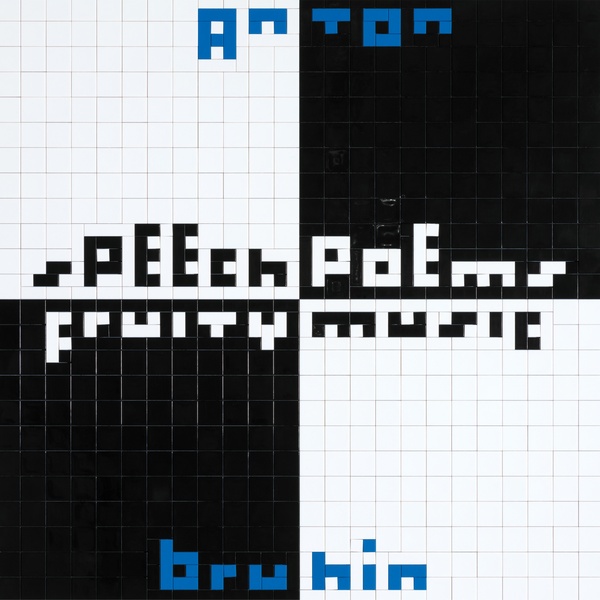
Anton Bruhin
Speech Poems / Fruity Music
Label: Black Truffle
Format: LP + Digital
Catalogue Number: BT073
Official web site: blacktruffle.bandcamp.com/album/speech-poems-fruity-music
Description
Black Truffle is delighted to offer up a rare serving of unheard works by legendary Swiss artist Anton Bruhin. Active as a visual artist, poet, and musician since the 1960s, Bruhin has created important work in forms as varied as concrete poetry and landscape painting, imbuing everything he does with wit, humility, and absurdist humour. A recognised master of the jew’s harp (or Trümpi, as this ancient folk instrument is known in Swiss German), Bruhin’s sound work also encompasses tape collage, sound poetry, and manipulated bird song.
On Speech Poems/Fruity Music we are treated to 26 short pieces made between 2006 and 2008 using the audio software Fruity Loops. These pieces carry on Bruhin’s long-running project of exploring the creative use and misuse of cheap, accessible technologies. In many of his analogue works, Bruhin explored the possibilities of simple cassette equipment. He invented DIY approaches to layering sounds by using multiple tape machines, experimented with distortion and tape speed, or, in his classic Inout (1981) created a maniacally single-minded audio monument to the pause button. Like the computer pixel drawings the artist produced around the same time as these recordings, Speech Poems/Fruity Music extends this approach to consumer software, presenting two parallel sequences of works that make use of Fruity Loops’ inbuilt synthetic instruments and its speech synthesis function. The instrumental works play like a twisted take on the aesthetics of 1980s video game soundtracks, using synthetic accordion and harpsichord sounds to realise jaunty little ditties that exploit their machine-realisation by making use of improbable pitch-bends and humanly impossible tempos and articulations.
Between these samples of Fruity Music, we are treated to the Speech Poems, a series of recitations by a lone computer-generated voice. Many of them are in fact songs, as the synthetic voice crudely and hilariously changes pitch as it moves through its fragmented syllables and odes to cream in coffee. Carrying on Bruhin’s interest in the creative misuse of technology, many of the Speech Poems attempt to force Fruity Loops’ voice synthesis, designed only to speak English, to speak German. By entering phonetic text into the program, Bruhin gets it to produce a passable German alphabet and a series of approximations to a proper pronunciation of his name.
Hilarious while strangely austere, entertaining but bizarre, Speech Poems/Fruity Music is classic Anton Bruhin, arriving in a beautiful mosaic cover by the artist, with the text of the ‘abc für anglophone’ on the back cover.
Black Truffle is delighted to offer up a rare serving of unheard works by legendary Swiss artist Anton Bruhin. Active as a visual artist, poet, and musician since the 1960s, Bruhin has created important work in forms as varied as concrete poetry and landscape painting, imbuing everything he does with wit, humility, and absurdist humour. ...
read more…
Tracklisting
- fruity loops music 1
- abc für anglophone
- aughntone brooheene
- 1st poem
- 2nd poem
- 3rd poem
- 4th poem
- 5th poem
- bastei mit strohdach
- 99neeneenee99
- a a a a oo oo
- go plus coda
- troll
- coffee kremkream
- lieber markus
- guete rutsch und guets nüüs
- muy knew poem
- voo poo poo pott f m z
- tchakk
- nadder nodder nooder
- thrupht
- furanda
- mahwquabba
- poolpoolpoolpool
- down the river
- sonntagsgruft
Available from these fine distributors:
- USA – Forced Exposure www.forcedexposure.com
- Europe – Kompakt www.kompakt.fm/labels/black_truffle

Will Guthrie & James Rushford
Real Real World
Label: Black Truffle
Format: LP + Digital
Catalogue Number: BT072
Official web site: blacktruffle.bandcamp.com/album/real-real-world
Description
Real Real World is the first collaborative effort from Nantes-based Australian drummer/percussionist Will Guthrie and Australian keyboardist/composer James Rushford.
Primarily recorded in a fluid, spontaneous studio session in Nantes, with overdubs added later in Melbourne and Nantes, Real Real World presents five spacious, unhurried pieces that inhabit a unique sound world characterised by wheezing, half-voiced organ chords, chiming metal percussion, and eruptions of small sounds. Beginning with the eerily beautiful, shakuhachi-esque sound of Rushford performing on detuned portative organ, the opening title track is abruptly transformed by the entry of Guthrie’s sizzling cymbals, deep gong strikes, and rustling hand percussion. On the epic ‘Lumbering’, which occupies the majority of the record’s first side, organ chords define a space in which a kaleidoscopic succession of amplified thuds, chiming bells, rustled and dragged objects, and abruptly silenced clusters advance and recede in an oneiric blur, eventually making way for a passage of Guthrie’s virtuosic polyrhythms, itself unexpectedly overtaken by waves of melting fairground organ.
The record reaches an energetic climax mid-way through the second side with the stunning ‘Slakes’, where lugubrious chords in the organ’s lowest register are joined by Guthrie’s skittering rhythms, which somehow manage to call to mind both the most chaotic moments of Balinese Gamelan and the stochastic breakbeats of late-90s Autechre. On this piece, Guthrie and Rushford are joined by Melbourne saxophone maverick Scott McConnachie, who contributes an alto sax solo of burning precision, working with a single-minded palette of piercing long tones and wild intervallic leaps.
Though it makes extensive use of overdubbing, Real Real World retains a strong sense of having been performed, rather than constructed: while at times the fleeting succession of events can recall electroacoustic music, its primarily acoustic nature and unhurried pace is also reminiscent of the music of AACM affiliates or Marion Brown’s classic Afternoon of a Georgia Faun. Immediately engaging while also hiding countless details in the folds of its polychrome fabric, Real Real World is a relaxed and joyous document of collaborative musical invention.
Artwork by Patrizia Bach.
Layout by Lasse Marhaug.
Mixed and mastered by Joe Talia at Good Mixture, Berlin.
Real Real World is the first collaborative effort from Nantes-based Australian drummer/percussionist Will Guthrie and Australian keyboardist/composer James Rushford. Primarily recorded in a fluid, spontaneous studio session in Nantes, with overdubs added later in Melbourne and Nantes, Real Real World presents five spacious, unhurried pieces that inhabit a unique sound world characterised by wheezing, half-voiced ...
read more…
Tracklisting
- Real Real World
- Lumbering
- Gojek Eltham
- Slakes
- Blue-eyed Boy
Available from these fine distributors:
- USA – Forced Exposure www.forcedexposure.com
- Europe – Kompakt www.kompakt.fm/labels/black_truffle
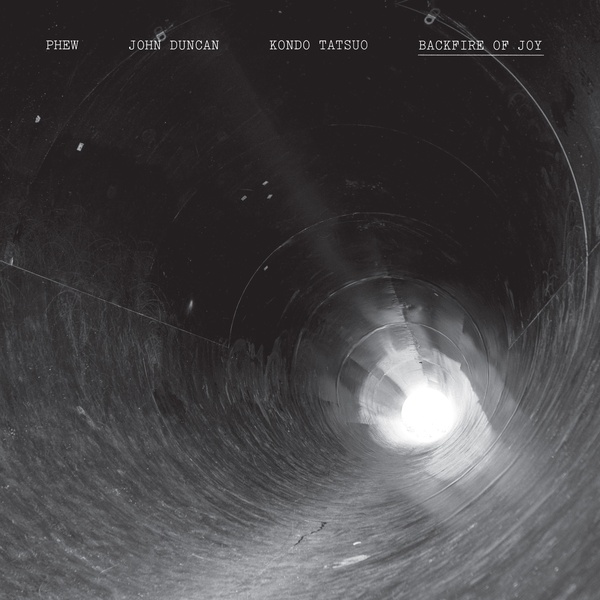
Phew / John Duncan / Kondo Tatsuo
Backfire Of Joy
Label: Black Truffle
Format: LP + Digital
Catalogue Number: BT071
Official web site: blacktruffle.bandcamp.com/album/backfire-of-joy
Description
Black Truffle is thrilled to announce Backfire of Joy, a previously unheard recording from Phew, John Duncan and Kondo Tatsuo, documenting a concert at Tokyo’s Hosei University in 1982. Though the fertile exchange of ‘zines, tapes and records between the Japanese underground and the Los Angeles Free Music Society meant the artists were familiar with each other’s work, this performance (occurring on Duncan’s first visit to Japan) was their first meeting and only performance as a trio.
Duncan is heard on his signature shortwave radio set-up, while Kondo performs on synth, tape loops and echo-drenched piano, providing a spacious backdrop for Phew’s astonishing performance of spontaneous, free-associative song moving between Japanese and English. A testament to the unhinged exploration of the 1980s experimental underground, the trio careen wildly between crashing percussive tape loops, deluges of shortwave noise, insistent piano figures and playful synth melodies. On the B side, we are treated to a remarkable ten minute sequence moving organically from spaced-out synth and radio textures to a stunning finale of improvised balladry centred on piano and voice, unexpectedly broken up by electronic interjections. Beautifully recorded in crunchy vintage fidelity, Backfire of Joy arrives accompanied by archival photographs and newly authored liner notes from all three participants.
Black Truffle is thrilled to announce Backfire of Joy, a previously unheard recording from Phew, John Duncan and Kondo Tatsuo, documenting a concert at Tokyo’s Hosei University in 1982. Though the fertile exchange of ‘zines, tapes and records between the Japanese underground and the Los Angeles Free Music Society meant the artists were familiar with ...
read more…
Tracklisting
- Backfire
- Joy
Available from these fine distributors:
- USA – Forced Exposure www.forcedexposure.com
- Europe – Kompakt www.kompakt.fm/labels/black_truffle
- UK – Boomkat www.boomkat.com
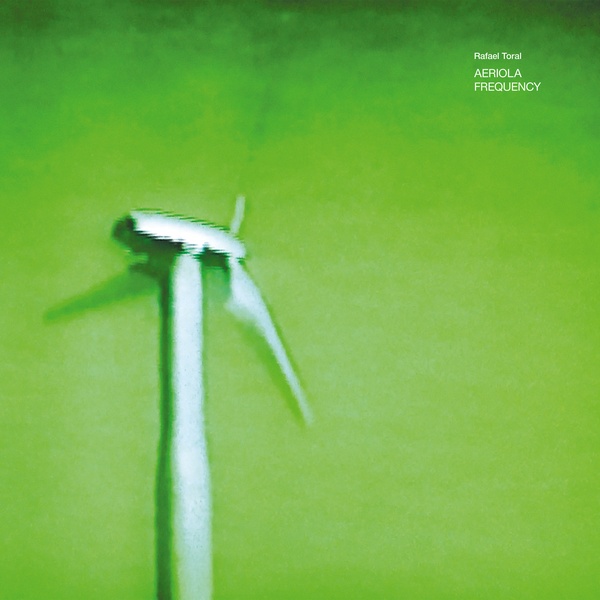
Rafael Toral
Aeriola Frequency
Label: Black Truffle
Format: LP + Digital
Catalogue Number: BT070
Official web site: blacktruffle.bandcamp.com/album/aeriola-frequency
Description
Black Truffle is proud to announce the first vinyl reissue of Rafael Toral’s Aeriola Frequency, originally released by Perdition Plastics in 1998. Toral made his name in the world of mid-90’s experimental electronics with two releases, Sound Mind Sound Body (1994) and Wave Field (1995), both now recognised as classics and reissued on vinyl by Drag City, which saw him exploring the potential of electric guitar and pedals to immerse the listener in seemingly endless waves of sustained tones. On Wave Field, inspired by the striking resonance effects he experienced during a Buzzcocks gig with bad acoustics, he achieved a synthesis—often imitated but never bettered—of rock guitar, Ambient, and the acoustic exploration of Alvin Lucier, a kind of “liquid, abstract flux of rock sound”.
On Aeriola Frequency, Toral continued the explorations of Wave Field but dropped the guitar, creating a series of extended pieces using only a simple feedback loop designed to work with pure electronic resonance. The result is far more delicate than Wave Field, a steady but unstable flow of filtered tones that continually reorder themselves into new forms. On both the LP’s sides, the tones, like growing plants, imperceptibly shift from drifting freely in ambient space to weaving strangely natural melodic patterns, as the loops unfold and the resonance gently outlines recurring rhythmic shapes.
The overall effect is strikingly organic, as David Toop noted in the liner notes included in the original release (and reprinted in this reissue): “A crystal garden, the sound grows in reeds and streams, blown like spider web strands, glittering and invisible, pulsing with translucent colour, bubbling and imploding, fraying and powdering.”
A classic of the non-academic approach to electronics that flourished in the 1990s— and a big influence at the time on Black Truffle head honcho Oren Ambarchi—Aeriola Frequency ushers listeners into an endlessly fascinating world of gliding tones and shifting details that they might never want to leave.
Recorded at Noise Precision, Portugal, December 1997 and April 1998. Remastered by Rafael Toral in 2020.
Images taken from Air Pass, a video by Rafael Toral.
Design by Lasse Marhaug.
Liner notes by David Toop and Rafael Toral.
Black Truffle is proud to announce the first vinyl reissue of Rafael Toral’s Aeriola Frequency, originally released by Perdition Plastics in 1998. Toral made his name in the world of mid-90’s experimental electronics with two releases, Sound Mind Sound Body (1994) and Wave Field (1995), both now recognised as classics and reissued on vinyl by ...
read more…
Tracklisting
- Cyclorama Lift 2 (digital version only)
- Cyclorama Lift 3
- Cyclorama Lift 4
Available from these fine distributors:
- USA – Forced Exposure www.forcedexposure.com
- Europe – Kompakt www.kompakt.fm/labels/black_truffle
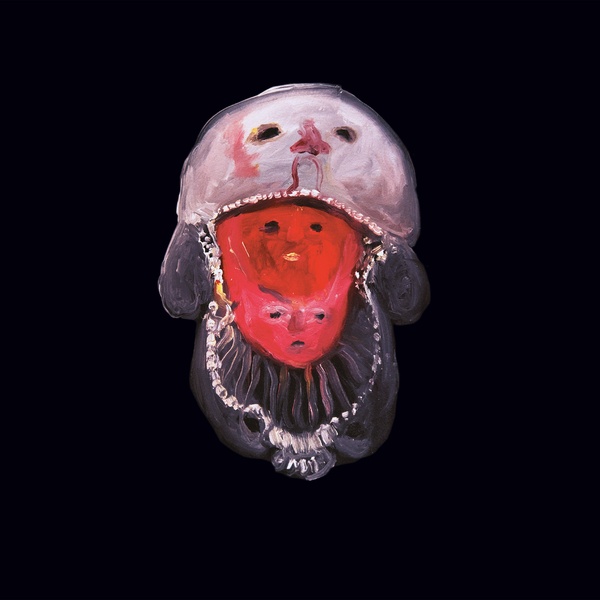
Kassel Jaeger
Meith
Label: Black Truffle
Format: LP
Catalogue Number: BT069
Official web site: kasseljaeger.bandcamp.com/album/meith
Description
Black Truffle is pleased to present Meith, a new composition in two parts from prolific composer/theorist
François Bonnet. Usually operating under his Kassel Jaeger moniker, Bonnet is a major figure in contemporary electronics and electro-acoustic music, collaborating with artists such as Lucy Railton, Jim O’Rourke, and Stephen O’Malley, and releasing his work on labels including Editions Mego, Senufo, and Shelter Press. Always meticulously detailed yet immediately affecting, Bonnet’s work situates itself at a very personal intersection between the traditions of academic electronic and electroacoustic music, and a more shadowy, underground group of approaches to experimental sound: kosmische Musik, the tape murk of the 1980s underground, the haunted ambience of Christoph Heemann & Co.
Meith immediately welcomes us into its densely layered sound world of electronic tones, positive organ, and unidentifiable field-recorded textures. Almost static yet constantly in flux, it deliberately opens itself up to repeated and varied listening: from a distance, its many voices cohere into a monolithic plane of sound, while closer inspection reveals myriad details and momentary events. Like a drop of ink spreading through water, harmonic material present in one voice gradually fans out into the whole arrangement, creating fleeting moments of unity amid the constantly shifting waves of tone and texture.
Far from the austerity of some contemporary electro-acoustic music, Meith affects the listener as overwhelmingly organic; its individual layers are unstable and at times near-chaotic, imbued with life. Though it can appear almost formless, the piece undergoes major shifts throughout its duration, from the austere dissonance of the opening moments to the surging harmonies that appear midway through the second side before the piece gradually dissolves into a spectral glimmer.
Francis Plagne.
Music composed by François J. Bonnet.
Artwork by Joseba Eskubi.
Design by Lasse Marhaug.
Mastered by Giuseppe Ielasi.
Black Truffle is pleased to present Meith, a new composition in two parts from prolific composer/theorist François Bonnet. Usually operating under his Kassel Jaeger moniker, Bonnet is a major figure in contemporary electronics and electro-acoustic music, collaborating with artists such as Lucy Railton, Jim O’Rourke, and Stephen O’Malley, and releasing his work on labels including ...
read more…
Tracklisting
- Part I
- Part II
Available from these fine distributors:
- USA – Forced Exposure www.forcedexposure.com
- Europe – Kompakt www.kompakt.fm/labels/black_truffle
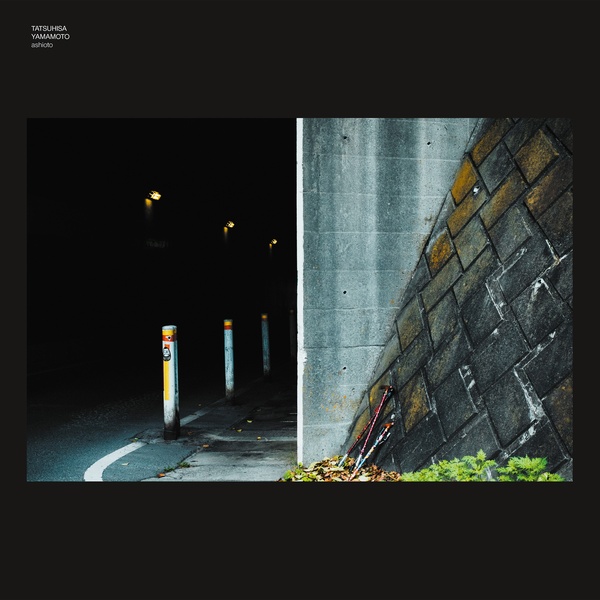
Tatsuhisa Yamamoto
Ashioto
Label: Black Truffle
Format: LP
Catalogue Number: BT068
Official web site: blacktruffle.bandcamp.com/album/ashioto
Description
Black Truffle is pleased to announce Ashioto, the first international solo release from Japanese drummer-percussionist-composer Tatsuhisa Yamamoto. Active for over a decade, Yamamoto has performed and recorded extensively with artists such as Jim O’Rourke, Eiko Ishibashi and Akira Sakata, as well as participating in innumerable improvised and ad hoc groups. Ashioto presents two wide-ranging pieces that combine Yamamoto’s percussion work with piano, field recordings, electronics, and contributions from guest musicians Daisuke Fujiwara and Eiko Ishibashi. Beginning with a passage of chiming metal percussion, the first side slowly builds into a rolling, open groove reminiscent of Yamamoto’s work on Eiko Ishibashi’s acclaimed Drag City LP The Dreams My Bones Dream. Spacious piano and synth notes, along with Ishibashi’s spare melodic figures on processed flute, hover above this propulsive rhythmic foundation, the whole effect adding up to a more abstract take on the area explored on Rainer Brüninghaus’s ECM classic Freigeweht.
The LP’s second side opens up a cavernous space filled with ominous electronics and shimmering metallic percussion, which organically transitions into a passage of rumbling piano chords and mysterious concrète sound. Later in the piece, Daisuke Fujiawara’s saxophone enters, playing melancholic melodic fragments that are looped and layered, creating a seasick swaying effect familiar to listeners of James Tenney’s works with tape delay systems. Beginning as delicate bass drum pulses, Yamamoto’s accompanying percussion eventually builds the piece into a raging torrent of free-improv splatter, processed sax and fizzing electronics. Though grounded in instrumental performance, Ashioto is very much a studio construction, making inventive use of electro-acoustic principles in its editing and mixing. Together with its sister Ashiato – a different take on the same ‘script’ released simultaneously on Japanese label Newhere – Ashioto demonstrates to an international audience for the first time the true breadth and ambition of Yamamoto’s work.
Mastered by Jim O’Rourke.
Cover photos by Kuniyoshi Taikou.
Design by Lasse Marhaug.
Black Truffle is pleased to announce Ashioto, the first international solo release from Japanese drummer-percussionist-composer Tatsuhisa Yamamoto. Active for over a decade, Yamamoto has performed and recorded extensively with artists such as Jim O’Rourke, Eiko Ishibashi and Akira Sakata, as well as participating in innumerable improvised and ad hoc groups. Ashioto presents two wide-ranging pieces ...
read more…
Tracklisting
- Ashioto Part 1
- Ashioto Part 2
Available from these fine distributors:
- USA – Forced Exposure www.forcedexposure.com
- Europe – Kompakt www.kompakt.fm/labels/black_truffle
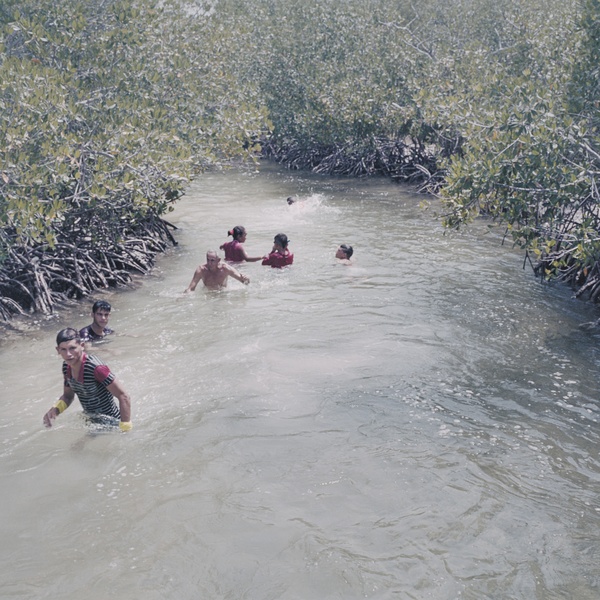
Bellows
Undercurrent
Label: Black Truffle
Format: LP
Catalogue Number: BT067
Official web site: blacktruffle.bandcamp.com/album/undercurrent
Description
Black Truffle are pleased to announce Undercurrent, the new LP from the long-running Milanese duo of Giuseppe Ielasi and Nicola Ratti. Following on from high-profile releases on Boomkat Editions and Shelter Press in the last few years, the eight untitled pieces making up Undercurrent continue the pair’s hypnotic and disorientating practice of improvisation based on tape loops. Often sitting halfway between electro-acoustic technique and beat-based production, the music of Bellows obliquely recalls aspects of hip-hop, dub, and techno while skewing their rhythmic foundations. While consistent with the distinctive language the duo have developed over the last decade, Undercurrent moves away from the explicit references made to club music in their recent releases. It presents a suite of pieces that are markedly more minimal, at times reminiscent in their haunted introspection of the legendary Tolerance records on Vanity Records. The pieces here often dwell for minutes at a time on single repeating tones, reverberating like distant bells in desolate landscapes of looped tape hiss.
Where previous releases were primarily based on samples, Undercurrent uses recordings of the duo playing various instruments (guitar, drums, synthesizer) cut into tape loops and then used as the bases for song-length tracks, each of which establishes a central repeating motif while also opening up on close listening to reveal multitudes of improvised detail and subtle shifts in tone, texture, and tempo. Beginning with the mournful sliding tones and obscured fragments of field recordings on the opening track, the LP moves from lush synth pads to super-minimal pings and haunted drone. On ‘6’ and ‘7’, spacious, hanging guitar figures give the music an elegiac quality recalling the work of Dean Roberts and Ielasi’s own earlier guitar-based music (such as the classic Gesine, released on Häpna in 2005). The record subtly builds to its final track, which works the barest of elements – a slowed-tone loop of steel drums, a distant whistle, beeping electronics – into a piece somehow imbued with a quiet grandeur, a fitting conclusion to a record that, like all of the duo’s work, is both sonically exploratory and immediately accessible.
Photography by Giulia Bruno.
Design by Lasse Marhaug.
Mastered by Giuseppe Ielasi.
Black Truffle are pleased to announce Undercurrent, the new LP from the long-running Milanese duo of Giuseppe Ielasi and Nicola Ratti. Following on from high-profile releases on Boomkat Editions and Shelter Press in the last few years, the eight untitled pieces making up Undercurrent continue the pair’s hypnotic and disorientating practice of improvisation based on ...
read more…
Tracklisting
- 01
- 02
- 03
- 04
- 05
- 06
- 07
- 08
Available from these fine distributors:
- USA – Forced Exposure www.forcedexposure.com
- Europe – Kompakt www.kompakt.fm/labels/black_truffle
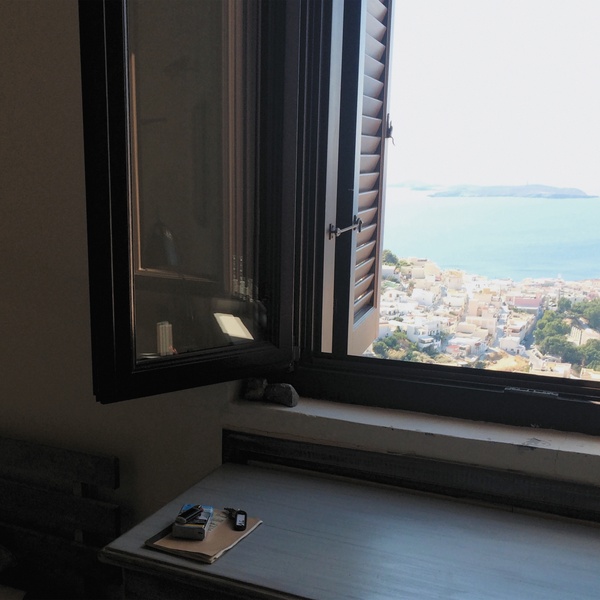
Judith Hamann
Peaks
Label: Black Truffle
Format: LP
Catalogue Number: BT066
Official web site: blacktruffle.bandcamp.com/album/peaks
Description
Black Truffle is very proud to present Peaks by Australian cellist Judith Hamann, her debut release of electro-acoustic music. Known mostly for her live performance work with composers including Sarah Hennies, Yvette Janine Jackson, Alvin Lucier, Tashi Wada, and La Monte Young, here she steps away from the cello, moving into an intimate dreamscape woven from recordings gathered over years of itinerant touring.
Peaks is a work in two distinct parts, crossfading between different landscapes and apertures; from rooftop to church, from stasis to flares of momentary romanticism. Peaks considers summits as being both above and below, reframing the idea of apex from a more intimate perspective. Hamann considers how our domestic and personal geographies might form their own apogees, meridians, or nadirs.
Assembled in 2019 while an artist in residence in Krems, Austria, Peaks begins with Hamann’s more familiar cello but soon unravels into resonant electronic interiors; Southern California nightscapes heard through windows, San Francisco bathroom fans, snatches of recordings of friends, hand organs, and engines. signal/centinela draws primarily on recordings from Hamann’s time living in San Diego, and carries with it a certain sense of nostalgia in the sense of homesickness, longing, and displacement of distance and time. Side B is composed from recordings gathered on a different continent, Europe, weaving piano with recordings of sleep, breath, church organ, and the act of climbing. under/over emerges as it recedes, overlapping moments of arrival to create another kind of ‘spire’ in the sense of spir (breath). Peaks, with its omission of any recordings from Hamann’s home of Australia, hints at how the very construction of home itself, might be restless, untethered, changeable, and malleable.
On Peaks, Hamann interrogates tropes of ambient concrète musics, intentionally pivoting formally around material which teeters on the edge of cliche. This exploration asks whether familiar frames of harmony, field recordings and narrative trajectories can excavate new territories, or be ruptured. Peaks untangles a very personal sense of tension between beauty and shame in experimental music: treating lushness and harmony as possessing potentially muscular musical properties that might wrestle with or construct senses of belonging and home.
Design by Lasse Marhaug.
Photos by Judith Hamann.
Mixed and mastered by Alan F Jones.
Black Truffle is very proud to present Peaks by Australian cellist Judith Hamann, her debut release of electro-acoustic music. Known mostly for her live performance work with composers including Sarah Hennies, Yvette Janine Jackson, Alvin Lucier, Tashi Wada, and La Monte Young, here she steps away from the cello, moving into an intimate dreamscape woven ...
read more…
Tracklisting
- signal/centinela
- under/over
Available from these fine distributors:
- USA – Forced Exposure www.forcedexposure.com
- Europe – Kompakt www.kompakt.fm/labels/black_truffle
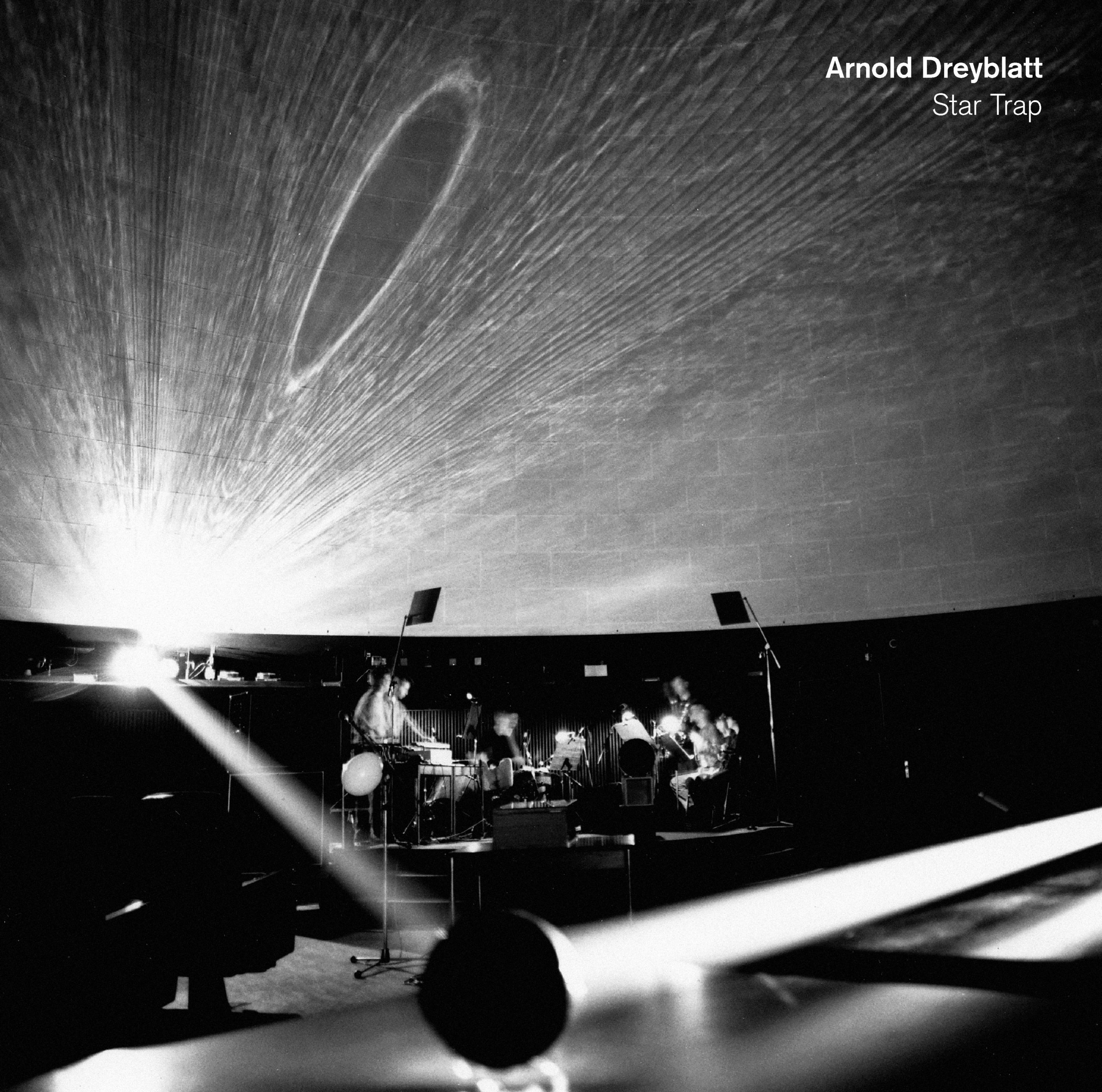
Arnold Dreyblatt
Star Trap
Label: Black Truffle
Format: LP
Catalogue Number: BT065
Official web site: arnolddreyblatt.bandcamp.com/album/star-trap
Description
Star Trap presents a selection of hitherto unreleased 1990s recordings from Arnold Dreyblatt and his Orchestra of Excited Strings. Following on from Black Truffle’s wide-ranging archival Second Selection (2015), which presented a smorgasbord of unreleased material from between 1978 and 1989, Star Trap mines Dreyblatt’s extensive archive of unheard recordings from the 1990s, uncovering six pieces performed by three different iterations of the Orchestra of Excited Strings.
While Dreyblatt often performs in his ensembles on his signature Excited Strings Bass (a double bass strung with piano wire), here we find him in the composer’s chair and behind the mixing desk, leading ensembles of modified percussion, string, and wind instruments. Four of the pieces make use of Dreyblatt’s Dynamic Processing System (heard on a stunning pair of solo pieces for electric guitar featured on Second Selection), in which the opening and closing of digital noise gates are controlled by an external signal (in this case, a recording of faulty escalator). Rather than the relentless thudding rhythms of 1980s works like Nodal Excitations, the ensemble pieces here are closer to the propulsive, at times even funky rhythmic foundation of Dreyblatt’s classic Animal Magnetism (Tzadik, 1995), but further enlivened by the unpredictable accents of the Dynamic Processing System.
On ‘Escalator’, a six-piece version of the Orchestra performs the notated stuttering rhythms and shifting accents of the gated escalator recordings, without the actual Dynamic Processing System being audible. On the remaining two pieces, composed for the tenth anniversary of the Orchestra of Excited Strings in Europe, Dreyblatt made use of algorithmic software to generate material. But far from austere exercises, these pieces are perhaps the most immediate of all, as the Orchestra exuberantly tears through a sequence of repeating rhythmic and melodic cells, dazzling the ear with the overtones generated by Dreyblatt’s twenty-note microtonal scale. At times recalling aspects of the work of Peter Zummo or Arthur Russell’s Instrumentals, but with a massive dose of sonic heft, this is music for both the mind and the body.
Mastered and cut by Kassian Troyer at D&M, Berlin.
Design by Lasse Marhaug.
Includes liner notes by Arnold Dreyblatt.
Star Trap presents a selection of hitherto unreleased 1990s recordings from Arnold Dreyblatt and his Orchestra of Excited Strings. Following on from Black Truffle’s wide-ranging archival Second Selection (2015), which presented a smorgasbord of unreleased material from between 1978 and 1989, Star Trap mines Dreyblatt’s extensive archive of unheard recordings from the 1990s, uncovering six ...
read more…
Tracklisting
- Escalator
- The System
- Star Trap
- Booster Electorate
- Lapse
- Standing Tonalities
Available from these fine distributors:
- USA – Forced Exposure www.forcedexposure.com
- Europe – Kompakt www.kompakt.fm/labels/black_truffle
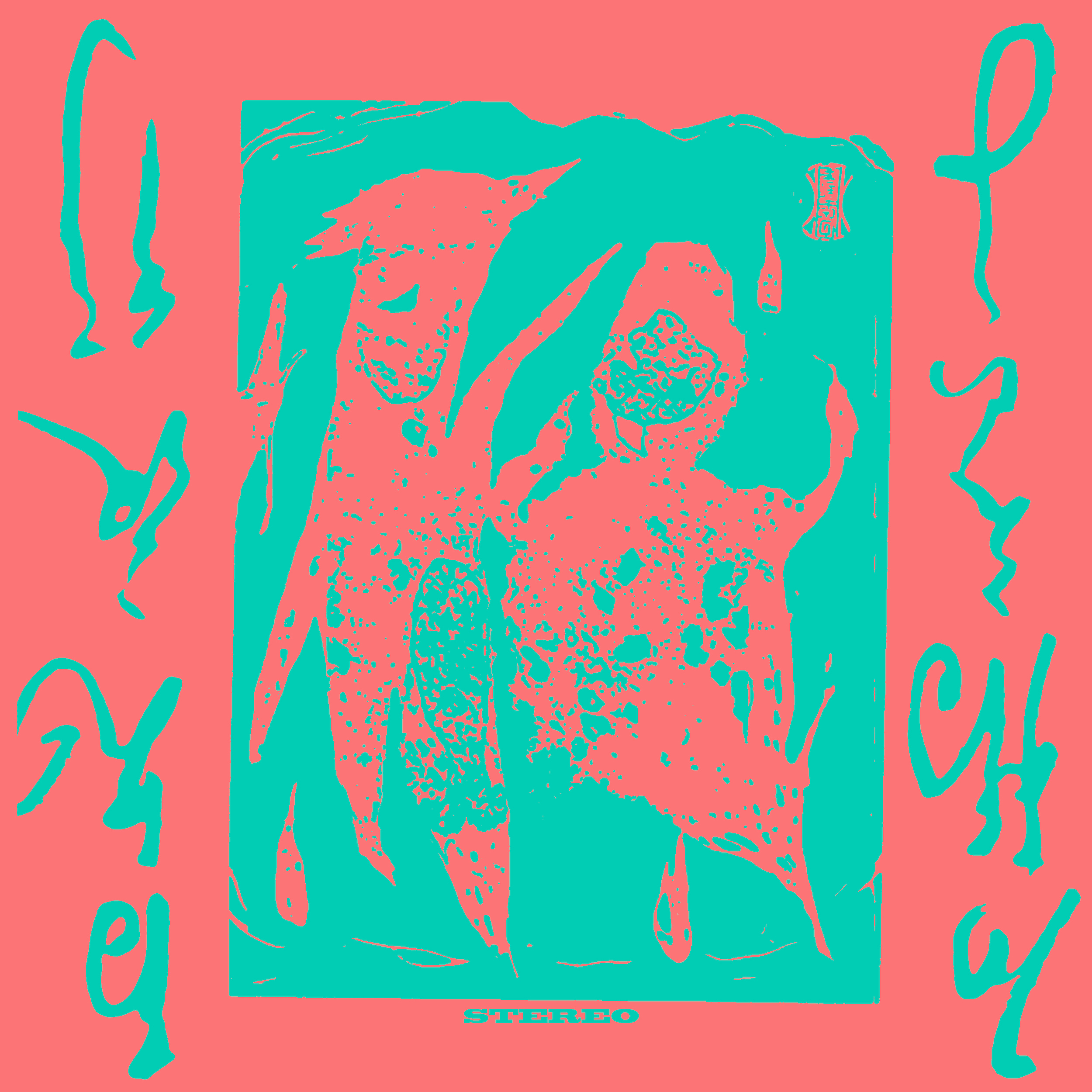
Eiko Ishibashi
Hyakki Yagyō
Label: Black Truffle
Format: LP
Catalogue Number: BT064
Official web site: blacktruffle.bandcamp.com/album/hyakki-yagy
Description
Black Truffle is pleased to announce a new solo album by Eiko Ishibashi, her first for the label, following on from the duo recording Ichida alongside bassist Darin Gray. Hyakki Yagyō (Night Parade of One Hundred Demons) was produced for the ‘Japan Supernatural’ exhibition at The Art Gallery of New South Wales, Sydney focusing on ghost stories and folklore from the Edo period onwards. As with The Dream My Bones Dream (Drag City, 2018), the album is a response to troubling questions about Japanese history, and the influence of the past upon the present, but finds Ishibashi shifting further away from her earlier piano-led songwriting and showing a deepening interest in electronics and audio collaging.
The two sidelong parts of Hyakki Yagyō feature layered synthesisers, acoustic instrumentation, recited verse and field recordings, at times densely mixed but always with a subtle interplay of changing elements. The influence of European and American forerunners as diverse as Alvin Curran, David Behrman and Strafe Für Rebellion can be traced, yet at the same time Ishibashi evokes the flute and string sounds associated with Japanese storytelling, and draws directly on the subversive literary tradition of Kyoka (‘mad poetry’) with a verse by the 15th-century poet Ikkyū Sōjun repeated throughout the album. Revisiting what has gone before, re-thinking what is possible musically, as a way of articulating what else might be possible in the future.
As Ishibashi’s liner notes make clear, the album reflects an attention to persistent dangers, myths and evasions in Japanese culture – as well as the lurking uncertainties that might threaten positive change. This would seem to be manifested in the emerging melodies soon met by dissonance, erratic collisions and near silence, as well as the eerie manipulation of the double-tracked vocals. Ishibashi’s underlying concerns ring true more widely of course. Hyakki Yagyō is a work of multiplicities, and mystery, a landscape where nothing is as it seems at first, and everything is vulnerable to sudden violent interruptions.
The album was produced with regular collaborators Jim O’Rourke (double bass) and Joe Talia (percussion), and features dancer and choreographer Ryuichi Fujimura performing Ikkyū’s satirical tanka. O’Rourke’s immersive mix creates a three-dimensional effect, with Ishibashi’s various sound sources enmeshing and interacting in captivating ways.
Pressed on coloured vinyl and presented in a deluxe package with an inner sleeve featuring an artist portrait and liner notes from Eiko Ishibashi.
Cover and label design by Shuhei Abe.
Back cover design by Lasse Marhaug.
Mixed and mastered by Jim O’Rourke.
Black Truffle is pleased to announce a new solo album by Eiko Ishibashi, her first for the label, following on from the duo recording Ichida alongside bassist Darin Gray. Hyakki Yagyō (Night Parade of One Hundred Demons) was produced for the ‘Japan Supernatural’ exhibition at The Art Gallery of New South Wales, Sydney focusing on ...
read more…
Tracklisting
- Hyakki Yagyō Part 1
- Hyakki Yagyō Part 2
Available from these fine distributors:
- USA – Forced Exposure www.forcedexposure.com
- Europe – Kompakt www.kompakt.fm/labels/black_truffle
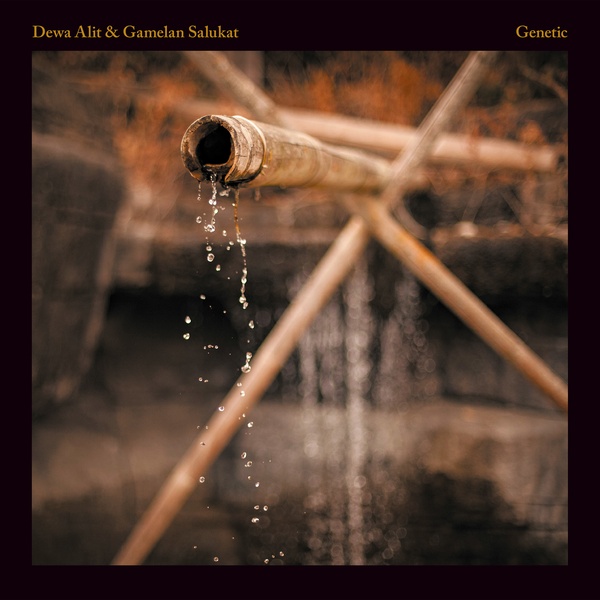
Dewa Alit & Gamelan Salukat
Genetic
Label: Black Truffle
Format: LP
Catalogue Number: BT063
Official web site: blacktruffle.bandcamp.com/album/genetic
Description
Black Truffle announce Genetic, the first release outside Indonesia from contemporary Balinese composer Dewa Alit and his Gamelan Salukat. Alit is a major force in contemporary Indonesian music, presenting his work extensively throughout Asia, Europe and North America and collaborating with renowned ensembles such as Bang On A Can and Ensemble Modern. Involved in the composition and performance of works for Gamelan ensemble since he was a teenager, in 2007 he founded Gamelan Salukat, a 25 member ensemble that perform on instruments specially built to Alit’s designs, using a unique 11-note scale.
The single composition that unfurls over the two sides of Genetic is an enchanting introduction to Alit’s magical sound world. Beginning with a stately procession of isolated, hanging chords sounded on the ensemble’s uniquely-tuned metallophones, the piece abruptly launches into a stunning passage of rhythmically complex call-and-response motifs, making striking use of abruptly muted chords – one of many moments where the acoustic ensemble sounds uncannily electronic. The piece continues to alternate between spare investigations of resounding tones and sometimes frenetic ensemble interplay using unorthodox techniques, including a stunning moment around half-way when the entire Gamelan seems to transform itself into a single, gigantic zither. Later in the piece, drums and wind instruments enter, and the metallophones begin to play virtuosic, rapid-fire passages of fragmented scalar melody.
As Alit explains in his liner notes, the music of Gamelan Salukat is grounded in the tradition of Balinese Gamelan; however, he approaches this tradition not as something static, but as a set of concepts and principles that can be used to create something radically new. For many listeners, Genetic will inhabit precisely this space between the familiar and the invigoratingly unheard, as it takes the stop-start dynamics, unison melodies, and much of the instrumentation familiar from traditional Balinese Gamelan and puts them in the service of rhythmic, harmonic, and timbral experimentation, crafting a work possessed by at once by mysterious grandeur and a joyous volatility.
Features liner notes from the composer with cover design and photos from Lasse Marhaug. Mastered and cut at 45rpm for maximum fidelity by Kassian Troyer and D&M, Berlin.
Black Truffle announce Genetic, the first release outside Indonesia from contemporary Balinese composer Dewa Alit and his Gamelan Salukat. Alit is a major force in contemporary Indonesian music, presenting his work extensively throughout Asia, Europe and North America and collaborating with renowned ensembles such as Bang On A Can and Ensemble Modern. Involved in the composition ...
read more…
Tracklisting
- Genetic (Part 1)
- Genetic (Part 2)
Available from these fine distributors:
- USA – Forced Exposure www.forcedexposure.com
- Europe – Kompakt www.kompakt.fm/labels/black_truffle
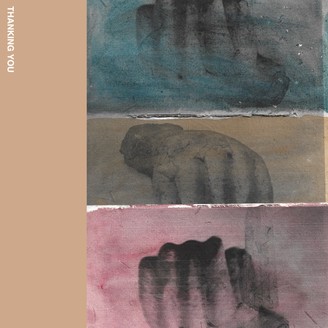
Various Artists
THANKING YOU
Label: Black Truffle / Mould Museum
Format: Digital
Catalogue Number: BT062
Official web site: blacktruffle.bandcamp.com/album/thanking-you
Description
Black Truffle and Mould Museum are pleased to announce the release of Thanking You. Compiled by Francis Plagne, Thanking You is a portrait of a network of friends and collaborators, offering up nine unreleased tracks over a running time of almost seventy minutes. Though the tracks presented here are either solo or duo affairs, many of these artists have worked together in other contexts; multiple threads of shared sensibility run through these pieces.
Opening with a lo-fi tape collage work centred on gamelan, environmental sound and drifting electronic tones from Oren Ambarchi and Will Guthrie, we are then presented with an epic fifteen minute piece for church organ by James Rushford, moving from wavering, uneasy chords to a wheezing hymnal conclusion. Rohan Drape contributes an austere yet characteristically affecting piece for microtonal electronics and piano, while Delphine Dora scatters keyboard fragments according to the inscrutable logic of chance. Closing the first side, Alex Macfarlane’s unique take on song takes unexpected turns, coming across like a bedroom tribute to Jade Warrior.
On the second side, Andrew Chalk and Daisuke Suzuki’s ‘Natsukodachi’ (meaning ‘summer trees’) layers electric guitar and field recordings of buzzing insects to conjure up a dream of summer afternoon heat. Tim Coster’s layers of synth and keyboard tones (sourced from the work of a certain well-known French composer) and rustling domestic sounds (sourced from the work of a certain well-known French film director) gently drift along side by side, interacting in surprising ways. Joe Talia offers up a dynamic slice of synth and tape, a rougher, more gritty complement to the sparkling electroacoustic expanse of 2018’s Tint. Finally, Julia Reidy’s surging closer yokes together guitar, raw electronics and room sounds into a lurching, staggering assemblage that eventually makes way for gently chiming tones.
Cassette edition available from Mould Museum.
Black Truffle and Mould Museum are pleased to announce the release of Thanking You. Compiled by Francis Plagne, Thanking You is a portrait of a network of friends and collaborators, offering up nine unreleased tracks over a running time of almost seventy minutes. Though the tracks presented here are either solo or duo affairs, many ...
read more…
Tracklisting
- Oren Ambarchi & Will Guthrie – Son-In-Law Eggs
- James Rushford – Clerestory
- Rohan Drape – Through the broken light of day
- Delphine Dora – quelque chose de hasardeux
- Alex Macfarlane – Burden of Boundary
- Andrew Chalk & Daisuke Suzuki – Natsukodachi
- Tim Coster – Chant du midi (2017 demo)
- Joe Talia – Ome Kaido Deep
- Julia Reidy – shifting
Available from these fine distributors:
- Europe – Kompakt www.kompakt.fm/labels/black_truffle
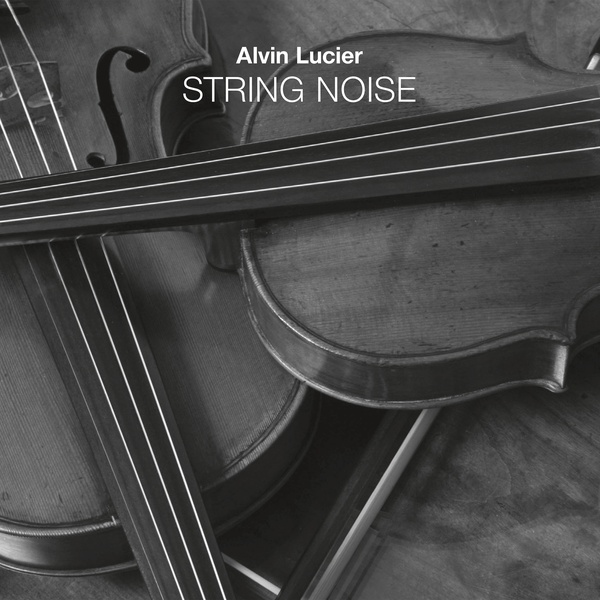
Alvin Lucier
String Noise
Label: Black Truffle
Format: 2CD
Catalogue Number: BT061
Official web site: blacktruffle.bandcamp.com/album/string-noise
Description
Continuing Black Truffle’s series of releases documenting the recent work of legendary American experimental composer Alvin Lucier, String Noise presents three major works for violin solo and duo composed between 2004 and 2019. Lucier has developed his compositions in close collaboration with many instrumentalists over the years; the three works presented here are performed by the violinists for whom they were originally written, Conrad Harris and Pauline Kim Harris, who together make up the innovative violin duo String Noise, and have premiered works by a plethora of major figures in contemporary music.
The long-form compositions presented here continue Lucier’s life-long exploration of acoustic phenomena, drawing on aspects of some of his most well-known compositions and extending them into new instrumentation. Tapper (2004) extends the experiments with echolocation – gathering information about an environment by listening to the echoes of sounds produced within it – that Lucier began with his classic 1969 work Vespers, where performers explore a space equipped with hand-held pulse oscillators. Here, the same principle is put into practice for solo violin, the body of which the performer taps repeatedly with the butt end of the bow while moving around the performance space. The result is a subtly shifting web of echoes and resonances produced by the reflection of the sharp tap off the surfaces of the room (in this case, the Drawing Center in New York).
In Love Song (2016), two violinists are connected by a long wire stretched between the bridges of their instruments, causing the sounds played on one violin to also be heard through the other. As the two violinists play long tones using only the open E string, they move in a circular motion around the performance space, thus changing the tension of the wire, which creates a remarkable array of variations in pitch and timbre ranging from ghostly wavering pitches reminiscent of a singing saw to near-electronic tones.
In Halo (2019), one or more violinists walk slowly through the performance space in a zig-zag pattern while sustaining long tones. As in Tapper, the consistent sound production reveals the sonic properties of the environment. As the title of the piece suggests, the outcome is a shimmering halo of sound produced by the reflection of the violin’s extended tones off the walls and ceiling of the performance space (in this case, Alvin’s home).
2CD release presented in a deluxe 4-panel digipak with liner notes by Alvin Lucier, live images and artist bios. Sleeve design by Lasse Marhaug. Mastered by Tom Hamilton.
Continuing Black Truffle’s series of releases documenting the recent work of legendary American experimental composer Alvin Lucier, String Noise presents three major works for violin solo and duo composed between 2004 and 2019. Lucier has developed his compositions in close collaboration with many instrumentalists over the years; the three works presented here are performed by ...
read more…
Tracklisting
- Tapper
- Love Song
- Halo
Available from these fine distributors:
- USA – Forced Exposure www.forcedexposure.com
- Europe – Kompakt www.kompakt.fm/labels/black_truffle
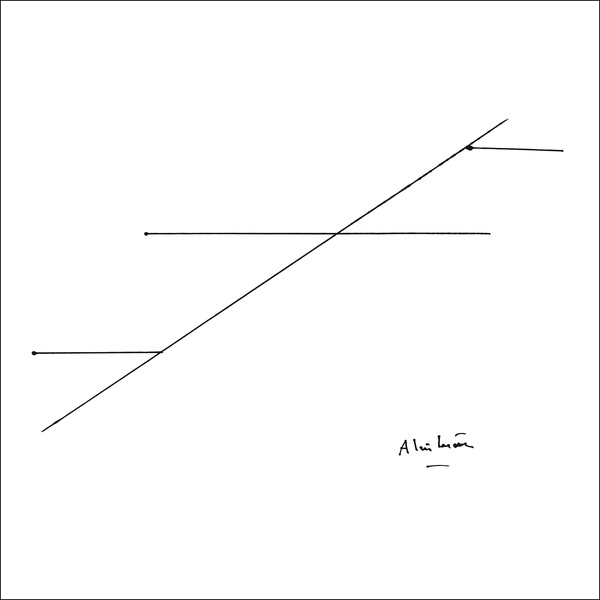
Alvin Lucier
Works for the Ever Present Orchestra
Label: Black Truffle
Format: 2LP + 2CD
Catalogue Number: BT060
Official web site: blacktruffle.bandcamp.com/album/works-for-the-ever-present-orchestra
Description
Black Truffle’s documentation of the prolific recent work of legendary American composer Alvin Lucier continues with Works for the Ever Present Orchestra. This is a very special release for the composer, as it presents pieces written for the thirteen-member Ever Present Orchestra, formed in 2016 exclusively to perform Lucier’s works. At the heart of the ensemble are four electric guitars, an instrument Lucier began composing for in 2013 with Criss-Cross (recorded by two core members of the Ever Present Orchestra, Oren Ambarchi and Stephen O’Malley, for whom it was composed, on Black Truffle 033). Through the use of e-bows, the guitars take on a role akin to the slow sweep pure wave oscillators heard in many of Lucier’s works since the early 1980s, but with added harmonic richness. Like much of Lucier’s instrumental music, the pieces recorded here focus on acoustic phenomena, especially beating patterns, produced by the interference between closely tuned pitches.
The work presented here is some of the richest and most inviting that Lucier has composed. Though all of the pieces clearly belong to the same continuing exploration of the behaviour of sound in physical space and make use of related compositional devices, each takes on a strikingly different character. Titled Arc, for the full ensemble of four guitars, four saxophones, four violins, piano and bowed glockenspiel inhabits a world of sliding, uneasy tones, punctuated by a single piano note. Where Double Helix, for four guitars, rests on a pillow of warm, low hum, EPO-5, for two guitars, saxophone, violin, and glockenspiel possess a limpid, crystalline quality. Accompanying the four new compositions are two adaptations of existing pieces for radically different instrumentation, demonstrating Lucier’s excitement about the new possibilities suggested by this dedicated ensemble. Works for the Ever Present Orchestra is an essential document of the current state of Lucier’s continuing exploration, as well as offering a seductive entry-point for anyone who might yet be unacquainted with his singular body of work.
Vinyl version is presented in a deluxe gatefold sleeve with cover artwork and liner notes from Alvin Lucier. Includes a download code featuring hi-res vesions of the LP material. The download code also includes the bonus Adaptions for the Ever Present Orchestra featuring two pieces (“Two Circles” and “Braid”) that are not included on the LP version.
2CD version is presented in a deluxe 4-panel digipak with cover artwork and liner notes from Alvin Lucier plus a 16-page booklet with live photos. Disc 2 of this release includes the bonus Adaptions for the Ever Present Orchestra featuring two pieces (“Two Circles” and “Braid”) that are not included on the vinyl version.
Mastered by Rashad Becker. Design by Lasse Marhaug.
Black Truffle’s documentation of the prolific recent work of legendary American composer Alvin Lucier continues with Works for the Ever Present Orchestra. This is a very special release for the composer, as it presents pieces written for the thirteen-member Ever Present Orchestra, formed in 2016 exclusively to perform Lucier’s works. At the heart of the ...
read more…
Tracklisting
- Tilted Arc
- Double Helix
- EPO-5
- Semicircle
- Two Circles
- Braid
Available from these fine distributors:
- USA – Forced Exposure www.forcedexposure.com
- Europe – Kompakt www.kompakt.fm/labels/black_truffle
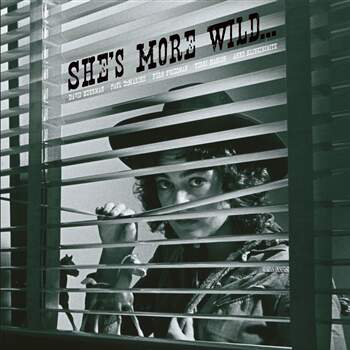
David Behrman, Paul DeMarinis, Fern Friedman, Terri Hanlon & Anne Klingensmith
She’s More Wild…
Label: Black Truffle
Format: LP
Catalogue Number: BT059
Official web site: blacktruffle.bandcamp.com/album/shes-more-wild
Description
Black Truffle are honoured to announce the release of She’s More Wild, a collaborative project by David Behrman, Paul DeMarinis, Fern Friedman, Terri Hanlon and Anne Klingensmith recorded at Mills College in 1981. Previously known only to cognoscenti through an obscure self-released three-track 7”, this is the first publication of the complete album, an outrageous confection that mixes art-song and theatrical monologue with live electronics. Starting life as a performance art piece described by the artists as ‘Western Performance Noir’, the record centres on a series of texts written by Friedman and Hanlon in which female narrators comically embody a series of iconic roles (The Recording Artist, The Former Movie Star, and The Rancher). Other lyrical themes include recurring references to the notorious cannibal pioneers, the Donner Party, an ironic take on Japanophilia, and the luscious “Archetypal Unitized Seminar,” a satirical poke at self-help culture, whose lyrics are rendered in Indian raga style to the accompaniment of electronic glissandi and toy noisemakers.
Delivered by Friedman, Hanlon, Klingensmith and special guest Maggi Payne in forms ranging from spoken monologue to Country & Western waltz, the texts are accompanied by instrumental and electronic contributions by Behrman and DeMarinis. Musically, She’s More Wild is truly unique, demonstrating these two pioneers of live-electronic performance adapting their signature processes to something approaching a ‘pop’ format: we hear the gliding, frequency-sensitive electronics familiar from Behrman’s classic On the Other Ocean and the mutant hacked Speak n’ Spell heard on DeMarinis’ Songs Without Throats propelled by drum machines and twisted into song forms. Perhaps comparable only to the David Rosenboom and Jacqueline Humbert’s contemporaneous Daytime Viewing in its interweaving of performance art tactics, high-tech electronics and pop sensibilities, She’s More Wild is an essential document, both immediately gratifying and ultimately thought provoking.
Presented in a deluxe gatefold sleeve with various texts and archival images.
Sleeve design by Lasse Marhaug.
Mastered and cut by Kassian Troyer at D&M, Berlin.
Black Truffle are honoured to announce the release of She’s More Wild, a collaborative project by David Behrman, Paul DeMarinis, Fern Friedman, Terri Hanlon and Anne Klingensmith recorded at Mills College in 1981. Previously known only to cognoscenti through an obscure self-released three-track 7”, this is the first publication of the complete album, an outrageous ...
read more…
Tracklisting
- ¿Dónde Está the Donner Party?
- How Many Contracts do I Have, Linda?
- Cannibal Cowgirl
- How Many Fur Coats do I Have, Edith?
- Archetypal Unitized Seminar
- Gold Rush Epilogue
- How Many Head o’ Cattle Do I Have, Sally?
- I Feel Like a Martian
- Japanese Disease
- I’m Hungry
- You Pay Rent on your Brain
Available from these fine distributors:
- USA – Forced Exposure www.forcedexposure.com
- Europe – Kompakt www.kompakt.fm/labels/black_truffle
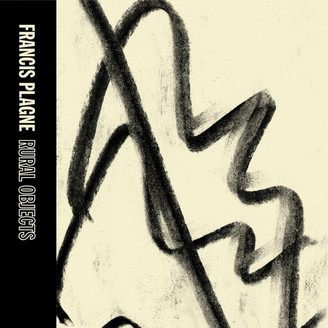
Francis Plagne
Rural Objects
Label: Black Truffle
Format: Digital
Catalogue Number: BT058
Official web site: blacktruffle.bandcamp.com/album/rural-objects
Description
Black Truffle announce the digital release of Francis Plagne’s Rural Objects, following on from last year’s collaborative LP with crys cole, Two Words, and his warmly received solo record on Penultimate Press, Moss Trumpet.
Recorded in the quiet confines of Plagne’s suburban studio on 8-track cassette, Rural Objects presents twelve short instrumental tracks – ranging in length from less than one minute to just over five – layering guitars, fretless bass, organ, keyboards, flute, ocarina, hand percussion, drum machine, zither and rubber bands (with a guest appearance from long-time friend and collaborator Joe Talia on drums on one piece). Titled after a poem by John Ashbery, Rural Objects wanders unpredictably from form to formlessness and from melody to abstraction, all enveloped in warm glow of tape hiss. Bubbling and calm, Plagne’s work summons a sense of the possibility of unhurried solo exploration, inviting the listener into a lushly idiosyncratic sound-world that touches on amateur prog, early Weather Report, Dominique Lawarlée, and Deux Filles.
Recorded at home on cassette, 2018-2019.
Drums on V by Joe Talia.
Mastered by Mikey Young.
Lay-out/design by Julian Hocking.
Cassette version available through Hobbies Galore.
Black Truffle announce the digital release of Francis Plagne’s Rural Objects, following on from last year’s collaborative LP with crys cole, Two Words, and his warmly received solo record on Penultimate Press, Moss Trumpet. Recorded in the quiet confines of Plagne’s suburban studio on 8-track cassette, Rural Objects presents twelve short instrumental tracks – ranging in length ...
read more…
Tracklisting
- I
- II
- III
- IV
- V
- VI
- VII
- VIII
- IX
- X
- XI
- XII
Available from these fine distributors:
- Europe – Kompakt www.kompakt.fm/labels/black_truffle
- UK – Boomkat www.boomkat.com
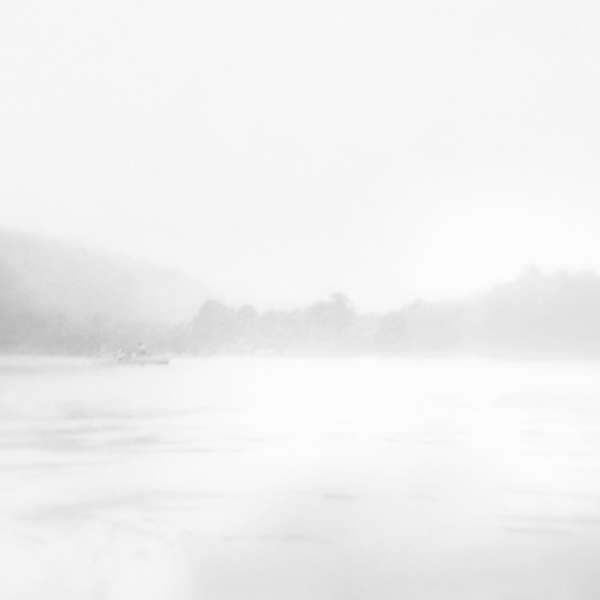
Will Guthrie
Nist-Nah
Label: Black Truffle
Format: LP & CD
Catalogue Number: BT057
Official web site: willguthrie.bandcamp.com/album/nist-nah
Description
Nantes-based Australian drummer and percussionist Will Guthrie returns to Black Truffle with Nist-Nah. Like his previous solo record on the label, the abrasive hip-hop concrète of People Pleaser (BT027), Nist-Nah finds Guthrie branching out in a new direction, this time in a suite of six percussion pieces primarily using the metallaphones, hand drums and gongs of the Gamelan ensembles of Indonesia. The music presented here is grounded in Guthrie’s travels in Indonesia and study of various forms of Gamelan music, from the stately suspended temporality of the courtly Javanese Gamelan Sekatan, to the delirious, thuggish repetition that accompanies the Javanese trance ritual Jathilan, to the shimmering acoustic glitch of contemporary Balinese composer Dewa Alit and his Gamelan Salukat.
However, far from an exercise in exoticism, Nist-Nah develops out of Guthrie’s extensive work with metal
percussion in recent years (as heard, for example, on his 2015 LP for iDEAL, Sacrée Obsession), where gongs, singing bowls and cymbals are used to build up walls of hovering tones and sizzling details. Though Guthrie is broadening his palette to explore Gamelan instrumentation and pay tribute to his love of this sophisticated yet elemental percussion music, the pieces presented here are equally informed by Guthrie’s interests in free jazz, electro-acoustic music and diverse experimental music practices, exploring long tones, extended techniques, and non-metered pulse.
Nist-Nah presents a variety of approaches across its six pieces, from the crisp, precise rhythmic complexity of the opening title track to the droning textures of ‘Catlike’ and ‘Elders’. On the epic closing ‘Kebogiro Glendeng’, Guthrie offers an extended, layered rendition of a Javanese piece belonging to a repertoire primarily used for warmups, beginner’s groups and children first learning Gamelan, elegantly gesturing to his own amateur status while using the piece’s insistently repeated melody as an extended exploration of the hypnotic effects of repetition, falling in and out of time with himself to create woozy, narcotic effects until the piece eventually dissolves into a wavering fog.
Recorded in 2019 by Lucas Pizzini. Mixed and mastered by Joe Talia at Good Mixture, Tokyo. Cut by Kassian Troyer at D&M, Berlin. Images by Sylvie Meunier.
Nantes-based Australian drummer and percussionist Will Guthrie returns to Black Truffle with Nist-Nah. Like his previous solo record on the label, the abrasive hip-hop concrète of People Pleaser (BT027), Nist-Nah finds Guthrie branching out in a new direction, this time in a suite of six percussion pieces primarily using the metallaphones, hand drums and gongs ...
read more…
Tracklisting
- Nist-Nah
- Catlike
- Lit 1+2
- Elders
- Moy Moy
- Kebogiro Glendeng
Available from these fine distributors:
- USA – Forced Exposure www.forcedexposure.com
- Europe – Kompakt www.kompakt.fm/labels/black_truffle
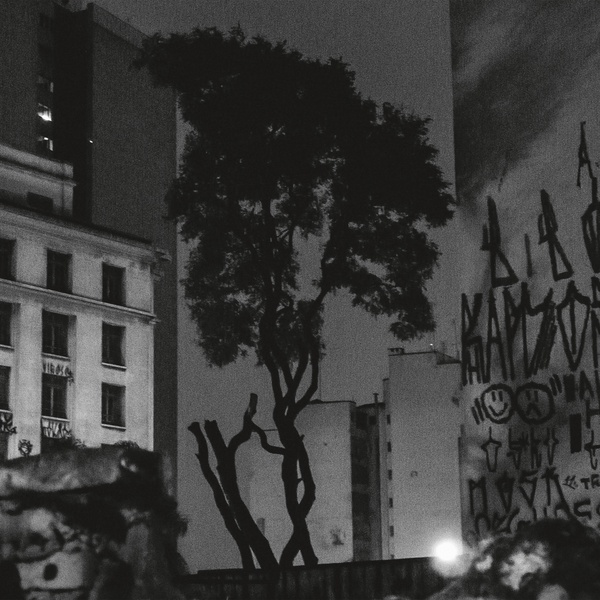
Manuel Pessoa de Lima
Realejo
Label: Black Truffle
Format: LP
Catalogue Number: BT056
Official web site: blacktruffle.bandcamp.com/album/realejo
Description
Black Truffle is pleased to present Realejo, the first vinyl release from Brazilian sound artist and composer
Manuel Pessoa de Lima. Having composed works for diverse contexts including cinema, contemporary dance, theatre and television, Lima’s live appearances often take the form of self-reflexive lecture performances that combine electro-acoustic sound, red light, video and spoken text, moving unpredictably from the hilarious to the distressing.
Realejo consists of two side-long pieces of highly idiosyncratic electro-acoustic collage, beginning with recordings Lima made of himself playing the organ in the Schloss Solitude Chapel in Stuttgart. Exploring the peculiarities of the instrument’s mechanics, Lima made hours of recordings with the organ stops half-way open, moving from haunting gliding tones to oddly tuned fair-ground melodies reminiscent of the record’s namesake realejo, a hand-cranked organ traditionally found in Brazil as the musical accompaniment to the work of fortune-telling parrots.
To these organ sounds, Lima added recordings of a security guard made in São Paulo: ‘Just before coming to Stuttgart, I started making field recordings of a security guard in São Paulo. It’s something pretty common in residential areas: they sit in a chair with a whistle, and use that to signal when people arrive, leave or pass by in the street. This particular security guard, Miguel Viana, works on the same street my parents live, and where I had my childhood, and he has worked there since I was a small child. He has watched the street at night, from 8PM to 6AM, every single day, except Sundays, for over 30 years’.
The poignant sounds of the security guard’s whistles punctuate Lima’s electro-acoustic environment, which also includes raw digital synthesis, recordings of his friends’ infant child, audio lifted from Youtube, and, on the LP’s second side, elements taken from an earlier work, ‘36 English to Portuguese Lessons’.
Finely chiselled from dozens of hours of source material into a detail-rich, mercurial structure, Realejo is alternately jarring and seductive, introducing listeners to a young composer with a powerfully individual voice.
Pipe Organ, Electronics, Voice: Manuel Pessoa de Lima
Whistling: Miguel José Viana
Baby: Hanako
Mixing: Joe Talia
Vinyl cut: Kassian Troyer at D&M, Berlin
Photos: Zeca Abdalla Design: Lasse Marhaug
Black Truffle is pleased to present Realejo, the first vinyl release from Brazilian sound artist and composer Manuel Pessoa de Lima. Having composed works for diverse contexts including cinema, contemporary dance, theatre and television, Lima’s live appearances often take the form of self-reflexive lecture performances that combine electro-acoustic sound, red light, video and spoken text, ...
read more…
Tracklisting
- Realejo
- Presenting Yourself
Available from these fine distributors:
- USA – Forced Exposure www.forcedexposure.com
- Europe – Kompakt www.kompakt.fm/labels/black_truffle
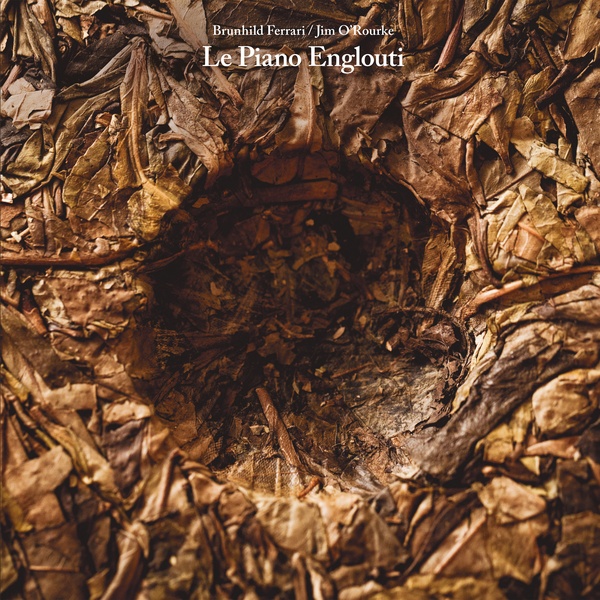
Brunhild Ferrari and Jim O’Rourke
Le Piano Englouti
Label: Black Truffle
Format: LP
Catalogue Number: BT055
Official web site: blacktruffle.bandcamp.com/album/le-piano-englouti
Description
Black Truffle announce the release of Le Piano Englouti (The Sunken Piano), the first collaboration between Brunhild Ferrari and Jim O’Rourke, offering up two side-long realisations of Ferrari’s tape compositions recorded in concert at Tokyo’s SuperDeluxe in 2014, revised and mixed by O’Rourke in 2019.
The title piece weaves an immersive web of electronics, pre-recorded piano, and field-recorded sounds, including the raging Aegean sea, the tranquil atmospherics of a Japanese island, and the roar of a pachinko parlour. Far from a slice of audio vérité, these geographically distant sites intermingle in an unreal space where they often become indistinguishable. Shadowed by electronics and reverberant snatches of piano, the field recordings rise up and recede like ocean waves, creating a constantly shifting texture that is nonetheless warmly inviting. Chirping birds are confused with their electronic doubles; snatches of footsteps and voices are engulfed by ambience of unclear origin. Increasingly present throughout the piece, the piano rises up one last time before being swallowed up for good by the pachinko parlour.
Tranquilles Impatiences (Quiet Impatiences) takes as its source material the electronic sounds produced by Luc Ferrari for his 1977 Exercises d’Improvisation, seven tapes intended to be heard alongside instrumental improvisation. Brunhild Ferrari’s piece layers Luc Ferrari’s sounds into a dense new work that emphasises the insistently pulsing rhythms of the source material. In this realisation with O’Rourke, the piece becomes a monumental sound-object, a slowly shifting mass of skittering electronic tones, shimmering reverb, and growling bass from which field-recorded events occasionally arise. At times, the placement of these fragments of real life in a pulsing, insistent musical landscape calls up Luc Ferrari’s classic Petit Symphonie; at other points, the swarming electronics bring to mind O’Rourke’s Steamroom work or even the vast expanses of Roland Kayn.
Design by Lasse Marhaug.
Vinyl cut by Kassian Troyer at D&M, Berlin.
Black Truffle announce the release of Le Piano Englouti (The Sunken Piano), the first collaboration between Brunhild Ferrari and Jim O’Rourke, offering up two side-long realisations of Ferrari’s tape compositions recorded in concert at Tokyo’s SuperDeluxe in 2014, revised and mixed by O’Rourke in 2019. The title piece weaves an immersive web of electronics, pre-recorded ...
read more…
Tracklisting
- Le Piano Englouti
- Tranquilles Impatiences
Available from these fine distributors:
- USA – Forced Exposure www.forcedexposure.com
- Europe – Kompakt www.kompakt.fm/labels/black_truffle

Joe McPhee / Graham Lambkin / Charlie McPhee / Oliver Lambkin
Live in the Batcave
Label: Black Truffle
Format: LP
Catalogue Number: BT054
Official web site: www.grahamlambkin.com/
Description
Black Truffle invite you to an evening of drunken revelry in the Batcave! After a chance meeting at a local supermarket in Poughkeepsie, New York, Joe McPhee and Graham Lambkin have performed together as a duo extensively in recent years, in addition to their joint work excavating some of the wildest tapes from McPhee’s archive for Lambkin’s now defunct Kye label.
Live in the Batcave documents an evening the two friends spent together in the company of Joe’s brother Charlie and Lambkin’s son Oliver in November 2017 at Charlie’s house in Poughkeepsie. The LP captures seven increasingly drunken snapshots of the four shooting the breeze, playing flutes and whistles, drumming on anything at hand, and playing records. Edited together in Lambkin’s distinctive style of lo-fi domestic tape collage, the multiple simultaneous cassette recordings of the shenanigans abruptly cut in and out and fall out of sync, creating disorientating, woozy echoes. Mics are bumped, stories are told, drinks are poured, text messages arrive, and AACM-esque flute jams are interrupted by violent bursts of laughter and wet-mouthed sound poetry. All the while, classic soul records play, initially in the background, but coming increasingly to the fore until the record culminates in a strangely moving free-associative singalong.
Live in the Batcave is a truly unique document that exists somewhere between free jazz, audio verité, performance art, and everyday life. File next to your copy of Das Kümmerling Trio.
Presented in a gatefold sleeve with extensive photographic documentation and liner notes from Joe McPhee. Mastered and cut by Rashad Becker at Dubplates & Mastering, Berlin.
“Our music was born from the sounds of jazz, funk, soul, noise — sounds with no other reason so exist, except because they did, sounds which occurred like putting one step in front of the other to see if the way was clear to take the next step. The plan was, there is no plan, just start at the beginning, end at the end and party like it’s 1999” — Joe McPhee.
Black Truffle invite you to an evening of drunken revelry in the Batcave! After a chance meeting at a local supermarket in Poughkeepsie, New York, Joe McPhee and Graham Lambkin have performed together as a duo extensively in recent years, in addition to their joint work excavating some of the wildest tapes from McPhee’s archive ...
read more…
Tracklisting
- High Above The Batcave
- Charlie's Song
- Cable Flow
- I Don't Want To Be Right
- Eulogy To The Paddock
- I Stand Accused
- Jukebox (Underneath The Batcave)
Available from these fine distributors:
- USA – Forced Exposure www.forcedexposure.com
- Europe – Kompakt www.kompakt.fm/labels/black_truffle
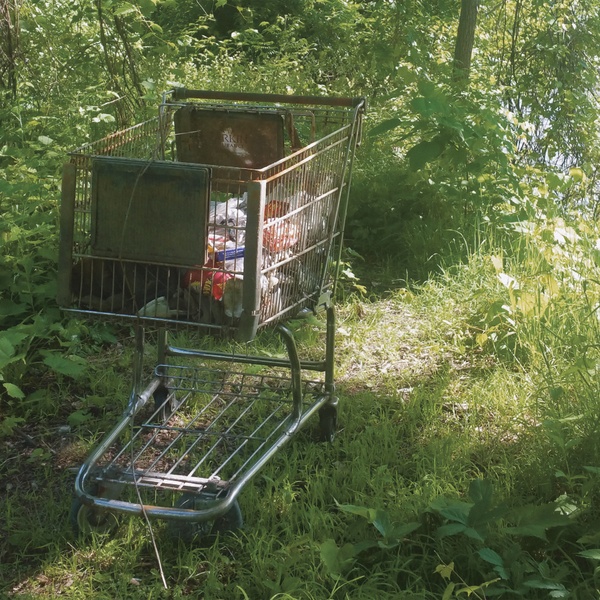
Sarah Hennies
Reservoir 1
Label: Black Truffle
Format: CD
Catalogue Number: BT053
Official web site: blacktruffle.bandcamp.com/album/reservoir-1
Description
Black Truffle present Reservoir 1: Preservation, a gorgeous piece by American composer/percussionist Sarah Hennies. Sarah’s work explores a variety of musical, sociopolitical, and psychological issues including queer and trans identity, love, intimacy, psychoacoustics, and percussion.
The Reservoirs are a series of three one-hour pieces based on the relationship between the conscious and unconscious human mind. Jung and Freud described the unconscious mind as a reservoir, a repository for memories that we don’t readily need access to, yet are kept forever somewhere in our minds. Specifically, Freud believed that one function of the unconscious mind is to store traumatic memories, filed away so that we don’t have to confront them every day. The conscious mind has no direct access to the unconscious, yet the unconscious is a constant yet mysterious presence in our lives.
Reservoir 1: Preservation is scored for piano and three percussionists, performed by Phillip Bush and Meridian, the long-running experiment in percussion, improvisation, and interpersonal relationships that includes Tim Feeney, Sarah Hennies, and Greg Stuart. In Preservation the piano functions as a constant, pervasive, but almost subliminal murmur amid the percussion playing that cycles through a variety of timbral and gestural areas, including gentle droning, frenetic scraping, and bricks violently dropped into metal buckets. The percussion group never interacts with or responds to the piano, while the piano subtly absorbs aspects of the trio.
Preservation was recorded, mixed, and mastered by Jeff Francis at the University of South Carolina and performed by Meridian: Tim Feeney, Sarah Hennies, Greg Stuart (percussion), and Phillip Bush (piano). CD digipak with design by Lasse Marhaug; Cover photo from Abby Grace Drake‘s photo series, Shopping Carts of Southside Ithaca.
Black Truffle present Reservoir 1: Preservation, a gorgeous piece by American composer/percussionist Sarah Hennies. Sarah’s work explores a variety of musical, sociopolitical, and psychological issues including queer and trans identity, love, intimacy, psychoacoustics, and percussion. The Reservoirs are a series of three one-hour pieces based on the relationship between the conscious and unconscious human mind. ...
read more…
Tracklisting
- Preservation
Available from these fine distributors:
- USA – Forced Exposure www.forcedexposure.com
- Europe – Kompakt www.kompakt.fm/labels/black_truffle

Oren Ambarchi & Will Guthrie
Knotting
Label: Black Truffle
Format: Digital
Catalogue Number: BT052
Official web site: orenambarchi.bandcamp.com/album/knotting-2
Description
Since its debut on two releases from 2011 and 2012 (the live Hit & Run with Joe Talia and the studio Audience of One), the epic structured improvisational piece ‘Knots’ has formed a staple of Oren Ambarchi’s live performances. Like a jazz musician searching for ever-new ways to play a standard, the guitarist has repeatedly brought the piece to life in a variety of settings ranging from guitar/drums duets to a large ensemble replete with string section, with each iteration bringing with it new variations of tone, intensity and character.
Knotting presents the entirety of a beautifully-recorded set performed by Ambarchi and the astonishing Australian-French drum virtuoso Will Guthrie in Geneva in February 2019. Beginning with a delicately played but rapid and insistent ride cymbal rhythm over which Ambarchi layers his signature shimmering Leslie cabinet guitar tones and eventually building, as the piece always does, to a peak of caterwauling harmonic fuzz and thundering drums, the recording also shows the pair taking risks and pushing the piece into new directions, especially in Guthrie’s willingness to let the central pulse momentarily die away or only barely be implied as his main focus of attention turns to instantaneous responses to the subtle rhythmic suggestions of Ambarchi’s shuddering guitar tones. Ambarchi’s performance also demonstrates the ever-evolving nature of his relationship with the guitar, making space for some of the more harmonically uneasy yet subtly lyrical playing (in a tone calling to mind the 80s guitar-synth work of Pat Metheny or Bill Frisell) that has emerged in his recent solo work. Ending with a remarkable coda where Guthrie’s bells and cymbals suddenly transforms the performance into something like Tibetan temple music, Knotting is an essential snapshot of the work of two musicians not content to repeat themselves.
Recorded live at Cave12, Geneva, Feb 27, 2019 by Emma Souharce. Mixed at Good Mixture, Tokyo April 2019 by Joe Talia. Image by Marc Milohnic.
CD version available on the Some Fine Legacy label.
Since its debut on two releases from 2011 and 2012 (the live Hit & Run with Joe Talia and the studio Audience of One), the epic structured improvisational piece ‘Knots’ has formed a staple of Oren Ambarchi’s live performances. Like a jazz musician searching for ever-new ways to play a standard, the guitarist has repeatedly ...
read more…
Tracklisting
- Knotting
Available from these fine distributors:
- Europe – Kompakt www.kompakt.fm/labels/black_truffle
- UK – Boomkat www.boomkat.com
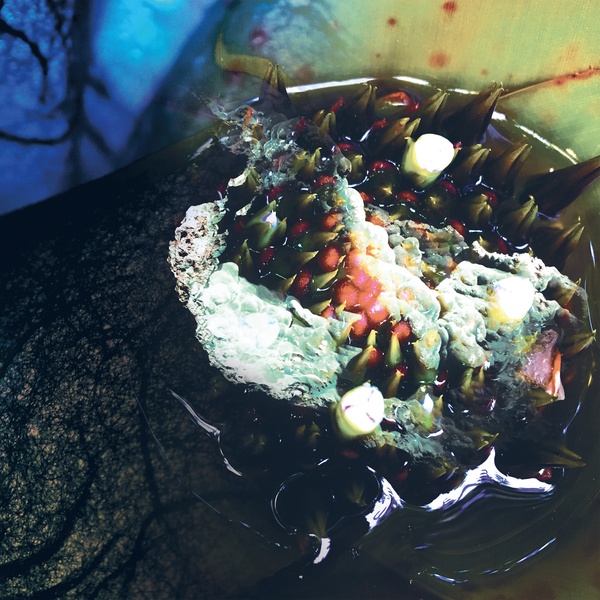
Julia Reidy
In Real Life
Label: Black Truffle
Format: LP
Catalogue Number: BT051
Official web site: blacktruffle.bandcamp.com/album/in-real-life
Description
Black Truffle present In Real Life, the latest in a flurry of releases from Berlin-based guitarist and composer Julia Reidy. Having drawn acclaim for solo performances on 12-string acoustic guitar that bridge microtonality, “American primitive” stylings, and classic minimalism, Reidy’s recent releases have utilized an increasingly broad sonic palette, fleshing out guitar-based composition with electronics, field recordings, and — most strikingly — heavily auto-tuned vocals.
On In Real Life, Reidy pushes one step further, crafting an epic LP-length suite that moves from abstracted song to lush electronics and explorations in contemporary musique concrete. Beginning with a passage of eerie electronics and creaking percussive interjections, Reidy’s heavily auto-tuned voice quickly takes center stage. Surrounded by explosions of electric guitar and synthesized arpeggios, the auto-tuned voice delivers a melancholic ode, bringing together poetic images to reflect on the instability of experience and mutability of identity in a contemporary world saturated by digital technology. This concern with the unsettled relationship between the physical and digital is reflected musically by the constantly shifts in emphasis between Reidy’s physically demanding guitar-picking and the various forms of synthesis deployed. Similarly, the dynamic imagery of cutting, shattering, and “racing streams” present in Reidy’s lyrics also serves to characterize the structure of In Real Life, which ceaselessly shifts between distinct episodes. The song-based opening, long sequences of frenetic 12-string guitar shadowed and eventually overtaken by synth tones, passages of delicate chiming harmonics, electro-acoustic cut-ups — each flows seamlessly into the next, often recurring throughout the record’s duration, which lingers over interstitial moments between these episodes.
Artwork by Suze Whaites; LP design by Lasse Marhaug. Mixed and mastered by Joe Talia at Good Mixture, Tokyo. *Vinyl cut by Rashad Becker at Dubplates & Mastering, Berlin.
*Please note, this LP was cut at 33rpm, not at 45rpm as stated on the labels. Soz!
Black Truffle present In Real Life, the latest in a flurry of releases from Berlin-based guitarist and composer Julia Reidy. Having drawn acclaim for solo performances on 12-string acoustic guitar that bridge microtonality, “American primitive” stylings, and classic minimalism, Reidy’s recent releases have utilized an increasingly broad sonic palette, fleshing out guitar-based composition with electronics, ...
read more…
Tracklisting
- Crystal Bones
- Adulare
Available from these fine distributors:
- USA – Forced Exposure www.forcedexposure.com
- Europe – Kompakt www.kompakt.fm/labels/black_truffle
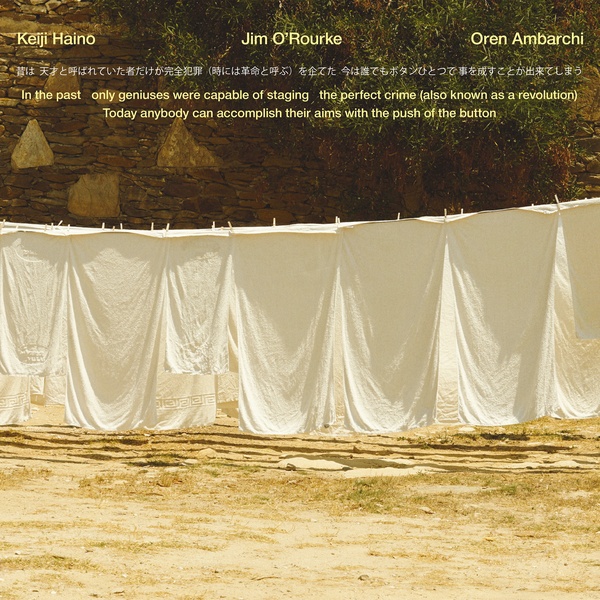
Keiji Haino / Jim O'Rourke / Oren Ambarchi
In the past only geniuses were capable of staging the perfect crime (also known as a revolution) Today anybody can accomplish their aims with the push of the button
Label: Black Truffle
Format: 2LP & CD
Catalogue Number: BT050
Description
For its 50th release, Black Truffle presents the ninth album from one of the label’s core ensembles, the power trio of Keiji Haino, Jim O’Rourke, and Oren Ambarchi. Drawn from a November 2015 performance at Tokyo’s now-defunct SuperDeluxe, the record’s opening piece drops us immediately into the maelstrom, abruptly cutting into an extended episode of Ambarchi’s pummeling drums, O’Rourke’s fuzzed-out six-string bass, and Haino’s roaring guitar and electronics. Eventually settling into a hypnotic bass and drum groove over which Haino unleashes some almost Ray Russell-eque skittering atonal screech, these opening 13 minutes act as a potent reminder of the trio’s power.
Alongside showcasing the steady development of a unique language for the guitar-bass-drums power trio, the group’s succession of releases over the last decade has demonstrated a constant experimentation with new instruments, which continues here with O’Rourke use of Hammond organ (played at the same time as his roaming, sometimes knotty basslines). On the album’s second piece, the organ plays a key role, furnishing a harmonically rich shimmer over O’Rourke’s angular six-string bass chords, Haino’s distant, chirping electronics and Ambarchi’s crisp cymbal work; arriving somewhere halfway between Albert Marcoeur and Terje Rypdal, this piece is undoubtedly a highlight in the trio’s catalog so far.
The second and third sides are slow-burning, multi-part epics that range from spacious reflection to furious tumult. Where the trio’s previous double-LP set — This Dazzling, Genuine “Difference” Now Where Shall It Go? (BT 030LP, 2017) — was primarily instrumental in focus, here you find Haino’s voice taking the spotlight on the expansive third side, intoning, wailing. and exhorting in Japanese and English over a backdrop that moves from hushed bass and organ atmospherics to rolling toms and cymbal crashes before arriving at an ecstatic finale of searing guitar, tumbling drums and reverb-saturated bass. The fourth side returns to the hypnotic grooves of the opening piece, fixing on a relentless riff and riding it into oblivion under Haino’s roaming psychedelic soloing and jagged chordal slashes.
Cover image by Traianos Pakioufakis; Live action pics by Ujin Matsuo. Mastered and cut by Rashad Becker at Dubplates & Mastering. LP design by Lasse Marhaug; gatefold sleeve.
For its 50th release, Black Truffle presents the ninth album from one of the label’s core ensembles, the power trio of Keiji Haino, Jim O’Rourke, and Oren Ambarchi. Drawn from a November 2015 performance at Tokyo’s now-defunct SuperDeluxe, the record’s opening piece drops us immediately into the maelstrom, abruptly cutting into an extended episode of ...
read more…
Tracklisting
- In the past only geniuses were capable of staging the perfect crime (also known as a revolution) Today anybody can accomplish their aims with the push of the button Part 1
- Decorously decorously decorously decorously decorously Decorously decorously decorously decorously decorously To make something beautiful and then to smash it decorously
- Head-on collision If it still has bones it shall move forward (which is different to progress)
- In the past only geniuses were capable of staging the perfect crime (also known as a revolution) Today anybody can accomplish their aims with the push of the button Part 2
- I always walk around with a “tranquil void” in my pocket one that I may pull out at any given moment
Available from these fine distributors:
- USA – Forced Exposure www.forcedexposure.com
- Europe – Kompakt www.kompakt.fm/labels/black_truffle
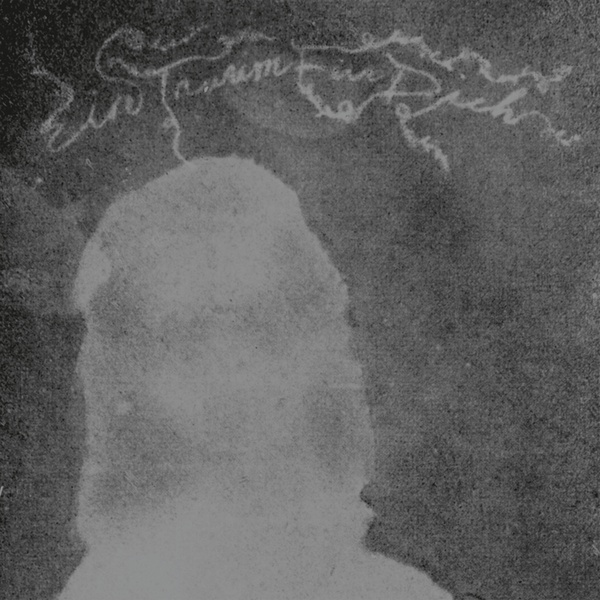
Kayo Makino & Tori Kudo
Ein Traum Für Dich
Label: Black Truffle
Format: LP
Catalogue Number: BT049
Official web site: blacktruffle.bandcamp.com/album/ein-traum-f-r-dich
Description
Black Truffle announce the release of this genuine head-scratcher, the first collaboration between DJ/mixtape-compiler Kayo Makino and underground legend Tori Kudo. Originally created to be played between acts at the launch of Eiko Ishibashi‘s acclaimed The Dreams My Bones Dream (2018) and then reworked and refined for LP release, the two side-long pieces are sonic environments constructed by Makino for Kudo’s piano to inhabit, or, as the LP’s credits suggest, a “cinéma pour l’oreille” in which Kudo’s piano plays the starring role.
Beginning with a soothing field recording of crickets dramatically punctuated by smashing glass, the first side finds Kudo playing his way repeatedly through one of Satie‘s 1897 Pièces froides. Best known to many listeners for his role as leader of the ecstatically shambolic rock unit Maher Shalal Hash Baz, Kudo’s performance of Satie’s whimsical yet haunting melody is alternately halting and fluid, delighting in the hesitations of unstudied technique and the subtle variations between repeated attempts. While the combination of Kudo’s piano and the background of crickets initially suggests a documentary approach to recording — as if the you are simply hearing incidental sounds creeping through an open window — things take an unexpected turn a few minutes in when Kudo’s piano is suddenly doubled. Layering two separate attempts at the same piece of top of each other, Makino’s unorthodox mixing blurs Satie’s original into a fog of stumbling echoes that becomes increasingly dreamlike as the chirping crickets are overtaken by pattering rain, German dialogue and traffic sounds.
The second side begins in a similarly inscrutable vein, with snatches of birds and film music providing a gentle backdrop for Kudo’s improvisational variations on a chord progression that, as his performance builds over its twenty-minute duration, somehow begins to suggest the sadly swaggering grandeur of Mick Taylor-era Rolling Stones. Makino accompanies and eventually overwhelms Kudo’s piano with a bizarre layer of digitally processed voice and drums, stretched out into a disorienting haze before suddenly retreating to leave Kudo’s piano accompanied only by a barking dog. Seemingly unrelated to anything else being produced in the world of contemporary music, this is a striking collaboration between two unique musical personalities that bridges the mundane and the surreal, opening up a dream-space both haunted and hospitable.
Cover design by Lasse Marhaug. Mastered by Jim O’Rourke at Steamroom, Japan. Vinyl cut by Rashed Becker at Dubplates & Mastering, Berlin.
Black Truffle announce the release of this genuine head-scratcher, the first collaboration between DJ/mixtape-compiler Kayo Makino and underground legend Tori Kudo. Originally created to be played between acts at the launch of Eiko Ishibashi‘s acclaimed The Dreams My Bones Dream (2018) and then reworked and refined for LP release, the two side-long pieces are sonic ...
read more…
Tracklisting
- PIANOISE "SATIE: PIÈCES FRPIDES, MOVEMENT 2: DANCES DE TRAVERS - NO. 1 EN Y REGARDANT À DEUX FOIS"
- PIANOISE "2018.12.1 OR LAST SUPER FLUX"
Available from these fine distributors:
- USA – Forced Exposure www.forcedexposure.com
- Europe – Kompakt www.kompakt.fm/labels/black_truffle
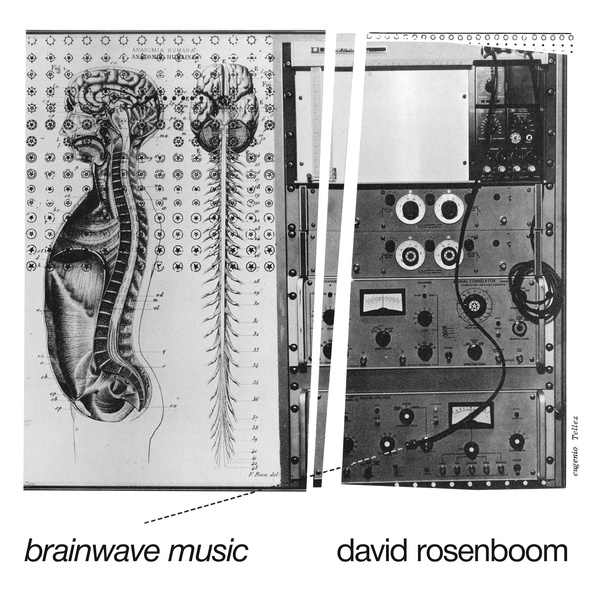
David Rosenboom
Brainwave Music
Label: Black Truffle
Format: 2LP
Catalogue Number: BT048
Official web site: blacktruffle.bandcamp.com/album/brainwave-music
Description
Black Truffle present the first ever vinyl reissue of David Rosenboom‘s legendary Brainwave Music, originally released on A.R.C. Records in 1975. This is an expanded double-LP edition with over 40 minutes of additional contemporaneous material.
Pioneer of live electronics, innovator in music education, collaborator with artists as diverse as Jon Hassell, Jacqueline Humbert, Terry Riley, and Anthony Braxton, Rosenboom is renowned for his ground-breaking experiments with the use of brain biofeedback to control live electronic systems. Each of the three pieces that make up the original Brainwave Music LP integrates biofeedback with musical technology in different ways. In the side-long “Portable Gold and Philosophers’ Stones”, four performers have electrodes and monitoring devices attached to their bodies to receive information about brainwaves, temperature, and galvanic skin response. This information is analyzed and fed into a complex set of frequency dividers and filters, manned by Rosenboom, but essentially played by each of the performers through their psychophysiological responses. The result is a slowly unfolding web of filtered electronic tones over a tanpura-esque fundamental, possessing the unhurried, stately grandeur of an electronic raga. In “Chilean Drought”, three different variations of a text about a drought in Chile, read by a different voice in a different style, are associated with the beta, alpha, and theta brainwave bands. Alongside an insistent piano accompaniment, three constantly shifting vocal recordings are controlled by the relative preponderance of each of the brainwave bands in the soloist. “Piano Etude I (Alpha)”, the earliest piece included here, is based on research into the link between alpha brain wave production and the execution of repetitive motor tasks. As Rosenboom plays a very rapid, incessantly repeated pattern in both hands, two filters controlled by monitoring his brainwaves process the piano sound, moving gradually higher in frequency as the average alpha amplitude increases.
For this reissue, the original LP is supplemented with an additional LP containing an unreleased 1977 live recording of Rosenboom’s “On Being Invisible”, in which the composer himself performs on an array of electronics that are fed information from his brainwaves. Stretching out over 40 minutes, the piece begins in similar territory to “Portable Gold and Philosophers’ Stones” but eventually becomes far wilder, building up to pointillistic bleeps and dense layers of electronic fizz that unexpectedly cut to near-silence. As Rosenboom explains, the piece creates a situation in which the “performer’s active imaginative listening became one of the ways to play their instrument, as well as an active agent in how self-organizing musical forms might emerge.”
Includes archival images and new notes from the composer.
Gatefold sleeve design by Lasse Marhaug.
Mastered by David Rosenboom from the original analog tape masters. Cut by Rashad Becker at Dubplates & Mastering, Berlin.
Black Truffle present the first ever vinyl reissue of David Rosenboom‘s legendary Brainwave Music, originally released on A.R.C. Records in 1975. This is an expanded double-LP edition with over 40 minutes of additional contemporaneous material. Pioneer of live electronics, innovator in music education, collaborator with artists as diverse as Jon Hassell, Jacqueline Humbert, Terry Riley, ...
read more…
Tracklisting
- Portable Gold and Philosophers' Stones (Music for Brains in Fours)
- Chilean Drought
- Piano Etude I (Alpha)
- On Being Invisible (Live at Western Front, Vancouver) Part 1
- On Being Invisible (Live at Western Front, Vancouver) Part 2
Available from these fine distributors:
- USA – Forced Exposure www.forcedexposure.com
- Europe – Kompakt www.kompakt.fm/labels/black_truffle
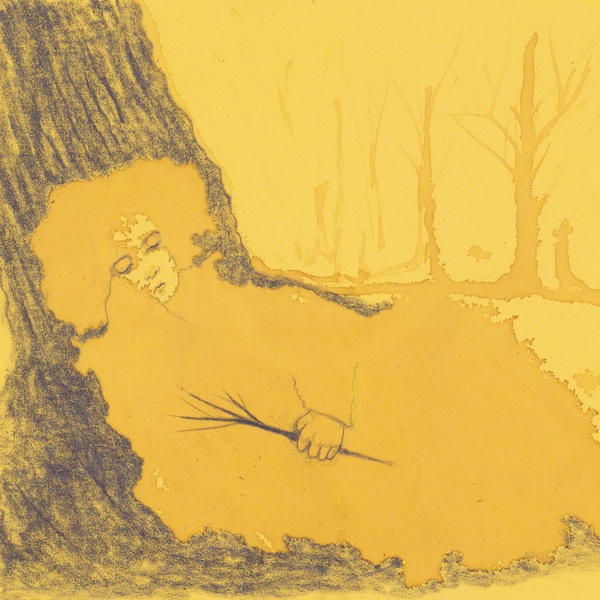
James Rushford
The Body’s Night
Label: Black Truffle
Format: LP
Catalogue Number: BT047
Official web site: blacktruffle.bandcamp.com/album/the-bodys-night
Description
Black Truffle announce the release of Australian composer-performer James Rushford‘s The Body’s Night. Known to many through his collaborative works with Oren Ambarchi, crys cole, Kassel Jaeger, Klaus Lang, Joe Talia, and many others, this LP is Rushford’s first solo release in a decade and the very first he has composed, performed, and recorded entirely alone.
Primarily recorded in Los Angeles in 2017, The Body’s Night is a single electro-acoustic suite stretching over thirty minutes, utilizing field recordings, flutes, ocarina, microphones, organ, percussion, piano, tape, analog synthesizers, viola, and voice. True to its title, the record immediately ushers into a nocturnal, intimate, claustrophobic space where the hyper-amplified rustle of clothing and vocal mumbles are shadowed by uneasy synth tones, fluttering white noise and distant filigrees of ultra-high-pitched tones at the edges of aural perception. While the influence of contemporary composers such as Klaus Lang and Jakob Ullmann (both of whose music Rushford has performed extensively) makes itself felt in the music’s attention to the liminal space between sounds, Rushford also draws on the bedroom synth explorations of ’80s acts like DDAA and the harmonies and production values of black metal, drawing a common thread between these influences in terms of their shared interest in atmosphere and deliberate retreat from perspicuity. Relief from this claustrophobic atmosphere comes through the episodic structure of the piece, where like an already dark shot fading to black, each sequence retreats from your ears before you can properly grasp it.
Rushford uses classical electro-acoustic techniques and plays elegantly on the fundamental ambiguity of the acousmatic situation in which you can never be sure of the source of the sound you are hearing. But rather than a tribute to the masterworks of musique concrete, this is defiantly idiosyncratic and personal music. Meticulous in production values and exploratory in timbre, tonality and form, The Body’s Night is a key work from one of the most singular young composers at work today.
Stunning artwork by O.B. De Alessi. Design by Lasse Marhaug. Mastered and cut at 45rpm for maximum fidelity by Rashad Becker at Dubplates & Mastering, Berlin.
Black Truffle announce the release of Australian composer-performer James Rushford‘s The Body’s Night. Known to many through his collaborative works with Oren Ambarchi, crys cole, Kassel Jaeger, Klaus Lang, Joe Talia, and many others, this LP is Rushford’s first solo release in a decade and the very first he has composed, performed, and recorded entirely ...
read more…
Tracklisting
- The Body's Night Side A
- The Body's Night Side B
Available from these fine distributors:
- USA – Forced Exposure www.forcedexposure.com
- Europe – Kompakt www.kompakt.fm/labels/black_truffle
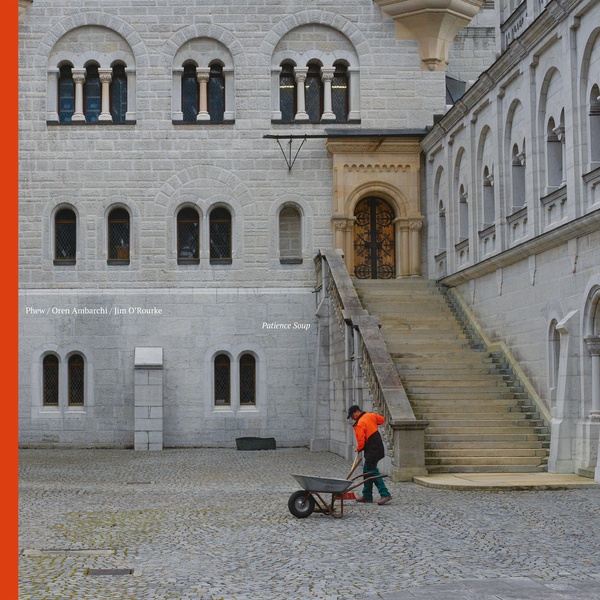
Phew / Oren Ambarchi / Jim O'Rourke
Patience Soup
Label: Black Truffle
Format: LP
Catalogue Number: BT046
Official web site: orenambarchi.bandcamp.com/album/patience-soup
Description
Patience Soup presents the entirety of a live performance from the trio of Oren Ambarchi, Jim O’Rourke, and Japanese underground legend Phew that took place at the Kitakyushu Performing Arts Center on November 4th, 2015.
Known to many listeners outside Japan primarily for her early collaborations with members of Can, Phew has been undergoing something of a creative renaissance in the last few years, prolifically recording and releasing a body of work that strips away the band arrangements present on most of her past releases to focus solely on her raw DIY electronics and possessed vocal stylings. Forming a perfect companion to 2017’s well-received Voice Hardcore, a series of pieces composed of only her processed voice that saw Phew push her work into the most abstract terrain yet, Patience Soup finds the trio inhabiting an uneasy landscape of moans, howls, and smeared electronic sonorities.
Presented in atmosphere-enhancing room fidelity, the set begins in crunching textural abstraction and Phew’s vocal asides, set against a backdrop of Ambarchi’s shimmering Leslie-cabinet guitar tones and O’Rourke’s synthetic slivers. A testament to the risk-taking prowess of these three master improvisers, the performance moves organically from ecstatic crescendos powered by Phew’s processed wails to moments of near-silence in which a translucent veil of lingering electronic tones is gently punctuated by O’Rourke’s chiming piano chords. Constantly shifting, both harmonically and dynamically, Patience Soup is suffused throughout with a haunted energy and shows these three established figures continuing to venture out into uncharted territory.
Presented in a deluxe sleeve with stunning images by Traianos Pakioufakis and an inner sleeve with live pics from Mike Kubeck. Design by Stephen O’Malley. Mastered and cut by Rashad Becker at Dubplates & Mastering, Berlin.
Patience Soup presents the entirety of a live performance from the trio of Oren Ambarchi, Jim O’Rourke, and Japanese underground legend Phew that took place at the Kitakyushu Performing Arts Center on November 4th, 2015. Known to many listeners outside Japan primarily for her early collaborations with members of Can, Phew has been undergoing something ...
read more…
Tracklisting
- Patience Soup Part 1
- Patience Soup Part 2
Available from these fine distributors:
- USA – Forced Exposure www.forcedexposure.com
- Europe – Kompakt www.kompakt.fm/labels/black_truffle
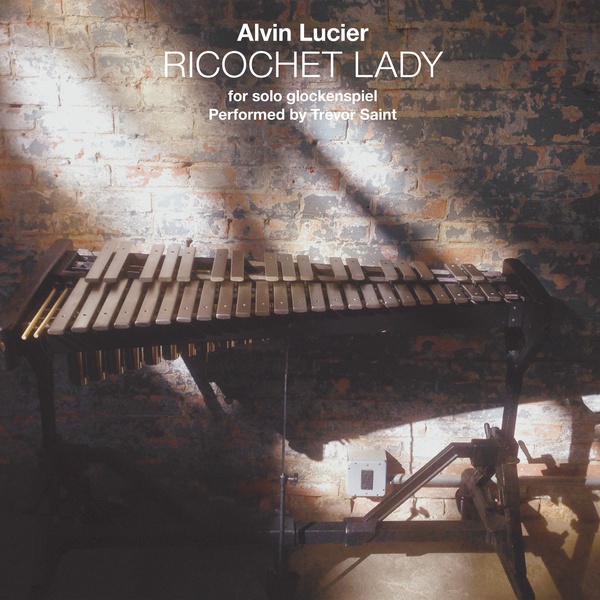
Alvin Lucier
Ricochet Lady
Label: Black Truffle
Format: CD
Catalogue Number: BT045
Official web site: blacktruffle.bandcamp.com/album/ricochet-lady
Description
The recently composed “Ricochet Lady” (2016) is the only work for solo acoustic glockenspiel by the American experimental composer Alvin Lucier. Following in the manner of his pieces “I Am Sitting In A Room” and “Vespers”, “Ricochet Lady” embodies Lucier’s approach toward sound’s individual function and mobility within space. This CD defines this approach through four realizations recorded in four dissimilar spaces, ranging from the standard to extraordinary: a university rehearsal hall with walls of drywall and glass, a chapel made of oak and stone, an empty forge and foundry warehouse for steel railway wheels, and a 36-meter tall dilapidated cement grain elevator.
Never one to shy away from convention, Lucier intensifies each performance by instructing that the glockenspiel be placed against a wall or other reflective surface where the soloist systematically traverses the entire range of the instrument in rapid, repetitive patterns, actively disseminating the glockenspiel’s sustain, clicks, and interferences throughout the space. In doing so, the glockenspiel maps the unique acoustical characters of each space as each space helps to compose the piece. Created in close collaboration with Trevor Saint, a rare (if not the only) specialist of experimental music for glockenspiel, Lucier has further enhanced the sophistication of this re-imagined instrument while maintaining his devotion to letting spaces speak.
Presented in a stunning digipak with liner notes by Alvin Lucier and Trevor Saint. Design by Lasse Marhaug. Mixed and mastered by Matt Sargent at Bard College, Annandale-on-Hudson, New York.
(For an optimal listening experience it is recommended that these recordings be played at high volume).
The recently composed “Ricochet Lady” (2016) is the only work for solo acoustic glockenspiel by the American experimental composer Alvin Lucier. Following in the manner of his pieces “I Am Sitting In A Room” and “Vespers”, “Ricochet Lady” embodies Lucier’s approach toward sound’s individual function and mobility within space. This CD defines this approach through ...
read more…
Tracklisting
- Ricochet Lady (Blum Hall)
- Ricochet Lady (Chapel of the Holy Innocents)
- Ricochet Lady (Basilica Hudson)
- Ricochet Lady (Marine A Grain Elevator)
Available from these fine distributors:
- USA – Forced Exposure www.forcedexposure.com
- Europe – Kompakt www.kompakt.fm/labels/black_truffle
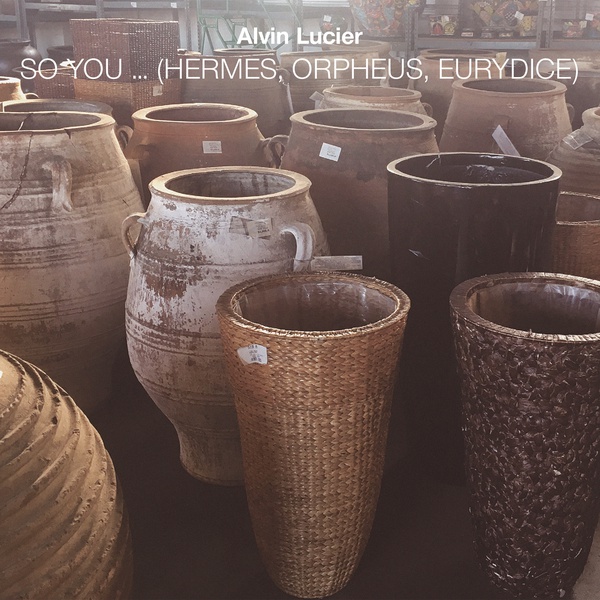
Alvin Lucier
So You … (Hermes, Orpheus, Eurydice)
Label: Black Truffle
Format: CD
Catalogue Number: BT044
Official web site: blacktruffle.bandcamp.com/album/so-you-hermes-orpheus-eurydice
Description
So You … (Hermes, Orpheus, Eurydice) is a major new work by legendary experimental composer Alvin Lucier. It is an hour-long epic that tracks the familiar Orpheus myth from a less familiar perspective: that of Eurydice as imagined by poet H.D. (Hilda Doolittle); a Eurydice who rails at Orpheus for his hubris in attempting to rescue her.
So You … (Hermes, Orpheus, Eurydice) was originally commissioned by Documenta 14 and first performed as part of Documenta in Athens in 2017. Two key, and formerly distinct, aspects of Lucier’s practice come together in this piece: the exploration of interference patterns in closely tuned intervals, and the exploration of resonant chambers. From speakers mounted inside amphorae a constantly turning braid of beating sine waves trace the descent into the depths of hell, and then the doomed attempt to climb back into life. Singer Jessika Kenney and long-time Lucier collaborators Anthony Burr and Charles Curtis embody the three title characters in deeply focused performances that assert themselves against the process of the sweep, or become enfolded in it. The electronics were mixed in real time by programmer and equipment designer Tom Erbe. This record has all of the mind-bending acoustic effects expected from a Lucier piece, but also features a strong sense of narrative drama and flashes of raw emotion that are unexpected and deeply affecting.
Design by Lasse Marhaug. Mastered by Doug Henderson at micro-moose, Berlin. Presented in a deluxe digipak with a booklet featuring the original poem and extensive notes by Lucier, Burr and Cathy Gere.
So You … (Hermes, Orpheus, Eurydice) is a major new work by legendary experimental composer Alvin Lucier. It is an hour-long epic that tracks the familiar Orpheus myth from a less familiar perspective: that of Eurydice as imagined by poet H.D. (Hilda Doolittle); a Eurydice who rails at Orpheus for his hubris in attempting to ...
read more…
Tracklisting
- So You ... (Hermes, Orpheus, Eurydice)
Available from these fine distributors:
- USA – Forced Exposure www.forcedexposure.com
- Europe – Kompakt www.kompakt.fm/labels/black_truffle
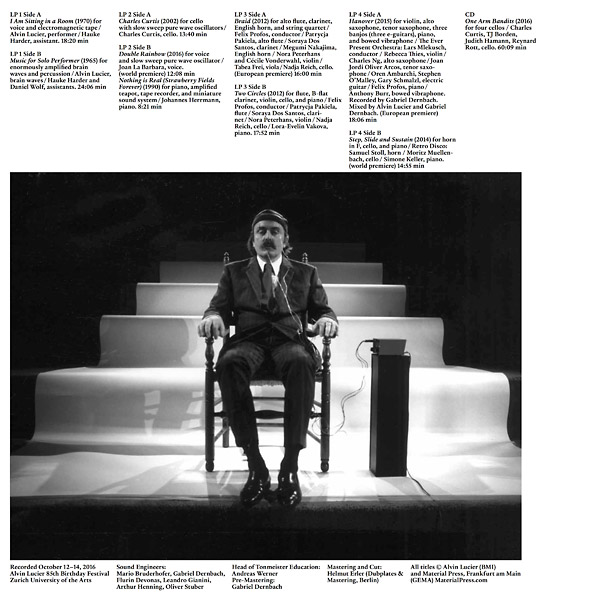
Alvin Lucier
Illuminated By The Moon
Label: Black Truffle
Format: 4xLP, 1xCD + 120 page book
Catalogue Number: BT043
Official web site: blacktruffle.bandcamp.com/album/illuminated-by-the-moon
Description
Black Truffle together with Bernhard Rietbrock and ZHDK present Illuminated By the Moon, a stunning box set celebrating Alvin Lucier‘s 85th birthday celebrations which took place in Zurich, 2013.
Alvin Lucier is one of most important figures in more than a half century of avant-garde and experimental sound practice; he has no equivalent. He is among America’s most important composers, a towering pillar of intellect, creativity, and beauty realized through sound. His singular body of work is focused around acoustic phenomena and auditory perception includes, among others, the groundbreaking Bird And Person Dyning, 1980’s Music On a Long Thin Wire, and 1981’s I Am Sitting In a Room, each quietly shifting the understanding of what music could be with deceptively discrete gestures, laying their mark on history and the expectations of nearly everything to come, while radically expanding the field. It is such a life, defined by such striking accomplishment, which Illuminated By the Moon, celebrates across four LPs, a CD, and book.
Recorded in October of 2016 at the Alvin Lucier 85th Birthday Festival at the Zurich University of the Arts, the box gathers a remarkable range of performances of works from Lucier’s life in music, from the iconic to the lesser known. It begins with wonderful stagings of “I Am Sitting In a Room” and “Music for Solo Performer” performed by the composer, before presenting the work “Charles Curtis” performed by the cellist for whom it was composed, and “Double Rainbow”, a recent work, performed by the incredible Joan La Barbara. Over the course of the set’s many discs, one encounters a range of works performed by Oren Ambarchi, Stephen O’Malley, Charles Curtis, and Gary Schmalzl, with further contributions by many others involved in Lucier’s life and work. The collection, by offering an expanse of material otherwise unavailable in the composer’s discography, opens a rare window into the breadth and range of territory which he has approached, as well as into the unique humor which has quietly bubbled through his entire career. It is a singular recording event, the likes of which are unlikely to be repeated. A worthy tribute to one of the last century’s most important composers.
Mastered and cut by Helmut Erler at Dubplates & Mastering, Berlin. 180 gram vinyl. Includes CD and 12×12″, 120-page book with unseen images and various essays; Includes download code; Edition of 500.
Black Truffle together with Bernhard Rietbrock and ZHDK present Illuminated By the Moon, a stunning box set celebrating Alvin Lucier‘s 85th birthday celebrations which took place in Zurich, 2013. Alvin Lucier is one of most important figures in more than a half century of avant-garde and experimental sound practice; he has no equivalent. He is ...
read more…
Tracklisting
- I Am Sitting In A Room
- Music For Solo Performer
- Charles Curtis
- Double Rainbow
- Nothing Is Real (Strawberry Fields Forever)
- Braid
- Two Circles
- Hanover
- Step, Slide And Sustain
- One Arm Bandits
Available from these fine distributors:
- USA – Forced Exposure www.forcedexposure.com
- Europe – Kompakt www.kompakt.fm/labels/black_truffle
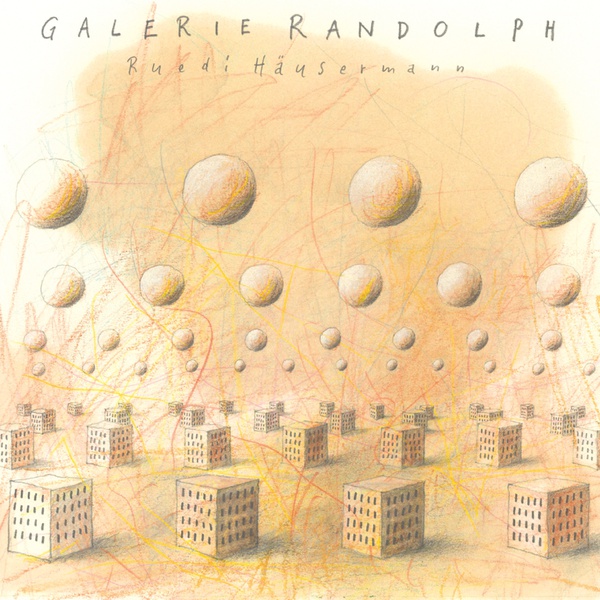
Ruedi Häusermann
Galerie Randolph
Label: Black Truffle
Format: LP
Catalogue Number: BT042
Official web site: blacktruffle.bandcamp.com/album/galerie-randolph
Description
Black Truffle present the first-ever vinyl reissue of Ruedi Häusermann‘s Galerie Randolph, a masterpiece of solo multi-tracking originally released on CD by Unit Records in 1995.
Born in 1948 and residing in the medieval Swiss town of Lenzburg, and virtually unknown outside of the German-speaking world, Häusermann is a multi-instrumentalist and enormously prolific composer who works primarily in the medium of absurdist music-theater. A virtuoso wind player and free improviser who also composes for traditional classical instrumentation, his work is characterized by subtly surreal humor and the unlikely combination of extended technique and simple, at times almost child-like, melodic ideas.
Named after his rehearsal room in Lenzburg, Galerie Randolph uses an enormous array of instruments to craft a work of singular compositional vision. Each of the twelve pieces begins from the same two elements: a woozy, sliding scatter of tones played on a home-made contraption stretching two guitar strings between the top of Häusermann’s alto saxophone and an amplified cup, and a series of uneasy block chords sounded on accordion and reeds. On each piece these two elements (whose pitch gradually raises throughout the record) are complemented by entirely different material, all of it played by Häusermann. Ranging from layered flutes to one-finger piano melodies to unintelligible vocals to musique concrete interjections to free jazz saxophone explosions, these additional layers combine with the endlessly returning idée fixe of the foundational elements to create a truly dream-like listening experience, a gently deranged realm in which you lose all sense of linear time. Calling up the most unlikely combinations of possible predecessors — Erik Satie, Gerry Mulligan, and Helmut Lachenmann perhaps — Galerie Randolph ultimately defies comparison. Almost unknown except to a select group of cognoscenti such as Jim O’Rourke, yet destined to become a cult classic, Galerie Randolph is an instance of that most rare thing: music the likes of which you have never heard before.
Mastered and cut by Rashad Becker at Dubplates & Mastering, Berlin. Presented in a deluxe gatefold sleeve with gorgeous archival images by the composer; Design by Stephen O’Malley; Edition of 500.
Black Truffle present the first-ever vinyl reissue of Ruedi Häusermann‘s Galerie Randolph, a masterpiece of solo multi-tracking originally released on CD by Unit Records in 1995. Born in 1948 and residing in the medieval Swiss town of Lenzburg, and virtually unknown outside of the German-speaking world, Häusermann is a multi-instrumentalist and enormously prolific composer who ...
read more…
Tracklisting
- Ohne Titel
- Ländliches Kouzert
- Vier Brüder Auf Der Bank
- Blaue Dominante, Öl Auf Kupfer
- Susanna Im Bade
- Marktfrau Mit Gemüse
- Halbakt Im Gegenlicht
- Aargauische Kleinlandschaft
- Van Der Rande, Massstäblich
- Goffersberg Mit Traktor
- Selbstbildnis Mit Frau Und Söhnen
- Ohne Titel
Available from these fine distributors:
- USA – Forced Exposure www.forcedexposure.com
- Europe – Kompakt www.kompakt.fm/labels/black_truffle
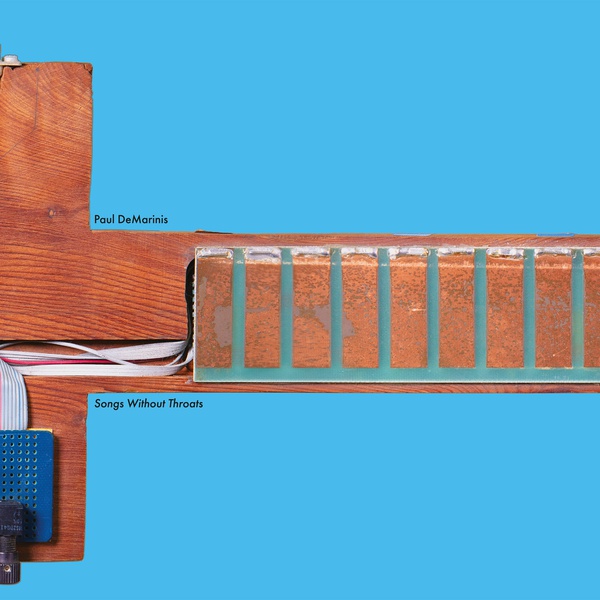
Paul DeMarinis
Songs Without Throats
Label: Black Truffle
Format: 2LP
Catalogue Number: BT041
Official web site: blacktruffle.bandcamp.com/album/songs-without-throats
Description
Black Truffle announces the release of Songs Without Throats, a collection of recordings from Paul DeMarinis. A key figure in the history of electronic music since the 1970s and collaborator with the likes of Robert Ashley, David Behrman, and David Tudor, DeMarinis is a pioneer in the development of gallery sound installation and digital music technologies. All tracks have been selected in collaboration with the artist, focusing on DeMarinis’s exploration of synthesized voice and the digital analysis and manipulation of speech sounds, recorded during the late ’70s up until 1995. Drawing together tracks dispersed on compilations along with a number of pieces previously unheard in any form, Songs Without Throats offers a mind-blowing, revelatory look into DeMarinis’s alternately accessible and uncompromising production.
Opening with a mesmerizing piece from 1978 pairing the voice and tamboura of Anne Klingensmith with letters spat out by a Speak n’ Spell to the accompaniment of the randomized melodic patterns of DeMarinis’s homebuilt electronic instrument “The Pygmy Gamelan”, the record then dispenses with the live human voice in favor of its recorded and synthetic doubles. One can follow DeMarinis’s restless probing of the possibilities of technology, from the hacked Speak n’ Spell (which gives us the austere “Et Tu, Klaatu” (1979), another duet with Klingensmith, on bowed psaltery, in which the toy’s synthetic voice is stretched into an alien song) through to the use of digital samples manipulated with home computer technology in the early 1990s (including a remarkable collage piece that weaves a rare recording of Stalin‘s voice and bird-like electronic twittering derived from its formant – glides into a rich tapestry of samples reflective of the dictator’s musical life). In between is a rich sampling of DeMarinis’s signature work with speech melodies — usually unnoticed melodic inflections that lie within speech patterns — which he analyses and translates into synthesized musical accompaniment. These pieces draw on a wide variety of sources, which range from the hilarious to the menacing, combining elements as seemingly unlikely as Beethoven‘s piano sonatas and the sounds of ’80s synth-pop. The results are an extraordinary combination of the alien and the familiar. As DeMarinis himself characterizes his work with vocal synthesis, this is “a kind of signal that simultaneously carried and obscured meaning and ideation, even as it created a sound world totally alien in esthetic”.
Deluxe gatefold sleeve with archival images and liners by DeMarinis; design by Stephen O’Malley. Mastered and cut by Rashad Becker at D&M, Berlin.
Black Truffle announces the release of Songs Without Throats, a collection of recordings from Paul DeMarinis. A key figure in the history of electronic music since the 1970s and collaborator with the likes of Robert Ashley, David Behrman, and David Tudor, DeMarinis is a pioneer in the development of gallery sound installation and digital music ...
read more…
Tracklisting
- If God Were Alive (& He Is) You Could Reach Him By Telephone
- R4T
- Et Tu, Klaatu
- Eenie Meenie Chillie Beenie
- Novena
- Mind Power
- Yellow Yankee
- I Want You
- Kokole
- Cincinnati 1830-1850
- Edison’s Piano
- The Lecture Of Comrade Stalin At The Extraordinary 8th Plenary Congress About The Draft Concept Of The Constitution Of The Soviet Union On November 25, 1936
Available from these fine distributors:
- USA – Forced Exposure www.forcedexposure.com
- Europe – Kompakt www.kompakt.fm/labels/black_truffle
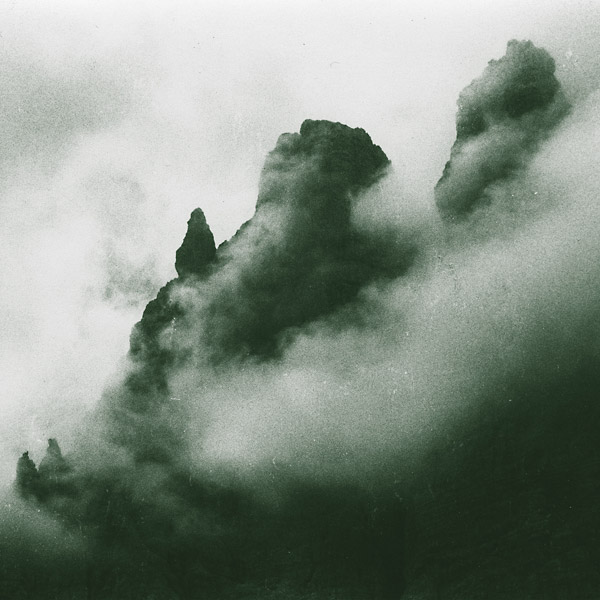
Massimo Toniutti
Il Museo Selvatico
Label: Black Truffle
Format: 2LP
Catalogue Number: BT040
Official web site: blacktruffle.bandcamp.com/album/il-museo-selvatico
Description
Black Truffle present the first reissue of a true underground masterpiece, Massimo Toniutti‘s Il Museo Selvatico (“The Wild Museum”), originally self-released on LP in 1991. Like his better-known brother Giancarlo — whose classic 1985 Broken Flag LP La Mutazione was reissued by Black Truffle in 2015 (BT 014LP) — Massimo Toniutti was active in the vibrant underground industrial/noise scene of the 1980s, contributing to releases on legendary labels such as Broken Flag and RRR and self-releasing a series of cassettes between 1984 and 1988.
Existing in a private world apart from the noise and dark industrial tropes of many of his contemporaries, Toniutti’s Il Museo Selvatico is an entirely singular work of domestic electro-acoustic exploration. Made up primarily of what Toniutti calls “small and rare noises” or sonic “knick-knacks” recorded between 1987 and 1990, the five pieces that make up the original LP usher us into a crepuscular space populated by mysterious traces of everyday life. Toniutti weaves a loose net of distant clanks, dull thuds, metallic resonance, and skittering percussive sounds, allowing the sounds to breathe against a backdrop of near-silent atmosphere. Although the haunted ambience recalls the work of contemporaries like Organum, Toniutti generally steers clear of long tones and drones, preferring to arrange brief, sometimes staccato sonic objects into patterns of repeating figures and isolated events whose overall compositional shape remains somehow ungraspable. Although glimpses of recognizable location recordings and instrumental sounds can occasionally be made out, for most of the record the sources of the sounds you hear remain teasingly mysterious, an abstracted memory of everyday actions and atmospheres.
Il Museo Selvatico is accompanied here by an additional LP of material recorded at the same time, composed especially for this reissue into two side-long suites that inhabit the same haunted space as the original LP while occasionally making use of more maximal compositional strategies. Essential listening for fans of Organum, Nurse With Wound, Christoph Heemann, and the tradition of outsider musique concrete.
Comes as a double-LP in a lavish gatefold with printed inner sleeves featuring archival images and notes. Remastered and cut at Dubplates & Mastering, Berlin.
Black Truffle present the first reissue of a true underground masterpiece, Massimo Toniutti‘s Il Museo Selvatico (“The Wild Museum”), originally self-released on LP in 1991. Like his better-known brother Giancarlo — whose classic 1985 Broken Flag LP La Mutazione was reissued by Black Truffle in 2015 (BT 014LP) — Massimo Toniutti was active in the ...
read more…
Tracklisting
- Canti a forbice
- zoomemorie
- vecchi villaggi
- Lento & Antico
- “ad ogni modo..”
- Intonated Magnifying Mirrors (materiali matematici)
- corde, soprammobili e metalli cartaginesi (as seen from my backyard)
Available from these fine distributors:
- USA – Forced Exposure www.forcedexposure.com
- Europe – Kompakt www.kompakt.fm/labels/black_truffle
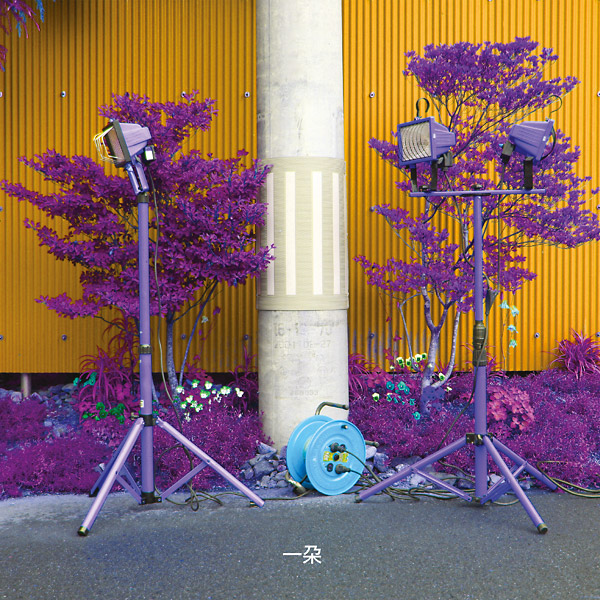
Eiko Ishibashi & Darin Gray
Ichida
Label: Black Truffle
Format: LP
Catalogue Number: BT039
Official web site: blacktruffle.bandcamp.com/album/ichida
Description
Black Truffle present the release of Ichida, the first release from the duo of two important, yet often underappreciated musicians, Eiko Ishibashi and Darin Gray. Ishibashi is a singer-songwriter, keyboardist, drummer, and multi-instrumentalist, known in Japan both for her own elaborately conceptual solo albums and for her frequent collaborations with figures such as Jim O’Rourke, Merzbow, and Phew. Darin Gray is a bassist and multi-instrumentalist known for a multitude of collaborations (with O’Rourke and Loren Connors, among many others), for On Fillmore, his cinematic post-exotica project with Glenn Kotche, and as one half of Chikamorachi with Chris Corsano, one of the finest free-jazz rhythm sections around.
Presenting the entirely of a live set performed at Tokyo’s SuperDeluxe in March 2013, the set begins as a duet for Ishibashi’s flute and Gray’s upright bass. Calmly melodic yet harmonically inventive, with shades of “spiritual jazz”, the pair’s acoustic ruminations are gradually joined by Ishibashi’s lush electronics, which randomly flicker between chords in a manner recalling the classic work of David Behrman. As the electronics build into a gloomy fog of slowly cycling loops, Gray lays his bass aside and turns to making strangely mournful interjections on a mouthpiece. Eventually Ishibashi moves to the piano, enveloping the audience in rippling pools of sustained, octave-doubled melody, provided by Gray’s bass with a fluid and dynamic foundation. For much of the second side, both Ishibashi and Gray turn to electronics, ultimately arriving in a bizarre space of melancholic arpeggios and random sputter and sizzle, oddly reminiscent of ’70s outsider prog acts like Wapassou. An uneasy coda of rich piano chords ends the set.
Captured in warm room ambience and beautifully mixed by Jim O’Rourke, Ichida is a rare combination of improvisational acumen and emotional directness, both adventurous and immediately accessible.
Cover pics by Jim O’Rourke. Design by Stephen O’Malley. Mastered and cut by Rashad Becker at Dubplates & Mastering, Berlin.
Black Truffle present the release of Ichida, the first release from the duo of two important, yet often underappreciated musicians, Eiko Ishibashi and Darin Gray. Ishibashi is a singer-songwriter, keyboardist, drummer, and multi-instrumentalist, known in Japan both for her own elaborately conceptual solo albums and for her frequent collaborations with figures such as Jim O’Rourke, ...
read more…
Tracklisting
- Ichida Part 1
- Ichida Part 2
Available from these fine distributors:
- USA – Forced Exposure www.forcedexposure.com
- Europe – Kompakt www.kompakt.fm/labels/black_truffle

Oren Ambarchi / Kassel Jaeger / James Rushford
Face Time
Label: Black Truffle
Format: LP
Catalogue Number: BT038
Official web site: orenambarchi.bandcamp.com/album/face-time
Description
Face Time is the second release from the trio of Oren Ambarchi, Kassel Jaeger, and James Rushford, following on from their 2016 debut Pale Calling (BT020LP). Recorded at the GRM studios in Paris in June 2017, the record immediately returns to the idiosyncratic sound-world of the trio’s first release, a simmering stew of electronic smears, pitched-down animal moans, and mysteriously emotive microtonal organ chords. But before long the record takes an unexpected turn, as sounds that initially enter as occasional percussive pitter-patter build to a halting rhythm. Equally reminiscent of Basic Channel-style dub techno and the sound of a microphone loose in a pocket, these stumbling rhythmic figures provide the framework for the remainder of the record’s two sides, occasionally receding into the background to allow squelching electronics, chiming bells, distorted autoharp, inchoate grunts, and the sound of a Cristal Baschet to take center stage, but each time returning with the inevitability of an idée fixe.
Eschewing any clear sense of form, the two side-long pieces move seamlessly through episodes with the organic flow of improvisation, embracing the happy accidents of events conjoined by chance and lingering on liminal moments. Gradually washing out into a cavernous roar, the record’s final moments are suddenly enlivened by shimmering metallic percussion and a sequence of woozy synth chords, combining with the muted rhythms and a distant thunderstorm to become a sort of oneiric tribute to the work of Wally Badarou.
Bringing together three of contemporary experimental music’s most individual voices, Face Time is an essential slice of outsider electro-acoustics.
Cover design by Stephen O’Malley.
Mastered and cut by Rashad Becker at Dubplates & Mastering, Berlin. Comes on neon orange vinyl.
Face Time is the second release from the trio of Oren Ambarchi, Kassel Jaeger, and James Rushford, following on from their 2016 debut Pale Calling (BT020LP). Recorded at the GRM studios in Paris in June 2017, the record immediately returns to the idiosyncratic sound-world of the trio’s first release, a simmering stew of electronic smears, ...
read more…
Tracklisting
- Face
- Face Time
Available from these fine distributors:
- USA – Forced Exposure www.forcedexposure.com
- Europe – Kompakt www.kompakt.fm/labels/black_truffle
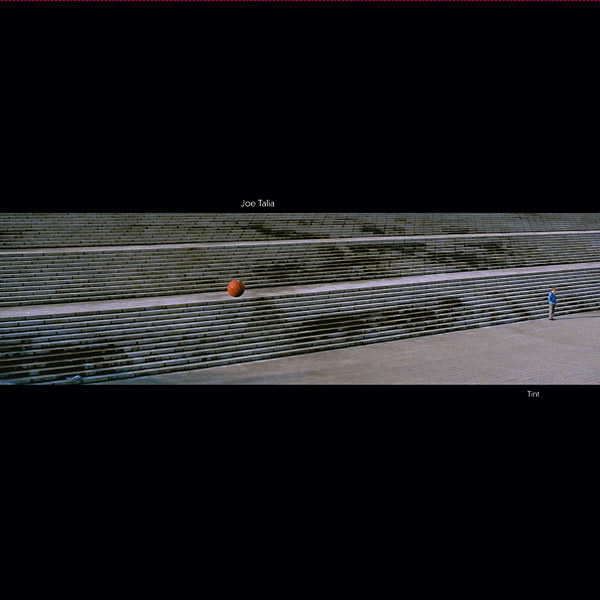
Joe Talia
Tint
Label: Black Truffle
Format: LP
Catalogue Number: BT037
Official web site: blacktruffle.bandcamp.com/album/tint
Description
Tint is the first new solo recording from Joe Talia in over a decade. Australian-born but now based in Tokyo, Talia is known to many listeners as a drummer (frequently collaborating both live and in the studio with artists such as Oren Ambarchi and Jim O’Rourke) and as a recording and mixing engineer responsible for dozens of releases across the fields of contemporary experimental music, wayward pop, and jazz. Alongside James Rushford, he is also responsible for one of the most legendary releases in the Kye records catalogue, the creaking electronic morass of Manhunter (2013).
Lovingly crafted over many months in his tiny Tokyo studio, Tint is an album-length electroacoustic suite that brings together Talia’s expertise as percussionist, studio engineer, and performer on analogue electronic instruments (primarily modular synth and Revox tape machine). Ranging from minimalist austerity to kosmische lushness, Tint refreshingly refuses the dark and moody sonic palette of much contemporary electroacoustic music in favour of an airy, at times almost weightless sound-world of gliding tones, skittering percussion, and burbling field recordings. Drawing inspiration from Jean-Claude Eloy’s epic concrète love letter to Tokyo, Gaku-No-Michi, Talia makes extensive use of his own recordings of his new home, but removes any sense of audio verite, abstracting them into transparent glosses of outdoor ambience or unidentifiable chimes and creaks. Flowing seamlessly between distinct episodes, Tint is compositionally controlled while retaining a sense of played spontaneity, eventually building to a maelstrom of analogue synth zaps and tape manipulated percussion that reflects Talia’s deep engagement with the relentless yet constantly shifting dynamics of free jazz.
Mastered and cut by Rashad Becker at D&M, Berlin.
Stunning photographs by Joe Talia and album design by Stephen O’Malley
Tint is the first new solo recording from Joe Talia in over a decade. Australian-born but now based in Tokyo, Talia is known to many listeners as a drummer (frequently collaborating both live and in the studio with artists such as Oren Ambarchi and Jim O’Rourke) and as a recording and mixing engineer responsible for dozens ...
read more…
Tracklisting
- Clouded Night Pt1
- Clouded Night Pt2
Available from these fine distributors:
- USA – Forced Exposure www.forcedexposure.com
- Europe – Kompakt www.kompakt.fm/labels/black_truffle

Oren Ambarchi
Grapes From The Estate
Label: Black Truffle
Format: 2LP
Catalogue Number: BT036
Official web site: orenambarchi.bandcamp.com/album/grapes-from-the-estate
Description
Black Truffle is pleased to make Oren Ambarchi’s Grapes from The Estate available once more on vinyl. Originally released on CD on Touch in 2004 and reissued on Southern Lord as a limited double LP in 2006 during Ambarchi’s tenure as a member of Sunn O))), Grapes from the Estate was a landmark release for Ambarchi, seeing him expand his sonic palette beyond the clipped, bass-heavy electric guitar tones he was known for at that point. Incorporating subtle layers of strings, keyboards, percussion over a bedrock of his signature guitar tones, in retrospect this album can be seen as the beginning of a broadening and evolution in Ambarchi’s work that would lead to his acclaimed, densely layered epics for Editions Mego, Quixotism (2014) and Hubris (2016).
Beginning with the shuddering pure tones of opener ‘Corkscrew’, which looks back to previous guitar-only releases such as Suspension (2001), the album’s next two pieces show a progressive broadening of the instrumental palette and a corresponding move away from textural abstraction and sustained tones towards more traditional notions of musicality. This reached its high point on the album’s third piece, the fifteen-minute long ‘Remedios The Beauty’, where guitars, both acoustic and electric, strings, piano, and bells build from a murmur to an interlockinging web of repeating melodic patterns over gently swinging brushed snare and cymbals. The epic closer, ‘Stars Aligned, Webs Spun’, returns us to a space populated only by the electric guitar, but unlike everything Ambarchi had produced up until this point in his career, the piece has a liquid, psychedelic edge that looks forward to the shimmering harmonics of his more recent work.
As Brendan Walls wrote at the time of the original release, this is ‘another outpouring of personal, intimate and enduring music from Oren Ambarchi’.
Presented in a stunning gatefold sleeve featuring the original artwork and design by Jon Wozencroft. Redesigned by Stephen O’Malley
Remastered and cut by Rashad Becker at D&M, Berlin.
Black Truffle is pleased to make Oren Ambarchi’s Grapes from The Estate available once more on vinyl. Originally released on CD on Touch in 2004 and reissued on Southern Lord as a limited double LP in 2006 during Ambarchi’s tenure as a member of Sunn O))), Grapes from the Estate was a landmark release for ...
read more…
Tracklisting
- Corkscrew
- Girl With The Silver Eyes
- Remedios The Beauty
- Stars Aligned, Webs Spun
Available from these fine distributors:
- USA – Forced Exposure www.forcedexposure.com
- Europe – Kompakt www.kompakt.fm/labels/black_truffle

Francis Plagne & crys cole
Two Words
Label: Black Truffle
Format: LP
Catalogue Number: BT035
Official web site: blacktruffle.bandcamp.com/album/two-words
Description
Two Words is the debut release from the duo of Canadian sound artist crys cole and Australian songwriter Francis Plagne. Building on a series of experimental live performances in which the pair toyed with possible common languages for their seemingly unrelated approaches to music, the LP’s two sides present a single piece that brings together abstract texture and slow-motion song in a sonic space where genre cedes to the logic of dreams.
The piece begins with a long, nearly static sequence built primarily from rubbed surfaces, using movement in the stereo field and changing mic placements to create a unified but unstable sonic environment that mimics wind, water, and breath, opening an impossible space between nature and artifice. This artificial outdoors ultimately makes room for Plagne’s electric organ, which sounds a series of melancholic chords to accompany a wandering Wyatt-esque keyboard line as Cole’s intimate contact mic textures sizzle and pop in the foreground.
From here the piece makes a surprise detour into song, as the majority of the second side finds Plagne intoning a series of obtuse two word phrases (from a text by Berlin-based poet Marty Hiatt) to an austere organ accompaniment. Working closely with engineer and producer Joe Talia, Cole and Plagne extend the studio-as-an-instrument tradition of Teo Macero and This Heat, introducing subtle yet unexpected production shifts that lead the listener from the initial austerity of the organ and voice to an oneiric space of asynchronised vocal doubles, creaking textures, and distant whistling, ultimately arriving at something like an imagined meeting of Organum and Arthur Russell. Packaged in a suitably mysterious sleeve featuring a lush work by Australian painter Anne Wallace on the front and text by Hiatt on the back, Two Words is both comforting and strange, a disorienting blend of seemingly discrepant elements.
Cover painting by Anne Wallace. LP design by Stephen O’Malley.
Mastered and cut by Rashad Becker at D&M, Berlin.
Two Words is the debut release from the duo of Canadian sound artist crys cole and Australian songwriter Francis Plagne. Building on a series of experimental live performances in which the pair toyed with possible common languages for their seemingly unrelated approaches to music, the LP’s two sides present a single piece that brings together ...
read more…
Tracklisting
- Two Words (A)
- Two Words (B)
Available from these fine distributors:
- USA – Forced Exposure www.forcedexposure.com
- Europe – Kompakt www.kompakt.fm/labels/black_truffle
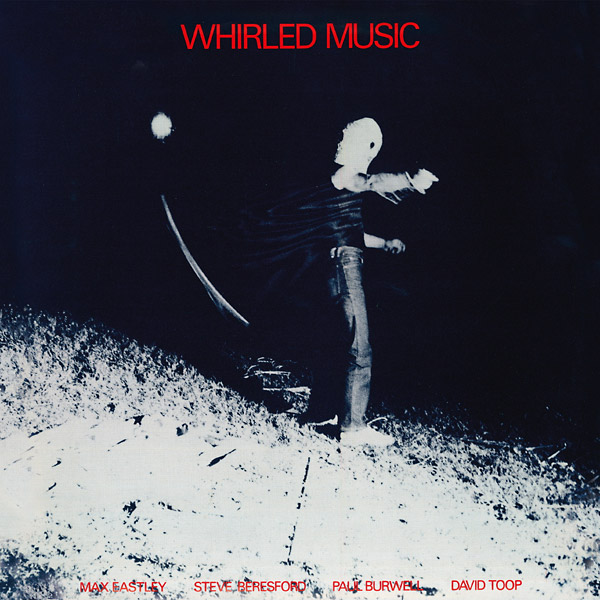
Max Eastley / Steve Beresford / Paul Burwell / David Toop
Whirled Music
Label: Black Truffle
Format: LP
Catalogue Number: BT034
Official web site: blacktruffle.bandcamp.com/album/whirled-music
Description
Black Truffle is honored to present the first ever reissue of Whirled Music by Max Eastley, Steve Beresford, Paul Burwell, and David Toop, one of the key documents of the inventive and energetic scene around the London Musicians Collective in the late 1970s and early 1980s. Originally released on Toop’s own Quartz label in 1980, the LP features a remarkable series of performances made entirely with whirled and swung instruments and objects.
Part of the second generations of British free improvising musicians, the prolific scene centered around the performers heard here chafed at the limitations present within the music and ideology of improvising legends such as Derek Bailey, Evan Parker, Tony Oxley and John Stevens. Where the first generations of British free improvisers often demonstrated a rigorous commitment to non-idiomatic free improvisation and instrumental virtuosity, musicians like Beresford reconnected with the dada antics of figures like Han Bennink and surrendered to joyful musical promiscuity, gleefully disrupting expectations around ‘serious’ improvised music through quotations (of anything from Beethoven to reggae) and deliberate amateurism.
However, where many recordings by various groupings of these musicians made around this time are gloriously anarchic real-time collages – see the classic Alterations LPs – Whirled Music is a singularly focused affair. Beginning in 1979, Whirled Music was the title given to a series of performances in which a variety of instruments and objects, both home made and store bought, traditional and invented, would be whirled to produce sound. In addition to variations on traditional instruments such as the bullroarer, Whirled Music also made use of whirled whistles, hand drums, radios and microphones. Due to the danger this represented for both performers and audiences, the performers wore protective masks and were separated from the audience by a net.
As Toop points out in the newly commissioned notes contained in this reissue, these events were somewhere between ‘composition, installation, and improvisation’, at once sharply focused and wildly uncontrolled. Presented in glorious cassette-recorded room fidelity, the LP’s first side features a single extended live performance in which percussive chattering, resonant gong-like tones, mysterious wind tones and swells of delirious noise join together to create a sonic landscape as reminiscent of an environmental recording (wind in the trees, the squawking of birds) as of an ethnographic recording of the music of an unknown civilization. Although purely acoustic, the music has an unstable, dispersed quality reminiscent of the pioneering live electronics of the Sonic Art Union or even early Voice Crack. The LP’s second side presents a series of shorter excerpts, including some beautifully sparse outdoor recordings where the sounds of the whirled instruments blend indistinguishably into the backdrop of environmental sounds.
A stunning document from a still under-recognised moment, Whirled Music is here presented in a stunning gatefold sleeve and 24-page booklet containing new liner notes by David Toop alongside contemporary reviews, flyers, notes on the instruments and performance documentation.
Remastered and cut at 45RPM by Rashad Becker at D&M Belin for maximum fidelity.
– Francis Plagne
Black Truffle is honored to present the first ever reissue of Whirled Music by Max Eastley, Steve Beresford, Paul Burwell, and David Toop, one of the key documents of the inventive and energetic scene around the London Musicians Collective in the late 1970s and early 1980s. Originally released on Toop’s own Quartz label in 1980, the ...
read more…
Tracklisting
- Untitled
-
LMC (a)
-
LMC (b)
-
LMC (c)
-
Butlers Wharf
-
Suffolk (a)
-
Suffolk (b)
-
Tennessee
Available from these fine distributors:
- USA – Forced Exposure www.forcedexposure.com
- Europe – Kompakt www.kompakt.fm/labels/black_truffle
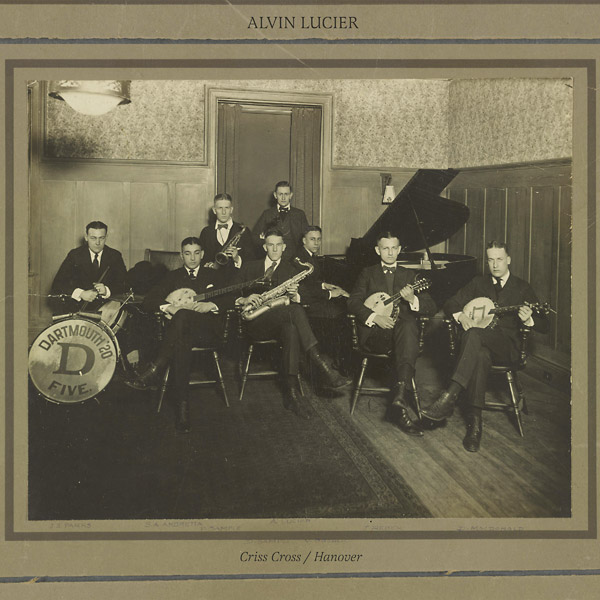
Alvin Lucier
Criss-Cross / Hanover
Label: Black Truffle
Format: LP
Catalogue Number: BT033
Official web site: blacktruffle.bandcamp.com/album/criss-cross-hanover
Description
Black Truffle present the premier recordings of two recent works by legendary American experimental composer Alvin Lucier. Lucier has been crafting elegant explorations of the behavior of sound in physical space since the 1960s and is perhaps best known for his 1970 piece I Am Sitting In a Room (LCD 1013CD). He has written a remarkable catalog of instrumental works that focus on phenomena produced by the interference between closely tuned pitches, often using pure electronic tones produced by oscillators in combination with single instruments. Demonstrating the restless creative drive of an artist now in his 80s, the two recent works presented here both feature the electric guitar, an instrument Lucier has just recently begun to explore. In Criss-Cross, Lucier’s first composition for electric guitars, two guitarists using e-bows sweep slowly up and down a single semitone, beginning at opposite ends of the pitch range. The piece exemplifyies Lucier’s desire not to “compose” in the conventional sense, but rather to eliminate everything that “distracts from the acoustical unfolding of the idea”. In this immaculately controlled performance of Criss-Cross by Oren Ambarchi and Stephen O’Malley, for whom the piece was written in 2013, a seemingly simple idea creates a rich array of sonic effects — not simply beating patterns, which gradually slow down as the two tones reach unison and accelerate as they move further apart, but also the remarkable phenomenon of sound waves spinning in elliptical patterns through space between the two guitar amps. In the comparatively lush Hanover, Lucier draws inspiration from the photograph on the cover, an image of the Dartmouth Jazz Band taken in 1918 featuring Lucier’s father on violin. Using the instrumentation present in the photograph, Lucier creates an unearthly sound world of sliding tones from violin, alto and tenor saxophones, piano, vibraphone (bowed), and three electric guitars (which take the place of the banjos present in the photograph). Waves of slow glissandi create thick, complex beating patterns, gently punctuated by repeated single notes from the piano. The result is a piece that is simultaneously both unperturbably calm and constantly in motion.
LP design by Stephen O’Malley; Includes inner sleeve with a portrait of Alvin Lucier by Kris Serafin.
“Criss-Cross” recorded at Studios Ina GRM, Paris by Francois Bonnet and mixed by Alvin Lucier. “Hanover” recorded in Zurich and mixed by Alvin Lucier.
Mastered and cut by Rashad Becker at Dubplates & Mastering, Berlin.
Black Truffle present the premier recordings of two recent works by legendary American experimental composer Alvin Lucier. Lucier has been crafting elegant explorations of the behavior of sound in physical space since the 1960s and is perhaps best known for his 1970 piece I Am Sitting In a Room (LCD 1013CD). He has written a ...
read more…
Tracklisting
- Criss-Cross
- Hanover
Available from these fine distributors:
- USA – Forced Exposure www.forcedexposure.com
- Europe – Kompakt www.kompakt.fm/labels/black_truffle

Oren Ambarchi
Stacte Karaoke II
Label: Black Truffle
Format: 12"
Catalogue Number: BT032
Official web site: orenambarchi.bandcamp.com/album/stacte-karaoke-ii
Description
What happens when Oren Ambarchi is backed up by the world’s greatest monster riff legends from his beloved homeland? Find out in the second volume of this infamous series where endless riffing and ecstatic shredding is the order of the day. Bonus intro track features some band from New York. Yah Boobay!
Deluxe sleeve with photography by Crys Cole and Theresia Pfaender. Design by Stephen O’Malley. Mastered and cut by Rashad Becker at Dubplates & Mastering, Berlin.
What happens when Oren Ambarchi is backed up by the world’s greatest monster riff legends from his beloved homeland? Find out in the second volume of this infamous series where endless riffing and ecstatic shredding is the order of the day. Bonus intro track features some band from New York. Yah Boobay! Deluxe sleeve with ...
read more…
Tracklisting
- Bamasa (intro)
- It Ain't Humid But It Sure Is Hot
- Dimestore Medicine
Available from these fine distributors:
- USA – Forced Exposure www.forcedexposure.com
- Europe – Kompakt www.kompakt.fm/labels/black_truffle
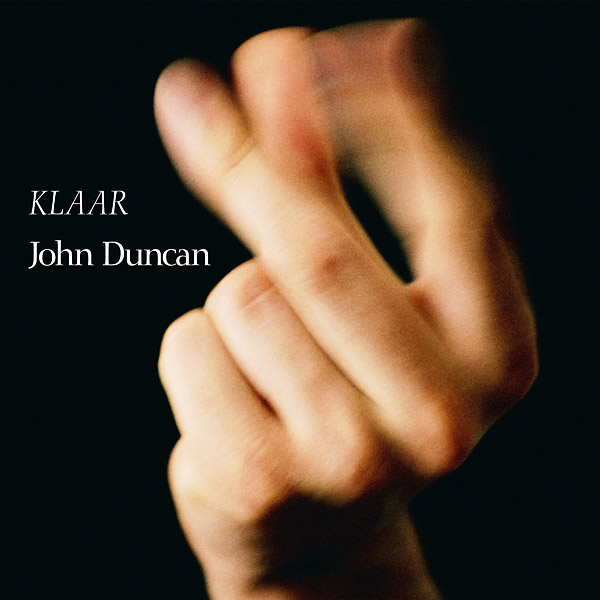
John Duncan
Klaar
Label: Black Truffle
Format: LP
Catalogue Number: BT031
Official web site: blacktruffle.bandcamp.com/album/klaar
Description
Black Truffle presents the first ever vinyl reissue of legendary performance and sound artist John Duncan‘s forgotten gem Klaar, originally released by Extreme in 1991 and partly created in collaboration with Andrew McKenzie (The Hafler Trio).
Duncan is perhaps most well-known for his notorious early performances pieces, which explored violence, self-denial, and the establishment of extreme psychological and physical states in both artist and audience. Alongside these transgressive experiments, Duncan began to create audio works primarily using short wave radio. Where some of Duncan’s earlier recordings are composed of magnificently sculpted but abrasive walls of noise, Klaar, recorded while Duncan was living in Amsterdam, occupies a more meditative territory.
Opening with Delta, which layers long tones seemingly sourced from slowed down voices over a distant, watery field recording, the remainder of the first side is occupied with the epic title piece, which arranges shortwave radio abstraction, vocal experiments, and field recordings (street sounds, fireworks, monastic chants) into an episodic cinema for the ear. The second side is dominated by the long, brooding The Immense Room, where layers of shortwave interference and field recordings are gradually built up into a pulsing, wavering bed of sound infused with a subtly disturbing sense of psychological unrest. This rises to the surface near the end of the piece as sexual moans and ominous rumbles crisscross the stereo image before being abruptly brought to a halt. A singular work of electroacoustic composition, Klaar is both compositionally sophisticated and infused with a sense of mystery and a vital reality often lacking in more academic experimental music; it sits proudly alongside contemporaneous recordings by Duncan’s friends and collaborators Jim O’Rourke and Christoph Heemann and is a must for anyone interested in their work.
Cover image and John Duncan portrait by Traianos Pakioufakis. LP design by Stephen O’Malley. Mastered and cut by Rashad Becker at Dubplates & Mastering, Berlin.
Black Truffle presents the first ever vinyl reissue of legendary performance and sound artist John Duncan‘s forgotten gem Klaar, originally released by Extreme in 1991 and partly created in collaboration with Andrew McKenzie (The Hafler Trio). Duncan is perhaps most well-known for his notorious early performances pieces, which explored violence, self-denial, and the establishment of ...
read more…
Tracklisting
- Delta
- Klaar
- The Immense Room
- Mass
Available from these fine distributors:
- USA – Forced Exposure www.forcedexposure.com
- Europe – Kompakt www.kompakt.fm/labels/black_truffle
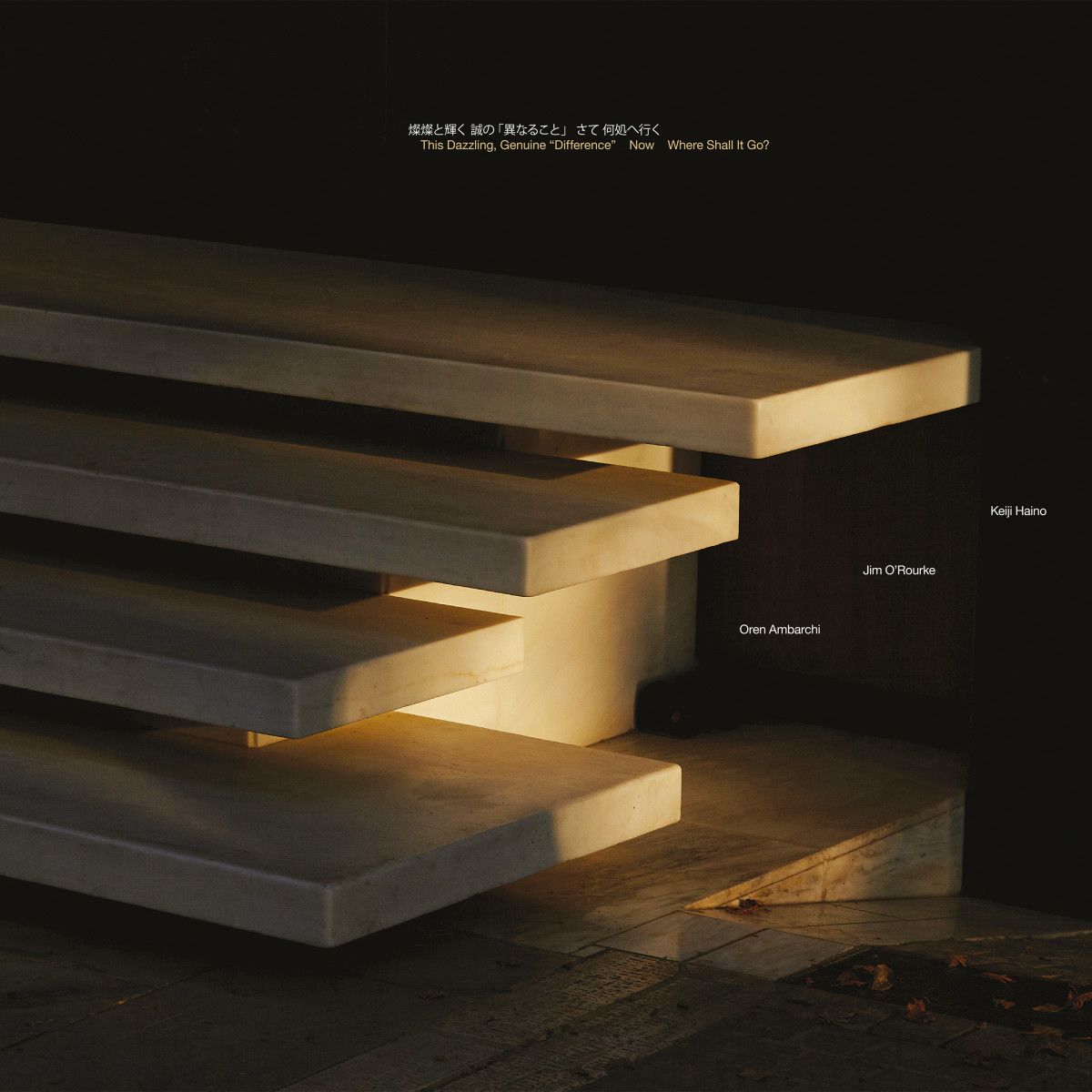
Keiji Haino / Jim O’Rourke / Oren Ambarchi
This Dazzling, Genuine “Difference” Now Where Shall It Go?
Label: Black Truffle
Format: 2LP
Catalogue Number: BT030
Official web site: orenambarchi.bandcamp.com/album/this-dazzling-genuine-difference-now-where-shall-it-go
Description
Black Truffle presents the eighth full-length release from the trio of Keiji Haino, Jim O’Rourke, and Oren Ambarchi.
Over the course of four LP sides, the October 2014 concert documented here ranges from rock power trio dynamics to maelstroms of analog electronics. Once again, the three demonstrate their commitment to pushing into new areas of instrumental exploration and group interaction. Where their previous releases featured extended vocal workouts from Haino, his vocalizations here are restricted to the occasional impassioned cry, putting the focus squarely on instrumental interplay. More than ever before, this feels like the work of three equals, with O’Rourke or Ambarchi taking the lead role as often as Haino does. The four pieces presented here each focus on extended development.
The first side is propelled by Ambarchi’s busy, Jack DeJohnette-esque cymbal and tom work, which provides a skittering yet insistent pulse over which Haino and O’Rourke’s FX-saturated strings rise and fall, momentarily converging for passages of near stasis before wandering through areas of gently sour discord; O’Rourke’s use of a six-string bass here boosts the harmonic density of the music and often makes his contribution difficult to distinguish from Haino’s guitar. On the second side, O’Rourke uses his pedals to make his bass near unrecognizable, generating a squelching, harmonically unstable riff that Ambarchi accompanies with a semi-martial snare pattern. Haino moves between frenetic octave-doubled fuzz riffing and streams of feedback. The third side is the most abstract; Continuing Haino’s explorations of new instruments, the side opens with a long passage of toy piano. Alongside occasional vocal interjections from Haino (singing in English), Ambarchi creates delicate textures on cymbals and metallic percussion while O’Rourke, for the first time in this group, performs on the EMS Synthi. With Haino joining in with his own electronics, the side eventually builds to a chaotic climax. Beginning with a sequence of “fourth world” drums and flute, the final side unfolds an epic build-up over a hypnotic foundation of pounding toms. Moving from flute to vocals to electronics, Haino eventually picks up the guitar in the second half of the piece, igniting a spectral blur over driving rhythms from bass and drums that eventually builds to a frenzied climax.
Cover image by Traianos Pakioufakis; Live action pics by Mike Kubeck. LP design by Stephen O’Malley; Gatefold sleeve. Mastered and cut by Rashad Becker at Dubplates & Mastering.
Black Truffle presents the eighth full-length release from the trio of Keiji Haino, Jim O’Rourke, and Oren Ambarchi. Over the course of four LP sides, the October 2014 concert documented here ranges from rock power trio dynamics to maelstroms of analog electronics. Once again, the three demonstrate their commitment to pushing into new areas of ...
read more…
Tracklisting
- This Dazzling, Genuine "Difference" Now Where Shall It Go? Part 1
- This Dazzling, Genuine "Difference" Now Where Shall It Go? Part 2
- The Nature Of That Thing Which Should Be Transfigured Has Begun To Fall In Line In Front of Me Most Decorously Part 1
- The Nature Of That Thing Which Should Be Transfigured Has Begun To Fall In Line In Front of Me Most Decorously Part 2
Available from these fine distributors:
- USA – Forced Exposure www.forcedexposure.com
- Europe – Kompakt www.kompakt.fm/labels/black_truffle

crys cole & oren ambarchi
Hotel Record
Label: Black Truffle
Format: 2LP
Catalogue Number: BT029
Official web site: orenambarchi.bandcamp.com/album/hotel-record
Description
Hotel Record is the second release from the duo/couple of crys cole and oren ambarchi, following on from Sonja Henies vei 31 (PLANAM 031LP, 2014). Where their debut recording presented a disquieting portrait of the erotic dimension of romantic intimacy, the follow-up continues to explore the pair’s simultaneously musical and romantic relationship in a more subtle fashion, presenting four long-form pieces that touch on the variety of forms the life of this couple takes: as a musical duo, as a pair of travelers to exotic locations, as opponents in a game of cards…
Each of the double LP’s four sides presents a distinct sound-world, yet each manages to attain the same suspended, half-sleeping feeling, outlining a space where improbable combinations of the electronic and the acoustic, of extreme closeness and amorphous distance, occurring with the gentle insistence of a dream. The opening Call Myself calmly unfolds a fabric of long tones from electronic organ and guitar, combining the sliding, aleatoric effects of classic David Behrman with a more hands-on feel. Over the top of this slowly shifting tonal bed, cole’s voice mutters unintelligibly into a Buchla synth, teasing the listener by suggesting a meaning that remains always out of the ear’s reach. Francis Debacle (Uno) builds on the foundations of a heavily amplified session of the titular card game, overlaying vocal murmurs and exhalations and mysterious room-sounds to create an impossible aural environment. On Burrata, a palette of vintage 1980s digital synthesizer sounds combined with guitars create an irregular texture of lush chords and bubbling melodic details, into which cole’s voice processed by a vocoder, is interwoven, reading fragments of romantic correspondence. Finally, on Pad Phet Gob, field recordings made in Thailand become an ambiguously acoustic/electronic rainforest, eventually giving way to a mysterious, wavering electronic tone-field punctuated by sibilant, popping mouth-sounds.
Carving out an intimate and human sonic space across a diverse array of compositional approaches, sound sources, fidelities, and textures, Hotel Record is the latest dispatch from the continuing explorations of a unique duo. Ambarchi and cole reimagine electro-acoustic music, not simply as “abstract” sound, but as a diary, a love poem, a dream.
Comes in deluxe gatefold sleeve with photography by crys cole and LP design via Stephen O’Malley; Mastered and cut by Rashad Becker at Dubplates & Mastering.
Hotel Record is the second release from the duo/couple of crys cole and oren ambarchi, following on from Sonja Henies vei 31 (PLANAM 031LP, 2014). Where their debut recording presented a disquieting portrait of the erotic dimension of romantic intimacy, the follow-up continues to explore the pair’s simultaneously musical and romantic relationship in a more ...
read more…
Tracklisting
- Call Myself
- Francis Debacle (Uno)
- Burrata
- Pad Phet Gob
Available from these fine distributors:
- USA – Forced Exposure www.forcedexposure.com
- Europe – Kompakt www.kompakt.fm/labels/black_truffle

Annea Lockwood
Tiger Balm / Amazonia Dreaming / Immersion
Label: Black Truffle
Format: LP
Catalogue Number: BT028
Official web site: blacktruffle.bandcamp.com/album/tiger-balm-amazonia-dreaming-immersion
Description
Black Truffle presents a new issue of Annea Lockwood‘s classic 1970 tape piece Tiger Balm, unavailable on vinyl for over thirty years, accompanied by two exquisite unreleased works for percussion and voice.
Created while Lockwood was living in the UK, the side-long Tiger Balm is a singular work within the cannon of tape music. Inspired by research into the ritual function of music, the piece explores the possibility of evoking ancient communal memories through sound. Breaking entirely with the dynamic language of the musique concrète tradition, Lockwood uses a select palette of mainly unprocessed sonic elements chosen for their mysterious and erotic characteristics (a purring cat, a heartbeat, gongs, slowed down jaw harp, a tiger, a woman’s breath, a plane passing overhead), presenting at most two sounds at once. As one sound flows organically into the next, their shared characteristics are highlighted, opening a space of dream logic and mysterious associations between nature and culture, the ancient and the modern. The B side presents two pieces for percussion recorded here for the first time. Amazonia Dreaming (1987), performed by Dominic Donato, uses unaccompanied snare drum and voice to evoke the nocturnal soundscape of the Amazon rainforest. Unorthodox techniques and materials (marbles, chopsticks, a plastic jar lid) transform the snare into a resonant field of sensual textures. Immersion (1998), performed by Donato and Frank Cassara, is a slow-moving exploration of gentle beating tones, performed on marimba, tam tams, and gong. Like the other two works presented on this LP, it provides captivating proof of Lockwood’s belief in the complexity that deep listening can reveal within seemingly simple sounds.” — Francis Plagne
Comes in a deluxe gatefold sleeve with archival pictures and liner notes by Annea Lockwood; Includes the score to Amazonia Dreaming.
LP design by Stephen O’Malley; Mastered and cut by Rashad Becker at Dubplates & Mastering.
Black Truffle presents a new issue of Annea Lockwood‘s classic 1970 tape piece Tiger Balm, unavailable on vinyl for over thirty years, accompanied by two exquisite unreleased works for percussion and voice. Created while Lockwood was living in the UK, the side-long Tiger Balm is a singular work within the cannon of tape music. Inspired ...
read more…
Tracklisting
- Tiger Balm
- Amazonia Dreaming
- Immersion
Available from these fine distributors:
- USA – Forced Exposure www.forcedexposure.com
- Europe – Kompakt www.kompakt.fm/labels/black_truffle
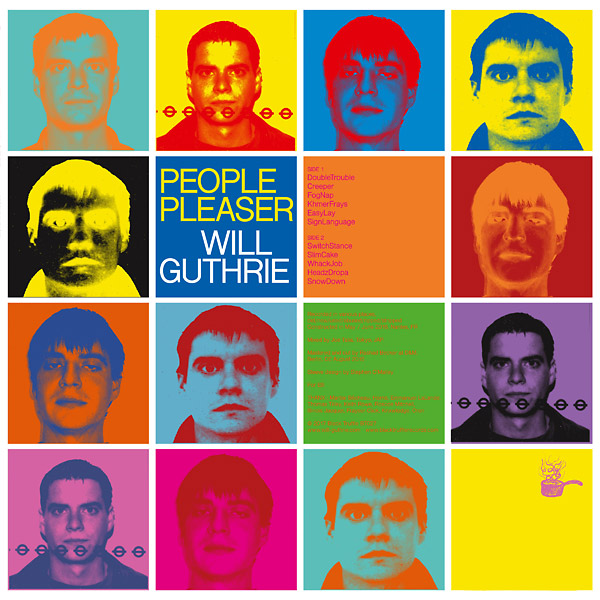
Will Guthrie
People Pleaser
Label: Black Truffle
Format: LP
Catalogue Number: BT027
Official web site: willguthrie.bandcamp.com/album/people-pleaser
Description
Nantes, France-based drummer and percussionist Will Guthrie presents People Pleaser. Initially rising to prominence in Australia as a drummer in the fields of jazz and improvised music, Guthrie later turned increasingly toward electronics and amplified percussion, developing an idiosyncratic style of electroacoustic performance characterized by shimmering metallic textures, rapid-fire textural transformations, and aggressively high volume. Guthrie has since returned to the drum kit in both solo and collaborative work, pushing at the limits of his formidable technical abilities as a player in the free jazz tradition and working variations on short rhythmic units into an endless flow of non-metered pulse. Although drawing on many aspects of Guthrie’s past work, People Pleaser stands alone in his catalog.
Working intuitively over a period of three weeks, Guthrie crafted a suite of song-length pieces that combine his drumming with electronics, field recordings, and sampled detritus. Inspired by the rough-and-ready sampling style of producers like the RZA, J Dilla, and Knxwledge, and by the endless possibilities of musique concrète, People Pleaser uses a highly divergent array of sound sources, building pieces from drum and percussion tracks left over from other projects, audio ripped from skate videos, noise electronics, fragments of a police interrogation, and anything else ready to hand. Guthrie’s unique rhythmic sensibility is the thread drawing all these elements together, his drum performances propulsively rhythmic yet insistently irregular in a way that sometimes brings to mind the uniquely open rhythmic space carved out by early Weather Report and other classic fusion. Drawing together manifold influences in an entirely sui generis way, People Pleaser is a raw, exciting, and surprisingly accessible peek into the laboratory of a unique sensibility.
Designed by Stephen O’Malley.
Mastered and cut by Rashad Becker at Dubplates & Mastering, Berlin, August 2016.
Nantes, France-based drummer and percussionist Will Guthrie presents People Pleaser. Initially rising to prominence in Australia as a drummer in the fields of jazz and improvised music, Guthrie later turned increasingly toward electronics and amplified percussion, developing an idiosyncratic style of electroacoustic performance characterized by shimmering metallic textures, rapid-fire textural transformations, and aggressively high volume. ...
read more…
Tracklisting
- DoubleTrouble
- Creeper
- FogNap
- KhmerFrays
- EasyLay
- SignLanguage
- SwitchStance
- SlimCake
- WhackJob
- HeadzDropa
- SnowDown
Available from these fine distributors:
- USA – Forced Exposure www.forcedexposure.com
- Europe – Kompakt www.kompakt.fm/labels/black_truffle
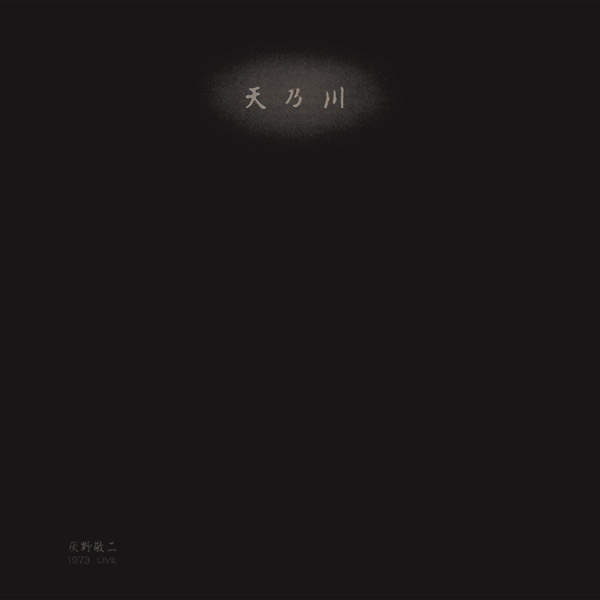
Keiji Haino
1973 Live – Milky Way
Label: Black Truffle
Format: LP
Catalogue Number: BT026
Official web site: blacktruffle.bandcamp.com/album/1973-live-milky-way
Description
Black Truffle present the first vinyl issue of Keiji Haino‘s Milky Way. Originally released as a limited CD in Japan by the short lived Mom ‘N’ Dad Productions in 1993, this release documents a blistering live performance recorded in Kyoto in 1973, five years before the formation of the first line-up of Fushitsusha, and eight years before Haino’s first solo album. Working with a mysterious set-up including primitive electronics, homemade acoustic instruments, piano and voice, Haino lets loose a single 48-minute psychedelic maelstrom, marrying the immersive echo-fields of kosmische music to the rough and ready hands-on feel of classic 1960s live electronics à la MEV or Robert Ashley‘s Wolfman. Despite the absence of guitar, this recording clearly lays the groundwork for the epic blowouts which were to make Haino’s name in years to come, building up to a point of almost unbearable intensity in its final minutes as Haino’s voice wails over a wall of distorted DIY electronics. At times presaging the psychedelic noise of C.C.C.C., Milky Way shows Haino’s singular intensity and ritualistic performance style already in full flower at this early date in his long career. Presented in raw and immediate room fidelity (complete with dramatic tape drop-out), this is both an essential historical document and a classic performance in its own right.
Presented in a deluxe heavyweight sleeve with an inner sleeve featuring Haino’s poetry in Japanese, with an English translation by Alan Cummings. Original design by Keiji Haino & Yasunori Arai. LP reissue design via Stephen O’Malley. Mastered and cut by Rashad Becker at D&M, Berlin June 2016.
Black Truffle present the first vinyl issue of Keiji Haino‘s Milky Way. Originally released as a limited CD in Japan by the short lived Mom ‘N’ Dad Productions in 1993, this release documents a blistering live performance recorded in Kyoto in 1973, five years before the formation of the first line-up of Fushitsusha, and eight ...
read more…
Tracklisting
- 天乃川 1973 Live - Milky Way Part 1
- 天乃川 1973 Live - Milky Way Part 2
Available from these fine distributors:
- USA – Forced Exposure www.forcedexposure.com
- Europe – Kompakt www.kompakt.fm/labels/black_truffle
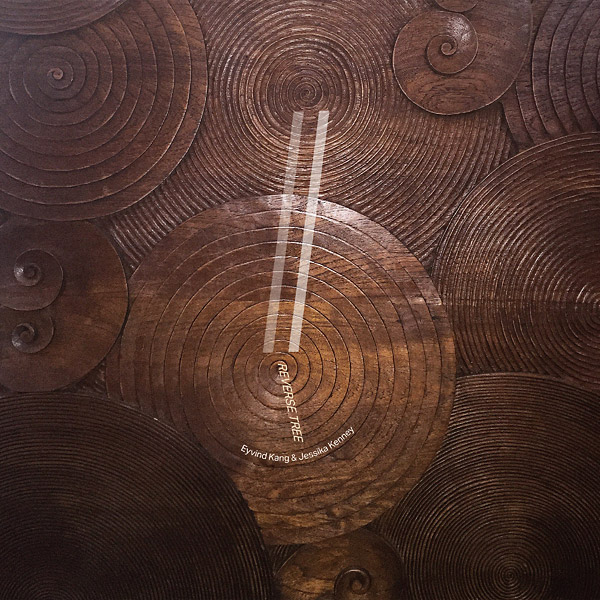
Eyvind Kang & Jessika Kenney
Reverse Tree
Label: Black Truffle
Format: LP
Catalogue Number: BT025
Official web site: blacktruffle.bandcamp.com/album/reverse-tree
Description
Black Truffle presents Reverse Tree, the new LP from the acclaimed duo of Eyvind Kang and Jessika Kenney. The two are musicians who have established themselves as powerful voices working at a unique intersection of contemporary composition, improvisation, and Asian traditional music forms. Either individually or as a pair, they have worked in contexts ranging from performances of traditional Persian and Javanese music to collaborations with Sunn O))), but their work together as a duo, on The Face Of The Earth (2012) and Aestuarium (SOMA 002LP, 2011), most clearly represents the central concerns of their diverse practices: a music of the inner life of sound, demanding ritualistic focus and promising heightened sensations. On Reverse Tree, the duo expand their work together into the realm of the chamber ensemble, presenting two side-long works that feature Kenney’s voice and Kang’s viola alongside a multitude of other instrumentalists. Kang’s “Thoughts On Being Exiled To The Frontier, For Lord Wei”, inspired by a text by the Tang dynasty poet Hsueh T’ao, features an all-star international ensemble: Kang, Kenney, maverick Israeli conductor Ilan Volkov on violin, Icelandic cellist Hildur Guðnadóttir, and guitarists Oren Ambarchi and Stephen O’Malley. The piece, beautifully mixed by renowned producer/engineer Randall Dunn, is primarily composed of irregular patterns of pizzicato notes and guitar harmonics, gently falling in and out of sync and providing a subtly unstable support for Kenney’s voice, which at times is reminiscent of Michiko Hirayama‘s classic performances of Scelsi. Drawing on 20th century instrumental techniques, alternate tuning systems, non-western music and the experience of nature, the piece opens a space both serene and subtly uneasy. Kenney’s ‘Elm features Kenney and vocalist Nova Ruth (Filastine, Twin Sista) alongside an ensemble of strings and Seattle’s Gamelan Pacifica, performing on Javanese instruments tuned to the slendro scale. An uncanny timbre created by bowing the keys of the Gamelan’s instruments, supported by bowed harmonics from the strings, is heard consistently throughout the piece. After a long introductory section in which this harmonic cloud slowly descends from shimmering high notes to rumbling bass, the vocalists enter, singing a slow and stately setting of a 19th century Surakarta poem (attributed to Mangkunegara IV). The poem deals with the idea of a form of knowledge achieved through deeds, as a practice and state of the heart.
Presented in a deluxe sleeve designed by Stephen O’Malley; Mastered and cut by Rashad Becker; Cut at 45rpm for maximum fidelity.
Black Truffle presents Reverse Tree, the new LP from the acclaimed duo of Eyvind Kang and Jessika Kenney. The two are musicians who have established themselves as powerful voices working at a unique intersection of contemporary composition, improvisation, and Asian traditional music forms. Either individually or as a pair, they have worked in contexts ranging ...
read more…
Tracklisting
- Thoughts On Being Exiled To The Frontier, For Lord Wei
- 'Elm
Available from these fine distributors:
- USA – Forced Exposure www.forcedexposure.com
- Europe – Kompakt www.kompakt.fm/labels/black_truffle
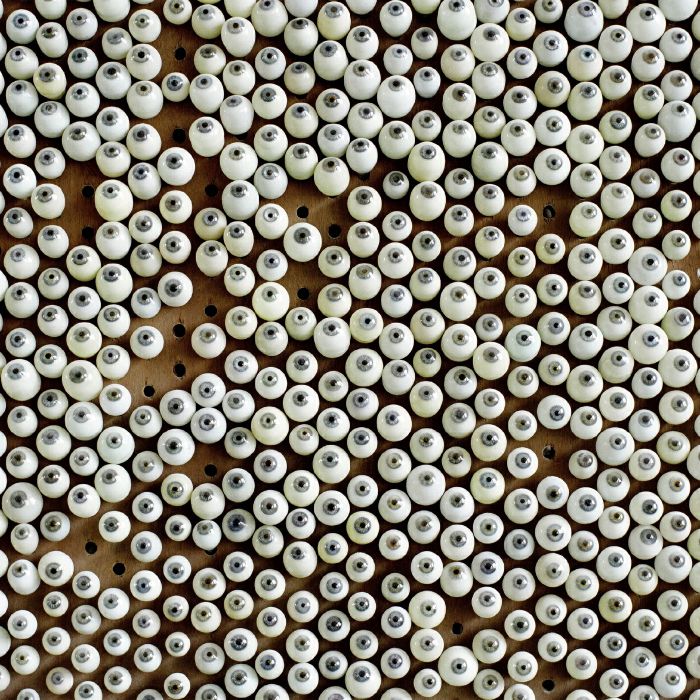
Ricardo Villalobos / Oren Ambarchi
Hubris Variation
Label: Black Truffle
Format: 12"
Catalogue Number: BT024
Official web site: orenambarchi.bandcamp.com/album/hubris-variation
Description
Oren Ambarchi’s recent Editions Mego release Hubris gets the remix treatment courtesy of electronic music legend Ricardo Villalobos.
Villalobos expertly tranforms Ambarchi’s layered web of countless sustained and pulsating palm-muted guitars into a funky, mesmerising and propulsive long-form piece.
Oren Ambarchi’s recent Editions Mego release Hubris gets the remix treatment courtesy of electronic music legend Ricardo Villalobos. Villalobos expertly tranforms Ambarchi’s layered web of countless sustained and pulsating palm-muted guitars into a funky, mesmerising and propulsive long-form piece.
read more…
Tracklisting
- Hubris Variation Part 1
- Hubris Variation Part 2
Available from these fine distributors:
- USA – Forced Exposure www.forcedexposure.com
- Europe – Kompakt www.kompakt.fm/labels/black_truffle
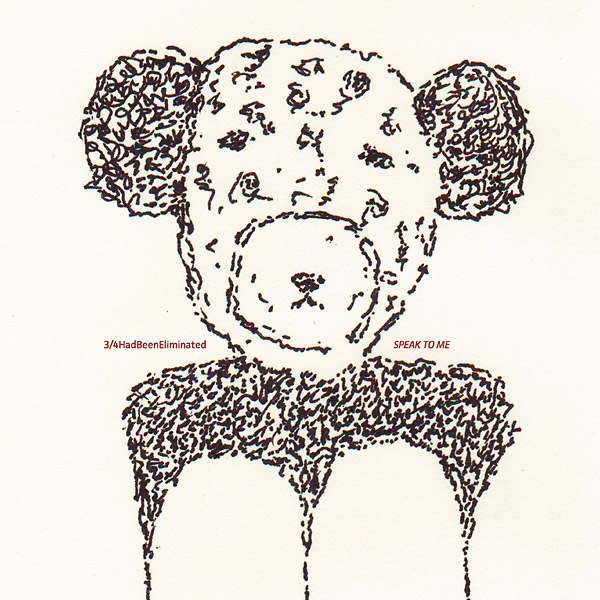
3/4HadBeenEliminated
Speak To Me
Label: Black Truffle
Format: LP
Catalogue Number: BT023
Official web site: blacktruffle.bandcamp.com/album/speak-to-me
Description
Black Truffle presents Speak To Me, the sixth full-length release from 3/4HadBeenEliminated, the Italian trio of Stefano Pilia, Claudio Rocchetti and Valerio Tricoli. Based on source material recorded in Bologna and Berlin over the course of several years, the album is made up of two side-long pieces meticulously constructed in post-production by Tricoli in his singularly dense and unpredictable style. Although their live performances have always been entirely improvised, in their recorded work the group focuses on using improvised recordings as source material for compositions built up through layering, editing and analog manipulation, extending the practices of Teo Macero, Faust and This Heat. Melancholic instrumental ruminations sit alongside cracked electronics, concrete sounds and Tricoli’s whispered vocals, drawn together into dense assemblages animated by gradual transformations and sudden jump cuts.
Beginning from the abstractions of their self-titled debut release in 2004, the group embarked on a trajectory that saw them move toward near-song structures, Tricoli’s voice becoming a dominant element amid an increasingly dense and layered production style. On Speak To Me, however, the listener feels confronted by the ghost of music, sonic memories echoing across a psychedelic expanse. Evacuated of any clear structure, the music becomes a reverb-saturated morass, from which crystalline details momentarily emerge: shimmering echoed guitar, bowed double bass, tactile hand percussion, skittering electronics. Suffused with a darkly pensive atmosphere, Speak To Me is an elegant summation of the distinctive blend of electroacoustic techniques, instrumental improvisation and contemporary psychedelia pioneered by 3/4HadBeenEliminated over the last decade.
LP design by Stephen O’Malley with striking artwork by Stefano Pilia. Vinyl cut by Rashad Becker at Dubplates & Mastering, Berlin.
Black Truffle presents Speak To Me, the sixth full-length release from 3/4HadBeenEliminated, the Italian trio of Stefano Pilia, Claudio Rocchetti and Valerio Tricoli. Based on source material recorded in Bologna and Berlin over the course of several years, the album is made up of two side-long pieces meticulously constructed in post-production by Tricoli in his ...
read more…
Tracklisting
- Nekyia
- I Am A Prune Cake On A Background Of Corn Semolina
Available from these fine distributors:
- USA – Forced Exposure www.forcedexposure.com
- Europe – Kompakt www.kompakt.fm/labels/black_truffle

Alvin Curran
Natural History
Label: Black Truffle
Format: LP
Catalogue Number: BT022
Official web site: blacktruffle.bandcamp.com/album/natural-history
Description
Black Truffle present the first-ever vinyl issue of Alvin Curran‘s Natural History, originally released on cassette by Edition Giannozzo Berlin in 1983. A founding member of the radical electronic improvising group Musica Elettronica Viva, since the early 1970s Curran has developed an idiosyncratic body of solo work that occupies a unique position in the post-Cageian experimental tradition. Singularly undogmatic, Curran’s work takes the Cageian experience as the starting point for a radical openness to all forms of music and sound. Refusing to abstract music from its human functions, his work draws on existing musical genres, cutting-edge electronics and environmental recordings to craft compositions that mimic the hazy texture of everyday life, moving from the abstract to the referential, from the observational to the emotive, from the structured to the random. As he reflects in the liner notes written especially for this edition: “This infinite stream of sound became my life and my music all at once”.
Curran’s other classic solo works of the 1970s and 1980s, such as Songs and Views of the Magnetic Garden (1975) and Canti Illuminati (1982) are elaborate collages that combine keyboard and voice improvisation and composition with field-recorded environments. Natural History consists entirely of field recordings from Curran’s archive, arranged as a series of “still lifes”, sometimes layered, but without any additional processing. Sounds recorded over the course of nearly twenty years, at Curran’s home in Rome or while traveling: constructions sites, insects, children’s toys, a piano being tuned, foghorns, familiar to admirers of Curran masterful Maritime Rites (2004), lovemaking, a singing neighbor. It is, as Curran says, an attempt to “put the sound of the entire world on a cassette tape”. Heard against the backdrop of the increasing prevalence of field recordings in contemporary music over the last few years, Natural History is like a refreshing breeze, suffused with the joy of discovery.
Gatefold sleeve with liner notes and photos by Alvin Curran and design by Stephen O’Malley. Vinyl cut by Rashad Becker at Dubplates.
Black Truffle present the first-ever vinyl issue of Alvin Curran‘s Natural History, originally released on cassette by Edition Giannozzo Berlin in 1983. A founding member of the radical electronic improvising group Musica Elettronica Viva, since the early 1970s Curran has developed an idiosyncratic body of solo work that occupies a unique position in the post-Cageian ...
read more…
Tracklisting
- Natural History Part 1
- Natural History Part 2
Available from these fine distributors:
- USA – Forced Exposure www.forcedexposure.com
- Europe – Kompakt www.kompakt.fm/labels/black_truffle
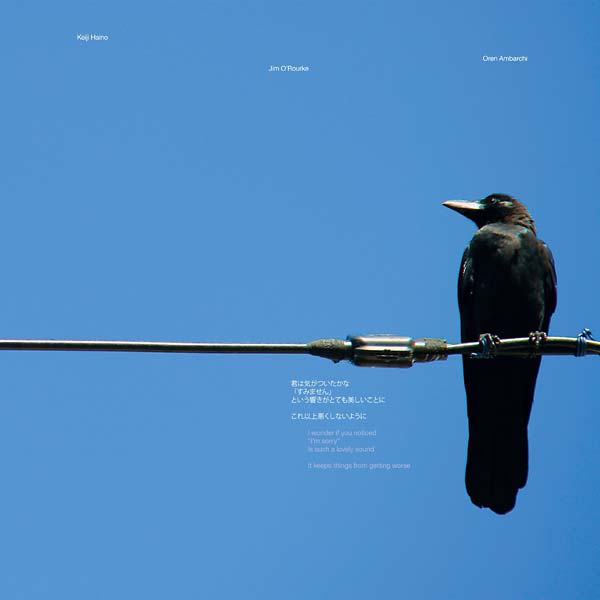
Keiji Haino / Jim O’Rourke / Oren Ambarchi
I wonder if you noticed “I’m sorry” Is such a lovely sound It keeps things from getting worse
Label: Black Truffle
Format: 2LP
Catalogue Number: BT021
Official web site: orenambarchi.bandcamp.com/album/i-wonder-if-you-noticed-i-m-sorry-is-such-a-lovely-sound-it-keeps-things-from-getting-worse
Description
The remarkable series of releases from the trio of Keiji Haino, Jim O’Rourke and Oren Ambarchi continues with I wonder if you noticed “I’m sorry” Is such a lovely sound It keeps things from getting worse, which presents the entirety of an 80 minute set performed at Tokyo’s SuperDeluxe in March 2014. Where their 2012 performance (BT011 and BT012) was divided into two releases, one continuing their exploration of the guitar/bass/drums power trio format and the other emphasizing new instrumental configurations, the single extended performance presented here ranges widely over terrain both new and familiar, from acoustic strings and collective chants to thunderous power trio moves.
Throughout all of its transformations, the music here is some of the riskiest and most abstract the trio have yet committed to record. Beginning with chiming percussion reminiscent of Haino’s classic Tenshi No Gijinka, the first side is dominated by Haino’s impassioned vocals and performance on the bulgari, a traditional Turkish string instrument. Together with the woozy, sliding foundation of O’Rourke FX-laden bass and Ambarchi’s ritualistic percussion, the trio craft a sort of epic, abstracted song that moves through its spontaneous episodes with all of the fluidity of the best free improvisation.
After a haunting passage in which Haino’s voice, descending from angelic high notes to guttural growls, is accompanied only by O’Rourke’s roaming bass, Haino turns to electronics, gradually building a thick cloud of cosmic sludge as Ambarchi’s drumming goes into free fall. The end of the second side presents a special treat: Haino’s first recorded outing on the contrabass harmonica, from which he coaxes bizarre, wheezing textures against a backdrop of spacious bass and percussion. When Haino eventually picks up the guitar mid-way through the epic performance, the spaciousness and sense of volatility remain, with the trio often moving in an instant from crescendos of ecstatic noise to near-silence.
O’Rourke and Ambarchi rarely adopt here the classic rock roles essayed on earlier releases. O’Rourke’s bass, which takes centre stage surprisingly often, is sometimes so heavily processed by his array of pedals that it becomes a shifting electronic mass; at other times his roving chromaticism suggests a sort of fuzzed-out free jazz. Ambarchi spends much of the set exploring areas of tumbling free pulse; and even when he locks into a constantly repeated figure on the set’s third side, he gestures as much toward Ronald Shannon Jackson’s stuttering marching band funk as toward any classic rock moves.
When the trio finally move in the final quarter of the performance into an extended passage of rock riffing, the payoff is immense, as they craft a thudding one-chord epic reminiscent of some of the early Fushitsusha classics, before Haino returns to the bulgari, bringing the set back to where it began. Continuing to explore new instrumental and dynamic possibilities while remaining grounded in the trio’s previous work, this set also brings with it a unique pleasure for the non-Japonophone listener: for the first time Haino sings many of his metaphysically brooding lyrics in English.
Francis Plagne
– Deluxe 2LP set with a gatefold sleeve with gorgeous photographs by Jim O’Rourke and design by Stephen O’Malley
– Vinyl cut by Rashad Becker at Dubplates & Mastering, Berlin
The remarkable series of releases from the trio of Keiji Haino, Jim O’Rourke and Oren Ambarchi continues with I wonder if you noticed “I’m sorry” Is such a lovely sound It keeps things from getting worse, which presents the entirety of an 80 minute set performed at Tokyo’s SuperDeluxe in March 2014. Where their 2012 ...
read more…
Tracklisting
- Who is so cleverly manipulating The word "Everything"
- Be careful of this word "New" With it's glittering trap
- The universe is tired Please For just one second stop thinking
- That "?" squatting proudly At the edge of surface tension Is it perhaps a mystery..?
Available from these fine distributors:
- USA – Forced Exposure www.forcedexposure.com
- Europe – Kompakt www.kompakt.fm/labels/black_truffle

Oren Ambarchi / Kassel Jaeger / James Rushford
Pale Calling
Label: Black Truffle
Format: LP
Catalogue Number: BT020
Official web site: orenambarchi.bandcamp.com/album/pale-calling
Description
Pale Calling presents the fruits of the first collaboration between Oren Ambarchi, Kassel Jaeger and James Rushford, recorded at GRM studios, Paris in 2014. Although drawing on aspects of each member’s solo works, the trio mark out their own unique territory, a mysterious space of slowly cycling electronics, distracted vocal mumbles and often unidentifiable field recordings. These two side-long pieces are composed of distinct layers that gently rise up and recede, obeying a dream-logic that feels entirely disconnected from traditional electro-acoustic composition, forming surreal sonic images in which half-remembered fragments of everyday life mix with the quiet intensity of dreams haunted by natural forces. Over the course of the first side a slowly thudding electronic pulse eventually gives way to a distant organ, detouring through reverberated guitar shimmers, moments of Ashley-esque vocal automatism and waves of insects and bats. The second side utilises similar ingredients, this time layered over the top of what sounds like radically slowed down film music. As the field recorded and electronic spray slowly builds, the listener is left with the impression of hearing the last moments of a dying television abandoned in a field overrun with animals and insects” —Francis Plagne.
Artwork designed by Stephen O’Malley. Cut by Rashad Becker at Dubplates & Mastering, Berlin.
Pale Calling presents the fruits of the first collaboration between Oren Ambarchi, Kassel Jaeger and James Rushford, recorded at GRM studios, Paris in 2014. Although drawing on aspects of each member’s solo works, the trio mark out their own unique territory, a mysterious space of slowly cycling electronics, distracted vocal mumbles and often unidentifiable field ...
read more…
Tracklisting
- Pale
- Calling
Available from these fine distributors:
- USA – Forced Exposure www.forcedexposure.com
- Europe – Kompakt www.kompakt.fm/labels/black_truffle
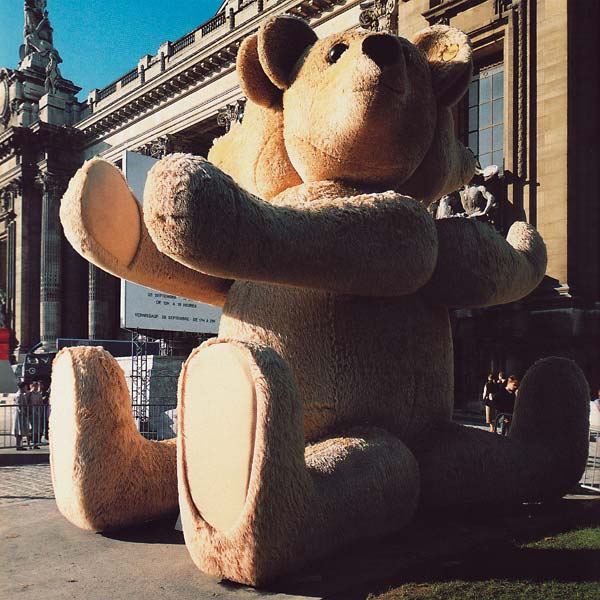
Charlemagne Palestine
Godbear
Label: Black Truffle
Format: LP
Catalogue Number: BT019
Official web site: blacktruffle.bandcamp.com/album/godbear
Description
The first vinyl release of Charlemagne Palestine‘s Godbear, a 1987 solo piano recording originally scheduled to sit alongside Sonic Youth and Swans in the catalogue of Glenn Branca‘s Neutral Records but eventually released on CD by the Dutch Barooni label in 1998. Although Palestine has worked in an enormous variety of media, his long form performances for solo piano are perhaps his most acclaimed works. Palestine immersed himself in the study of overtones throughout the 1960s, working first with carillons and then with electronic synthesis, searching for the ‘golden sound’. Beginning in the early 1970s he continued his exploration of the complexities hidden within seemingly simple tones and intervals on the Bösendorfer Imperial Grand Piano, the ‘Rolls Royce’ of pianos. With the piano’s sustain pedal constantly depressed, Palestine hammers out rapidly repeated notes, allowing a complex cloud of overtones to rise above the percussive texture of the struck keys. Initially working with simple intervals such as octaves and fifths, Palestine gradually expanded the harmonic range of his piano performances over the years, while still retaining their ecstatically single-minded nature. Revisiting his signature piano style in 1987 after several years focusing on visual art, Godbear presents three distinct variations that demonstrate the development of his piano music after the classic recordings of the early 1970s.
Occupying the entire first side, The Lower Depths stages a slow descent from the piano’s mid-range to the Bösendorfer’s cavernous additional low octave, building into a thundering swarm of booming overtones. Breaking entirely with the stereotype of clinical minimalism, Palestine’s journey to the depths embraces passages of darkly romantic melody before slowly ascending to its starting point. The version of Strumming Music performed here condenses the developmental arc of the piece into eleven minutes, fanning out from a single octave to a complex harmonic wash that calls to mind Palestine’s enthusiasm for Debussy and Ravel. Timbral Assault is like an evil twin of Strumming Music, transforming its insistency and harmonic complexity into aggressive intensity and creeping dissonance, foreshadowing Palestine’s later collaborations with Christoph Heemann. A classic release, and one that, because of the variety of approaches surveyed within, serves as an ideal introduction to Palestine’s ecstatic and mysterious sound world” —Francis Plagne.
Remastered and cut by Rashad Becker at Dubplates & Mastering, Berlin. Presented in a deluxe gatefold sleeve designed by Stephen O’Malley.
The first vinyl release of Charlemagne Palestine‘s Godbear, a 1987 solo piano recording originally scheduled to sit alongside Sonic Youth and Swans in the catalogue of Glenn Branca‘s Neutral Records but eventually released on CD by the Dutch Barooni label in 1998. Although Palestine has worked in an enormous variety of media, his long form ...
read more…
Tracklisting
- The Lower Depths
- Strumming Music
- Timbral Assault
Available from these fine distributors:
- USA – Forced Exposure www.forcedexposure.com
- Europe – Kompakt www.kompakt.fm/labels/black_truffle
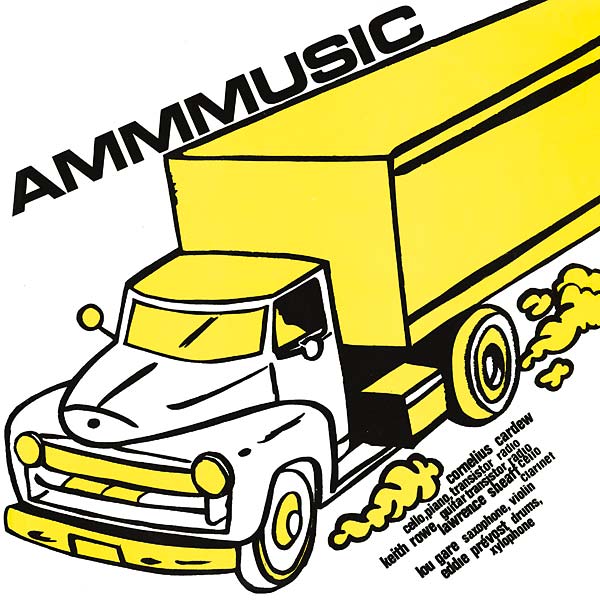
AMM
AMMMUSIC
Label: Black Truffle
Format: LP
Catalogue Number: BT018
Official web site: kompakt.fm/releases/ammmusic
Description
Black Truffle is honoured to present the first vinyl reissue of the classic debut album from AMM, AMMMusic. Coinciding with the 50th anniversary of its recording in 1966, this reissue makes one of the cornerstones of the experimental music tradition available again in its original form, replete with Keith Rowe’s beautiful pop art cover and the terse aphorisms by the group that served as its original liner notes. A testament to the interaction between the experimental avant-garde and the countercultural underground, the album was originally released on Elektra, recorded by Jac Holzman (the label’s founder, responsible for signing The Doors, Love, and The Stooges) and produced by DNA, a group that included Pink Floyd‘s first manager Peter Jenner. (Pink Floyd paid tribute to AMM’s influence on their improvisational sensibility with the track ‘Flaming’ on their debut album, named after the piece that occupies AMMMusic’s first side, ‘Later During a Flaming Riviera Sunset’).
Formed in 1965 by three players from the emerging British jazz avant-garde – Keith Rowe and Lou Gare had played with the great progressive big band leader Mike Westbrook and Eddie Prévost played in a post-bop group with Gare – AMM quickly evolved from a free jazz group into something decidedly more difficult to categorise. By the time these recordings were made, two more members had joined the group: another Westbrook associate, Lawrence Sheaf, and the radical composer Cornelius Cardew. Then at work on his masterpiece of graphic notation Treatise, Cardew brought with him extensive experience of the post-serialist and Cageian currents in contemporary composition. Using a combination of conventional instruments and unconventional methods of sound production (most famously Keith Rowe’s prepared tabletop guitar, but also prepared piano and transistor radio), the group performed improvised pieces often running for over two hours and ranging from extended periods of silence to terrifying cacophonies.
Evan Parker famously described the improvisational logic of AMM’s music as ‘laminal’, in contrast to the ‘atomistic’ approach more common among the generation of British improvisers (Bailey, Rutherford, Stevens and co.) to which he himself belonged. AMM improvised in layers: layers of sound subtly rising and falling or abruptly starting and stopping without being propelled by the implied pulse of free jazz improvisation. Rather than a pulse, AMM’s music began with the sound of the room in which it was played, the Cageian anarchy of silence. By embracing the non-synchronous simultaneity of layered sound, AMM was able to create a musical container into which nearly anything could be incorporated at any moment: on AMMMusic, long tones sit next to abrasive thuds, the howl of uncontrolled feedback accompanies Cardew’s purposeful piano chords, radios beam in snatches of orchestral music (and, on the LP’s second side, an extended fragment of ‘Mockingbird’).
AMM’s clearest break with jazz-based improvisation concerned the idea of individuality. Where improvised music has tended to foster the development of idiosyncratic stylists who move freely from one group to another, AMM, initially through an engagement with eastern philosophy and mysticism and later though a politicized communitarianism, sought to develop a collective sonic identity in which individual contributions could barely be discerned. In the performances captured on AMMMusic the use of numerous auxiliary instruments and devices, including radios played by three members of the group, contribute to the sensation that the music is composed as a single monolithic object with multiple facets, rather than as an interaction between five distinct voices.
– Francis Plagne
Remastered and cut by Rashad Becker at D&M Berlin and presented in an exact replica sleeve of the original 1966 release by Stephen O’Malley.
Black Truffle is honoured to present the first vinyl reissue of the classic debut album from AMM, AMMMusic. Coinciding with the 50th anniversary of its recording in 1966, this reissue makes one of the cornerstones of the experimental music tradition available again in its original form, replete with Keith Rowe’s beautiful pop art cover and ...
read more…
Tracklisting
- Later During A Flaming Riviera Sunset
- After Rapidly Circling The Plaza
Available from these fine distributors:
- USA – Forced Exposure www.forcedexposure.com
- Europe – Kompakt www.kompakt.fm/labels/black_truffle
- Europe – Metamkine www.metamkine.com
- UK – Boomkat www.boomkat.com
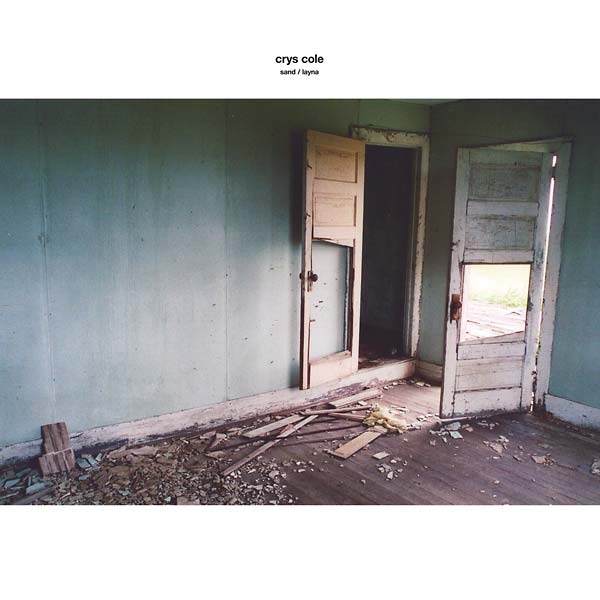
crys cole
Sand / Layna
Label: Black Truffle
Format: LP
Catalogue Number: BT017
Official web site: blacktruffle.bandcamp.com/album/sand-layna-2
Description
Sand/Layna is the first full-length solo release by Canadian sound artist crys cole. While cole is known to many through her collaborative work with a host of Canadian artists and internationals such as Oren Ambarchi, Keith Rowe, and James Rushford, this LP presents the first opportunity for an extended appreciation of her singular approach to amplified sound. Using contact and other microphones to amplify her interactions with small objects and the surfaces on which they rest, cole’s work exists in a lineage of heavily amplified ‘small sound’ that stretches back to Cage‘s Cartridge Music. cole’s approach to these materials and techniques is distinguished by its single-mindedness: rather than simply searching for interesting or attractive sounds, her performances attempt to illuminate the sonic properties of the specific objects and amplification devices she uses. Devoid of looping and complex processing, the sonic outcome of her work always retains an audible link to the handling of microphones and what they amplify. The awkward and sometimes even ‘ugly’ sounds of manipulated microphones and recording equipment thus sit comfortably alongside the mysterious crackle of amplified salt and the deep, musical resonance of a rubbed tabletop. This LP presents two pieces, recorded almost ten years apart. Sand, recorded in 2004, crafts a sustained texture from rubbed surfaces that transcends academic sound art tropes to recall the haunted environments of Massimo Toniutti and Small Cruel Party. The seemingly static structure of the piece allows the multitude of dynamic and timbral variations caused by the basic instability of cole’s sound sources to come to the fore. In contrast, Layna, constructed between 2012 and 2013, lets loose a volatile stream of microscopic activity. Adding extremely amplified voice and domestic field recordings to the mix, the piece inhabits a space of bodily, almost sensual intimacy, moving beyond the Cageian tradition of small sounds to somewhere uncomfortably human” —Francis Plagne, Melbourne, January 2015.
Artwork design by Lasse Marhaug.
Vinyl cut made by Rashad Becker at Dubplates & Mastering, Berlin. LP-only release; edition of 300.
*Due to an error with the labels this LP should be played at 45rpm*
Sand/Layna is the first full-length solo release by Canadian sound artist crys cole. While cole is known to many through her collaborative work with a host of Canadian artists and internationals such as Oren Ambarchi, Keith Rowe, and James Rushford, this LP presents the first opportunity for an extended appreciation of her singular approach to ...
read more…
Tracklisting
- Sand
- Layna
Available from these fine distributors:
- USA – Forced Exposure www.forcedexposure.com
- Europe – Kompakt www.kompakt.fm/labels/black_truffle
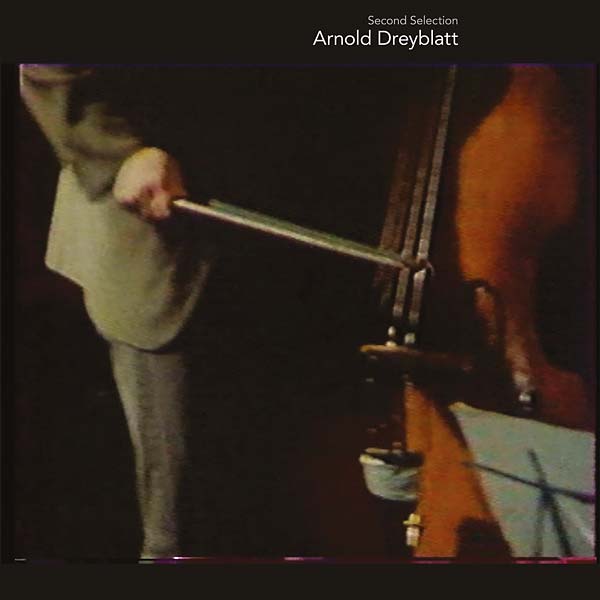
Arnold Dreyblatt
Second Selection
Label: Black Truffle
Format: 2LP
Catalogue Number: BT016
Official web site: arnolddreyblatt.bandcamp.com/album/second-selection
Description
Black Truffle is honored to present a major collection of archival recordings by seminal minimalist composer, performer, instrument builder and visual artist Arnold Dreyblatt. Following on from the archival compilation Choice (Choose Records, 2013), Second Selection presents eleven pieces selected by Oren Ambarchi from Dreyblatt’s extensive archive of previously unreleased recordings. Recorded in beautifully varying fidelity between 1978 and 1989, the pieces range from solo works to documents of various iterations of Dreyblatt’s long running Orchestra of Excited Strings. The ensemble pieces here possess the singular, hypnotic quality of Dreyblatt’s vintage work, underpinning the shimmering overtones of his self-devised twenty note microtonal scale with primordial, thudding rhythms that undergo surprising but economical shifts in group dynamics and sonic density. Like the court music of some imaginary ancient civilization, this music unfolds unhurriedly, relinquishing traditional melodic and harmonic movement in favor of a single-minded search for the world of sound inherent in a single string. There is much to wonder over here for the Dreyblatt connoisseur, including variants of pieces found on classics such as Nodal Excitation and Propellers in Love. But Second Selection also unearths some elements of Dreyblatt’s work that have gone undocumented until now, including an incredible pair of solo pieces for modified electric guitar and electronics performed in Europe in 1988. The second of these, Luftmenschen II, has to be heard to be believed, consisting of 15 minutes of insistent and frenetic rhythmic irregularity sourced to multiple electric guitars run through a digital noise gate controlled by a recording of malfunctioning escalators. Second Selection is presented as a high-spec gatefold double LP with archival liner notes including contemporaneous selections from Dreyblatt’s notebooks and an early conversation between Dreyblatt and Phill Niblock. This is both a gold mine for long-term fans and an ideal introduction for those still awaiting initiation into Dreyblatt’s rapturous science of the string. These are stunning examples of one of the most unique and fully realized sound-worlds of contemporary music; as Dreyblatt always recommends, they are best experienced at maximum volume!” — Francis Plagne.
Artwork design by Stephen O’Malley. Vinyl cut made by Rashad Becker at Dubplates & Mastering, Berlin.
Black Truffle is honored to present a major collection of archival recordings by seminal minimalist composer, performer, instrument builder and visual artist Arnold Dreyblatt. Following on from the archival compilation Choice (Choose Records, 2013), Second Selection presents eleven pieces selected by Oren Ambarchi from Dreyblatt’s extensive archive of previously unreleased recordings. Recorded in beautifully varying ...
read more…
Tracklisting
- Lucky Stryke
- Harmonics
- Dronetones
- Nodal Excitation
- Damping Influence
- Bebop Pump
- The Odd Fellows
- Luftmenschen I
- Strike Out
- Hilife
- Luftmenschen II
Available from these fine distributors:
- USA – Forced Exposure www.forcedexposure.com
- Europe – Kompakt www.kompakt.fm/labels/black_truffle
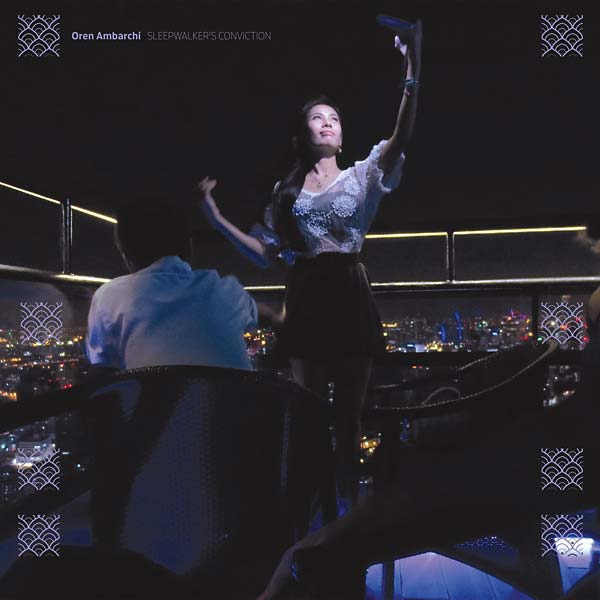
Oren Ambarchi
Sleepwalker’s Conviction
Label: Black Truffle
Format: LP
Catalogue Number: BT015
Official web site: orenambarchi.bandcamp.com/album/sleepwalkers-conviction
Description
Sleepwalker’s Conviction documents a 2014 performance by Oren Ambarchi in collaboration with a 20-piece ensemble conducted by Ilan Volkov and featuring members of the Adelaide Symphony Orchestra and Speak Percussion. Foregoing the rhythmic propulsion and distortion-saturated harmonics that have featured in much of Ambarchi’s recent work, the LP’s single 40-minute piece inhabits a hushed, almost static space of extended tones, percussive shimmer, and creaking strings. Rather than adopting the position of a soloist, Ambarchi allows his sub-bass guitar tones and swirling Leslie textures to blend seamlessly with the ensemble, made up of double basses, horns, and percussion. The group sound has a near-cavernous depth, as waves of low beating tones and distant percussive textures gently wash over one another, coalescing into an undulating mass. Steering clear of bombast and new music clichés, the result is a work of meditative beauty that touches on the haunted ambience of late Luigi Nono, the submerged sonics of Bryars‘s The Sinking of the Titanic, and the melancholy rituals of Christoph Heemann and Andrew Chalk‘s Mirror, while remaining unmistakably marked by the singular sensibility Ambarchi has developed over countless performances and recordings —Francis Plagne.
Design by Stephen O’Malley with cover artwork by crys cole. Vinyl cut made by Rashad Becker at Dubplates & Mastering, Berlin. Edition of 300.
Sleepwalker’s Conviction documents a 2014 performance by Oren Ambarchi in collaboration with a 20-piece ensemble conducted by Ilan Volkov and featuring members of the Adelaide Symphony Orchestra and Speak Percussion. Foregoing the rhythmic propulsion and distortion-saturated harmonics that have featured in much of Ambarchi’s recent work, the LP’s single 40-minute piece inhabits a hushed, almost static space of extended tones, percussive shimmer, and ...
read more…
Tracklisting
- Sleepwalker's Conviction Part 1
- Sleepwalker's Conviction Part 2
Available from these fine distributors:
- USA – Forced Exposure www.forcedexposure.com
- Europe – Kompakt www.kompakt.fm/labels/black_truffle
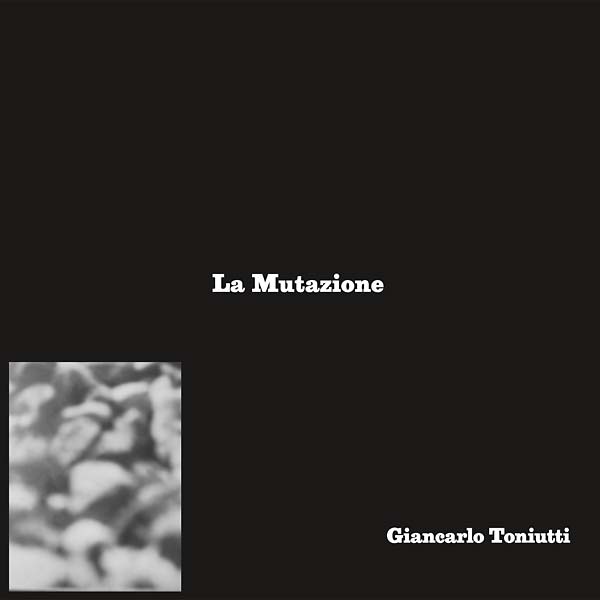
Giancarlo Toniutti
La Mutazione
Label: Black Truffle
Format: LP (w/bonus CD)
Catalogue Number: BT014
Official web site: www.quasi-rn.org
Description
A milestone originally released in 1985 on the legendary Broken Flag label, Giancarlo Toniutti‘s La Mutazione is renowned in certain circles as a classic and with good reason. The album comprises two subtle and haunting side-long explorations of dark cosmic electronics akin to Klaus Schulze, Cluster, Tangerine Dream, and Conrad Schnitzler filtered through the lens of Maurizio Bianchi, Whitehouse, Nurse With Wound, and The New Blockaders. At the time, Toniutti had just enrolled at the Venice Conservatory of Music with a heady amount of education in Stockhausen, Schaeffer, et al. These three musical poles come together in this beautiful and unsettling construction of layered static, analog synth explorations, concrete sounds, and field recordings. This limited edition reissue is an exact replica of the original Broken Flag LP release, with remastered audio and an inner sleeve containing archival photos and sketches from the period in which the work was created. This edition also includes a bonus CD of unreleased material from Toniutti’s cassette archive featuring a collage of sound sketches recorded during the same time period, thus giving the listener a wider view into the sound-world that helped form La Mutazione. Black Truffle is proud to present La Mutazione on vinyl for the first time since its original 1985 issue. A landmark release, its influence is still being felt throughout the dark corners of experimental music.
A milestone originally released in 1985 on the legendary Broken Flag label, Giancarlo Toniutti‘s La Mutazione is renowned in certain circles as a classic and with good reason. The album comprises two subtle and haunting side-long explorations of dark cosmic electronics akin to Klaus Schulze, Cluster, Tangerine Dream, and Conrad Schnitzler filtered through the lens of Maurizio Bianchi, Whitehouse, Nurse With Wound, and The New ...
read more…
Tracklisting
- The Tree
- Nekrose
- The questionable hat come pesare l'amo sulla spalla (bonus CD track)
Available from these fine distributors:
- USA – Forced Exposure www.forcedexposure.com
- Europe – Kompakt www.kompakt.fm/labels/black_truffle
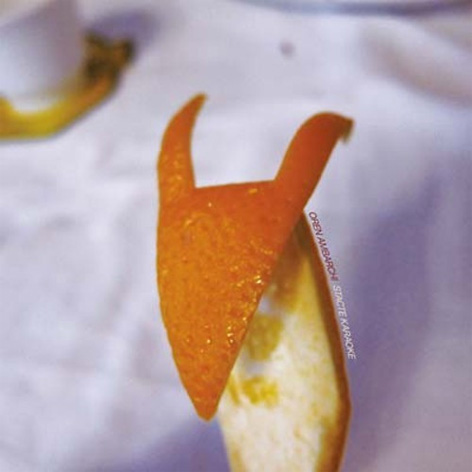
Oren Ambarchi
Stacte Karaoke
Label: Black Truffle
Format: 12"
Catalogue Number: BT013
Official web site: orenambarchi.bandcamp.com/album/stacte-karaoke
Description
Two raw, ecstatic, face-melting guitar solos recorded in one take in the Ambarchi “Stacte tradition.”
This time around, Ambarchi is backed up by a badass rhythm section from Texas, and together they ride the endless riff into the goddamn sunset.
Two raw, ecstatic, face-melting guitar solos recorded in one take in the Ambarchi “Stacte tradition.” This time around, Ambarchi is backed up by a badass rhythm section from Texas, and together they ride the endless riff into the goddamn sunset.
read more…
Tracklisting
- Milk a cow with a monkey wrench
- Park it where the sun don't shine
Available from these fine distributors:
- USA – Forced Exposure www.forcedexposure.com
- Europe – Kompakt www.kompakt.fm/labels/black_truffle
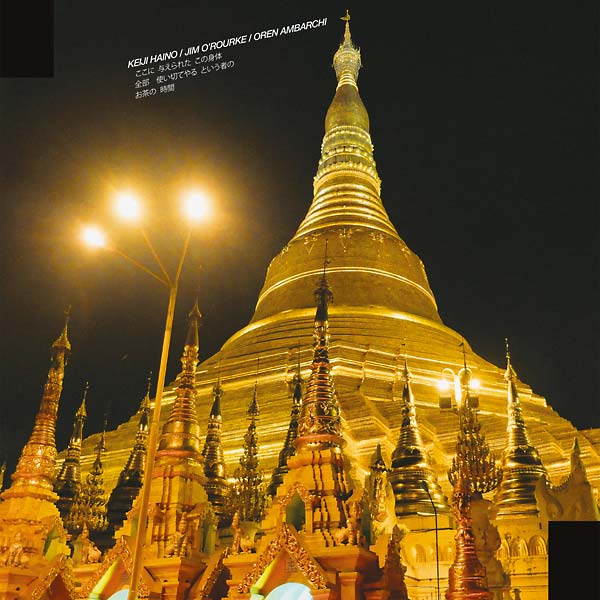
Keiji Haino / Jim O'Rourke / Oren Ambarchi
tea time for those determined to completely exhaust every bit of this body they’ve been given
Label: Black Truffle
Format: LP
Catalogue Number: BT012
Official web site: orenambarchi.bandcamp.com/album/tea-time-for-those-determined-to-completely-exhaust-every-bit-of-this-body-theyve-been-given
Description
At this point, it can justifiably be said that Keiji Haino, Jim O’Rourke and Oren Ambarchi have become one of the leading groups in experimental music. This, their sixth release, presents the entire second set of the trio’s March 2013 concert at SuperDeluxe (the first set is available on Black Truffle as ‘only wanting to melt beautifully away is it a lack of contentment that stirs affection for those things said to be as of yet unseen’). While the first set of the evening saw the trio branching out into new instrumental configurations, here they return to their signature line-up of guitar, bass and drums.
The LP begins abruptly, with one of the finest performances by the trio captured on record thus far already in full swing. Throughout the course of this 12 minute piece, O’Rourke and Ambarchi lay down a thudding meterless pulse, the impossible midway point of Milford Graves and motorik Krautrock, over which Haino unfurls a number of distinct strategies developed in his work since the 1980s: formless blurs of reverb-drenched guitar noise, looped pointillist fragments and wandering, dissonant lines obscured in clouds of distortion. Continuing Haino’s habit of naming albums with phrases that seem to obliquely comment on the music they contain, it could definitely be said that this is music made by three people ‘determined to completely exhaust every bit of this body they’ve been given’. Showing the trio at new heights, this track carries on in the spirit of some of Haino’s greatest work: music made with the ingredients of rock that somehow manages to sidestep all of its forms and traditions while retaining and amplifying its fundamental power.
If this track alone lays to rest concerns about whether the trio has exhausted the guitar/bass/drums format, the remainder of the record serves as a demonstration of the multitude of possibilities still available for their continued exploration. The three are now so in-tune with one another that almost anything can be integrated into their improvisations: in the slow-burning second piece, O’Rourke’s heavily effected bass wanders from anti-music thuds to an almost funky passage with Ambarchi sounding not unlike Buddy Miles circa Hendrix‘s Band of Gypsys – it bespeaks the hours of listening to fusion and classic rock that continue to form an important part of O’Rourke and Ambarchi’s musical personalities.
The final piece is a continuous side-long performance that moves through a number of discrete episodes, from vocal and flute solos by Haino delicately accompanied by O’Rourke’s sparse bass and Ambarchi’s sizzling cymbals, to a final stumbling dirge over which Haino unleashes a stunning torrent of in-the-red guitar skree.
Francis Plagne
Released as a limited edition LP. Design by Stephen O’Malley with high quality live shots by Ujin Matsuo and stunning artwork by Norwegian noise legend Lasse Marhaug.
At this point, it can justifiably be said that Keiji Haino, Jim O’Rourke and Oren Ambarchi have become one of the leading groups in experimental music. This, their sixth release, presents the entire second set of the trio’s March 2013 concert at SuperDeluxe (the first set is available on Black Truffle as ‘only wanting to ...
read more…
Tracklisting
- i don’t want to drink tea so tastelessthat even the intent to kill will not come to mindwhile drinking
- let’s make it a bit thickerand drink it as"n e v e r g i v e u p"
- after drinkingonce again considerthe brutality of prayer
Available from these fine distributors:
- USA – Forced Exposure www.forcedexposure.com
- Europe – Kompakt www.kompakt.fm/labels/black_truffle
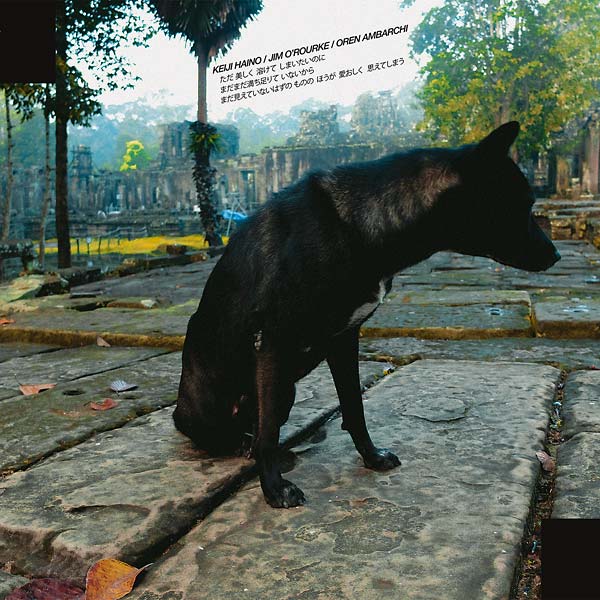
Keiji Haino / Jim O’Rourke / Oren Ambarchi
Only Wanting To Melt Beautifully Away Is It A Lack Of Contentment That Stirs Affection For Those Things Said To Be As Of Yet Unseen
Label: Black Truffle
Format: LP + CD
Catalogue Number: BT011
Official web site: orenambarchi.bandcamp.com/album/only-wanting-to-melt-beautifully-away-is-it-a-lack-of-contentment-that-stirs-affection-or-those-things-said-to-be-as-of-yet-unseen
Description
Begun as a one-off collaboration in 2009, the trio of Keiji Haino, Jim O’Rourke and Oren Ambarchi has now become a solid working group, refining its craft through a series of annual concerts at Tokyo’s legendary SuperDeluxe. Much of their recorded work has focused on their intense, ritualistic take on the rock power trio of electric guitar, bass and drums. Presenting the entire first set of the trio’s March 2013 concert at SuperDeluxe (the second set will follow on Black Truffle later this year), Only Wanting to Melt Beautifully Away Is It a Lack of Contentment That Stirs Affection for Those Things Said to Be as of Yet Unseen is their fifth release and blows the instrumental palette wide open for a single continuous piece focused on acoustic strings, synth, flute and percussion. Featuring one of Haino’s most delicate and moving recorded vocal performances, the opening section of the record takes the form of a spare duet between O’Rourke’s 12-string acoustic guitar and Haino’s kantele (a Finnish variant of the dulcimer), behind which Ambarchi provides a hovering backdrop of wine glass tones. While on previous releases the listener has often sensed that Haino was firmly in the driver’s seat, here O’Rourke takes center stage with an acoustic guitar performance that takes the lyricism of John Abercrombie or Ralph Towner and refracts it through the free improvisation tradition of his mentors Derek Bailey and Henry Kaiser. The atmosphere of meditative, abstracted song is reminiscent of some of Haino’s greatest recordings, such as the legendary Live in the First Year of the Heisei volumes recorded with Kan Mikami. After this stunningly beautiful opening sequence, the performance moves organically through a number of episodes, including a dramatic central passage in which Haino moves to synth and drum machine, crafting a current of raw electricity that unfurls slowly over the gently pulsing foundations of Ambarchi’s cymbals and builds to heights of manic intensity. When Haino later turns to wooden flute, Ambarchi answers him with nimble hand-drummed percussion in a passage that calls to mind Don Cherry‘s liberated combination of free-jazz improvisation and non-Western musics. The trio’s move away from the power trio dynamic bespeaks a risk-taking and questing spirit that refuses to be satisfied with repeating past glories, and yet the organic, immersive flow of this single improvisation attests to the intuitive bond that has formed between them over the last five years. Exuding the signature mystery and emotion of Haino’s greatest works, this release is perhaps the strongest statement yet from this acclaimed trio, and holds out a tantalizing promise for everyone hooked on their continuing exploration of ‘those things said to be as of yet unseen. –Francis Plagne
Released as a digipak CD and as limited edition LP with a printed inner sleeve. Design by Stephen O’Malley with high quality live shots by Ujin Matsuo and stunning artwork by Norwegian noise legend Lasse Marhaug.
Begun as a one-off collaboration in 2009, the trio of Keiji Haino, Jim O’Rourke and Oren Ambarchi has now become a solid working group, refining its craft through a series of annual concerts at Tokyo’s legendary SuperDeluxe. Much of their recorded work has focused on their intense, ritualistic take on the rock power trio of ...
read more…
Tracklisting
- Only Wanting To Melt Beautifully Away Is It A Lack Of Contentment That Stirs Affection For Those Things Said To Be As Of Yet Unseen
Available from these fine distributors:
- USA – Forced Exposure www.forcedexposure.com
- Europe – Kompakt www.kompakt.fm/labels/black_truffle
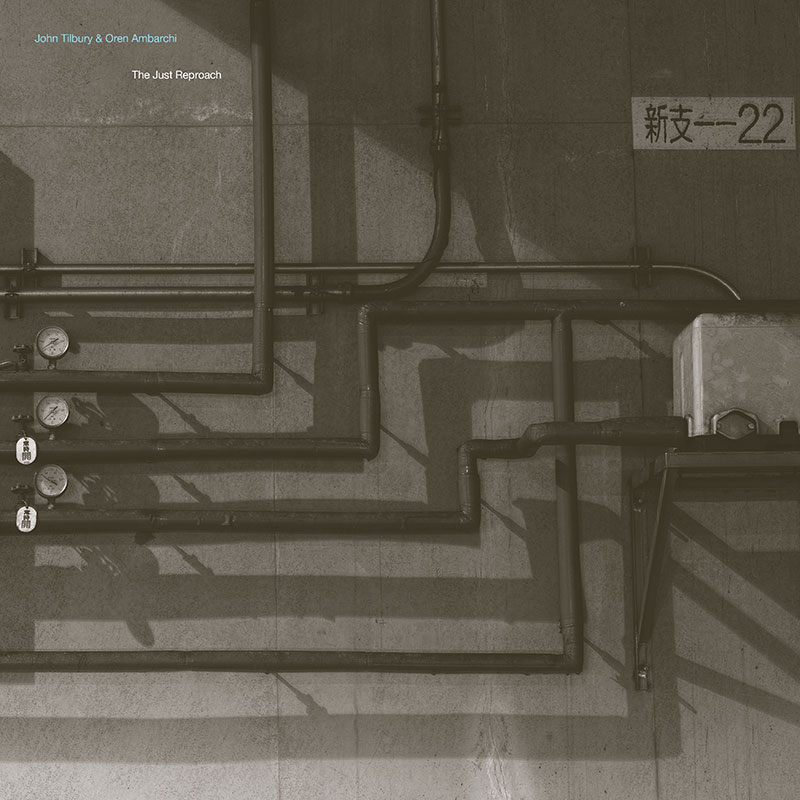
John Tilbury & Oren Ambarchi
The Just Reproach
Label: Black Truffle
Format: LP
Catalogue Number: BT10
Official web site: orenambarchi.bandcamp.com/album/the-just-reproach
Description
The Just Reproach documents the second concert given by John Tilbury and Oren Ambarchi as a duo. When they first performed together in Reykjavik, Iceland in March 2012, the aptness of the pairing was evident. When they reprised the duo at London’s Cafe OTO in September the same year in the concert presented here, the city was in the midst of a heatwave. With the air-conditioning turned off to accommodate the low volume of the performance, the uncomfortable squirming of the audience members in their sweaty chairs becomes, alongside the occasional dropped glass and cough, an additional sonic element in the duo’s performance, providing a randomised accompaniment to the duo’s careful exploration of tonal and textural minutiae.
As always, Tilbury displays a remarkable sensitivity and inquisitiveness, investigating the unique character of specific harmonic intervals through iteration and slight variation in a way that displays the same remarkable care for the individual sonic event that he found many years ago in Webern’s Variations for piano. In Webern, Tilbury found a freedom from harmonic context that allowed normally jarring dissonances to appear ‘warm, even sensuous’ because they were transformed into timbres, into pure sounds rather than relational harmonic values. This same concentration on every individual sound allows Tilbury to breathe new life into a tap on the piano’s strings, a simple sequence of descending notes or even a commonplace consonance. Indeed, there are moments of simple beauty in The Just Reproach that remind us that, in addition to his devotion to the work of Morton Feldman, Tilbury is also the major interpreter of the piano music of Howard Skempton, with its reduced folk-forms and static airs.
Ambarchi’s guitar does not simply provide the steady backdrop for Tilbury’s articulations that we might expect, but rather engages in a more complex interaction. Gentle swells of tones, sometimes supporting Tilbury’s iterations, at other times complicating them, alternate with occasional bursts of abstract electricity. Ambarchi constantly moves his sounds around between multiple amplifiers and a Leslie cabinet to produce a subtle yet environmental whole, interacting both with Tilbury and the sound of the room, edging forwards into a clear sonic presence before dispersing back into silence. Despite the hushed nature of the performance, Ambarchi’s signature sub-bass tones are not absent, but in fact form an essential part of the texture woven by the two musicians, taking on an ominous quality like the distant rumblings of a helicopter through the night sky.
Far from a simple exercise in reductionism, the reduced volume of the duo’s performance acts like a microscope focussing the audience on an incredibly rich palette of sonic details. Like in the late works of Morton Feldman, a seeming homogeneity to the proceedings reveals itself on closer inspection to be a ceaseless investigation and reconfiguration of sonic events, allowing the listener to move freely between the lushness and warmth of the sounds themselves and the questioning, non-linear forms Tilbury and Ambarchi spontaneously construct from them.
Francis Plagne
Deluxe limited edition vinyl designed by Stephen O’Malley with stunning artwork by Shunichiro Okada
The Just Reproach documents the second concert given by John Tilbury and Oren Ambarchi as a duo. When they first performed together in Reykjavik, Iceland in March 2012, the aptness of the pairing was evident. When they reprised the duo at London’s Cafe OTO in September the same year in the concert presented here, the ...
read more…
Tracklisting
- The Just Reproach Pt.1
- The Just Reproach Pt.2
Available from these fine distributors:
- USA – Forced Exposure www.forcedexposure.com
- Europe – Kompakt www.kompakt.fm/labels/black_truffle

Keiji Haino / Jim O’Rourke / Oren Ambarchi
Now While It Is Still Warm Let Us Pour In All The Mystery
Label: Black Truffle
Format: LP + CD
Catalogue Number: BT09 (LP) + BT09 (CD)
Official web site: orenambarchi.bandcamp.com/album/now-while-its-still-warm-let-us-pour-in-all-the-mystery
Description
Following on from last year’s acclaimed Imikizushi (BT07), Now while it is still warm let us pour in all the mystery is the fourth release from the established power trio of Keiji Haino, Jim O’Rourke and Oren Ambarchi, recorded in January 2012 at their yearly concert at SuperDeluxe, Tokyo. While the trio’s two previous double LP releases featured sprawling, side-long performances, the music here is presented in six shorter pieces, each one displaying a different side of the trio’s interactions, from holy minimalism to cave-man rock.
The record begins with the trio joined by special guests Charlemagne Palestine and Eiko Ishibashi, conjuring ghostly tones from wine glasses as an accompaniment to Haino’s angelic vocals. This ten-minute piece, which moves from near silence and the sound of onstage footsteps to a stunning passage of clean guitar work from Haino, is steeped in the same mysterious atmospherics as Haino’s great folk-drone project, Nijumu. When Haino turns to the flute on the LP’s second track, a performance that clearly demonstrates the importance of the special concept of space and silence (ma) that Haino has developed from traditional Japanese aesthetics, O’Rourke and Ambarchi transform into the delicate and probing rhythm section of a classic 70s fusion side.
When the trio return to the crushing free-rock of their last two records, O’Rourke’s heavily effected bass rolling alongside Ambarchi’s tumbling rhythms as Haino’s guitar squeals and slashes above them, their performances display a new purposefulness and concision. Now truly operating as a band after a number of years of playing together, the pieces here feel like instant rock songs, O’Rourke and Ambarchi instantly locking into solid riffs over which Haino alternates between jarring no-wave chords, intense soloing and his signature vocalisations. When the trio slow down and stretch out, the rhythm section plods like an abstracted Crazy Horse on the brink of collapse, and Haino elicits long, mournful solos reminiscent of the first classic Fushitshusha double live LP.
Perhaps more accessible than the trio’s previous recordings because of its range and concision, Now while it is still warm let us pour in all the mystery exudes the dark, alien quality of Haino’s greatest recordings and testifies to the strength of the musical bond that has developed between these three players.
Francis Plagne, Jan 2013.
Released as a 6 panel digipak CD and as limited edition LP in a lavish gatefold with a printed inner sleeve.
Design by Stephen O’Malley with high quality live shots by Ujin Matsuo and stunning artwork by Shunichiro Okada.
Following on from last year’s acclaimed Imikizushi (BT07), Now while it is still warm let us pour in all the mystery is the fourth release from the established power trio of Keiji Haino, Jim O’Rourke and Oren Ambarchi, recorded in January 2012 at their yearly concert at SuperDeluxe, Tokyo. While the trio’s two previous double ...
read more…
Tracklisting
- once again i hear the beautiful vertigo… luring us to "do something, somehow"
- who would have thought this callous history would become my skin
- Only the winding "why" expresses anything clearly
- A new radiance springing forth from inside the light
- even that still here and unwanted can you and i love it? just like us it was born here too
- now while it’s still warm let us pour in all the mystery
Available from these fine distributors:
- USA – Forced Exposure www.forcedexposure.com
- Europe – Kompakt www.kompakt.fm/labels/black_truffle

Merzbow & Oren Ambarchi
Cat’s Squirrel
Label: Black Truffle
Format: LP
Catalogue Number: BT08
Official web site: orenambarchi.bandcamp.com/album/cats-squirrel
Description
Cat’s Squirrel presents a live recording of Masami Akita and Oren Ambarchi’s performance in Campbelltown, Australia in May 2012. Although Akita and Ambarchi have known one another since 1993 and performed together as part of larger ensembles, this was their first performance as a duo. Together they create a massive wall of sound that moves from the cavernous to the blisteringly psychedelic, laying down shifting low-end structures over which pointillist details ricochet across the stereo field. Akita and Ambarchi’s voices blend together into a sonic morass, Ambarchi’s set-up expanded to include extra electronics and a spring reverb unit in addition to his signature guitar textures, and Akita utilizing both analogue and digital sound sources. Moving through a number of episodes, from deluges of reverberated metal screeches to rapid-fire iterations of visceral electronic tones, the record reaches a high point mid way through the second side, where Akita’s electronics gradually thin out into a stream of skipping chirps and screeches while around him Ambarchi builds up a dense mass of phasing low end guitar tones, the duo patiently developing an impenetrable wall of ecstatic, psychedelic noise.
Francis Plagne, Jan 2013
Deluxe, limited edition vinyl with artwork by Shunichiro Okada and design by Stephen O’Malley.
Cat’s Squirrel presents a live recording of Masami Akita and Oren Ambarchi’s performance in Campbelltown, Australia in May 2012. Although Akita and Ambarchi have known one another since 1993 and performed together as part of larger ensembles, this was their first performance as a duo. Together they create a massive wall of sound that moves ...
read more…
Tracklisting
- Cat’s Squirrel Pt.1
- Cat’s Squirrel Pt.1
Available from these fine distributors:
- USA – Forced Exposure www.forcedexposure.com
- Europe – Kompakt www.kompakt.fm/labels/black_truffle
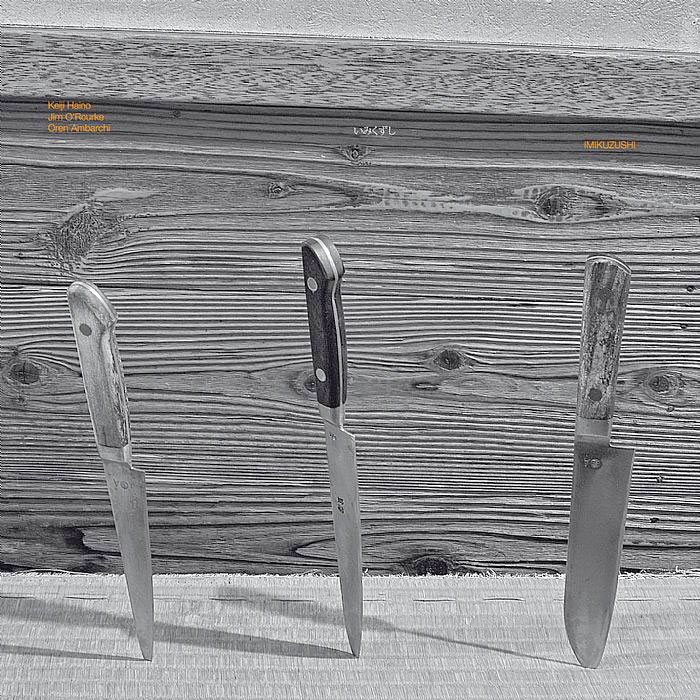
Keiji Haino / Jim O’Rourke / Oren Ambarchi
Imikuzushi
Label: Black Truffle
Format: 2xLP + CD
Catalogue Number: BT07 (2LP) + BT07 (CD)
Official web site: orenambarchi.bandcamp.com/album/imikuzushi
Description
The yearly summit of Keiji Haino, Jim O’Rourke and Oren Ambarchi continues with Imikuzushi, which finds the group extending the power-trio strategies of last year’s highly praised In a flash everything comes together as one there is no need for a subject (BT05) and bringing to them a newly sustained intensity. For this performance, Haino limits himself to electric guitar and vocals, forming complex networks of slashing rhythm work, noise squall and chromatic shredding, moving at times to near-silent passages of howled vocals and isolated, hanging guitar strums. The tendency towards driving free-rock which surfaced on moments of the trio’s last release is cemented here, with O’Rourke’s fuzzed-out, non-linear bass riffing moving the music into almost garage-rock areas, combining with Ambarchi’s drums to form a bedrock of hypnotic, metronomic pounding which transforms itself effortlessly into passages of flowing free-time.
Like all of Haino’s best work, the trio transcends any ‘rock’ genre exercise to enter a non-idiomatic zone of ritual intensity, creating a music formed purely out of instrumental and group-mind possibility. Presented as four unedited excerpts salvaged from an epic show that lasted well over three hours, the sometimes raw nature of the recording only adds to its directness and harshly emotive quality.
Francis Plagne, Melbourne, Nov, 2011
Released as a 6 panel digipak CD and as a limited edition double LP in a lavish gatefold with printed inner sleeves. Design by Stephen O’Malley with high quality live shots by Ujin Matsuo and stunning images by Tokyo based photographer and sound artist Shunichiro Okada
The yearly summit of Keiji Haino, Jim O’Rourke and Oren Ambarchi continues with Imikuzushi, which finds the group extending the power-trio strategies of last year’s highly praised In a flash everything comes together as one there is no need for a subject (BT05) and bringing to them a newly sustained intensity. For this performance, Haino ...
read more…
Tracklisting
- still unable to throw off that teaching a heart left abandoned unable to get inside that empty space nerves freezing that unconcealed sadness…
- ready and waiting ready and tired of waiting this happiness hovers for a while opaque…
- invited in practically drawn in by something facing the exit of this hiding place who is it? that went in…
- an acute sensitivity is not simply a "madness" an acute sensitivity to the resonance of "i love you" teaches us just a little something it’s not that we can’t do something it’s just that we haven’t done it yet…
Available from these fine distributors:
- USA – Forced Exposure www.forcedexposure.com
- Europe – Kompakt www.kompakt.fm/labels/black_truffle
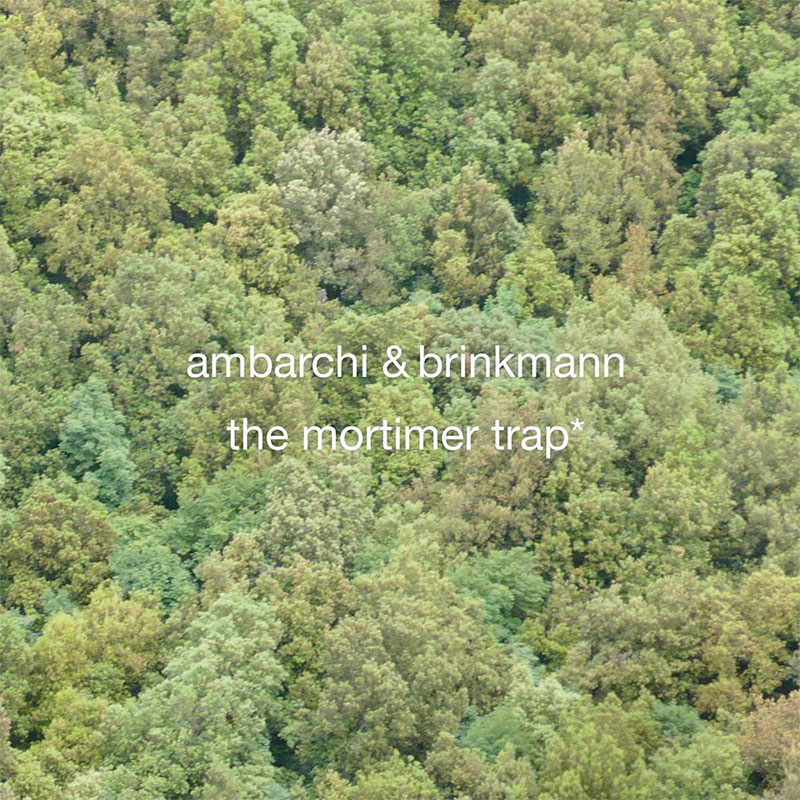
Thomas Brinkmann / Oren Ambarchi
The Mortimer Trap
Label: Black Truffle
Format: CD
Catalogue Number: BT06
Official web site: orenambarchi.bandcamp.com/album/the-mortimer-trap
Description
The Mortimer Trap is an epic 77min “variation” of Morton Feldman’s For Bunita Marcus constructed by German experimentalist and techno icon Thomas Brinkmann and Australian sound artist Oren Ambarchi.
Pulsating waves of claustrophobic ambience generated from who-knows-what patiently builds into a throbbing rhythmic pulse of gorgeous sonic density.
Since the 80s Thomas Brinkmann has experimented with sound, its textures and its construction methods. His custom built two-arm turntable on Concept 1, the sampling of damaged records on Klick and various experiments with carved-groove vinyl are just a handful of career highlights that mark Brinkmann out as a true musical pioneer. Oren Ambarchi, primarily known for his solo guitar records for the Touch label, has worked with a diverse array of artists such as Keiji Haino, Fennesz, Phill Niblock, Jim O’Rourke, Voice Crack, Keith Rowe and Sunn 0))).
Ambarchi and Brinkmann first worked together in in Japan in January 2011 in a trio with Mika Vainio.
The Mortimer Trap is their first collaborative work as a duo.
Artwork and design by Thomas Brinkmann.
The Mortimer Trap is an epic 77min “variation” of Morton Feldman’s For Bunita Marcus constructed by German experimentalist and techno icon Thomas Brinkmann and Australian sound artist Oren Ambarchi. Pulsating waves of claustrophobic ambience generated from who-knows-what patiently builds into a throbbing rhythmic pulse of gorgeous sonic density. Since the 80s Thomas Brinkmann has experimented ...
read more…
Tracklisting
- The Mortimer Trap
Available from these fine distributors:
- USA – Forced Exposure www.forcedexposure.com
- Europe – Kompakt www.kompakt.fm/labels/black_truffle
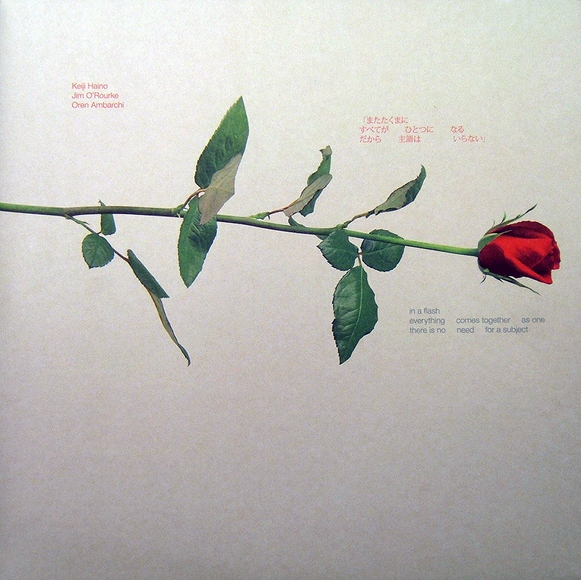
Keiji Haino / Jim O’Rourke / Oren Ambarchi
In a flash everything comes together as one there is no need for a subject
Label: Black Truffle
Format: 2LP
Catalogue Number: BT05
Official web site: orenambarchi.bandcamp.com/album/in-a-flash-everything-comes-together-as-one-there-is-no-need-for-a-subject
Description
Recorded one year after this international trio’s first release (Tima Formosa BT04), In a flash everything comes together as one there is no need for a subject presents the entirety of a live performance that took place at SuperDeluxe, Tokyo on January 24th 2010. For their second performance together, the trio opted for an entirely different instrumental configuration. The dark improvisations of Tima Formosa were produced with Ambarchi’s signature electric guitar, O’Rourke on inside-piano and Haino primarily on vocals and electronics. Here they form a classic power trio: Ambarchi on drums, O’Rourke on bass and Haino on guitar, vocals, electronics and, in one amazing passage, lap steel. While the instrumentation has changed, the mysterious atmosphere of their first collaboration remains: far from a rock genre exercise, this performance is steeped in the dark ritualistic mood that characterizes all of Haino’s best work.
Haino is in truly phenomenal form herein, foregoing the single-instrument explorations of much of his recent solo work and his more peripheral role on the trio’s first release for a virtuosic and wide-ranging performance that takes in piercing leads, delicate strumming, jarring lap-steel interjections and his inimitable vocal caresses and howls. O’Rourke’s bass sometimes merges with Haino’s guitar to form crumbling walls of noise, at other times his dark ostinatos and runs add melodic weight. Ambarchi’s drumming moves from delicate, propulsive cymbal work to endless thundering streams of free-pulse pounding. The title of the release is appropriate: from the spacious and unpredictable slow-mo interactions of the first piece (reminiscent of some of the greatest Fushitsusha moments) to the wild free-riffing that concludes the performance, the trio seems uncannily attuned to one-another’s movements, and everything truly ’comes together as one’.
Francis Plagne, Melbourne, Jan 2011.
Released as a limited edition double LP in a lavish gatefold with printed inner sleeves, design by Stephen O’Malley with high quality live shots by Ujin Matsuo and a stunning cover-image by noise-guitar blaster and internationally renowned visual artist Marco Fusinato.
Recorded one year after this international trio’s first release (Tima Formosa BT04), In a flash everything comes together as one there is no need for a subject presents the entirety of a live performance that took place at SuperDeluxe, Tokyo on January 24th 2010. For their second performance together, the trio opted for an entirely ...
read more…
Tracklisting
- in a flash everything comes together as one there is no need for a subject
- the time I was given and the time you were given and their differences
- BLUES for putting a FUZZ beforehand
- once again you are reading it wrong what is written is to live
Available from these fine distributors:
- USA – Forced Exposure www.forcedexposure.com
- Europe – Kompakt www.kompakt.fm/labels/black_truffle
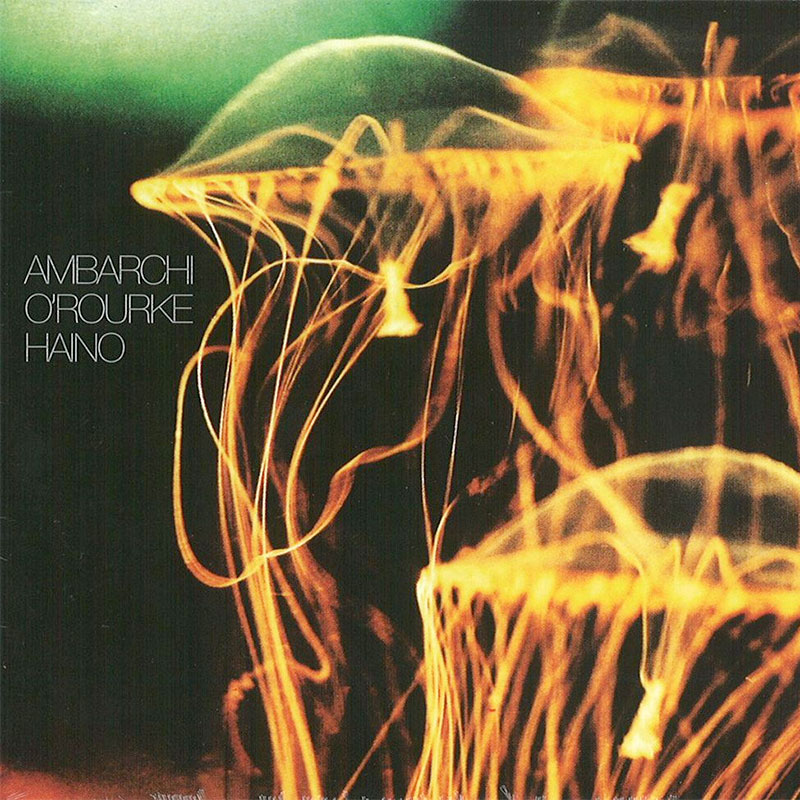
Ambarchi / O’Rourke / Haino
Tima Formosa
Label: Black Truffle
Format: CD
Catalogue Number: BT04
Official web site: orenambarchi.bandcamp.com/album/tima-formosa
Description
Stunning document of the debut meeting of this international trio. Recorded live at the Playhouse, Kitakyushu, Japan in January 2009, Tima Formosa retains a mysteriously alien atmosphere throughout it’s 3 lengthy explorations with Ambarchi’s mesmerising textures and signature, deep guitar tones beautifully merging with O’Rourke’s Tudor-esque piano-feedback interjections. Haino provides the icing on the cake via his melancholic, higher consciousness choral vocals and bewildering electronics.
Co-released with the Center for Contemporary Art, Kitakyushu with deluxe packaging designed by Stephen O’Malley.
Stunning document of the debut meeting of this international trio. Recorded live at the Playhouse, Kitakyushu, Japan in January 2009, Tima Formosa retains a mysteriously alien atmosphere throughout it’s 3 lengthy explorations with Ambarchi’s mesmerising textures and signature, deep guitar tones beautifully merging with O’Rourke’s Tudor-esque piano-feedback interjections. Haino provides the icing on the cake ...
read more…
Tracklisting
- Tima Formosa 1
- Tima Formosa 2
- Tima Formosa 3
Available from these fine distributors:
- USA – Forced Exposure www.forcedexposure.com
- Europe – Kompakt www.kompakt.fm/labels/black_truffle

Ambarchi / Fennesz / Pimmon / Rehberg / Rowe
Afternoon Tea
Label: Black Truffle
Format: CD
Catalogue Number: BT03
Official web site: orenambarchi.bandcamp.com/album/afternoon-tea
Description
Who would have thought a relaxed sunny afternoon, newfound friendships and some spur-of-the-moment would have resulted in what’s been described as ’one of the most compelling documents of both free improvisation and electronica’ (All Music Guide)?
It’s the people involved in Afternoon Tea – originally released in 2000 on German label Ritornell and now reissued on Black Truffle with a new master, bonus tracks and newly discovered live recordings after years of being out of print – that ensured it as more than a happy accident. The twin guitar presence of AMM’s Keith Rowe and Oren Ambarchi and kindred spirits of the laptop ’ Sydney’s Pimmon, Vienna’s Christian Fennesz and Peter Rehberg made it a momentous day.
With all the players coming together during the 2000 What Is Music? Festival, Afternoon Tea stands as a highpoint of the then-emerging intersection between Powerbook performance and guitar improvisation. All subtley, nuance and detail, it is a revelation of restraint. Built on a steadying flow of burbling rhythm, the quintet slowly weave around each others’ sonics in layers to create a tonal palette immersive in its atmosphere and magnetic in its compulsion.
Hindsight clearly reveals the heart of these pieces – important to note considering they were recorded at a time when laptop performance was an alien concept to many in experimental music, suffering controversy and backlash as well as an over-abundance of pale approaches from many who took it on as novelty as opposed to serious musical pursuit. Those involved in the Afternoon Tea session left their Australian tour inspired, citing their merry time in the country eating, drinking and hanging out at the beach as well as their performances as a direct influence on their following work. Many great live recordings were spawned from the tour itself including Rehberg & Bauer’s passt, Fennesz’ Live at Revolver (both on Touch) and a collaboration between him and New Zealand’s Rosy Parlane (released on Synaesthesia). Additionally the seeds were sown for the Fennesz classic Endless Summer from 2001 (Mego).
Afternoon Tea remains one of the quiet and real achievers for experimental music of the past decade.
Remastered in May 2009 and with artwork designed by Stephen O’Malley.
Who would have thought a relaxed sunny afternoon, newfound friendships and some spur-of-the-moment would have resulted in what’s been described as ’one of the most compelling documents of both free improvisation and electronica’ (All Music Guide)? It’s the people involved in Afternoon Tea – originally released in 2000 on German label Ritornell and now reissued ...
read more…
Tracklisting
- Afternoon Tea 1
- Afternoon Tea 2
- No Title
- Live Tea 1
- Live Tea 2
Available from these fine distributors:
- USA – Forced Exposure www.forcedexposure.com
- Europe – Kompakt www.kompakt.fm/labels/black_truffle

Oren Ambarchi
Persona
Label: Black Truffle
Format: CD
Catalogue Number: BT02
Official web site: orenambarchi.bandcamp.com/album/persona
Description
Originally released in 2000 as a limited vinyl only album, Persona is now available on CD for the first time.
Persona was recorded in February 2000, just a week after the Afternoon Tea collaboration with Fennesz, Pimmon, Pita and Keith Rowe. Utilizing a raw and spontaneous approach like the Stacte series of solo releases, Ambarchi recorded the pieces on Persona at home in a day, only using his guitar, a handful of effect pedals and a boombox as a monitor(!). Considered to be a sister release to Ambarchi’s acclaimed Suspension album on Touch, the material on Persona (originally released on E.R.S. in a tiny edition of 300) was only heard by a handful of listeners. From the late 90’s his experiments in guitar abstraction and extended technique led to a more personal and unique soundworld and Persona was an early document of this direction. Here, the pieces are hesitant and tense extended songforms, located in the cracks between several schools: modern electronics and processing; laminal improvisation and minimalism; and hushed, pensive songwriting. It recalls the deceptive simplicity and temporal suspensions of composers such as Morton Feldman and Alvin Lucier, and the physicality of rock music, stripped back to its bare bones, abstracted and replaced with pure signal.
Remastered in December 2008 and with artwork designed by Stephen O’Malley.
Originally released in 2000 as a limited vinyl only album, Persona is now available on CD for the first time. Persona was recorded in February 2000, just a week after the Afternoon Tea collaboration with Fennesz, Pimmon, Pita and Keith Rowe. Utilizing a raw and spontaneous approach like the Stacte series of solo releases, Ambarchi ...
read more…
Tracklisting
- Alma
- Vogler
- Persona
Available from these fine distributors:
- USA – Forced Exposure www.forcedexposure.com
- Europe – Metamkine www.metamkine.com
- UK – Boomkat www.boomkat.com
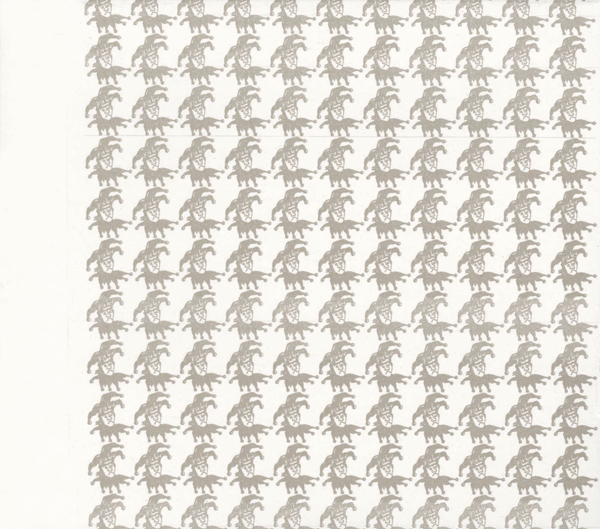
Oren Ambarchi
Stacte.3
Label: Black Truffle
Format: CD
Catalogue Number: BT01
Official web site: orenambarchi.bandcamp.com/album/stacte-3
Description
Originally released in 2000 as a limited vinyl only album, Stacte.3 is now available on CD for the first time.
Described by Wire scribe Jon Dale as “Alvin Lucier and Cluster collaborating for Mego”, the concept of Oren Ambarchi’s Stacte LP series – now comprising of five volumes – began in 1998. The first few Stacte LPs were self-released by Ambarchi and featured his earliest explorations of the guitar and its sonic possibilities after a period known as a drummer in post-punk, noise and free jazz outfits. An idea was explored and investigated at length using a spontaneous approach, with Ambarchi treating each side of the vinyl like a canvas, slowly capturing a moment, patiently teasing every nuance and implication from each texture. His method allowed the listener to sink their teeth into something substantial over the course of the LP side’s entire duration, resulting in an otherworldly, cumulative impact of patiently unfolding compositions.
The Stacte.3 release (especially the LP’s second side) was a breakthrough for Ambarchi and it defined the parameters for his subsequent projects such as 2001’s Suspension and Grapes From The Estate from 2004, both released on the legendary UK label Touch.
Stacte.3 is an early glimpse of Ambarchi at his most raw and minimal and it’s a fascinating, integral listen in his catalogue of sound works.
Remastered in December 2008 and with artwork designed by Stephen O’Malley.
Originally released in 2000 as a limited vinyl only album, Stacte.3 is now available on CD for the first time. Described by Wire scribe Jon Dale as “Alvin Lucier and Cluster collaborating for Mego”, the concept of Oren Ambarchi’s Stacte LP series – now comprising of five volumes – began in 1998. The first few ...
read more…
Tracklisting
- Stacte.3A
- Stacte.3B
Available from these fine distributors:
- USA – Forced Exposure www.forcedexposure.com
- Europe – Metamkine www.metamkine.com
- UK – Boomkat www.boomkat.com